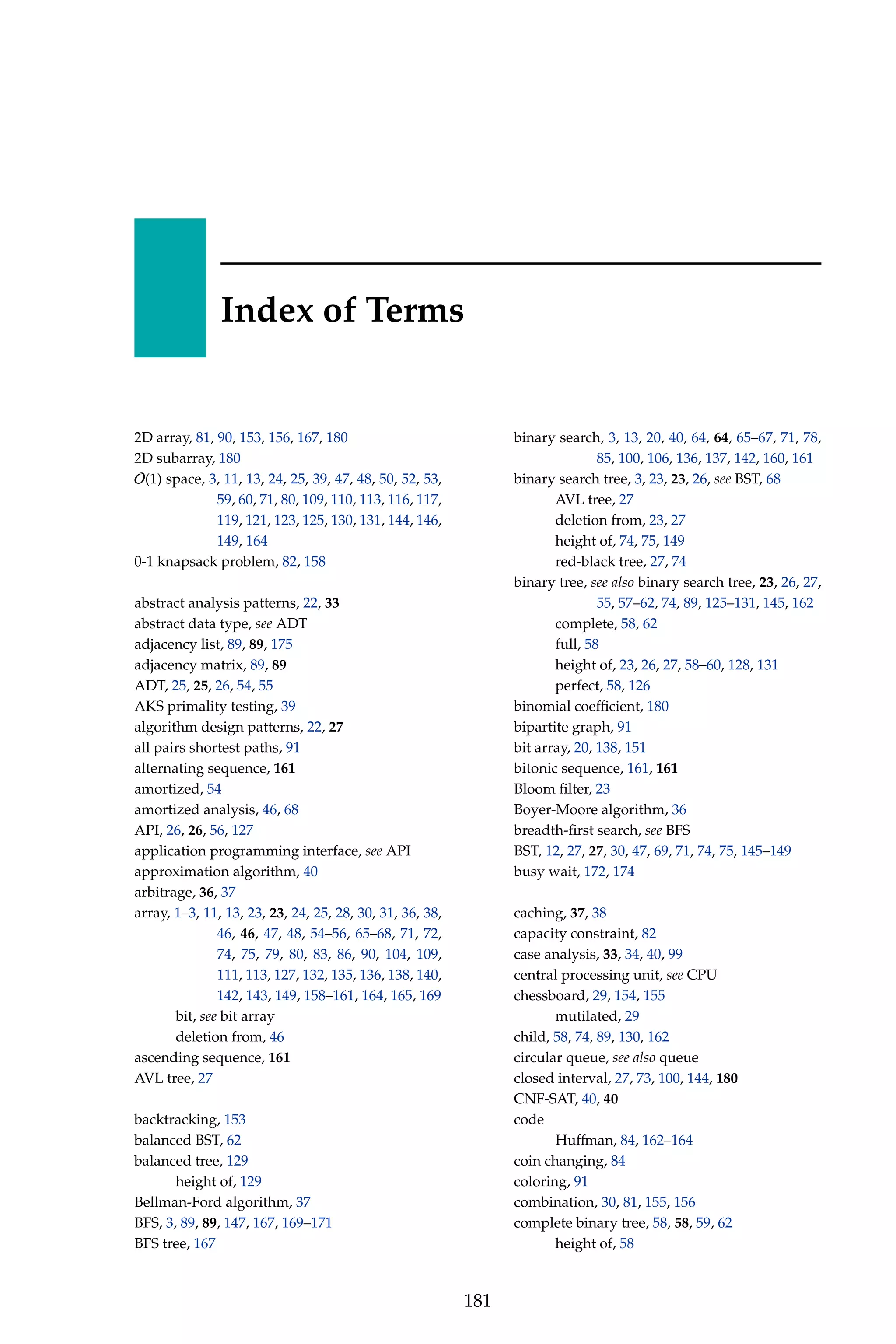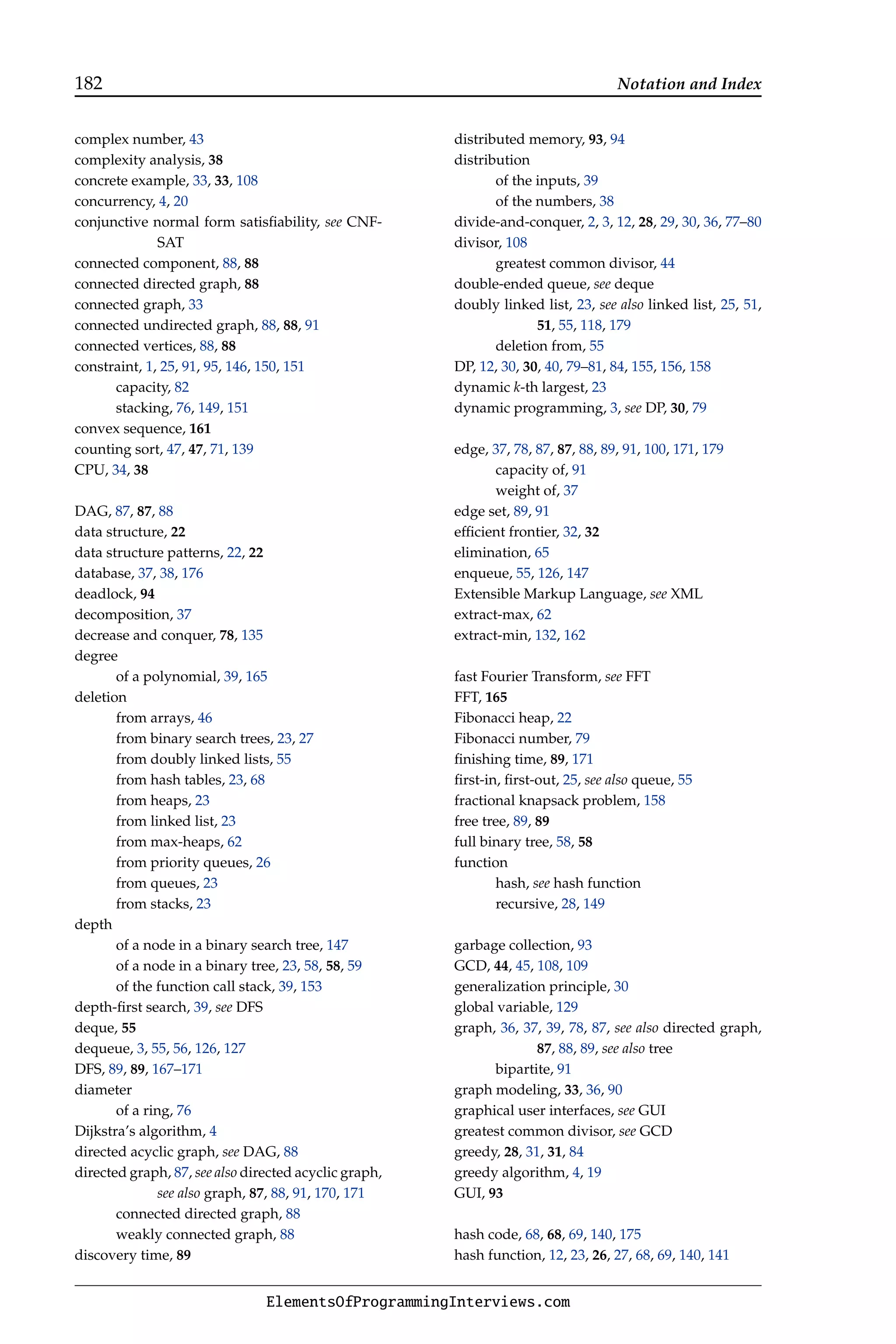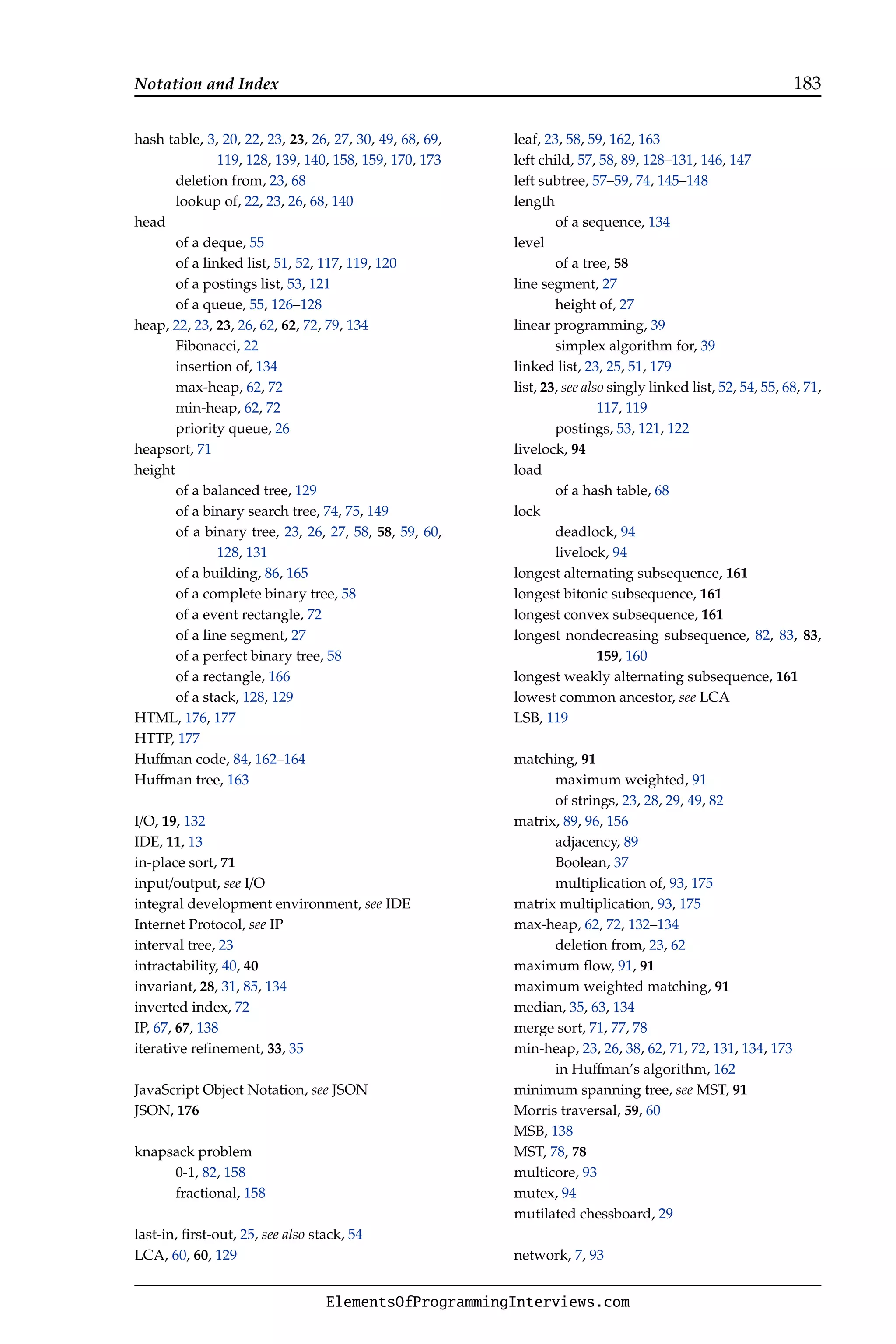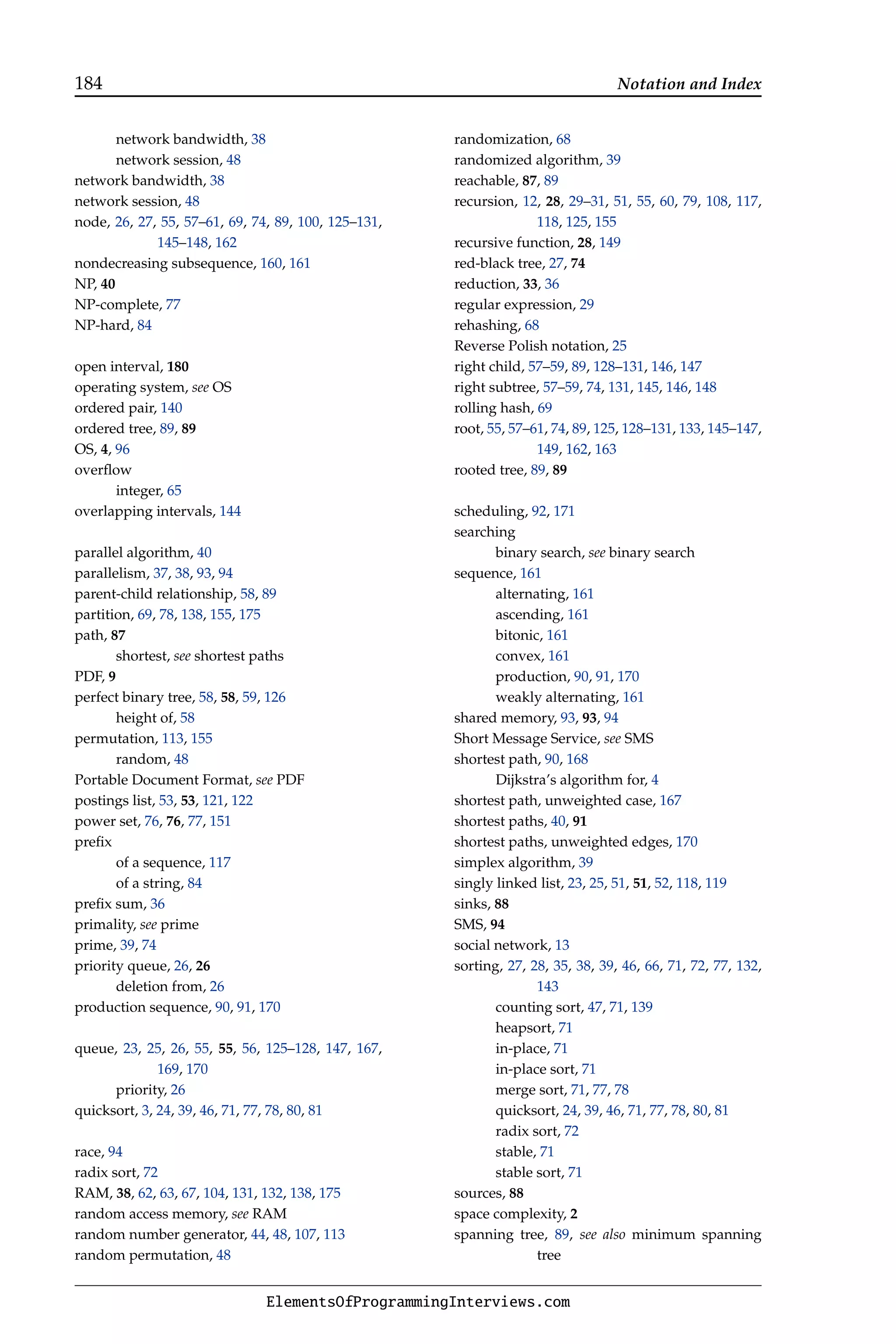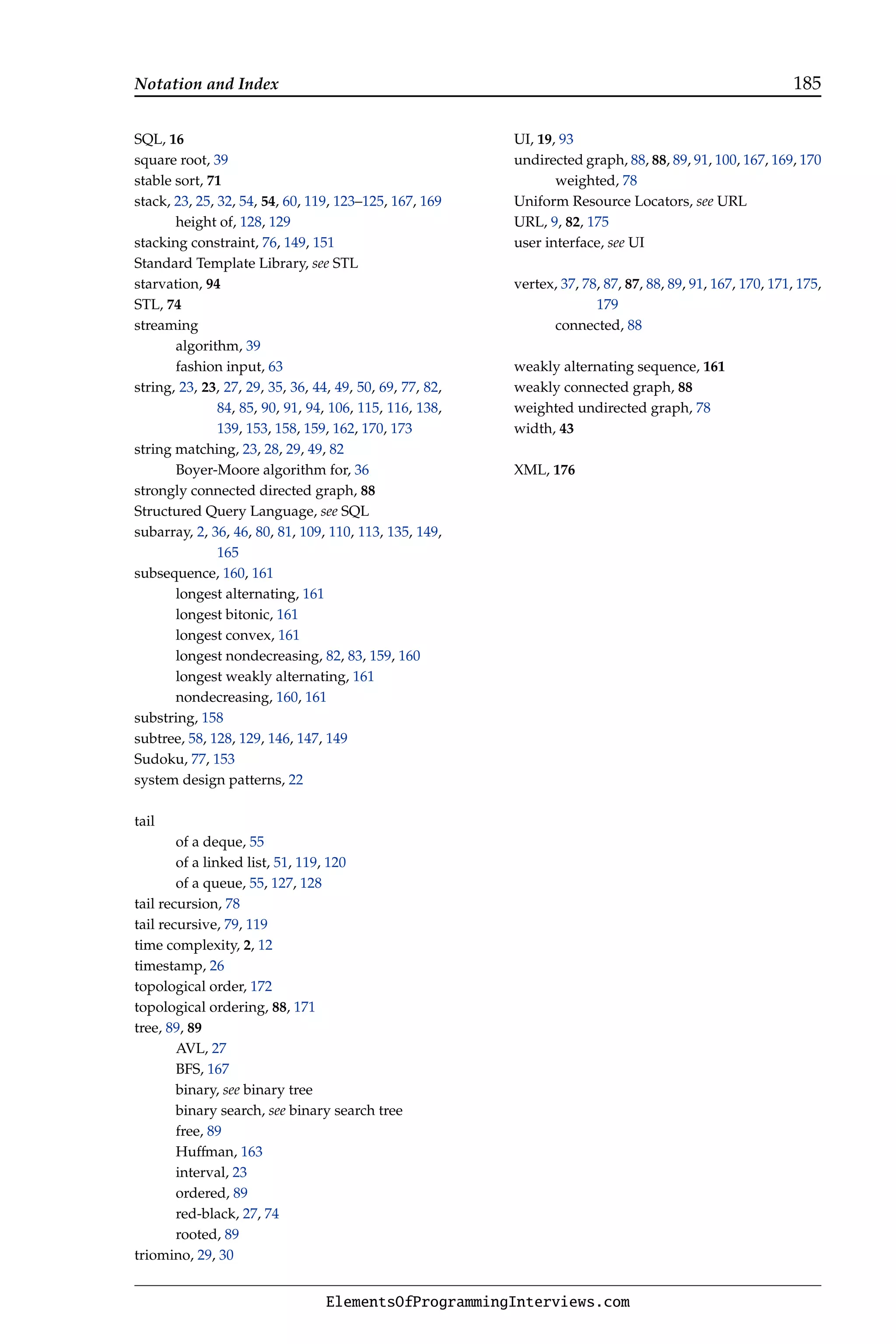The document provides an overview of the book "Elements of Programming Interviews" which aims to help engineers prepare for software development interviews. It contains examples of the book's organization, content, style, topics and quality. The document also provides biographies of the authors and publishing details.
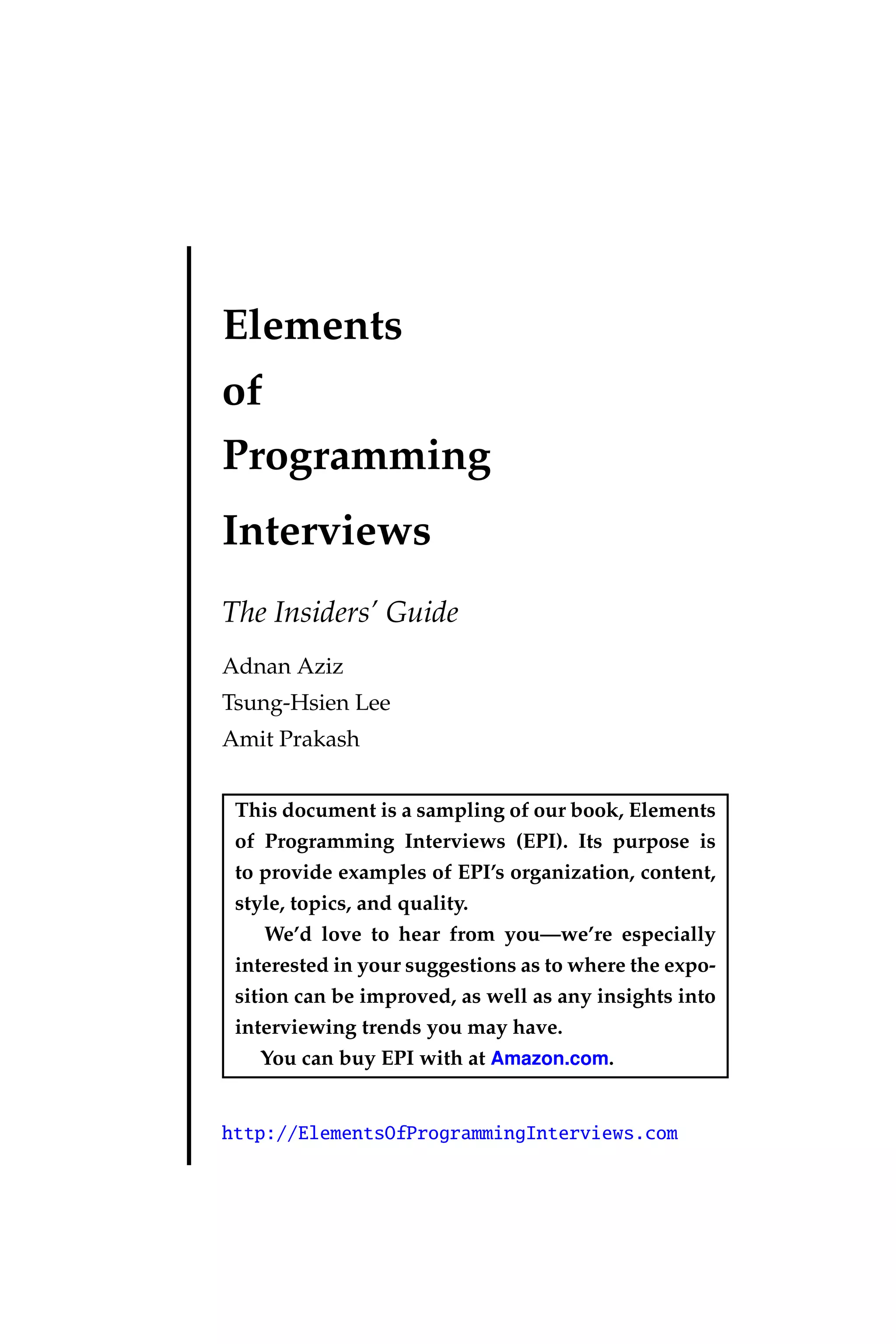
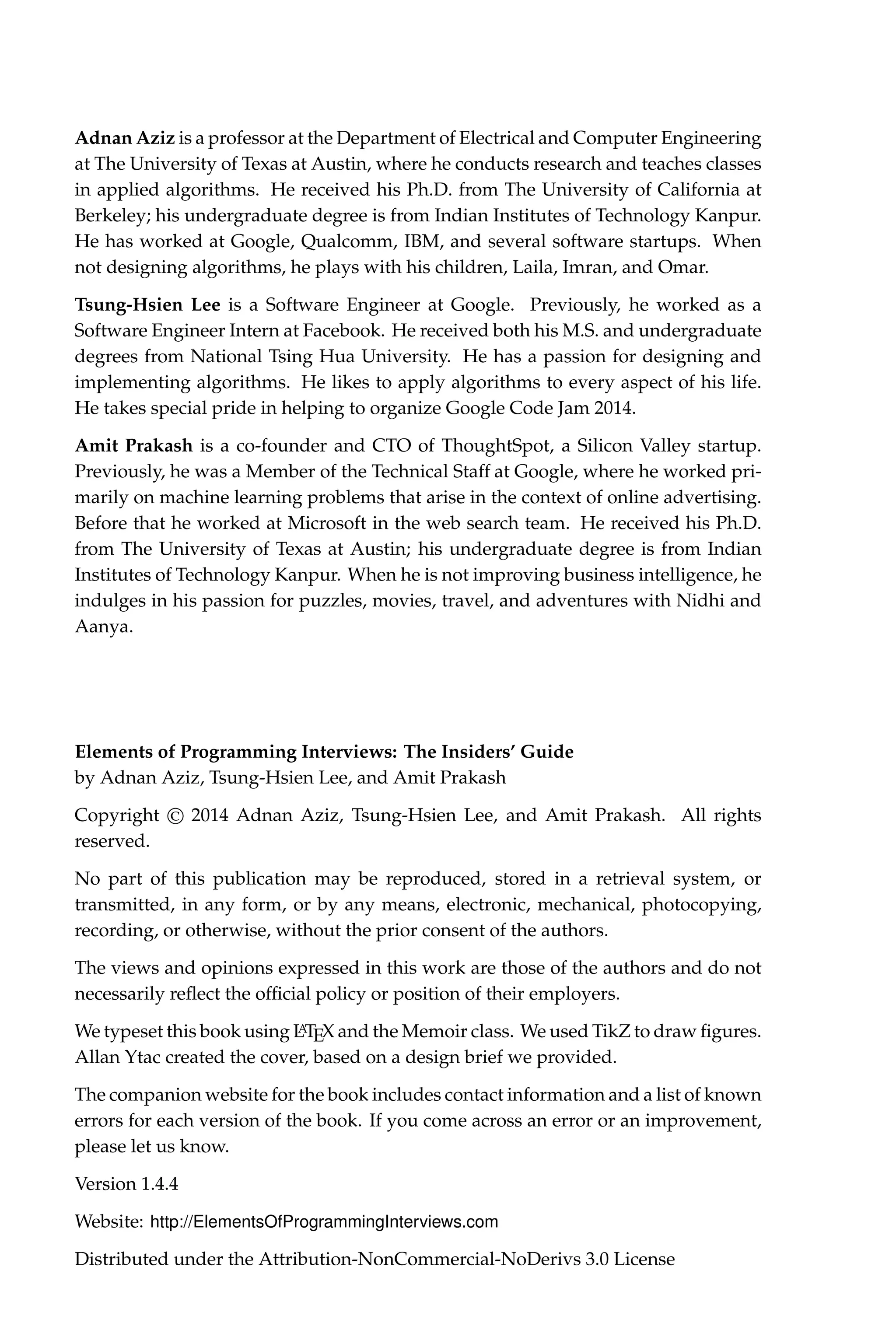

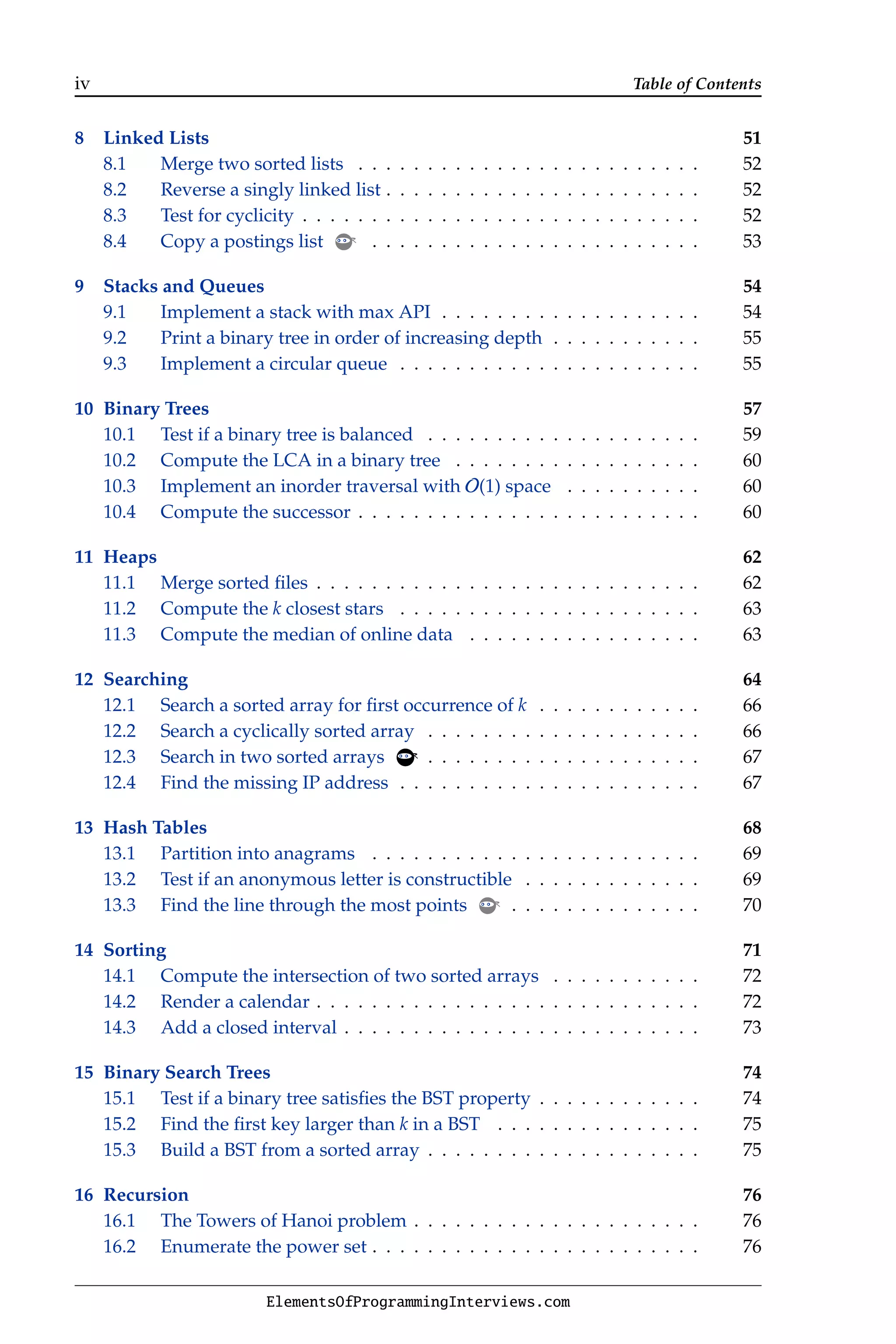
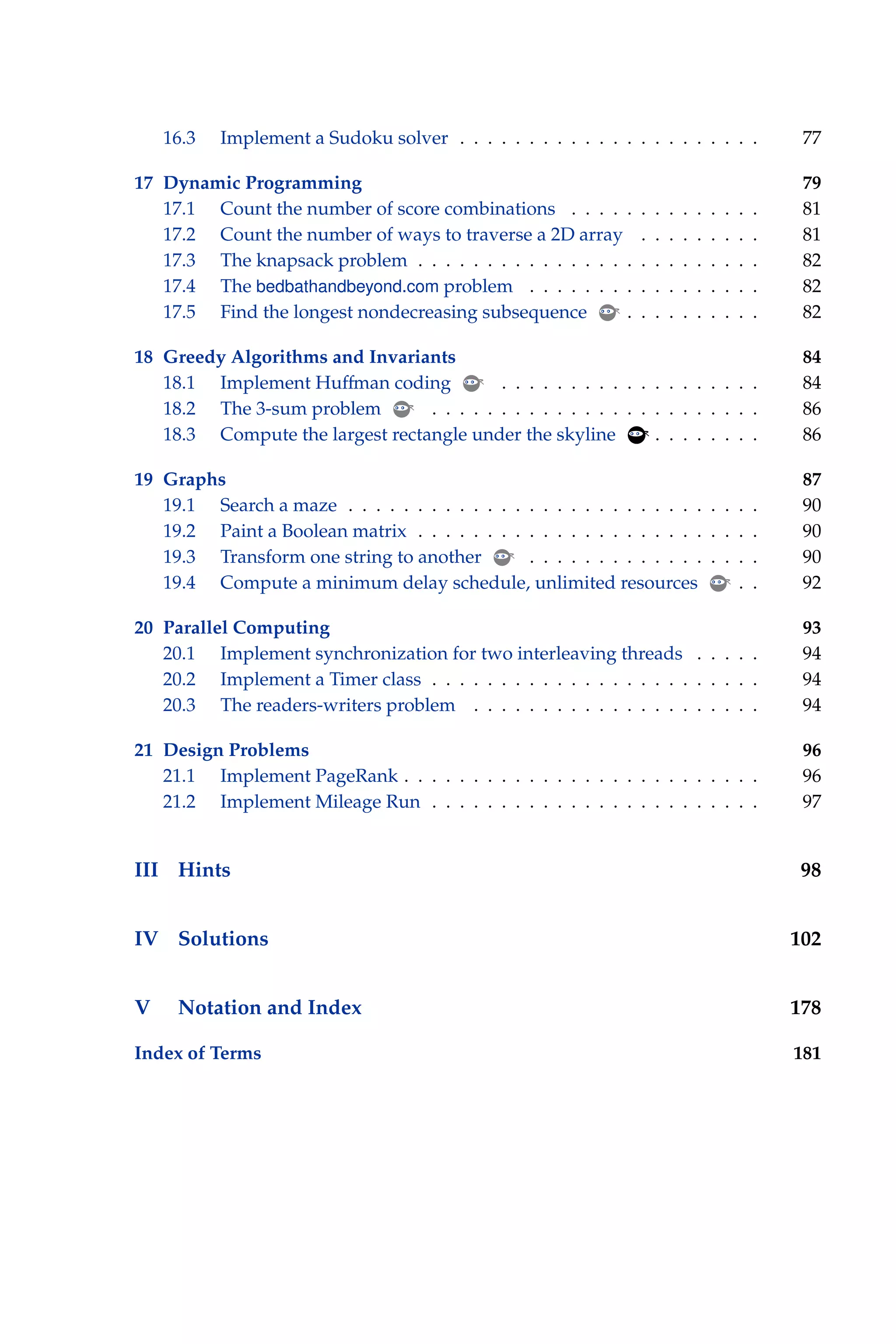

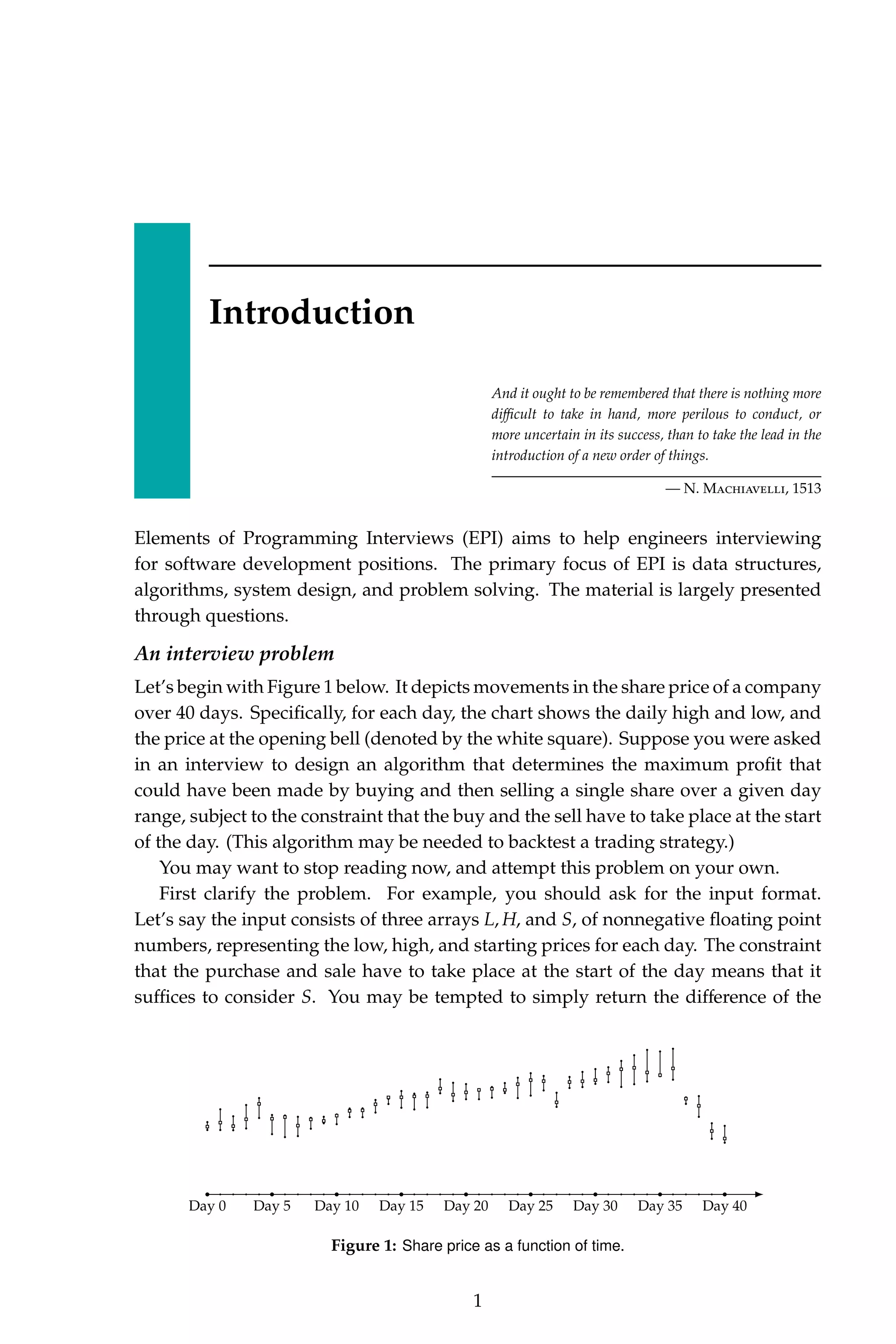
![2 Introduction
minimum and maximum elements in S. If you try a few test cases, you will see that
the minimum can occur after the maximum, which violates the requirement in the
problem statement—you have to buy before you can sell.
At this point, a brute-force algorithm would be appropriate. For each pair of
indices i and j > i compute pi,j = S[j] − S[i] and compare this difference to the largest
difference, d, seen so far. If pi,j is greater than d, set d to pi,j. You should be able to
code this algorithm using a pair of nested for-loops and test it in a matter of a few
minutes. You should also derive its time complexity as a function of the length n of
the input array. The inner loop is invoked n−1 times, and the i-th iteration processes
n − 1 − i elements. Processing an element entails computing a difference, performing
a compare, and possibly updating a variable, all of which take constant time. Hence,
the run time is proportional to
Pn−2
k=0 (n−1−k) =
(n−1)(n)
2
, i.e., the time complexity of the
brute-force algorithm is O(n2
). You should also consider the space complexity, i.e.,
how much memory your algorithm uses. The array itself takes memory proportional
to n, and the additional memory used by the brute-force algorithm is a constant
independent of n—a couple of iterators and one temporary floating point variable.
Once you have a working algorithm, try to improve upon it. Specifically, an
O(n2
) algorithm is usually not acceptable when faced with large arrays. You may
have heard of an algorithm design pattern called divide-and-conquer. It yields the
following algorithm for this problem. Split S into two subarrays, S[0 : bn
2
c] and
S[bn
2
c + 1 : n − 1]; compute the best result for the first and second subarrays; and
combine these results. In the combine step we take the better of the results for the
two subarrays. However, we also need to consider the case where the optimum buy
and sell take place in separate subarrays. When this is the case, the buy must be in
the first subarray, and the sell in the second subarray, since the buy must happen
before the sell. If the optimum buy and sell are in different subarrays, the optimum
buy price is the minimum price in the first subarray, and the optimum sell price is in
the maximum price in the second subarray. We can compute these prices in O(n) time
with a single pass over each subarray. Therefore, the time complexity T(n) for the
divide-and-conquer algorithm satisfies the recurrence relation T(n) = 2T(n
2
) + O(n),
which solves to O(n log n).
The divide-and-conquer algorithm is elegant and fast. Its implementation entails
some corner cases, e.g., an empty subarray, subarrays of length one, and an array in
which the price decreases monotonically, but it can still be written and tested by a
good developer in 20–30 minutes.
Looking carefully at the combine step of the divide-and-conquer algorithm, you
may have a flash of insight. Specifically, you may notice that the maximum profit
that can be made by selling on a specific day is determined by the minimum of
the stock prices over the previous days. Since the maximum profit corresponds to
selling on some day, the following algorithm correctly computes the maximum profit.
Iterate through S, keeping track of the minimum element m seen thus far. If the
difference of the current element and m is greater than the maximum profit recorded
so far, update the maximum profit. This algorithm performs a constant amount of
work per array element, leading to an O(n) time complexity. It uses two float-valued
ElementsOfProgrammingInterviews.com](https://image.slidesharecdn.com/elementsofprogramminginterviews-220623105328-e235fecd/75/Elements-of-Programming-Interviews-pdf-8-2048.jpg)
![Introduction 3
variables (the minimum element and the maximum profit recorded so far) and an
iterator, i.e., O(1) additional space. It is considerably simpler to implement than the
divide-and-conquer algorithm—a few minutes should suffice to write and test it.
Working code is presented in Solution 6.2 on Page 110.
If in a 45–60 minutes interview, you can develop the algorithm described above,
implement and test it, and analyze its complexity, you would have had a very suc-
cessful interview. In particular, you would have demonstrated to your interviewer
that you possess several key skills:
− The ability to rigorously formulate real-world problems.
− The skills to solve problems and design algorithms.
− The tools to go from an algorithm to a tested program.
− The analytical techniques required to determine the computational complexity
of your solution.
Book organization
Interviewing successfully is about more than being able to intelligently select data
structures and design algorithms quickly. For example, you also need to know how
to identify suitable companies, pitch yourself, ask for help when you are stuck on an
interview problem, and convey your enthusiasm. These aspects of interviewing are
the subject of Chapters 1–3, and are summarized in Table 1.1 on Page 8.
Chapter 1 is specifically concerned with preparation; Chapter 2 discusses how you
should conduct yourself at the interview itself; and Chapter 3 describes interviewing
fromtheinterviewer’sperspective. Thelatterisimportant forcandidatestoo, because
of the insights it offers into the decision making process. Chapter 4 reviews problem
solving patterns.
The problem chapters are organized as follows. Chapters 5–15 are concerned with
basic data structures, such as arrays and binary search trees, and basic algorithms,
such as binary search and quicksort. In our experience, this is the material that
most interview questions are based on. Chapters 16–19 cover advanced algorithm
design principles, such as dynamic programming and heuristics, as well as graphs.
Chapters 20–21 focus on distributed and parallel programming, and design problems.
Each chapter begins with a summary of key concepts, followed by problems. Broadly
speaking, problems are ordered by subtopic, with more commonly asked problems
appearing first.
The notation, specifically the symbols we use for describing algorithms, e.g.,
Pn−1
i=0 i2
, [a, b), h2, 3, 5, 7i, A[i : j], ⇒, |S|, {x | x2
> 2}, etc., is summarized starting on
Page 179. It should be familiar to anyone with a technical undergraduate degree, but
we still request you to review it carefully before getting into the book, and whenever
you have doubts about the meaning of a symbol. Terms, e.g., BFS and dequeue, are
indexed starting on Page 181.
Problems, solutions, variants, ninjas, and hints
Most solutions in EPI are based on basic concepts, such as arrays, hash tables, and
binary search, used in clever ways. Some solutions use relatively advanced machin-
ElementsOfProgrammingInterviews.com](https://image.slidesharecdn.com/elementsofprogramminginterviews-220623105328-e235fecd/75/Elements-of-Programming-Interviews-pdf-9-2048.jpg)
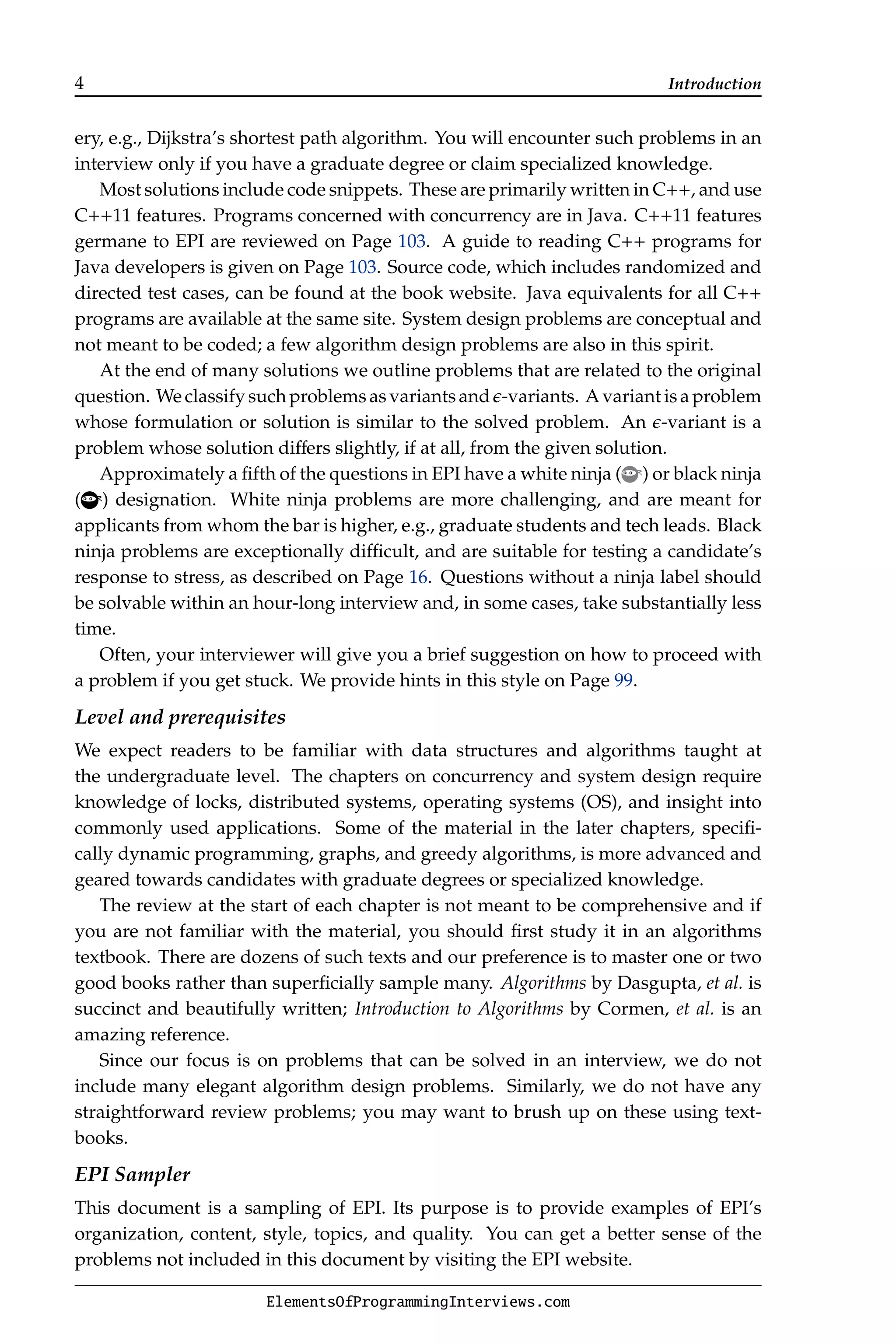
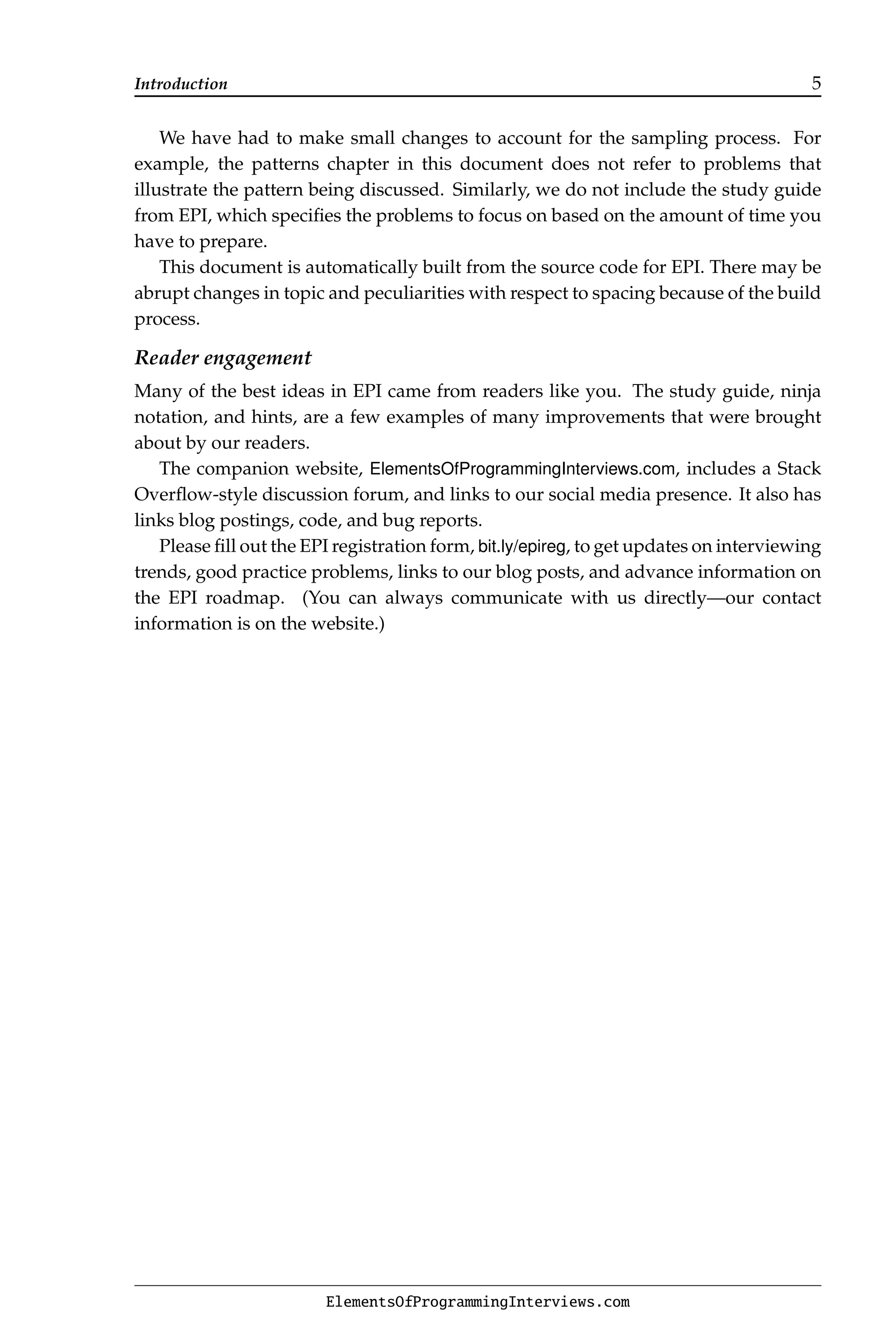

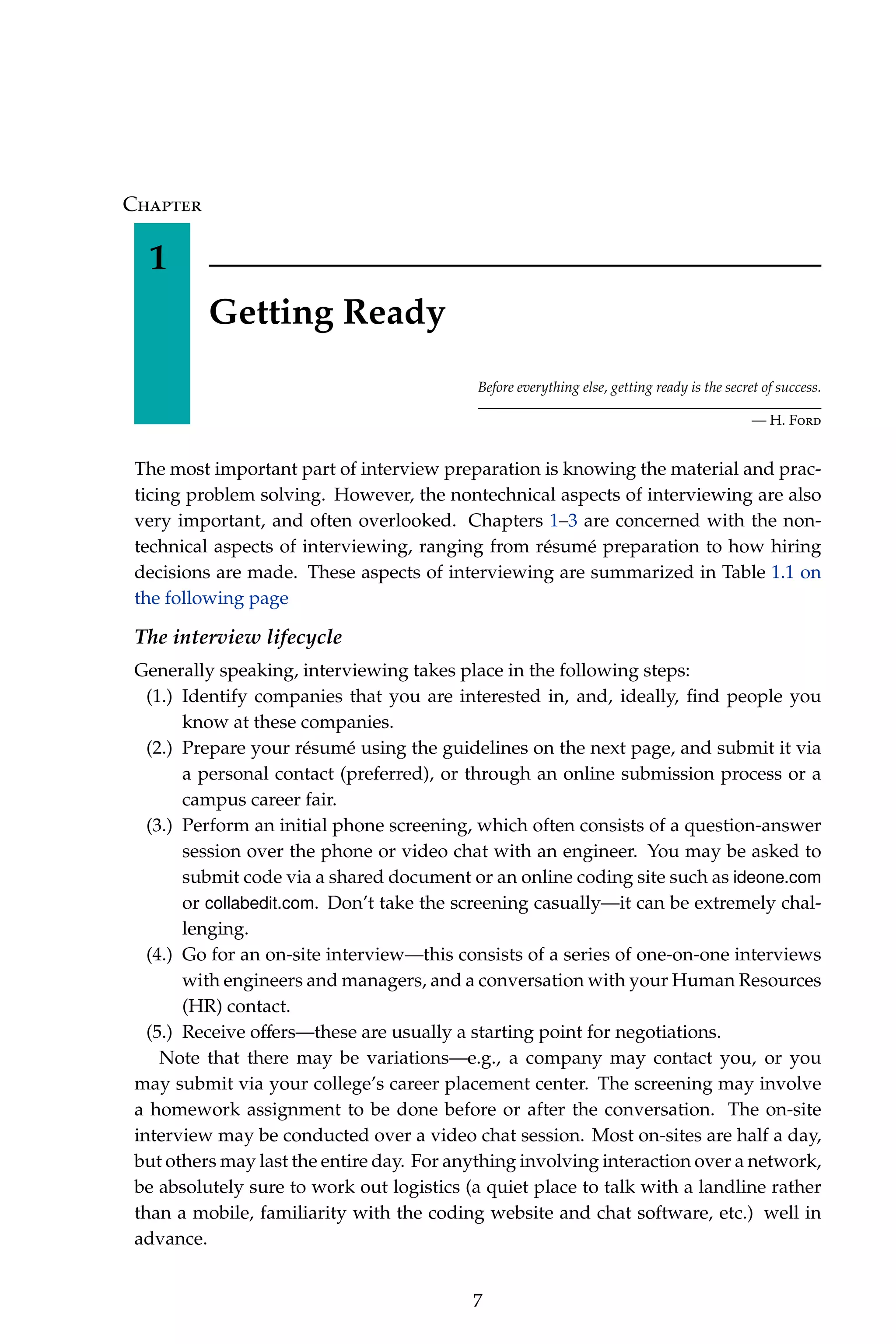



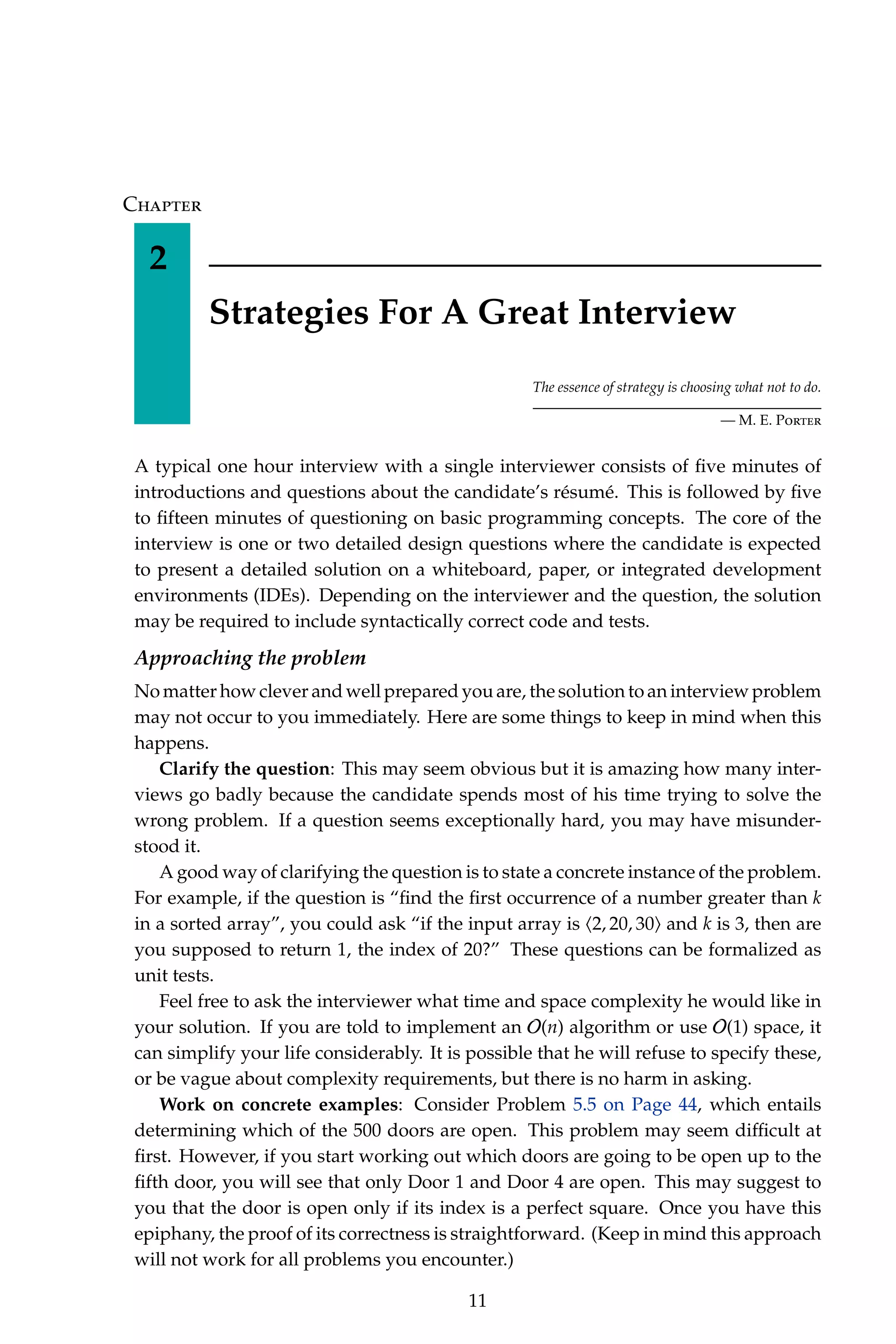
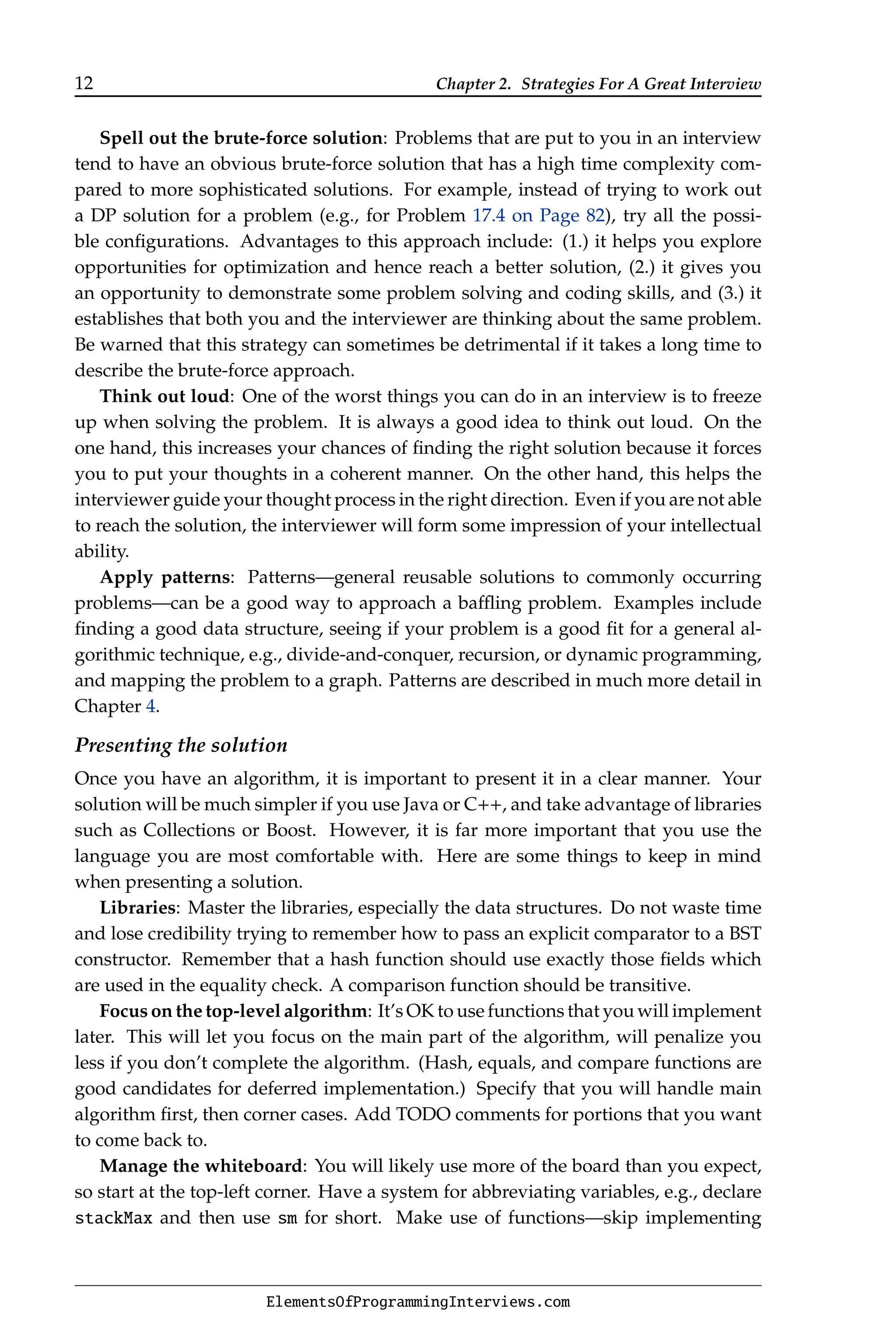
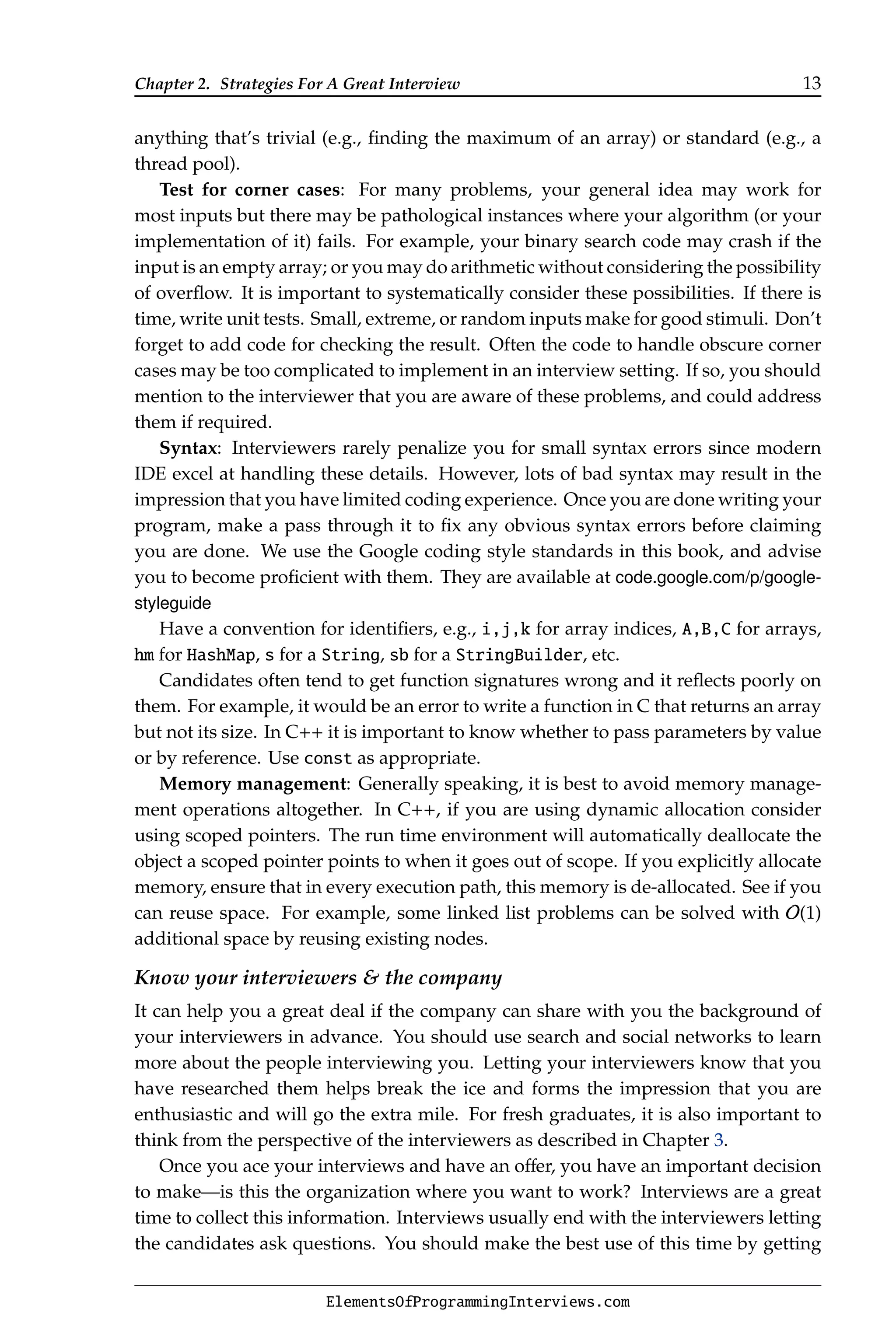

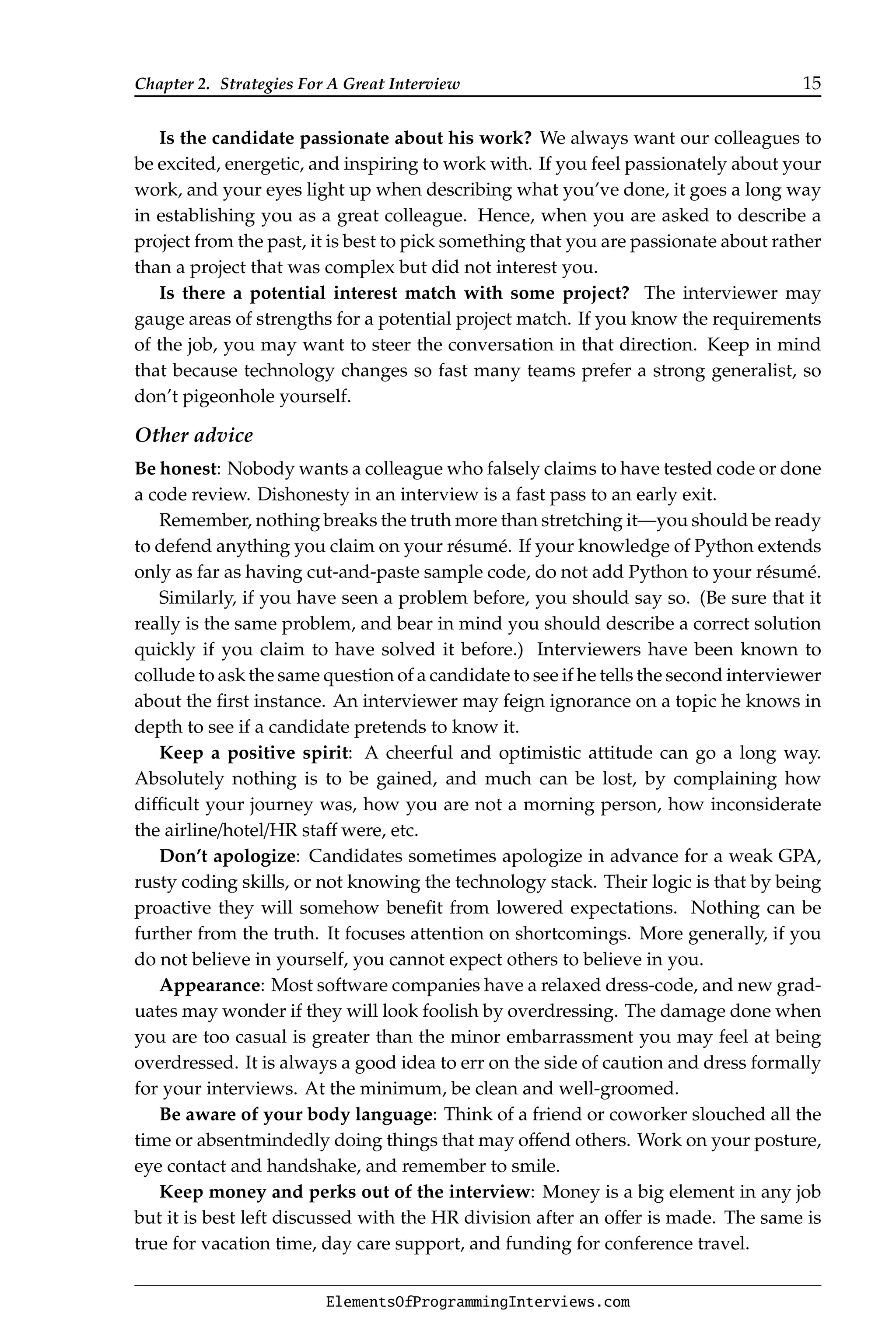
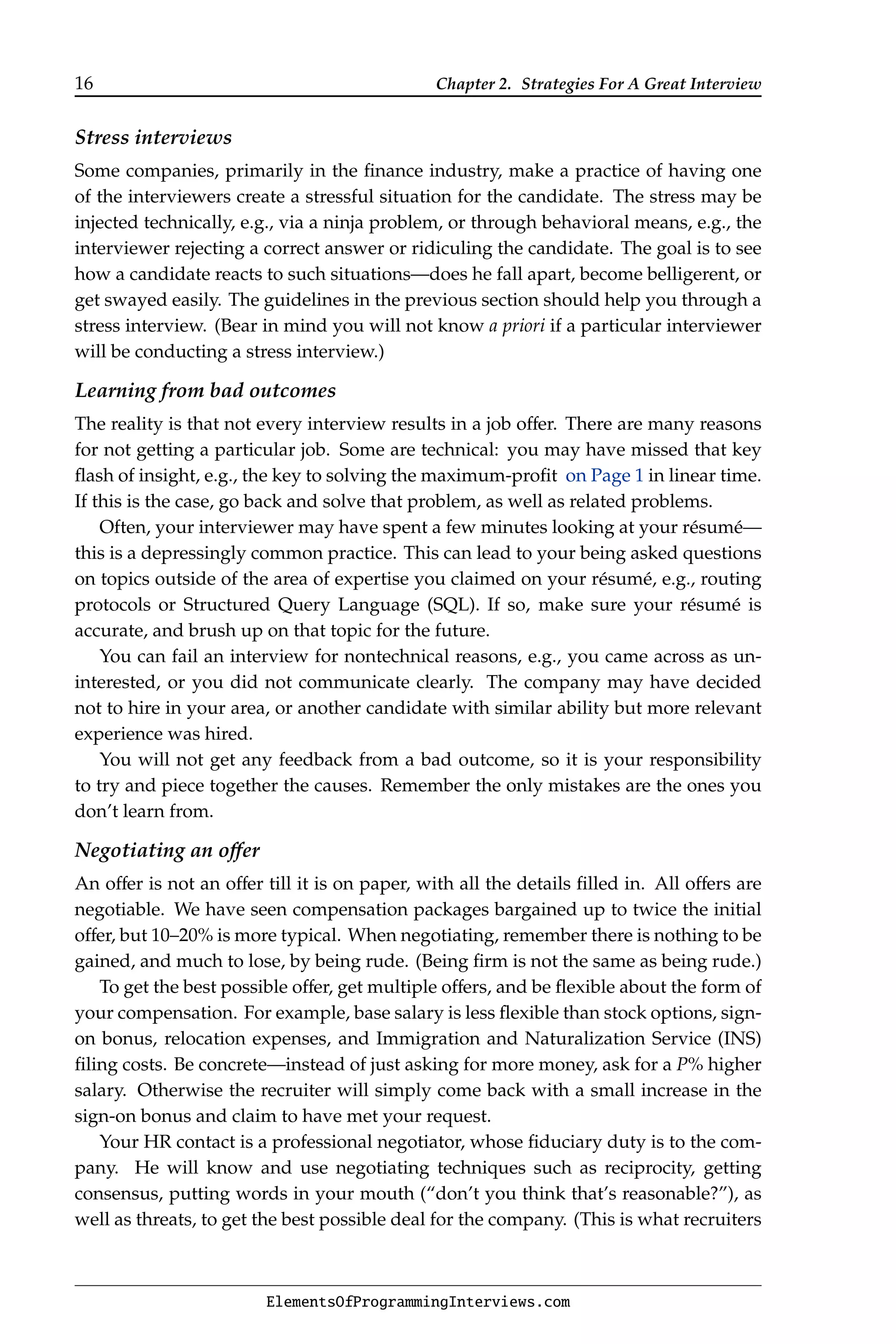

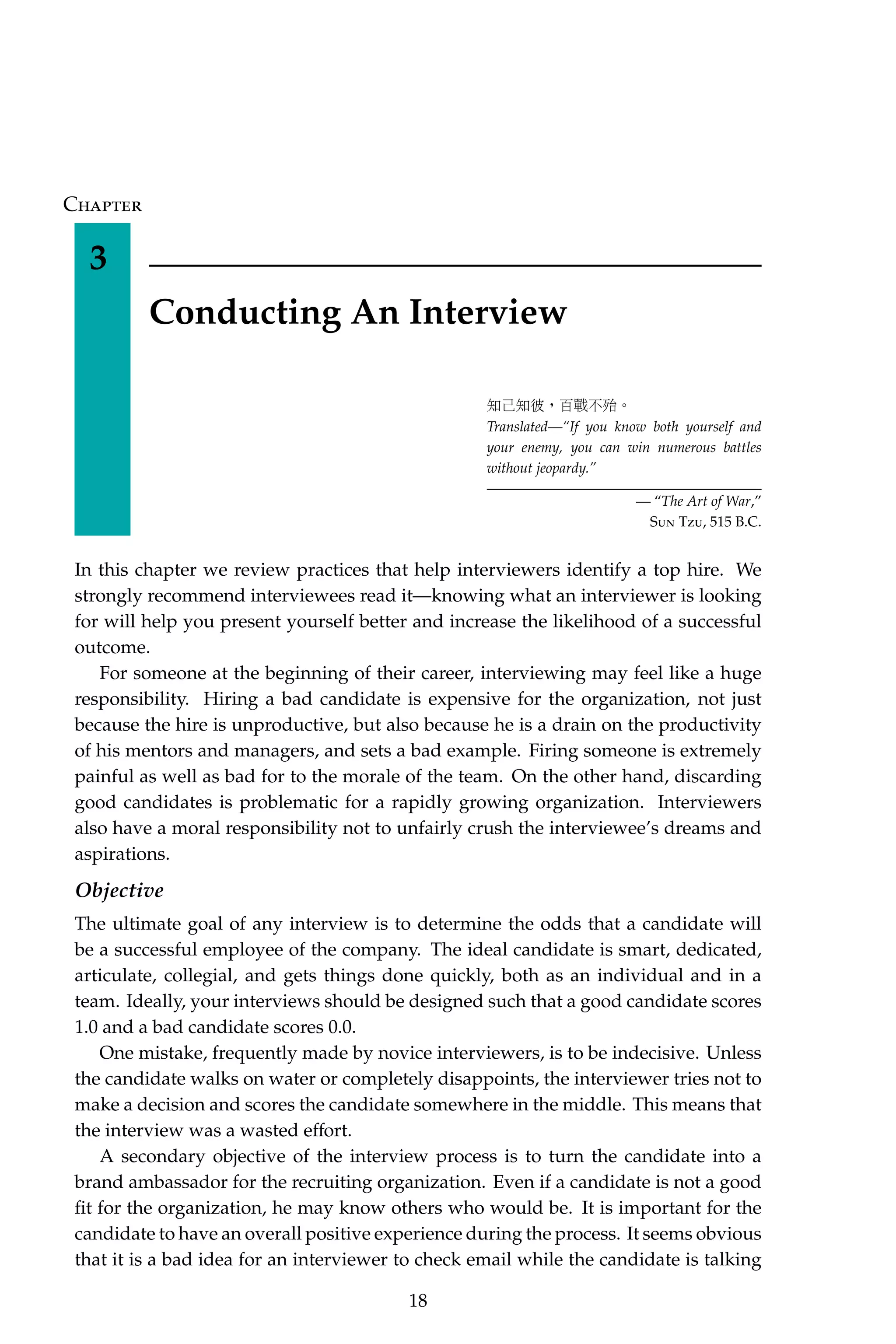
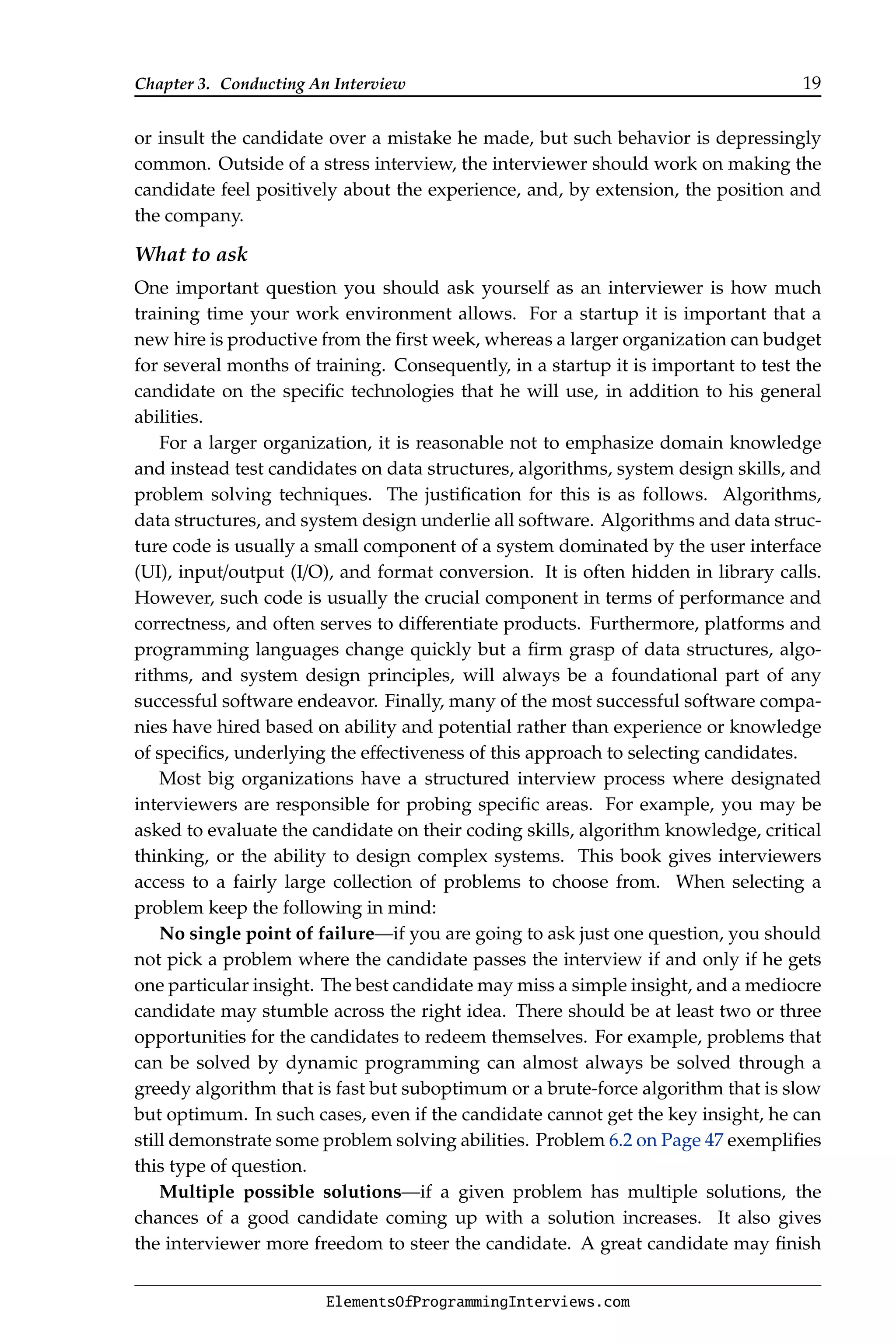
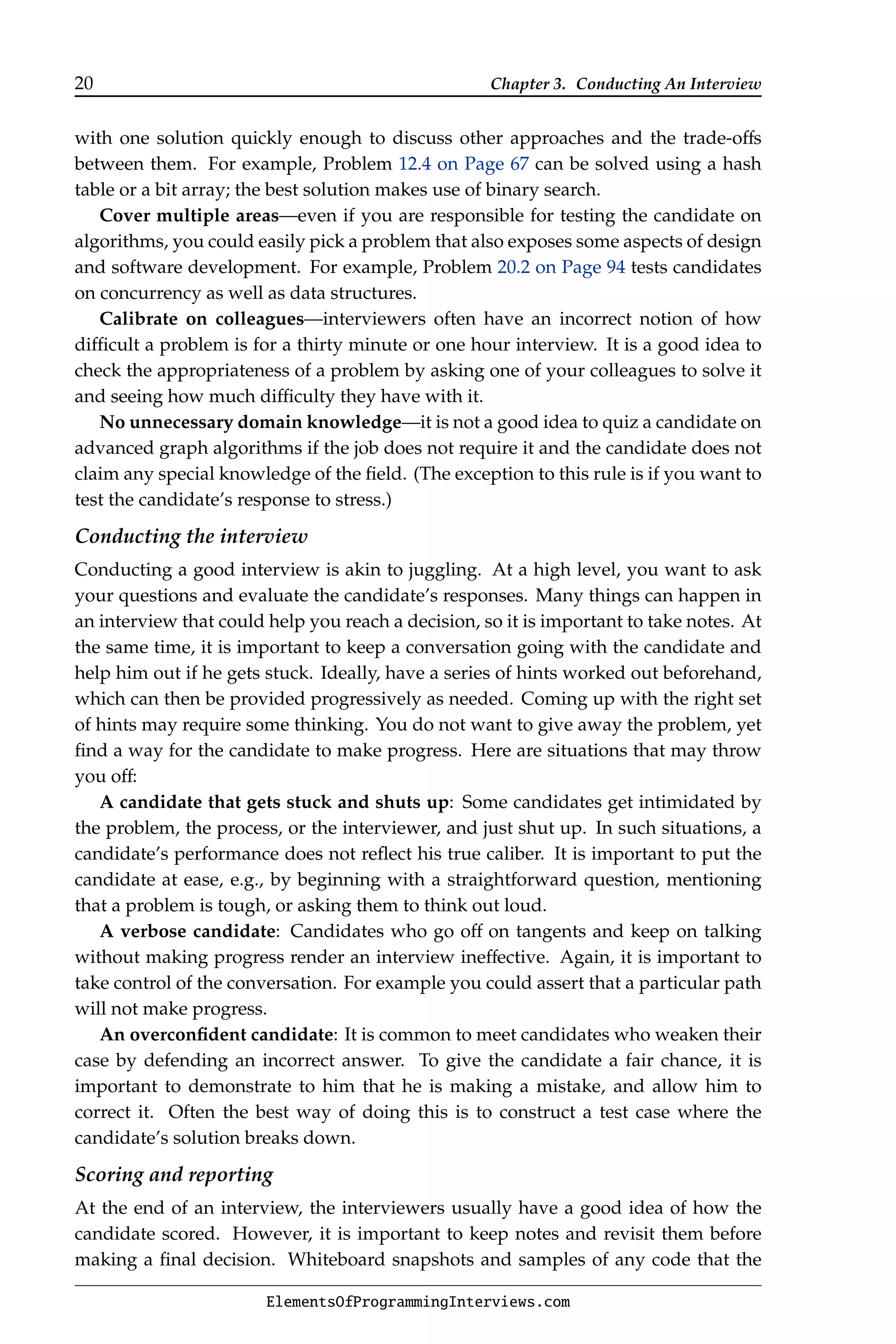



![24 Chapter 4. Problem Solving Patterns
A common problem related to basic types is computing the number of bits set
to 1 in an integer-valued variable x. To solve this problem you need to know how
to manipulate individual bits in an integer. One straightforward approach is to
iteratively test individual bits using an unsigned integer variable m initialized to 1.
Iteratively identify bits of x that are set to 1 by examining the bitwise AND of m with
x, shifting m left one bit at a time. The overall complexity is O(n) where n is the length
of the integer.
Another approach, which may run faster on some inputs, is based on computing
y = x ~(x−1), where is the bitwise AND operator and ~ is the bitwise complement
operator. The variable y is 1 at exactly the lowest set bit of x; all other bits in y are
0. For example, if x = (0110)2, then y = (0010)2. This calculation is correct both
for unsigned and two’s-complement representations. Consequently, this bit may be
removed from x by computing x ⊕ y, where ⊕ is the bitwise-XOR function. The time
complexity is O(s), where s is the number of bits set to 1 in x.
In practice, if the computation is done repeatedly, the most efficient approach
would be to create a lookup table. In this case, we could use a 65536 entry
integer-valued array P, such that P[i] is the number of bits set to 1 in i. If x is
64 bits, the result can be computed by decomposing x into 4 disjoint 16-bit words,
h3, h2, h1, and h0. The 16-bit words are computed using bitmasks and shifting, e.g.,
h1 is (x 16 (1111111111111111)2). The final result is P[h3] + P[h2] + P[h1] + P[h0].
Arrays
Conceptually, an array maps integers in the range [0, n − 1] to objects of a given type,
where n is the number of objects in this array. Array lookup and insertion are fast,
making arrays suitable for a variety of applications. Reading past the last element of
an array is a common error, invariably with catastrophic consequences.
The following problem arises when optimizing quicksort: given an array A whose
elements are comparable, and an index i, reorder the elements of A so that the initial
elements are all less than A[i], and are followed by elements equal to A[i], which in
turn are followed by elements greater than A[i], using O(1) space.
The key to the solution is to maintain two regions on opposite sides of the array
that meet the requirements, and expand these regions one element at a time.
Strings
A string can be viewed as a special kind of array, namely one made out of charac-
ters. We treat strings separately from arrays because certain operations which are
commonly applied to strings—for example, comparison, joining, splitting, searching
for substrings, replacing one string by another, parsing, etc.—do not make sense for
general arrays.
Our solution to the look-and-say problem illustrates operations on strings. The
look-and-say sequence begins with 1; the subsequent integers describe the dig-
its appearing in the previous number in the sequence. The first eight integers in
the look-and-say sequence are h1, 11, 21, 1211, 111221, 312211, 13112221, 1113213211i.
ElementsOfProgrammingInterviews.com](https://image.slidesharecdn.com/elementsofprogramminginterviews-220623105328-e235fecd/75/Elements-of-Programming-Interviews-pdf-30-2048.jpg)
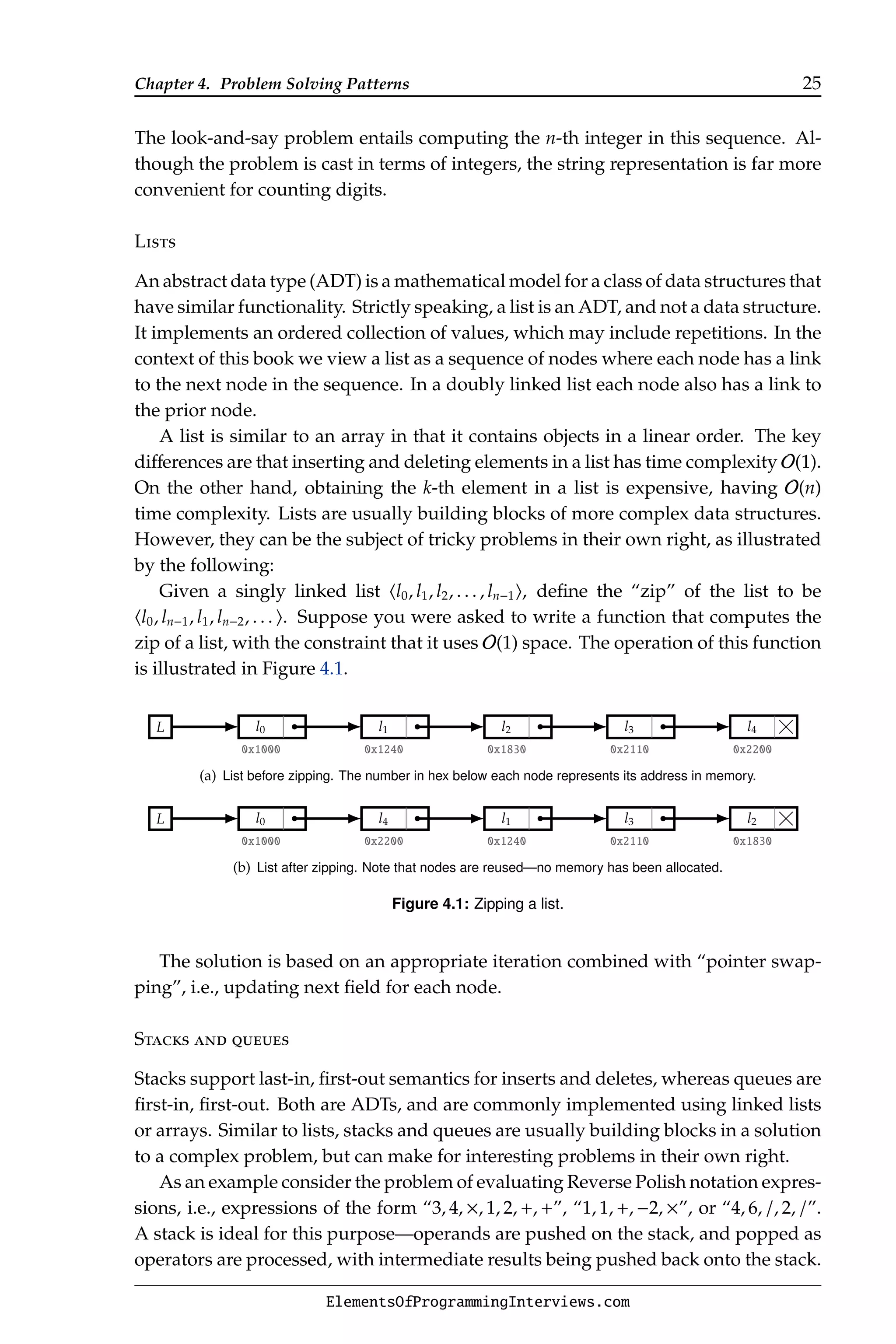
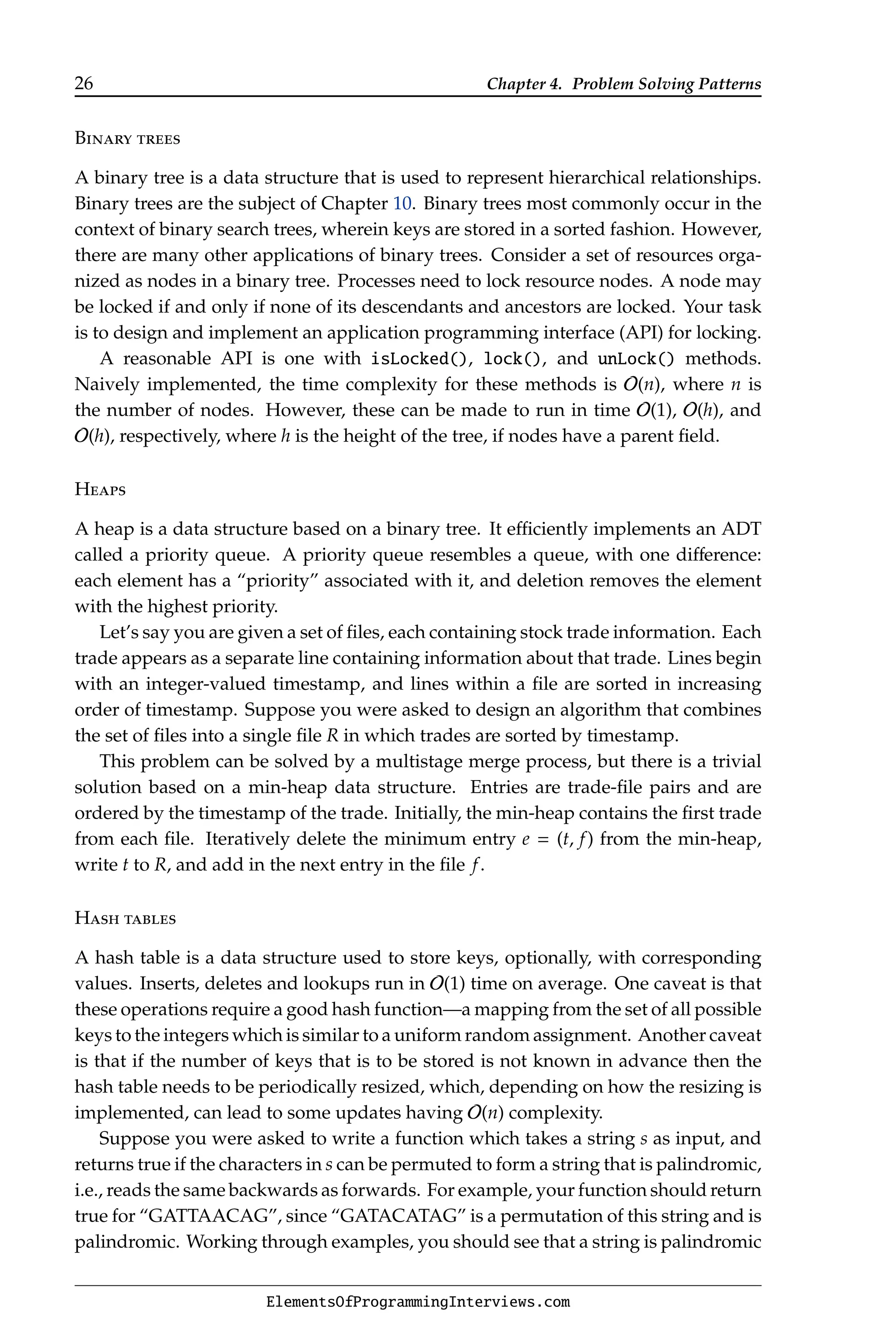
![Chapter 4. Problem Solving Patterns 27
if and only if each character appears an even number of times, with possibly a single
exception, since this allows for pairing characters in the first and second halves.
A hash table makes performing this test trivial. We build a hash table H whose
keys are characters, and corresponding values are the number of occurrences for
that character. The hash table H is created with a single pass over the string. After
computing the number of occurrences, we iterate over the key-value pairs in H. If
more than one character has an odd count, we return false; otherwise, we return true.
Suppose you were asked to write an application that compares n programs for
plagiarism. Specifically, your application is to break every program into overlapping
character strings, each of length 100, and report on the number of strings that appear
in each pair of programs. A hash table can be used to perform this check very
efficiently if the right hash function is used.
Binary search trees
Binary search trees (BSTs) are used to store objects that are comparable. BSTs are the
subject of Chapter 15. The underlying idea is to organize the objects in a binary tree
in which the nodes satisfy the BST property on Page 74. Insertion and deletion can
be implemented so that the height of the BST is O(log n), leading to fast (O(log n))
lookup and update times. AVL trees and red-black trees are BST implementations
that support this form of insertion and deletion.
BSTs are a workhorse of data structures and can be used to solve almost every
data structures problem reasonably efficiently. It is common to augment the BST to
make it possible to manipulate more complicated data, e.g., intervals, and efficiently
support more complex queries, e.g., the number of elements in a range.
As an example application of BSTs, consider the following problem. You are given
a set of line segments. Each segment is a closed interval [li, ri] of the x-axis, a color,
and a height. For simplicity assume no two segments whose intervals overlap have
the same height. When the x-axis is viewed from above the color at point x on the
x-axis is the color of the highest segment that includes x. (If no segment contains x,
the color is blank.) You are to implement a function that computes the sequence of
colors as seen from the top.
The key idea is to sort the endpoints of the line segments and do a sweep from
left-to-right. As we do the sweep, we maintain a list of line segments that intersect
the current position as well as the highest line and its color. To quickly lookup the
highest line in a set of intersecting lines we keep the current set in a BST, with the
interval’s height as its key.
Algorithm design patterns
An algorithm is a step-by-step procedure for performing a calculation. We classify
common algorithm design patterns in Table 4.2 on the following page. Roughly
speaking, each pattern corresponds to a design methodology. An algorithm may use
a combination of patterns.
ElementsOfProgrammingInterviews.com](https://image.slidesharecdn.com/elementsofprogramminginterviews-220623105328-e235fecd/75/Elements-of-Programming-Interviews-pdf-33-2048.jpg)
![28 Chapter 4. Problem Solving Patterns
Table 4.2: Algorithm design patterns.
Technique Key points
Sorting Uncover some structure by sorting the input.
Recursion If the structure of the input is defined in a recursive
manner, design a recursive algorithm that follows the
input definition.
Divide-and-conquer Divide the problem into two or more smaller inde-
pendent subproblems and solve the original problem
using solutions to the subproblems.
Dynamic program-
ming
Compute solutions for smaller instances of a given
problem and use these solutions to construct a solution
to the problem. Cache for performance.
Greedy algorithms Compute a solution in stages, making choices that are
locally optimum at step; these choices are never un-
done.
Invariants Identify an invariant and use it to rule out potential
solutions that are suboptimal/dominated by other so-
lutions.
Sorting
Certain problems become easier to understand, as well as solve, when the input
is sorted. The solution to the calendar rendering problem entails taking a set of
intervals and computing the maximum number of intervals whose intersection is
nonempty. Naïve strategies yield quadratic run times. However, once the interval
endpoints have been sorted, it is easy to see that a point of maximum overlap can be
determined by a linear time iteration through the endpoints.
Often it is not obvious what to sort on—for example, we could have sorted the
intervals on starting points rather than endpoints. This sort sequence, which in some
respects is more natural, does not work. However, some experimentation with it
will, in all likelihood, lead to the correct criterion.
Sorting is not appropriate when an O(n) (or better) algorithm is possible. Another
good example of a problem where a total ordering is not required is the problem
of rearranging elements in an array described on Page 35. Furthermore, sorting
can obfuscate the problem. For example, given an array A of numbers, if we are
to determine the maximum of A[i] − A[j], for i j, sorting destroys the order and
complicates the problem.
Recursion
A recursive function consists of base cases and calls to the same function with different
arguments. A recursive algorithm is often appropriate when the input is expressed
using recursive rules, such as a computer grammar. More generally, searching,
enumeration, divide-and-conquer, and decomposing a complex problem into a set
of similar smaller instances are all scenarios where recursion may be suitable.
ElementsOfProgrammingInterviews.com](https://image.slidesharecdn.com/elementsofprogramminginterviews-220623105328-e235fecd/75/Elements-of-Programming-Interviews-pdf-34-2048.jpg)
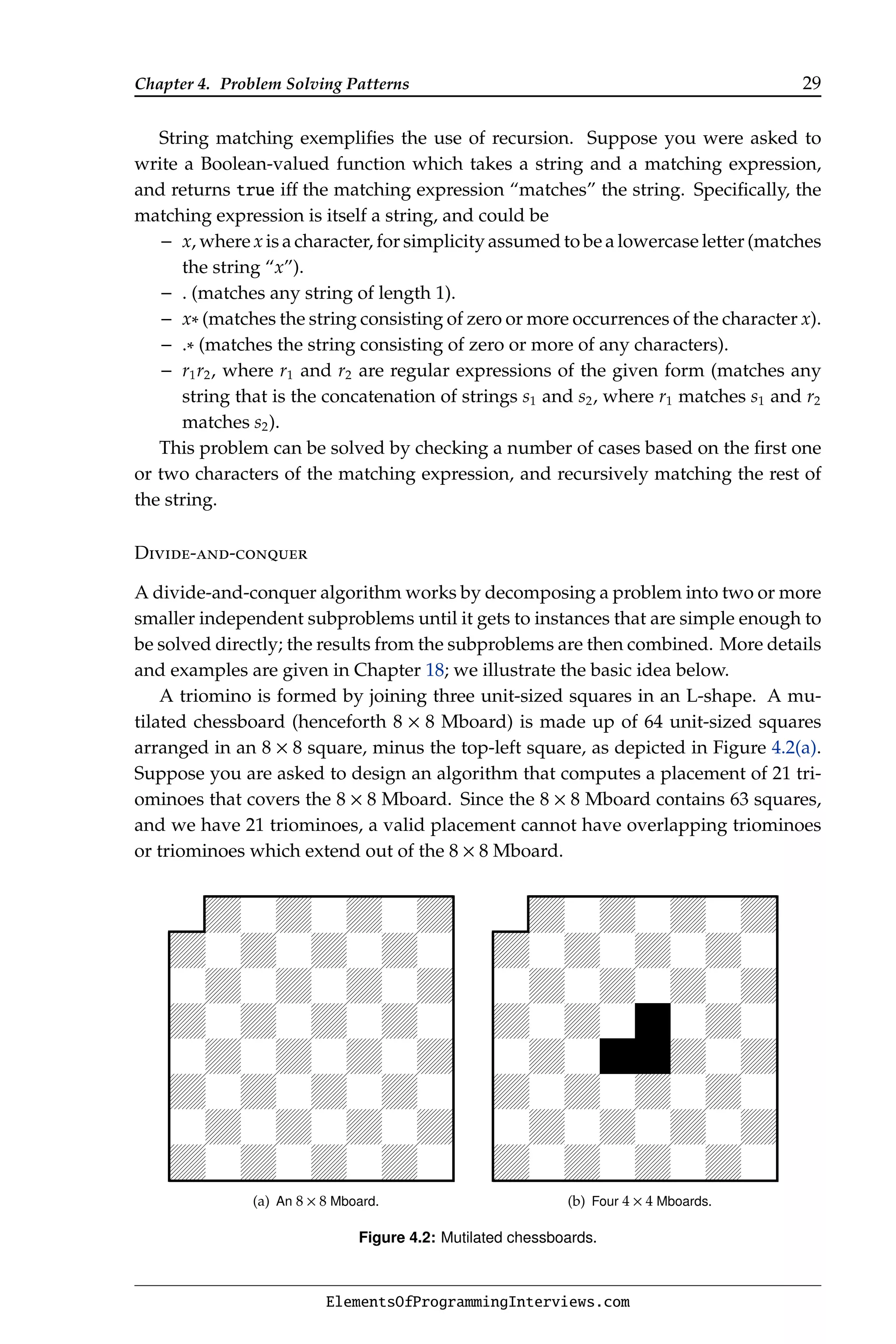
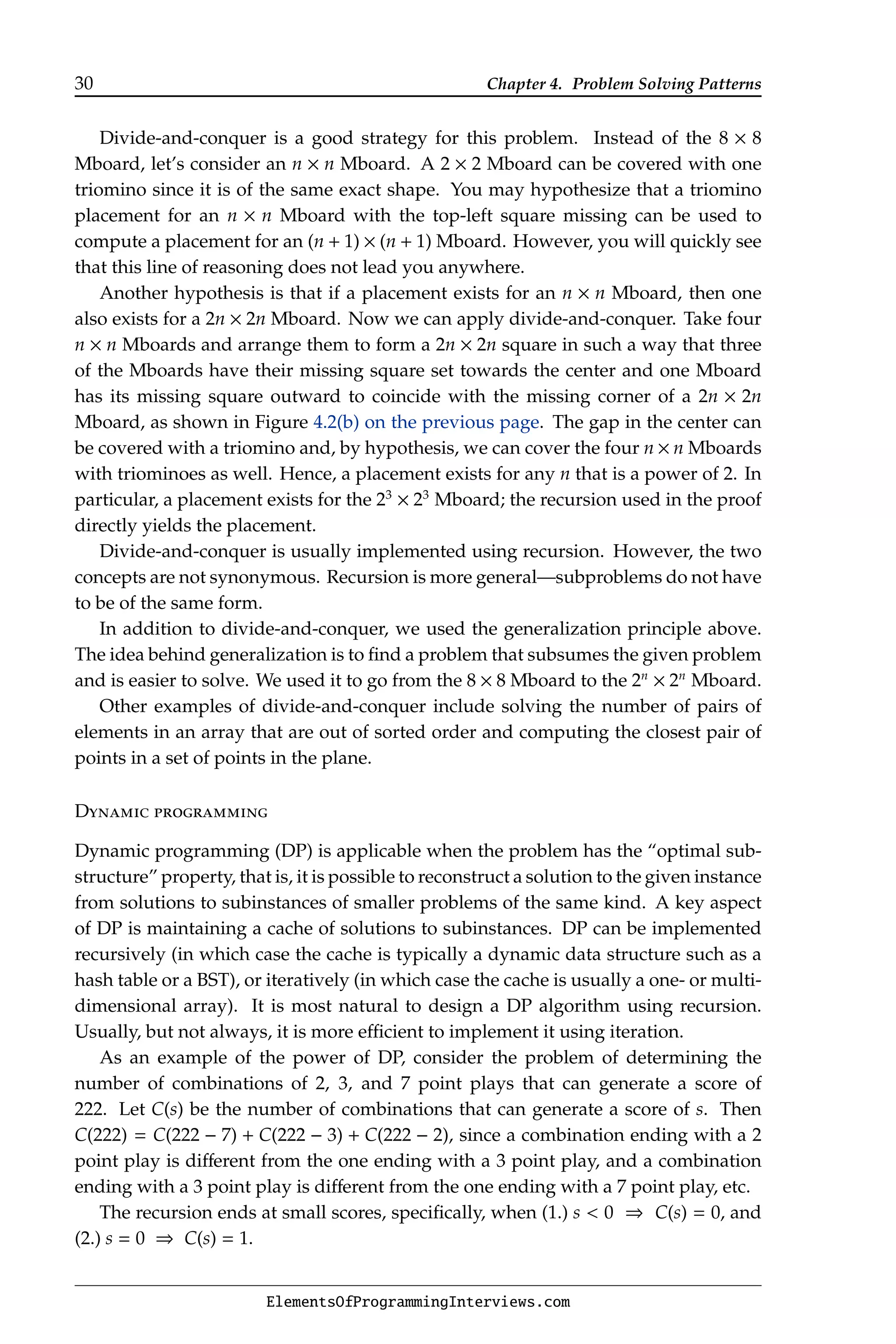
![Chapter 4. Problem Solving Patterns 31
Implementing the recursion naïvely results in multiple calls to the same subin-
stance. Let C(a) C(b) indicate that a call to C with input a directly calls C with input
b. Then C(213) will be called in the order C(222) C(222 − 7) C((222 − 7) − 2), as
well as C(222) C(222 − 3) C((222 − 3) − 3) C(((222 − 3) − 3) − 3).
This phenomenon results in the run time increasing exponentially with the size
of the input. The solution is to store previously computed values of C in an array of
length 223. Details are given in Solution 17.1 on Page 155.
Greedy algorithms
A greedy algorithm is one which makes decisions that are locally optimum and
never changes them. This strategy does not always yield the optimum solution.
Furthermore, there may be multiple greedy algorithms for a given problem, and
only some of them are optimum.
For example, consider 2n cities on a line, half of which are white, and the other
half are black. We want to map white to black cities in a one-to-one fashion so that
the total length of the road sections required to connect paired cities is minimized.
Multiple pairs of cities may share a single section of road, e.g., if we have the pairing
(0, 4) and (1, 2) then the section of road between Cities 0 and 4 can be used by Cities 1
and 2.
The most straightforward greedy algorithm for this problem is to scan through
the white cities, and, for each white city, pair it with the closest unpaired black city.
This algorithm leads to suboptimum results. Consider the case where white cities
are at 0 and at 3 and black cities are at 2 and at 5. If the straightforward greedy
algorithm processes the white city at 3 first, it pairs it with 2, forcing the cities at 0
and 5 to pair up, leading to a road length of 5, whereas the pairing of cities at 0 and
2, and 3 and 5 leads to a road length of 4.
However, a slightly more sophisticated greedy algorithm does lead to optimum
results: iterate through all the cities in left-to-right order, pairing each city with the
nearest unpaired city of opposite color. More succinctly, let W and B be the arrays
of white and black city coordinates. Sort W and B, and pair W[i] with B[i]. We can
prove this leads to an optimum pairing by induction. The idea is that the pairing for
the first city must be optimum, since if it were to be paired with any other city, we
could always change its pairing to be with the nearest black city without adding any
road.
Chapter 18 contains a number of problems whose solutions employ greedy al-
gorithms. representative. Several problems in other chapters also use a greedy
algorithm as a key subroutine.
Invariants
One common approach to designing an efficient algorithm is to use invariants.
Briefly, an invariant is a condition that is true during execution of a program. This
condition may be on the values of the variables of the program, or on the control
ElementsOfProgrammingInterviews.com](https://image.slidesharecdn.com/elementsofprogramminginterviews-220623105328-e235fecd/75/Elements-of-Programming-Interviews-pdf-37-2048.jpg)
![32 Chapter 4. Problem Solving Patterns
logic. A well-chosen invariant can be used to rule out potential solutions that are
suboptimal or dominated by other solutions.
An invariant can also be used to analyze a given algorithm, e.g., to prove its
correctness, or analyze its time complexity. Here our focus is on designing algorithms
with invariants, not analyzing them.
As an example, consider the 2-sum problem. We are given an array A of sorted
integers, and a target value K. We want to know if there exist entries i and j in A such
that A[i] + A[j] = K.
The brute-force algorithm for the 2-sum problem consists of a pair of nested for
loops. Its complexity is O(n2
), where n is the length of A. A faster approach is to add
each element of A to a hash H, and test for each i if K − A[i] is present in H. While
reducing time complexity to O(n), this approach requires O(n) additional storage for
H.
We want to compute i and j such that A[i] + A[j] = K. Without loss of generality,
we can take i ≤ j. We know that 0 ≤ i, and j ≤ n − 1. A natural approach then is
to initialize i to 0, and j to n − 1, and then update i and j preserving the following
invariant:
− No i0
i can ever be paired with any j0
such that A[i0
] + A[j0
] = K, and
− No j0
j can ever be paired with any i0
such that A[i0
] + A[j0
] = K.
The invariant is certainly true at initialization, since there are no i0
0 and j0
n − 1.
To show how i and j can be updated while ensuring the invariant continues to
hold, consider A[i] + A[j]. If A[i] + A[j] = K, we are done. Otherwise, consider
the case A[i] + A[j] K. We know from the invariant that for no j0
j is there a
solution in which the element with the larger index is j0
. The element at i cannot
be paired with any element at an index j0
smaller than j—because A is sorted,
A[i] + A[j0
] ≤ A[i] + A[j] K. Therefore, we can increment i, and preserve the
invariant. Similarly, in the case A[i] + A[j] K, we can decrement j and preserve the
invariant.
We terminate when either A[i] + A[j] = K (success) or i j (failure). At each step,
we increment or decrement i or j. Since there are at most n steps, and each takes
O(1) time, the time complexity is O(n). Correctness follows from the fact that the
invariant never discards a value for i or j which could possibly be the index of an
element which sums with another element to K.
Identifying the right invariant is an art. Usually, it is arrived at by studying
concrete examples and then making an educated guess. Often the first invariant is
too strong, i.e., it does not hold as the program executes, or too weak, i.e., it holds
throughout the program execution but cannot be used to infer the result.
In some cases it may be possible to “prune” dominated solutions, i.e., solutions
which cannot be better than previously explored solutions. The candidate solutions
are referred to as the “efficient frontier” which is propagated through the computa-
tion. The efficient frontier can be viewed as an invariant.
For example, suppose we need to implement a stack that supports the max()
method, which is defined to return the largest value stored in the stack. We can
associate for each entry in the stack the largest value stored at or below that entry.
ElementsOfProgrammingInterviews.com](https://image.slidesharecdn.com/elementsofprogramminginterviews-220623105328-e235fecd/75/Elements-of-Programming-Interviews-pdf-38-2048.jpg)
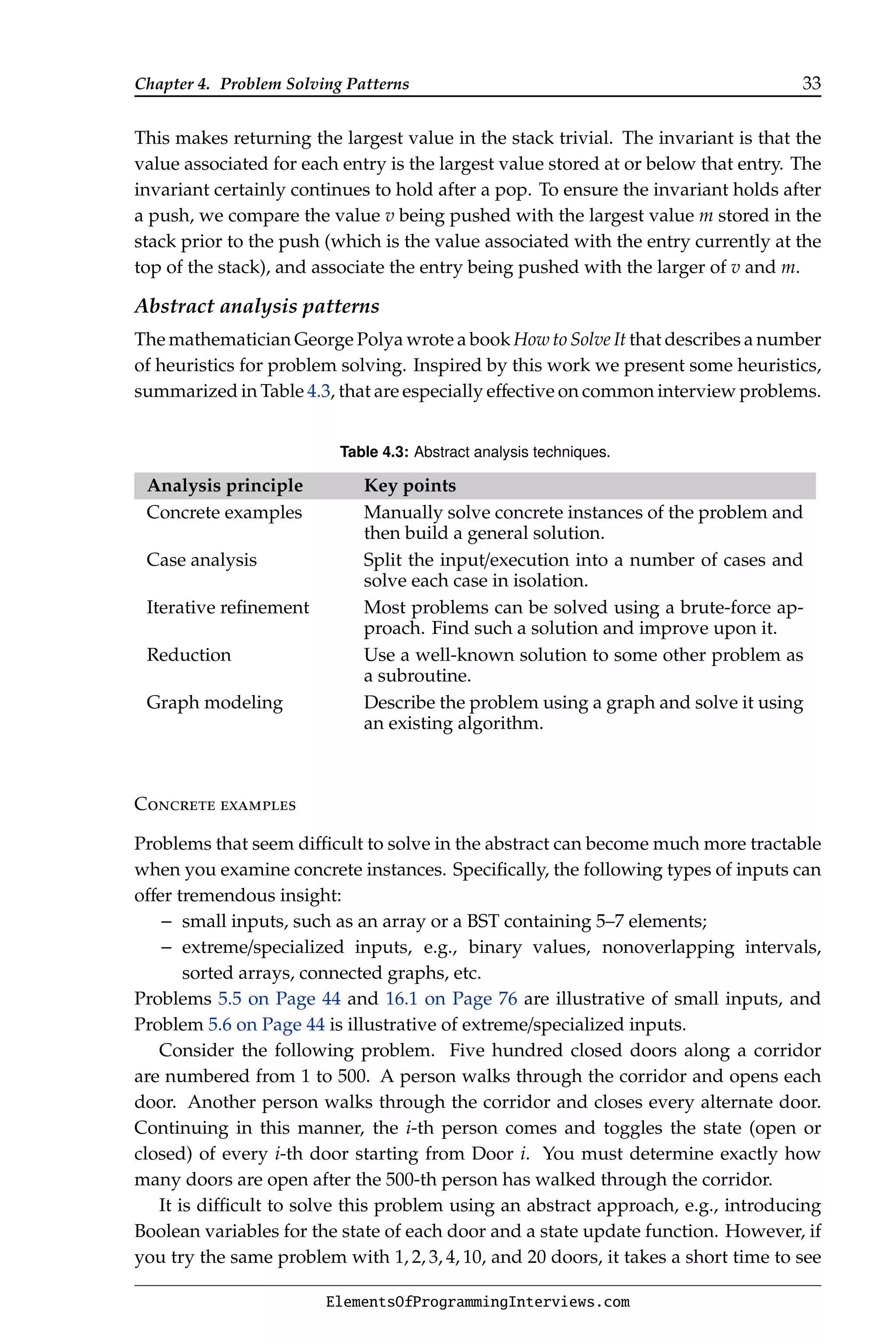

![Chapter 4. Problem Solving Patterns 35
Iterative refinement of a brute-force solution
Many problems can be solved optimally by a simple algorithm that has a high
time/space complexity—this is sometimes referred to as a brute-force solution. Other
terms are exhaustive search and generate-and-test. Often this algorithm can be refined
to one that is faster. At the very least it may offer hints into the nature of the problem.
As an example, suppose you were asked to write a function that takes an array A
of n numbers, and rearranges A’s elements to get a new array B having the property
that B[0] ≤ B[1] ≥ B[2] ≤ B[3] ≥ B[4] ≤ B[5] ≥ · · · .
One straightforward solution is to sort A and interleave the bottom and top
halves of the sorted array. Alternately, we could sort A and then swap the elements
at the pairs (A[1], A[2]), (A[3], A[4]), . . . . Both these approaches have the same time
complexity as sorting, namely O(n log n).
You will soon realize that it is not necessary to sort A to achieve the desired
configuration—you could simply rearrange the elements around the median, and
then perform the interleaving. Median finding can be performed in time O(n), which
is the overall time complexity of this approach.
Finally, you may notice that the desired ordering is very local, and realize that it
is not necessary to find the median. Iterating through the array and swapping A[i]
and A[i + 1] when i is even and A[i] A[i + 1] or i is odd and A[i] A[i + 1] achieves
the desired configuration. In code:
1 void rearrange(vectorint* A) {
2 vectorint B = *A;
3 for (size_t i = 1; i B.size(); ++i) {
4 if ((!(i 1) B[i - 1] B[i]) || ((i 1) B[i - 1] B[i])) {
5 swap(B[i - 1], B[i]);
6 }
7 }
8 }
This approach has time complexity O(n), which is the same as the approach based
on median finding. However, it is much easier to implement and operates in an
online fashion, i.e., it never needs to store more than two elements in memory or
read a previous element.
As another example of iterative refinement, consider the problem of string search:
given two strings s (search string) and t (text), find all occurrences of s in t. Since
s can occur at any offset in t, the brute-force solution is to test for a match at every
offset. This algorithm is perfectly correct; its time complexity is O(nm), where n and
m are the lengths of s and t.
After trying some examples you may see that there are several ways to improve
the time complexity of the brute-force algorithm. As an example, if the character t[i]
is not present in s you can advance the matching by n characters. Furthermore, this
skipping works better if we match the search string from its end and work backwards.
These refinements will make the algorithm very fast (linear time) on random text and
search strings; however, the worst-case complexity remains O(nm).
ElementsOfProgrammingInterviews.com](https://image.slidesharecdn.com/elementsofprogramminginterviews-220623105328-e235fecd/75/Elements-of-Programming-Interviews-pdf-41-2048.jpg)
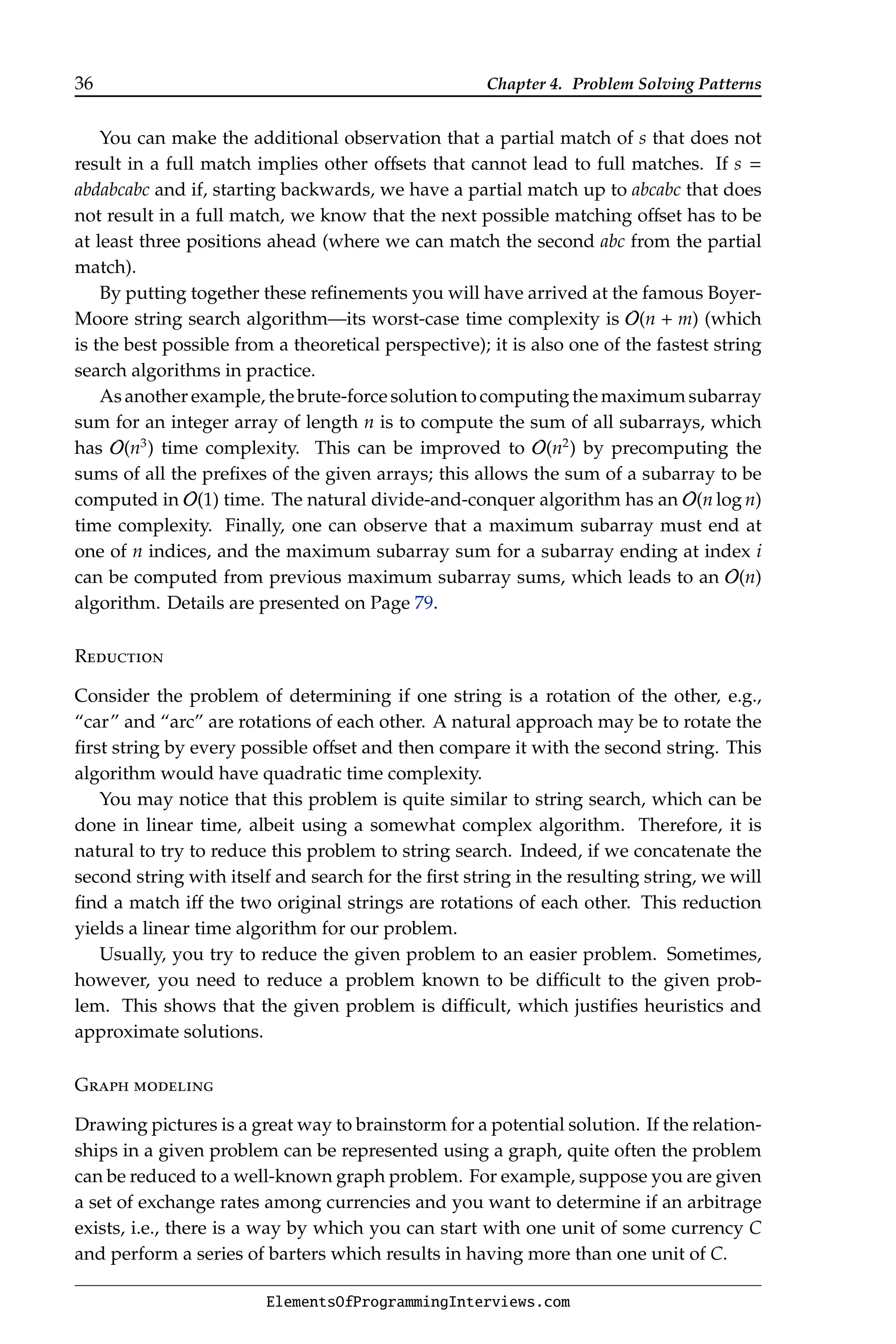
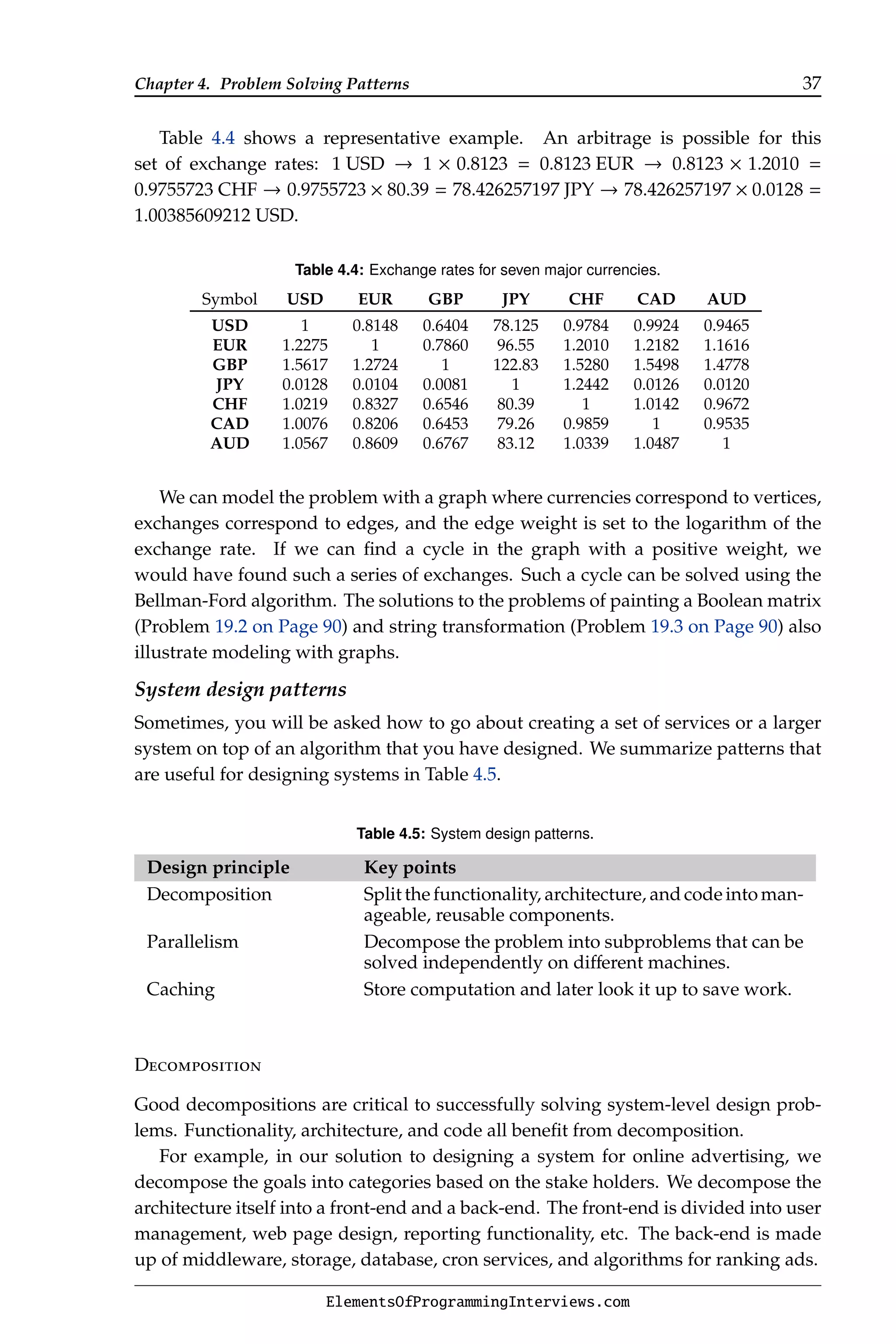

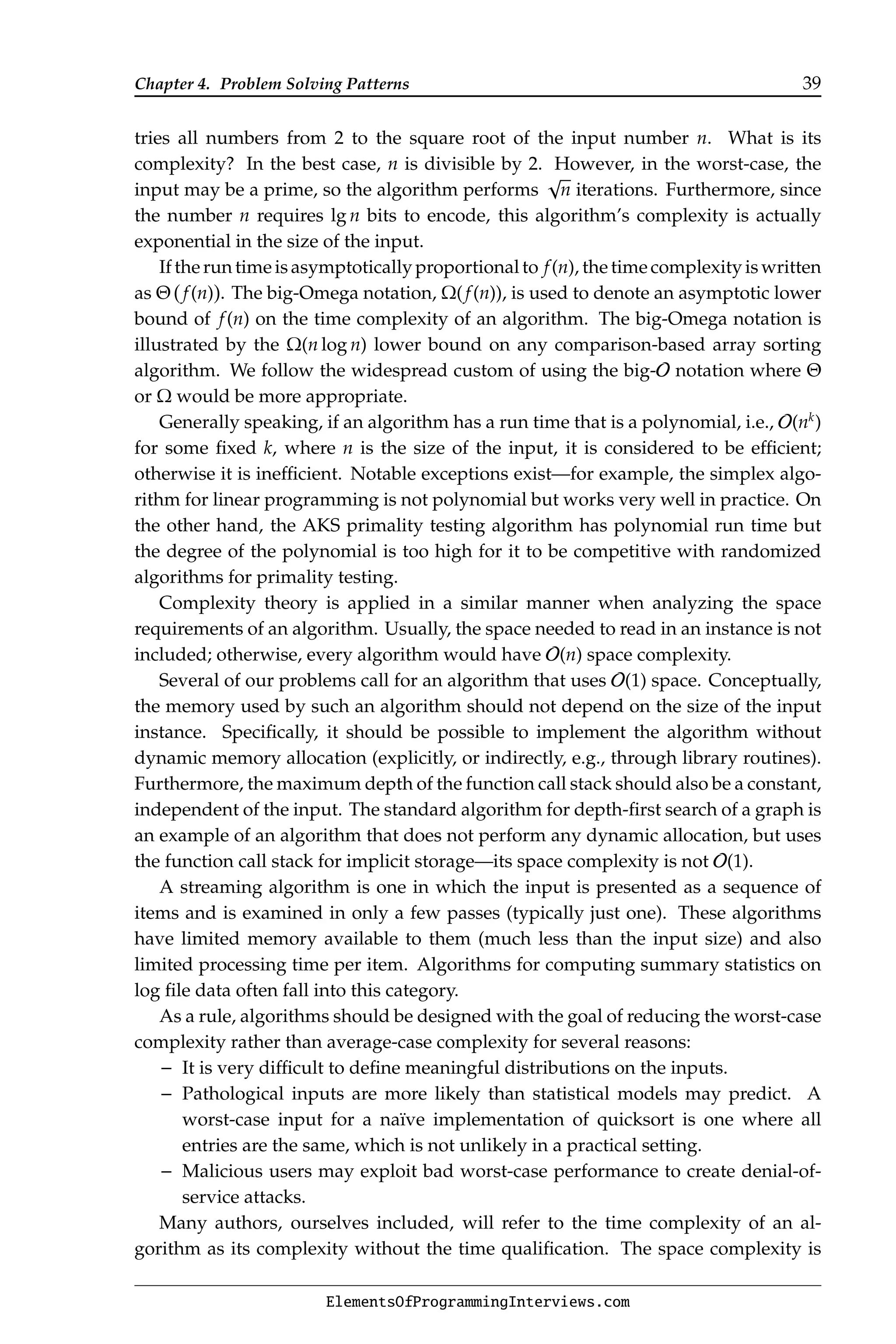
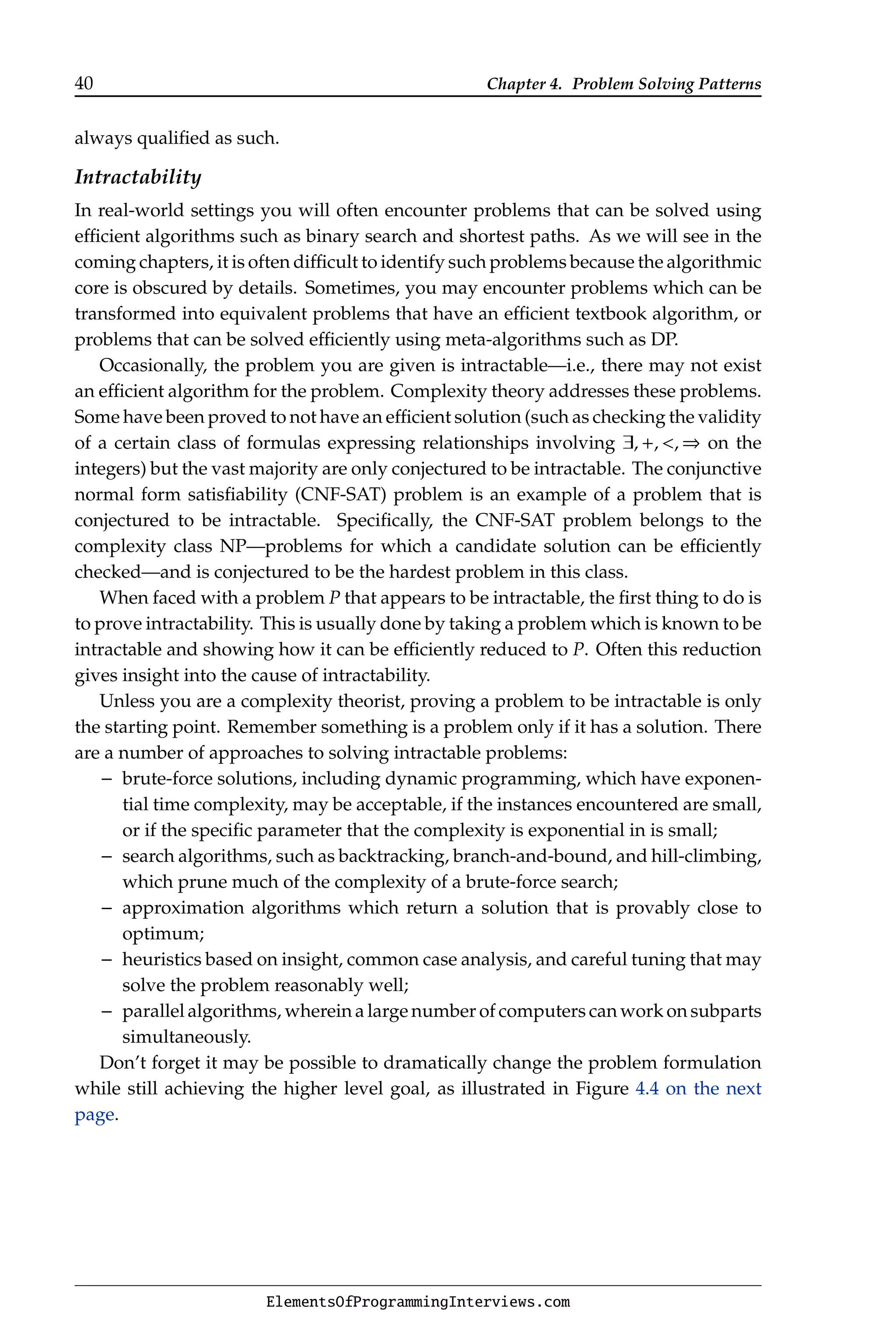
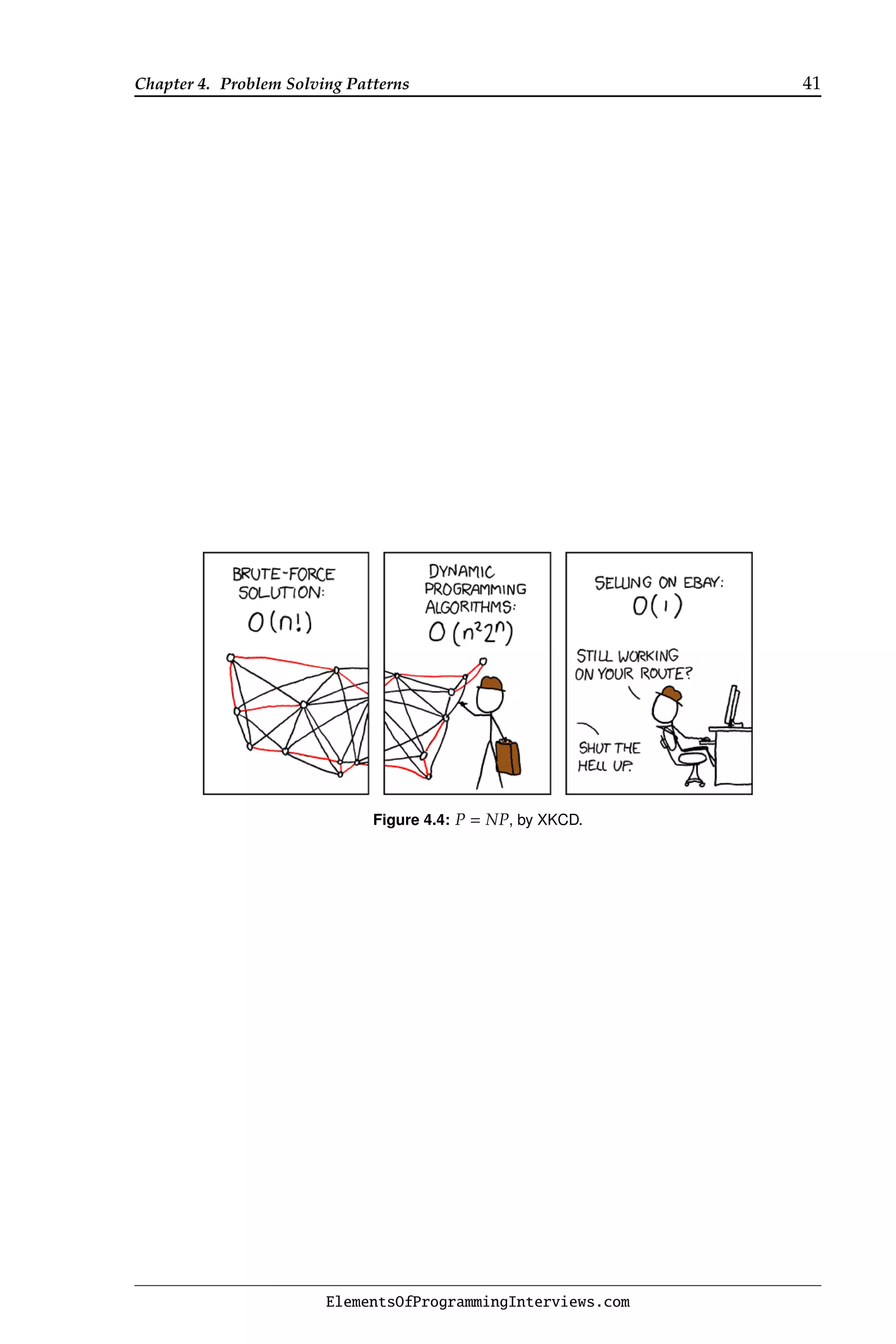

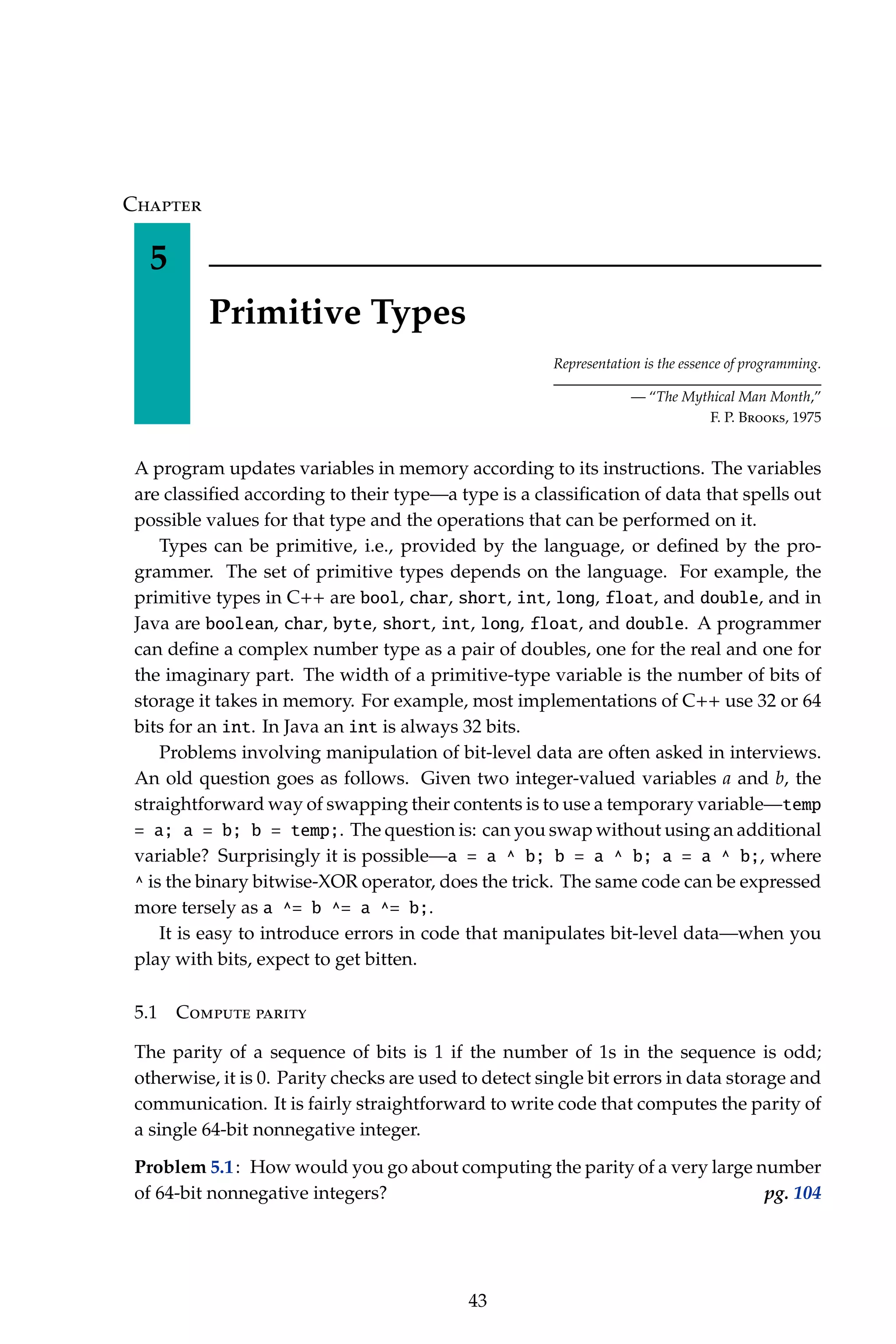
![44 5.2. Compute x/y
5.2 Compute x/y
Problem 5.2: Given two positive integers x and y, how would you compute x/y if
the only operators you can use are addition, subtraction, and shifting? pg. 105
5.3 Convert base
In the decimal system, the position of a digit is used to signify the power of 10 that
digit is to be multiplied with. For example, “314” denotes the number 3 × 100 + 1 ×
10 + 4 × 1. (Note that zero, which is not needed in other systems, is essential in the
decimal system, since a zero can be used to skip a power.)
The decimal system is an example of a positional number system, wherein the
same symbol is used for different orders of magnitude (for example, the “ones place”,
“tens place”, “hundreds place”). This system greatly simplified arithmetic and led
to its widespread adoption.
The base b number system generalizes the above: the string “ak−1ak−2 . . . a1a0”,
where 0 ≤ ai b, for each i ∈ [0, k − 1] denotes the integer
Pk−1
i=0 aibi
.
Problem 5.3: Write a function that performs base conversion. Specifically, the input
is an integer base b1, a string s, representing an integer x in base b1, and another
integer base b2; the output is the string representing the integer x in base b2. Assume
2 ≤ b1, b2 ≤ 16. Use “A” to represent 10, “B” for 11, . . . , and “F” for 15. pg. 106
5.4 Generate uniform random numbers
This problem is motivated by the following. Five friends have to select a designated
driver using a single unbiased coin. The process should be fair to everyone.
Problem 5.4: How would you implement a random number generator that gener-
ates a random integer i in [a, b], given a random number generator that produces
either zero or one with equal probability? All generated values should have equal
probability. What is the run time of your algorithm? pg. 107
5.5 The open doors problem
Five hundred closed doors along a corridor are numbered from 1 to 500. A person
walks through the corridor and opens each door. Another person walks through the
corridor and closes every alternate door. Continuing in this manner, the i-th person
comes and toggles the position of every i-th door starting from door i.
Problem 5.5: Which doors are open after the 500-th person has walked through?
pg. 108
5.6 Compute the greatest common divisor
The greatest common divisor (GCD) of positive integers x and y is the largest integer
d such that d | x and d | y, where a | b denotes a divides b, i.e., b mod a = 0.
ElementsOfProgrammingInterviews.com](https://image.slidesharecdn.com/elementsofprogramminginterviews-220623105328-e235fecd/75/Elements-of-Programming-Interviews-pdf-50-2048.jpg)

![Chapter
6
Arrays
The machine can alter the scanned symbol and its behavior
is in part determined by that symbol, but the symbols on the
tape elsewhere do not affect the behavior of the machine.
— “Intelligent Machinery,”
A. M. Turing, 1948
Arrays
The simplest data structure is the array, which is a contiguous block of memory.
Given an array A which holds n objects, A[i] denotes the (i + 1)-th object stored in the
array. Retrieving and updating A[i] takes O(1) time. However, the size of the array is
fixed, which makes adding more than n objects impossible. Deletion of the object at
location i can be handled by having an auxiliary Boolean associated with the location
i indicating whether the entry is valid.
Insertion of an object into a full array can be handled by allocating a new array
with additional memory and copying over the entries from the original array. This
makes the worst-case time of insertion high but if the new array has, for example,
twice the space of the original array, the average time for insertion is constant since
the expense of copying the array is infrequent. This concept is formalized using
amortized analysis.
6.1 The Dutch national flag problem
The quicksort algorithm for sorting arrays proceeds recursively—it selects an element
x (the “pivot”), reorders the array to make all the elements less than or equal to x
appear first, followed by all the elements greater than x. The two subarrays are then
sorted recursively.
Implemented naïvely, this approach leads to large run times on arrays with many
duplicates. One solution is to reorder the array so that all elements less than x appear
first, followed by elements equal to x, followed by elements greater than x. This is
known as Dutch national flag partitioning, because the Dutch national flag consists
of three horizontal bands, each in a different color. Assuming that black precedes
white and white precedes gray, Figure 6.1(b) on the facing page is a valid partitioning
for Figure 6.1(a) on the next page. If gray precedes black and black precedes white,
Figure 6.1(c) on the facing page is a valid partitioning for Figure 6.1(a) on the next
page.
46](https://image.slidesharecdn.com/elementsofprogramminginterviews-220623105328-e235fecd/75/Elements-of-Programming-Interviews-pdf-52-2048.jpg)
![6.2. Compute the max difference 47
When an array consists of entries from a small set of keys, e.g., {0, 1, 2}, one way
to sort it is to count the number of occurrences of each key. Consequently, enumerate
the keys in sorted order and write the corresponding number of keys to the array. If
a BST is used for counting, the time complexity of this approach is O(n log k), where
n is the array length and k is the number of keys. This is known as counting sort.
Counting sort, as just described, does not differentiate among different objects with
the same key value. This problem is concerned with a special case of counting sort
when entries are objects rather than keys.
(a) Before partitioning. (b) A three-way partitioning resem-
bling the Dutch national flag.
(c) Another three-way partitioning:
the Russian national flag.
Figure 6.1: Illustrating the Dutch national flag problem.
Problem 6.1: Write a function that takes an array A of length n and an index i into
A, and rearranges the elements such that all elements less than A[i] appear first,
followed by elements equal to A[i], followed by elements greater than A[i]. Your
algorithm should have O(1) space complexity and O(n) time complexity. pg. 109
6.2 Compute the max difference
The problem of computing the maximum difference in an array, specifically
maxij(A[i] − A[j]) arises in a number of contexts. We introduced this problem
in the context of historical stock quote information on Page 1. Here we study another
application of the same problem.
A robot needs to travel along a path that includes several ascents and descents.
When it goes up, it uses its battery to power the motor and when it descends, it
recovers the energy which is stored in the battery. The battery recharging process
is ideal: on descending, every Joule of gravitational potential energy converts to a
Joule of electrical energy which is stored in the battery. The battery has a limited
capacity and once it reaches this capacity, the energy generated in descending is lost.
Problem 6.2: Design an algorithm that takes a sequence of n three-dimensional
coordinates to be traversed, and returns the minimum battery capacity needed to
complete the journey. The robot begins with a fully charged battery. pg. 110
6.3 Solve generalizations of max difference
Problem 6.2, which is concerned with computing max0≤ij≤n−1(A[j]−A[i]), generalizes
naturally to the following three problems.
ElementsOfProgrammingInterviews.com](https://image.slidesharecdn.com/elementsofprogramminginterviews-220623105328-e235fecd/75/Elements-of-Programming-Interviews-pdf-53-2048.jpg)
![48 6.4. Sample offline data
Problem 6.3: For each of the following, A is an integer array of length n.
(1.) Compute the maximum value of (A[j0] − A[i0]) + (A[j1] − A[i1]), subject to
i0 j0 i1 j1.
(2.) Compute the maximum value of
Pk−1
t=0 (A[jt]−A[it]), subject to i0 j0 i1 j1
· · · ik−1 jk−1. Here k is a fixed input parameter.
(3.) Repeat Problem (2.) when k can be chosen to be any value from 0 to bn/2c.
pg. 111
6.4 Sample offline data
Problem 6.4: Let A be an array of n distinct elements. Design an algorithm that
returns a subset of k elements of A. All subsets should be equally likely. Use as few
calls to the random number generator as possible and use O(1) additional storage.
You can return the result in the same array as input. pg. 113
6.5 Sample online data
This problem is motivated by the design of a packet sniffer that provides a uniform
sample of packets for a network session.
Problem 6.5: Design an algorithm that reads a sequence of packets and maintains a
uniform random subset of size k of the read packets when the n ≥ k-th packet is read.
pg. 114
Multidimensional arrays
Thus far we have focused our attention in this chapter on one-dimensional arrays. We
now turn our attention to multidimensional arrays. A 2D array in an array whose
entries are themselves arrays; the concept generalizes naturally to k dimensional
arrays.
Multidimensional arrays arise in image processing, board games, graphs, mod-
eling spatial phenomenon, etc. Often, but not always, the arrays that constitute the
entries of a 2D array A have the same length, in which case we refer to A as being an
m × n rectangular array (or sometimes just an m × n array), where m is the number of
entries in A, and n the number of entries in A[0]. The elements within a 2D array A
are often referred to by their row and column indices i and j, and written as A[i][j] or
A[i, j].
ElementsOfProgrammingInterviews.com](https://image.slidesharecdn.com/elementsofprogramminginterviews-220623105328-e235fecd/75/Elements-of-Programming-Interviews-pdf-54-2048.jpg)
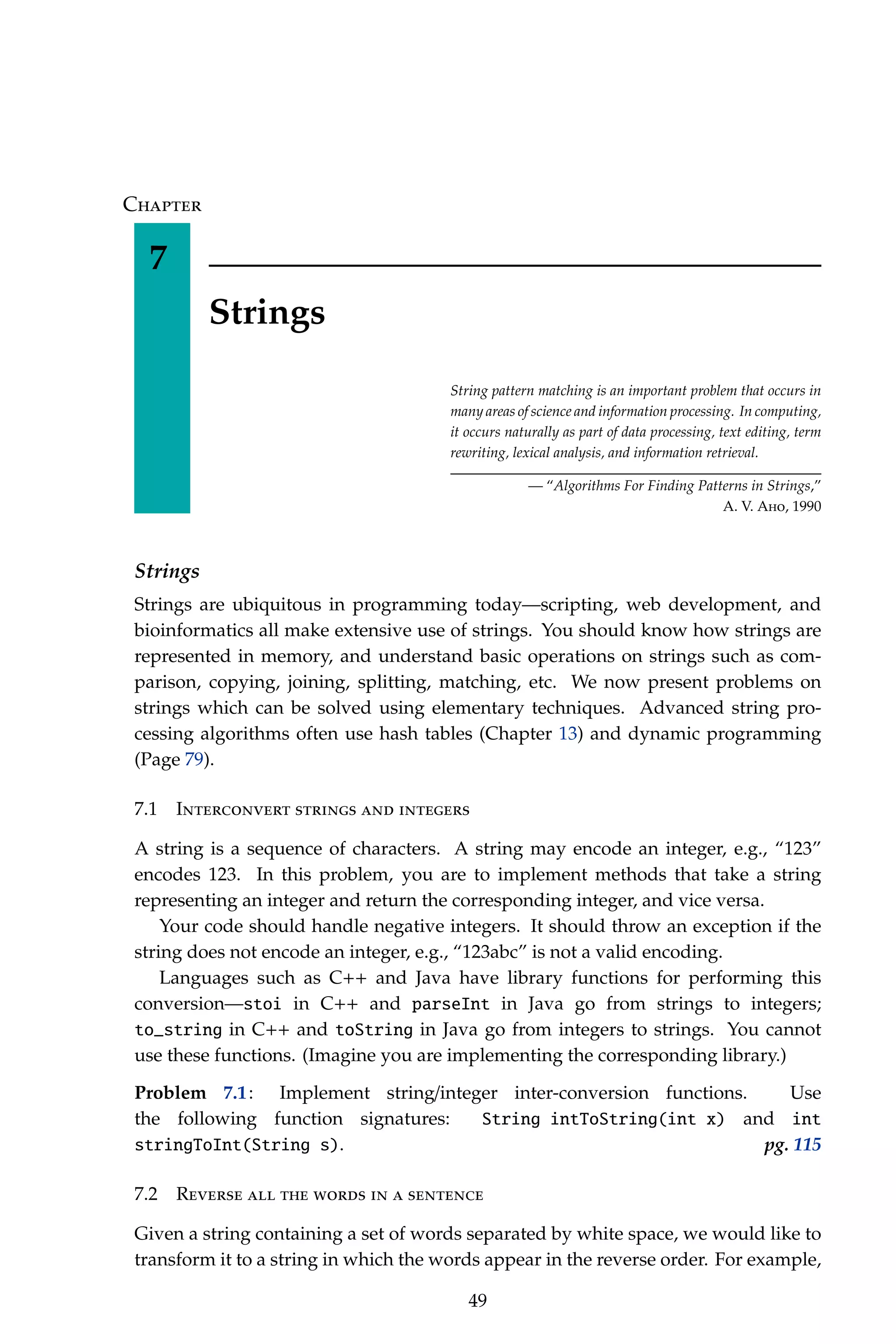
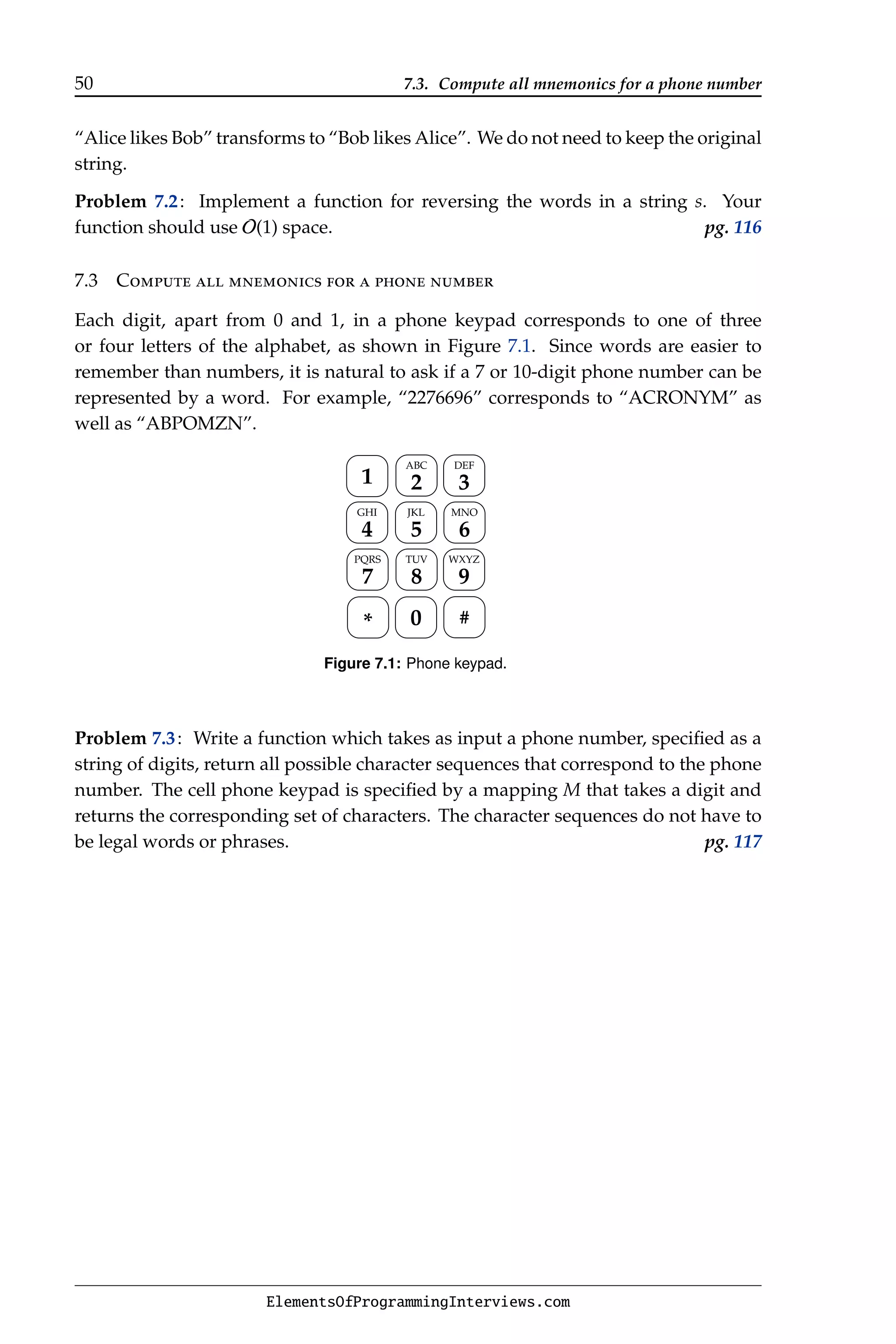
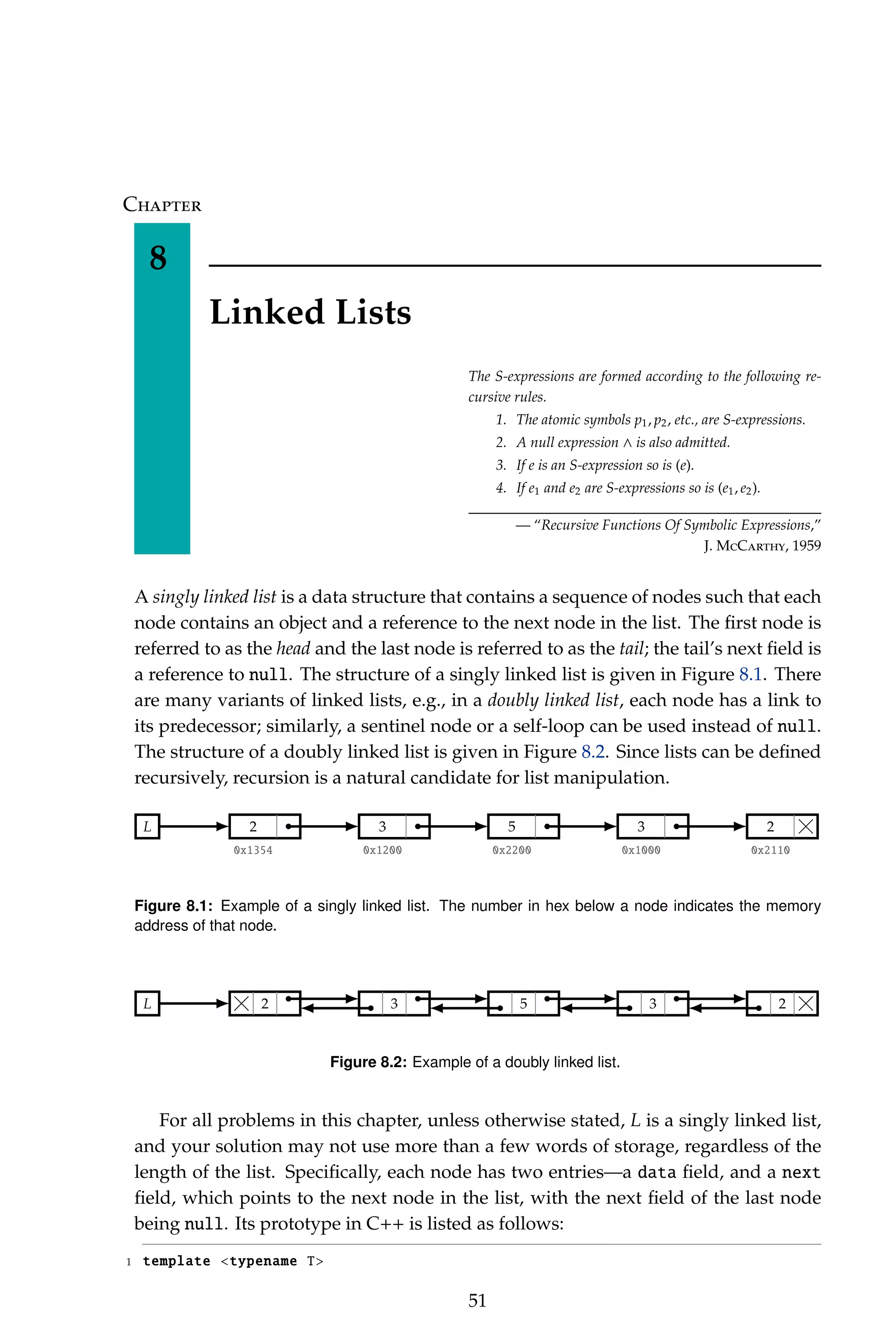
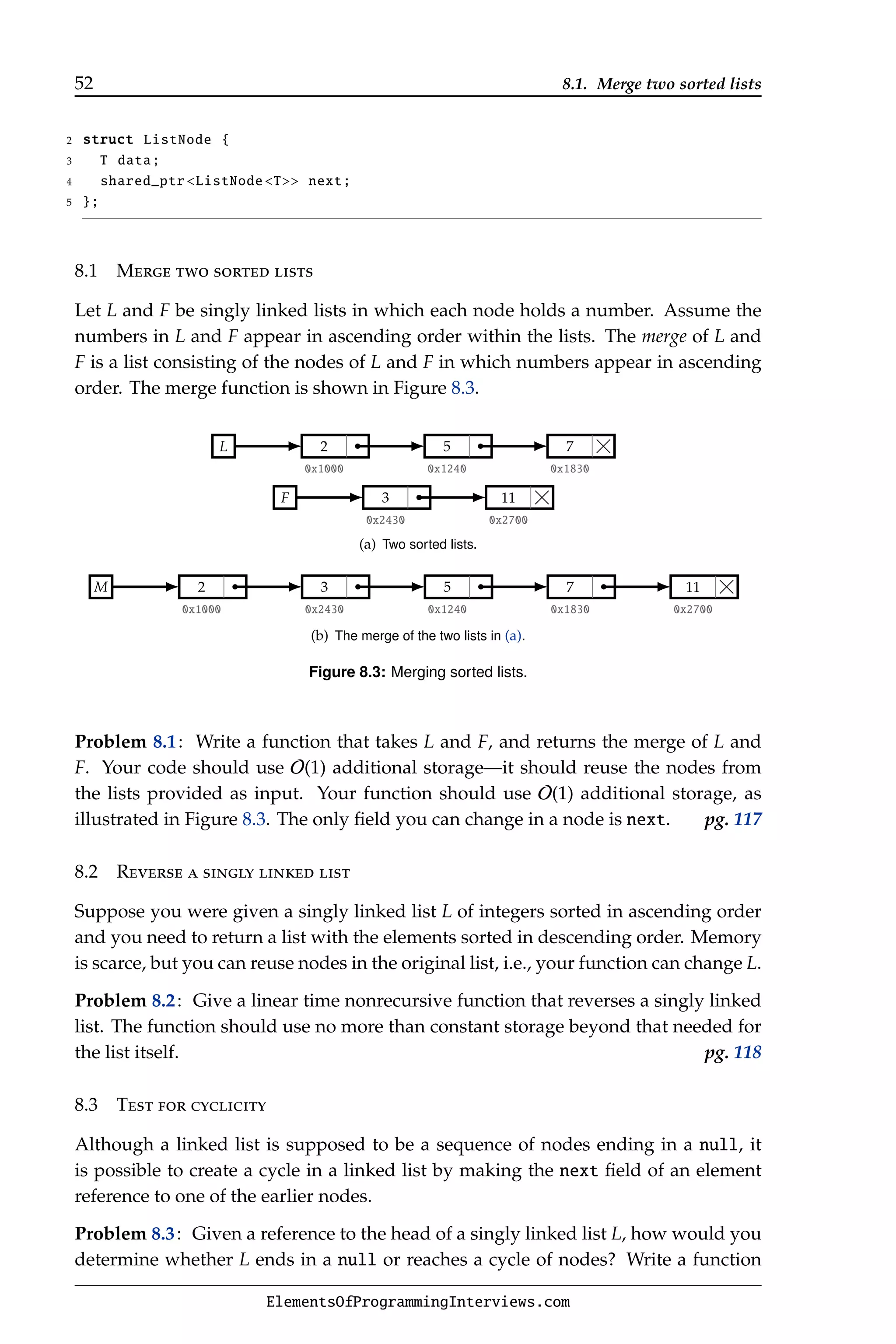
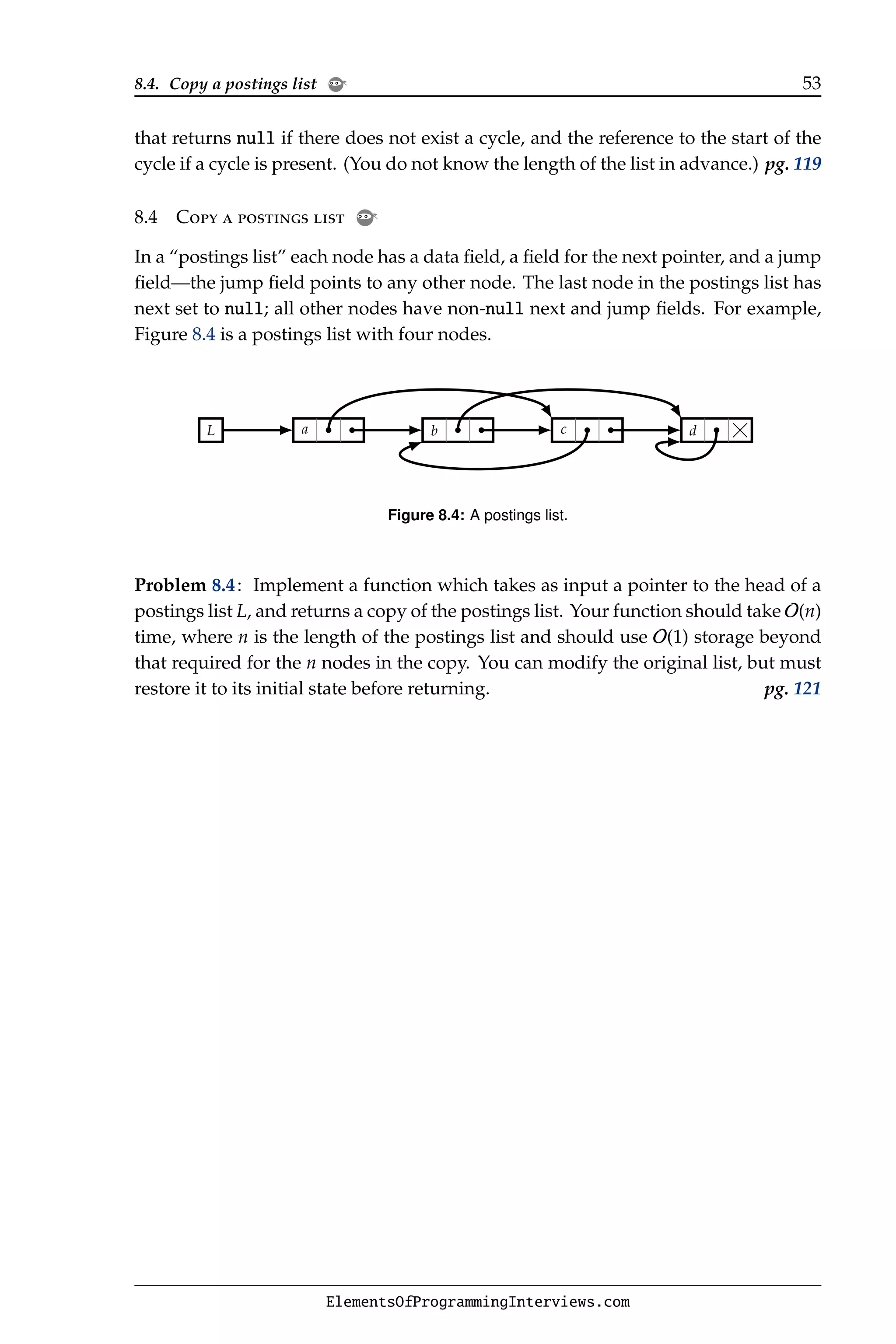
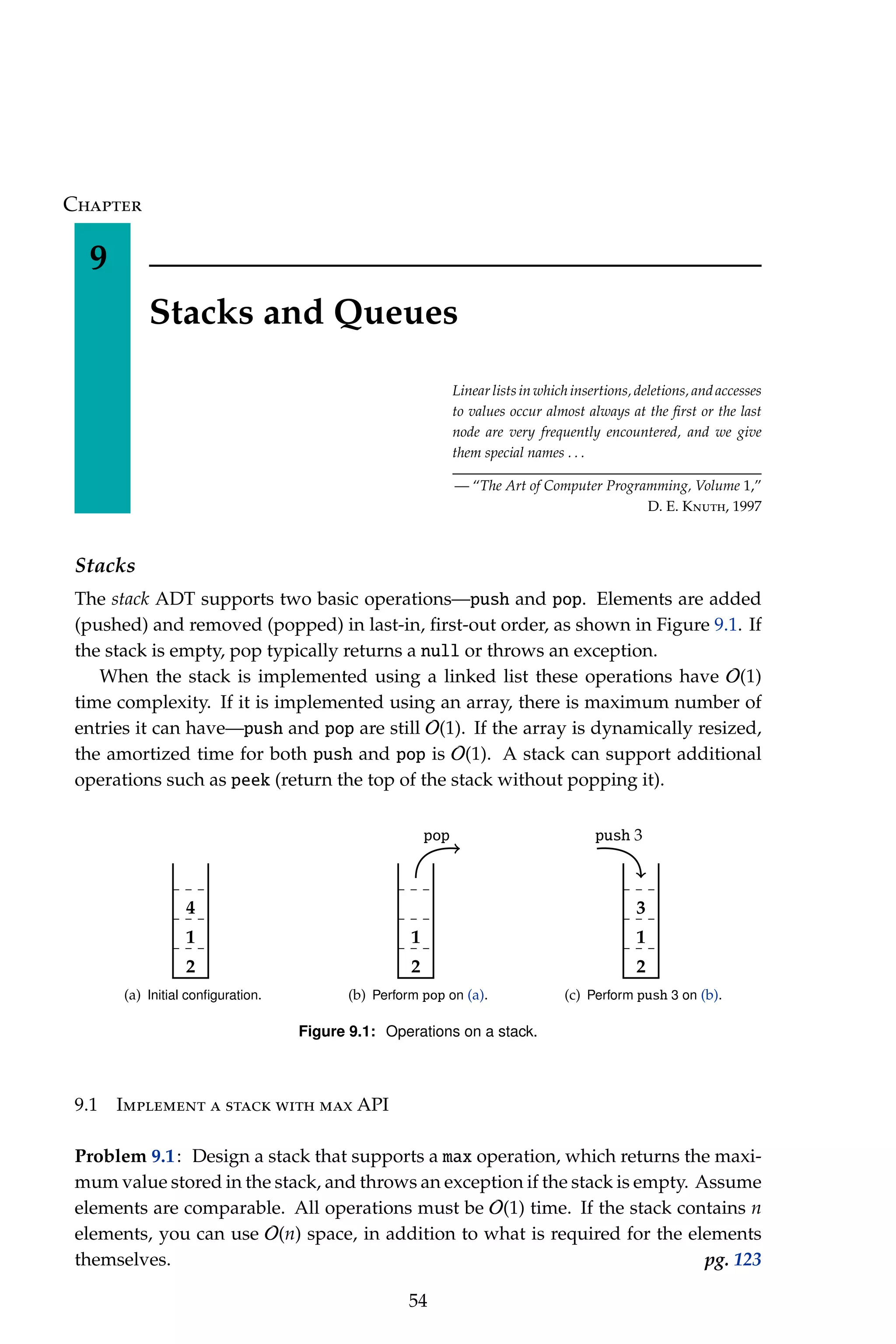


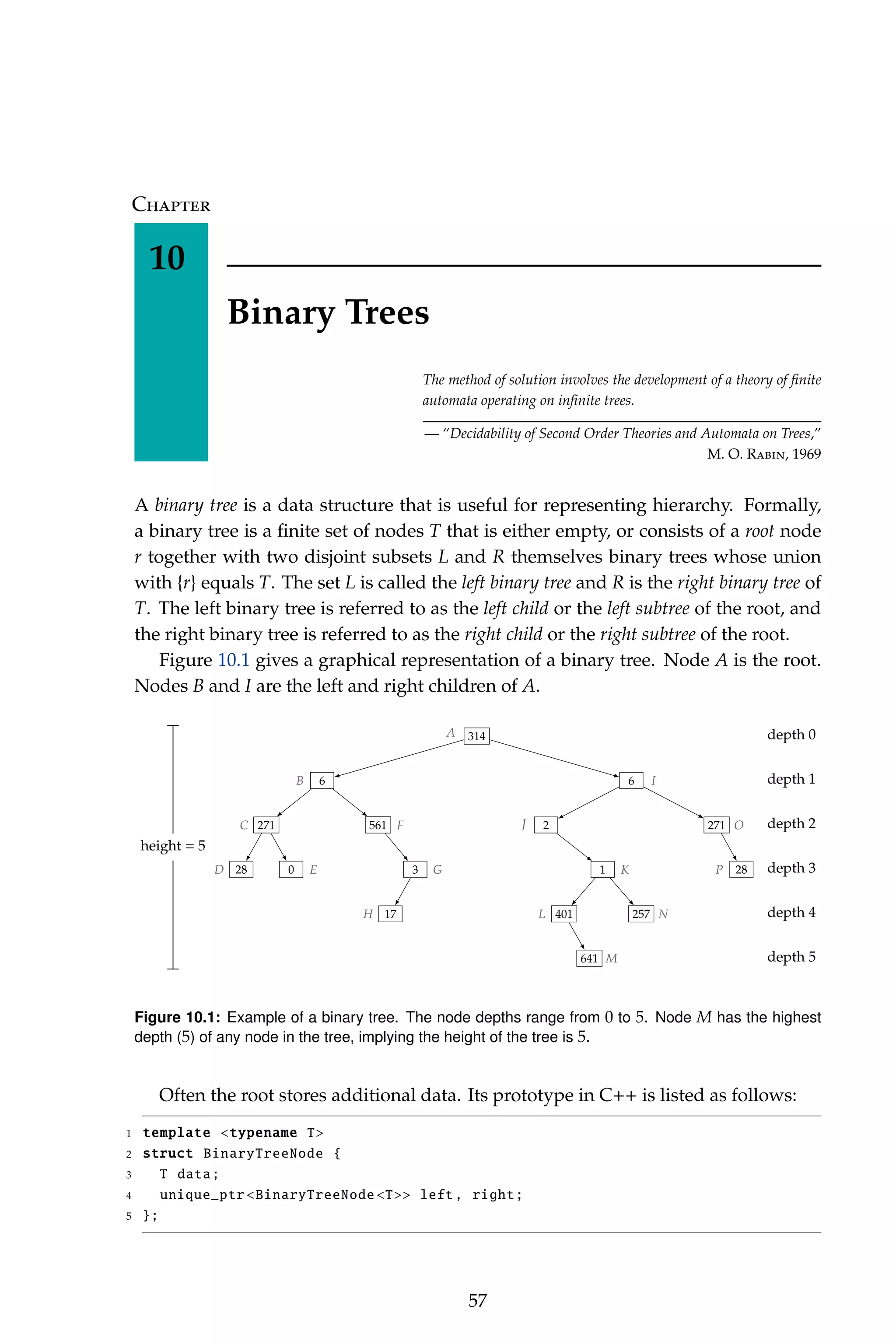
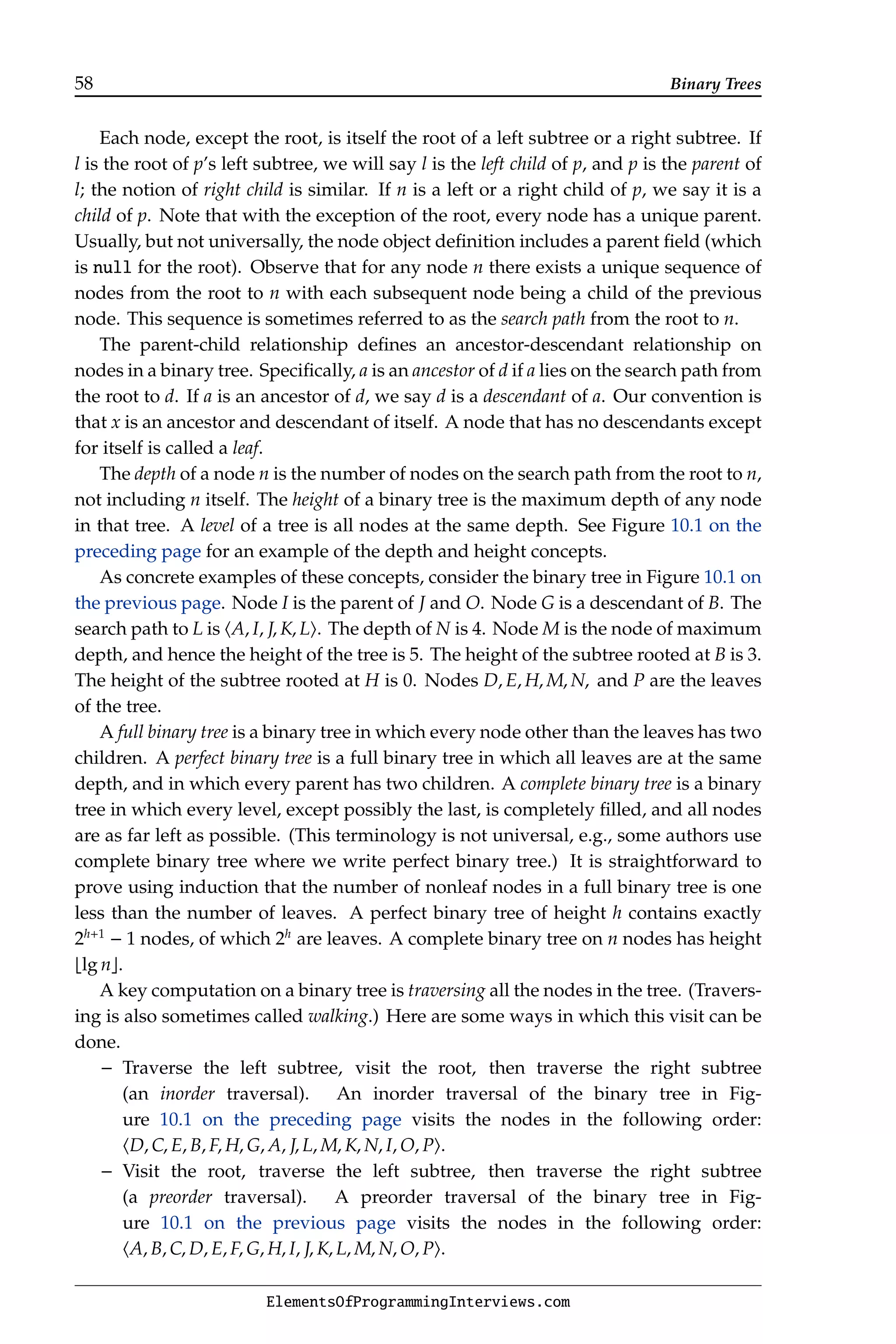
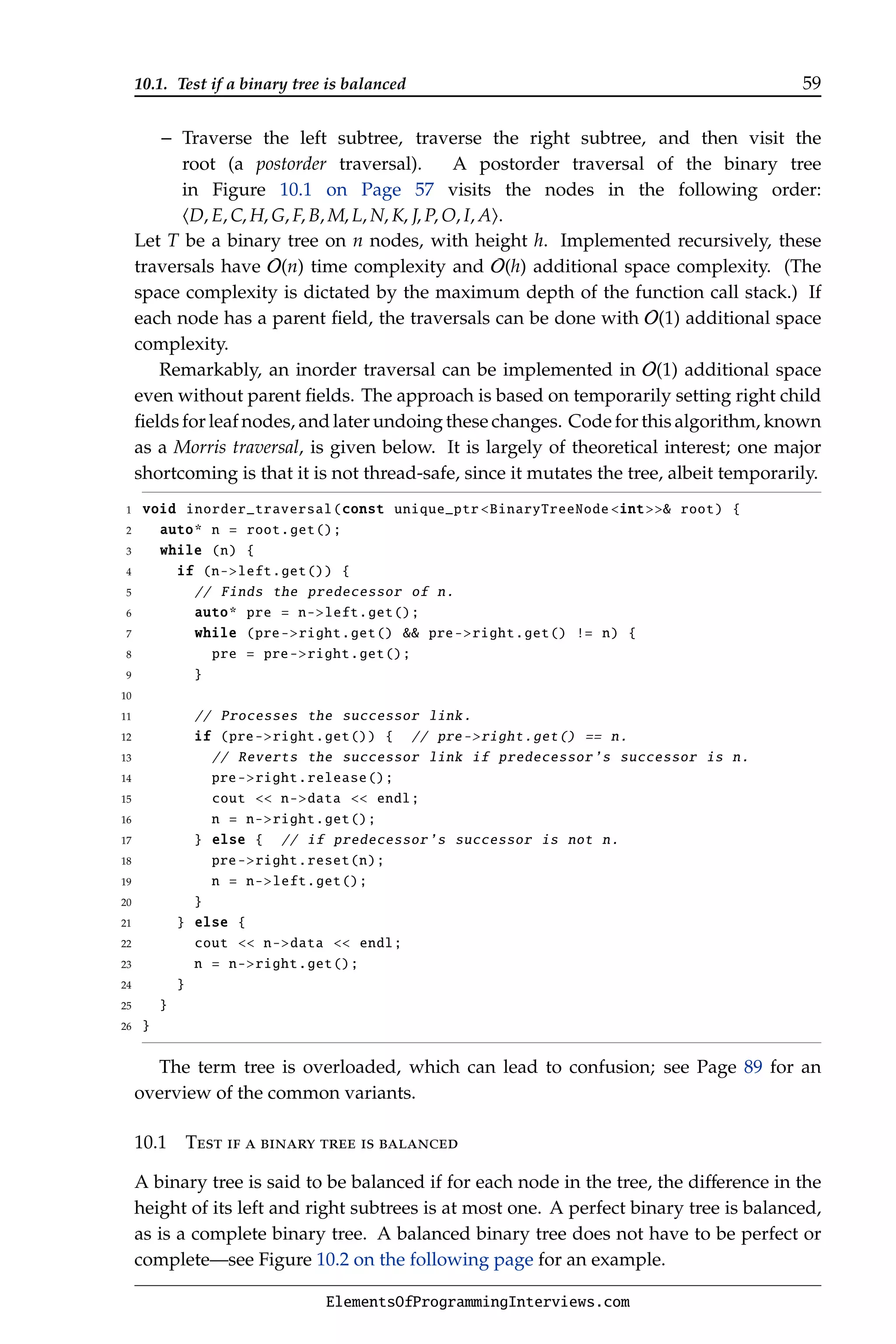
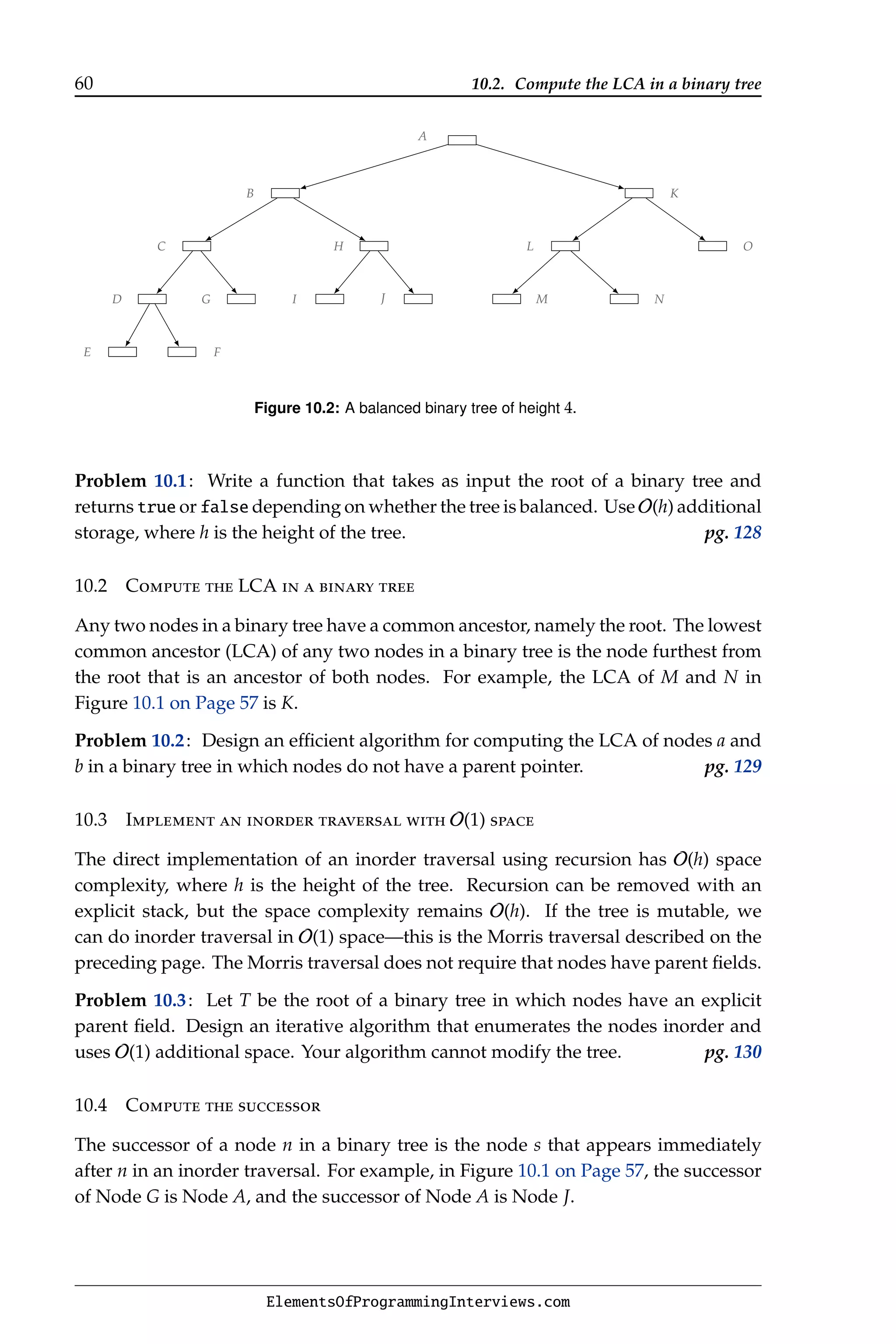

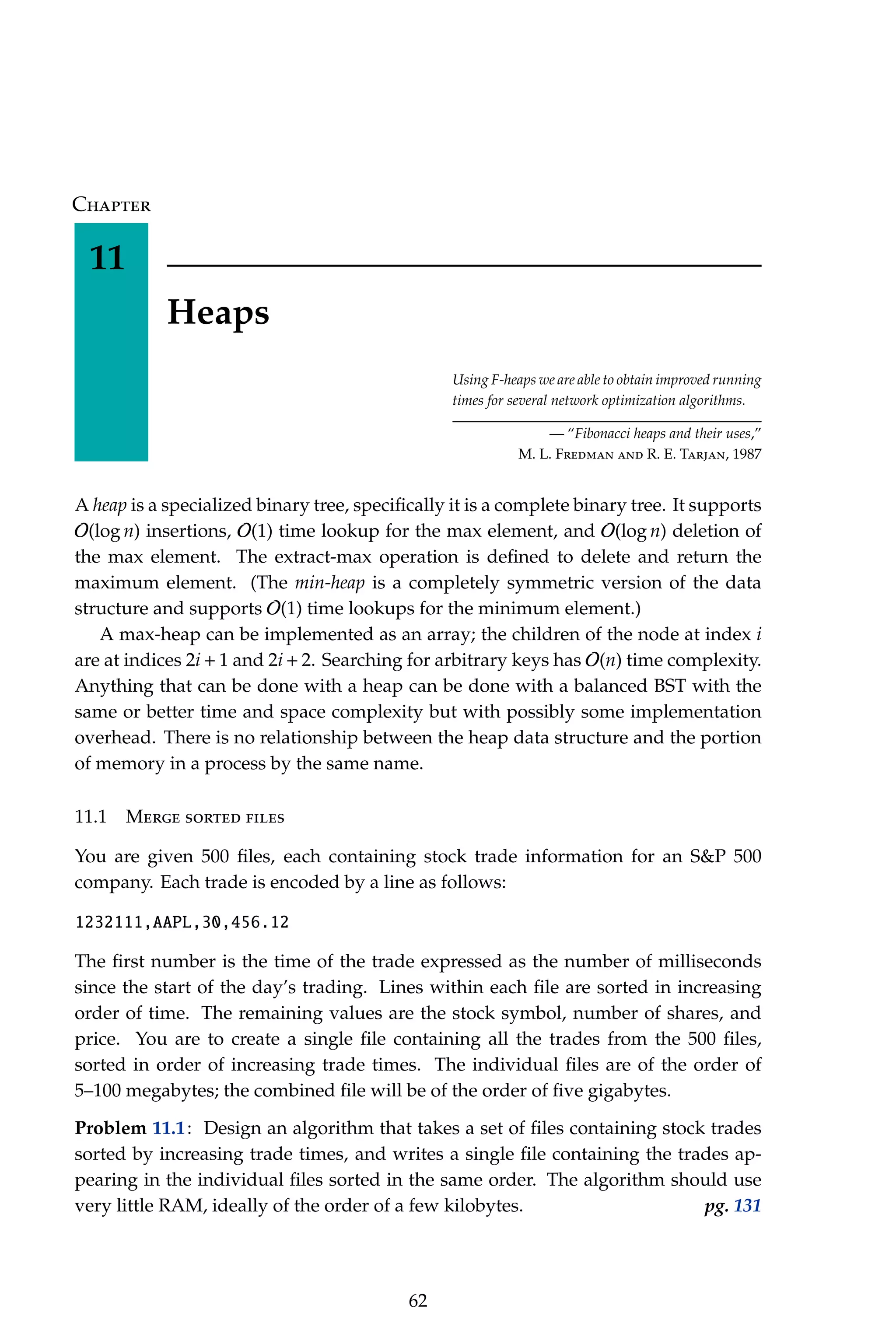

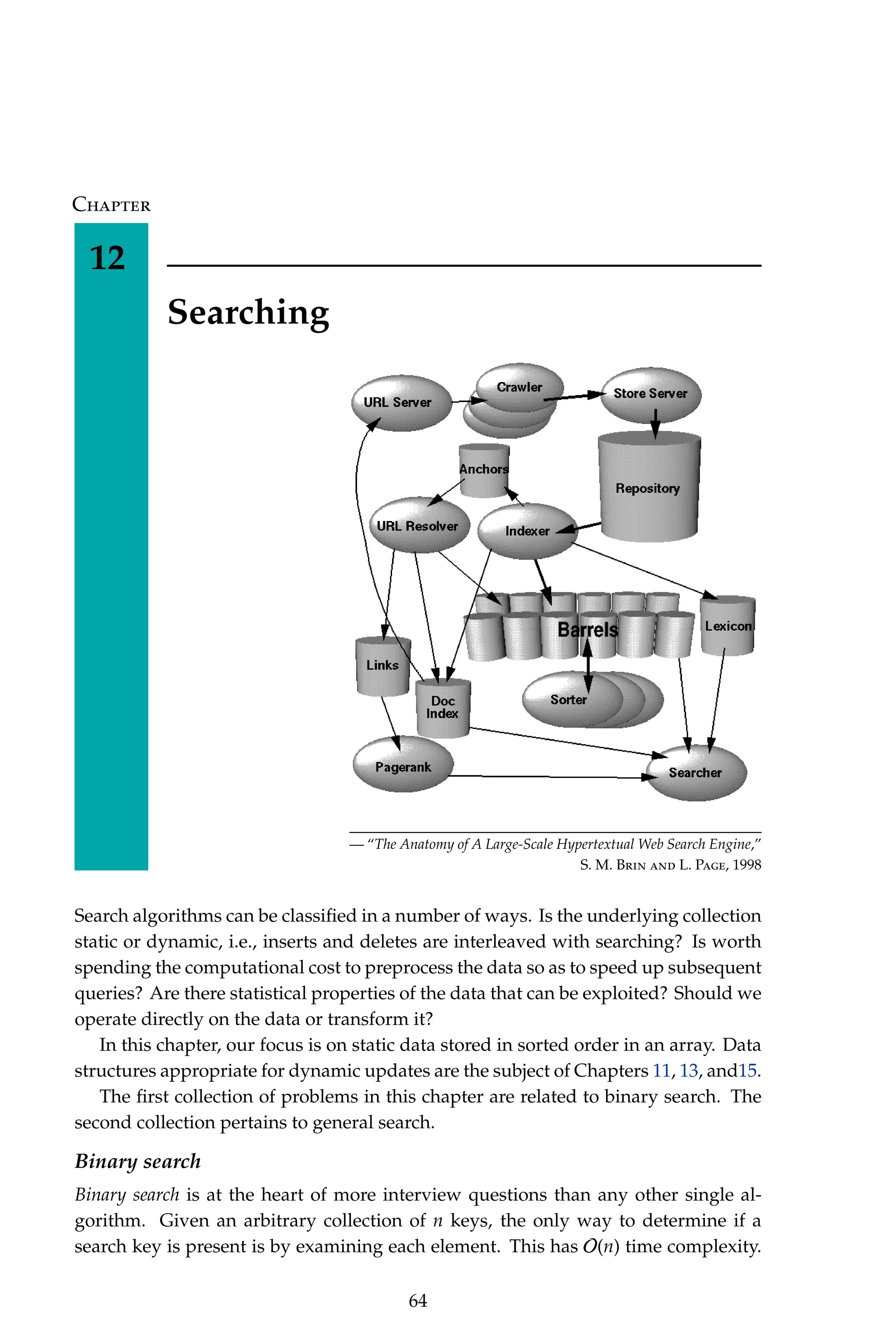
![Searching 65
Fundamentally, binary search is a natural elimination-based strategy for searching a
sorted array. The idea is to eliminate half the keys from consideration by keeping the
keys in sorted order. If the search key is not equal to the middle element of the array,
one of the two sets of keys to the left and to the right of the middle element can be
eliminated from further consideration.
Questions based on binary search are ideal from the interviewers perspective: it
is a basic technique that every reasonable candidate is supposed to know and it can
be implemented in a few lines of code. On the other hand, binary search is much
trickier to implement correctly than it appears—you should implement it as well as
write corner case tests to ensure you understand it properly.
Many published implementations are incorrect in subtle and not-so-subtle ways—
a study reported that it is correctly implemented in only five out of twenty textbooks.
Jon Bentley, in his book “Programming Pearls” reported that he assigned binary search
in a course for professional programmers and found that 90% failed to code it cor-
rectly despite having ample time. (Bentley’s students would have been gratified to
know that his own published implementation of binary search, in a column titled
“Writing Correct Programs”, contained a bug that remained undetected for over
twenty years.)
Binary search can be written in many ways—recursive, iterative, different idioms
for conditionals, etc. Here is an iterative implementation adapted from Bentley’s
book, which includes his bug.
1 int bsearch(int t, const vectorint A) {
2 int L = 0, U = A.size() - 1;
3 while (L = U) {
4 int M = (L + U) / 2;
5 if (A[M] t) {
6 L = M + 1;
7 } else if (A[M] == t) {
8 return M;
9 } else {
10 U = M - 1;
11 }
12 }
13 return -1;
14 }
The error is in the assignment M = (L + U) / 2 in Line 4, which can lead to
overflow. A common solution is to use M = L + (U - L) / 2.
However, even this refinement is problematic in a C-style implementation. The C
Programming Language (2nd ed.) by Kernighan and Ritchie (Page 100) states: “If one is
sure that the elements exist, it is also possible to index backwards in an array; p[-1],
p[-2], etc. are syntactically legal, and refer to the elements that immediately precede
p[0].” In the expression L + (U - L) / 2, if U is a sufficiently large positive integer
and L is a sufficiently large negative integer, (U - L) can overflow, leading to out of
bounds array access. The problem is illustrated below:
1 #define N 3000000000
2 char A[N];
ElementsOfProgrammingInterviews.com](https://image.slidesharecdn.com/elementsofprogramminginterviews-220623105328-e235fecd/75/Elements-of-Programming-Interviews-pdf-71-2048.jpg)
![66 12.1. Search a sorted array for first occurrence of k
3 char* B = (A + 1500000000);
4 int L = -1499000000;
5 int U = 1499000000;
6 // On a 32-bit machine (U - L) = -1296967296 because the actual value,
7 // 2998000000 is larger than 2^31 - 1. Consequently , the bsearch function
8 // called below sets m to -2147483648 instead of 0, which leads to an
9 // out-of-bounds access, since the most negative index that can be applied
10 // to B is -1500000000.
11 int result = binary_search(key, B, L, U);
The solution is to check the signs of L and U. If U is positive and L is negative, M =
(L + U) / 2 is appropriate, otherwise set M = L + (U - L) / 2.
In our solutions that make use of binary search, L and U are nonnegative and so
we use M = L + (U - L) / 2 in the associated programs.
The time complexity of binary search is given by T(n) = T(n/2) + c, where c is a
constant. This solves to T(n) = O(log n), which is far superior to the O(n) approach
needed when the keys are unsorted. A disadvantage of binary search is that it
requires a sorted array and sorting an array takes O(n log n) time. However, if there
are many searches to perform, the time taken to sort is not an issue.
Many variants of searching a sorted array require a little more thinking and create
opportunities for missing corner cases.
12.1 Search a sorted array for first occurrence of k
Binary search commonly asks for the index of any element of a sorted array A that is
equal to a given element. The following problem has a slight twist on this.
A[0] A[1] A[2] A[3] A[4] A[5] A[6] A[7] A[8] A[9]
-14 -10 2 108 108 243 285 285 285 401
Figure 12.1: A sorted array with repeated elements.
Problem 12.1: Write a method that takes a sorted array A and a key k and returns
the index of the first occurrence of k in A. Return −1 if k does not appear in A. For
example, when applied to the array in Figure 12.1 your algorithm should return 3 if
k = 108; if k = 285, your algorithm should return 6. pg. 135
12.2 Search a cyclically sorted array
An array A of length n is said to be cyclically sorted if the smallest element in the
array is at index i, and the sequence hA[i], A[i+1], . . . , A[n−1], A[0], A[1], . . . , A[i−1]i
is sorted in increasing order, as illustrated in Figure 12.2 on the next page.
Problem 12.2: Design an O(log n) algorithm for finding the position of the smallest
element in a cyclically sorted array. Assume all elements are distinct. For example,
for the array in Figure 12.2 on the facing page, your algorithm should return 4. pg. 135
ElementsOfProgrammingInterviews.com](https://image.slidesharecdn.com/elementsofprogramminginterviews-220623105328-e235fecd/75/Elements-of-Programming-Interviews-pdf-72-2048.jpg)
![12.3. Search in two sorted arrays 67
A[0] A[1] A[2] A[3] A[4] A[5] A[6] A[7] A[8] A[9]
378 478 550 631 103 203 220 234 279 368
Figure 12.2: A cyclically sorted array.
12.3 Search in two sorted arrays
The k-th smallest element in a sorted array A is simply A[k −1] which takes O(1) time
to compute. Suppose you are given two sorted arrays A and B, of length n and m
respectively, and you need to find the k-th smallest element of the array C consisting
of the n + m elements of A and B arranged in sorted order. We’ll refer to this array
as the union of A and B, although strictly speaking union is a set-theoretic operation
that does not have a notion of order, or duplicate elements.
You could merge the two arrays into a third sorted array and then look for the
answer, but the merge would take O(n + m) time. You can build the merged array on
the first k elements, which would be an O(k) operation.
Problem 12.3: You are given two sorted arrays A and B of lengths m and n, respec-
tively, and a positive integer k ∈ [1, m + n]. Design an algorithm that runs in O(log k)
time for computing the k-th smallest element in array formed by merging A and B.
Array elements may be duplicated within and between A and B. pg. 136
Generalized search
Now we consider a number of search problems that do not use the binary search
principle. For example, they focus on tradeoffs between RAM and computation
time, avoid wasted comparisons when searching for the minimum and maximum
simultaneously, use randomization to perform elimination efficiently, use bit-level
manipulations to identify missing elements, etc.
12.4 Find the missing IP address
The storage capacity of hard drives dwarfs that of RAM. This can lead to interesting
space-time trade-offs.
Problem 12.4: Suppose you were given a file containing roughly one billion Internet
Protocol (IP) addresses, each of which is a 32-bit unsigned integer. How would
you programmatically find an IP address that is not in the file? Assume you have
unlimited drive space but only two megabytes of RAM at your disposal. pg. 138
ElementsOfProgrammingInterviews.com](https://image.slidesharecdn.com/elementsofprogramminginterviews-220623105328-e235fecd/75/Elements-of-Programming-Interviews-pdf-73-2048.jpg)
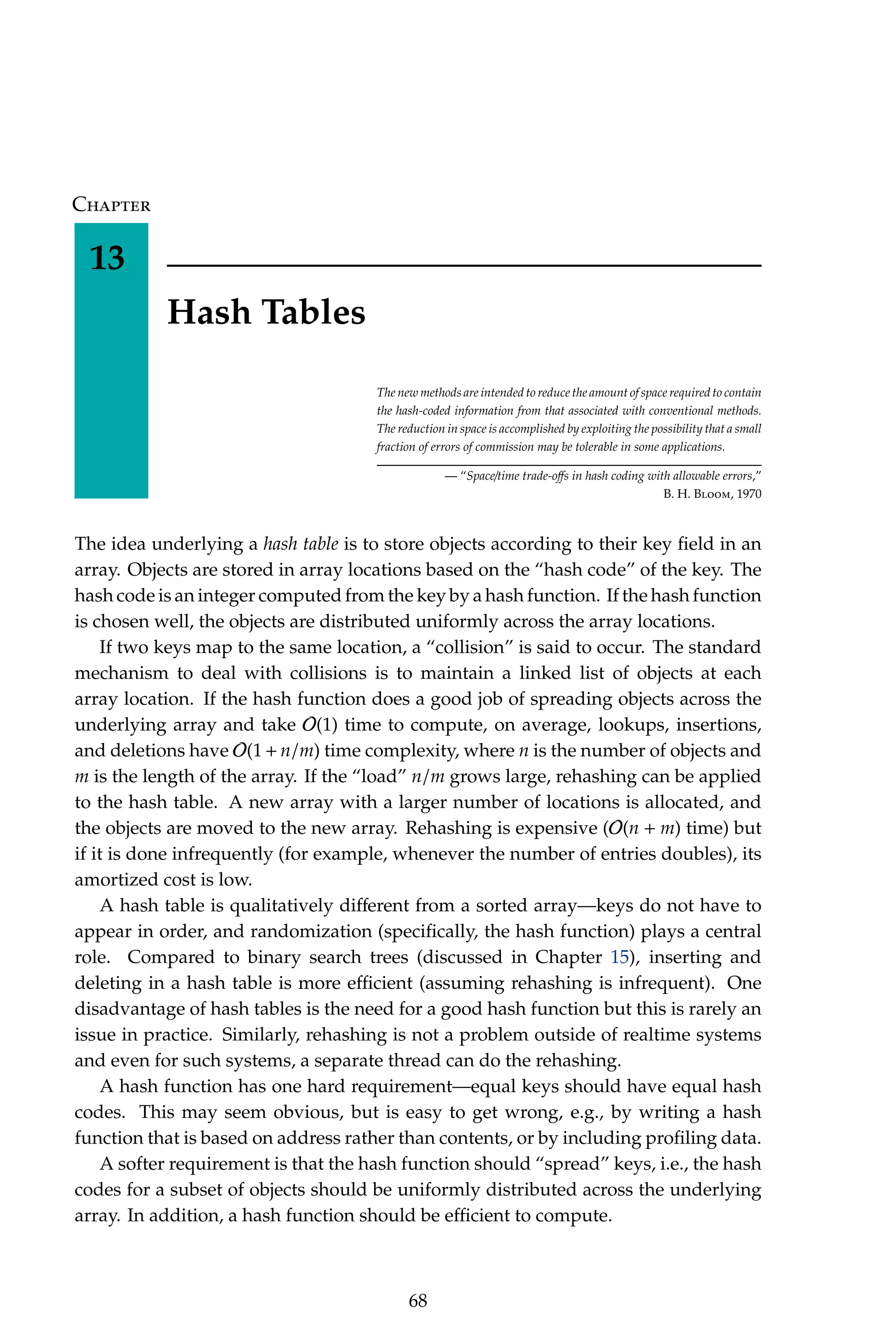
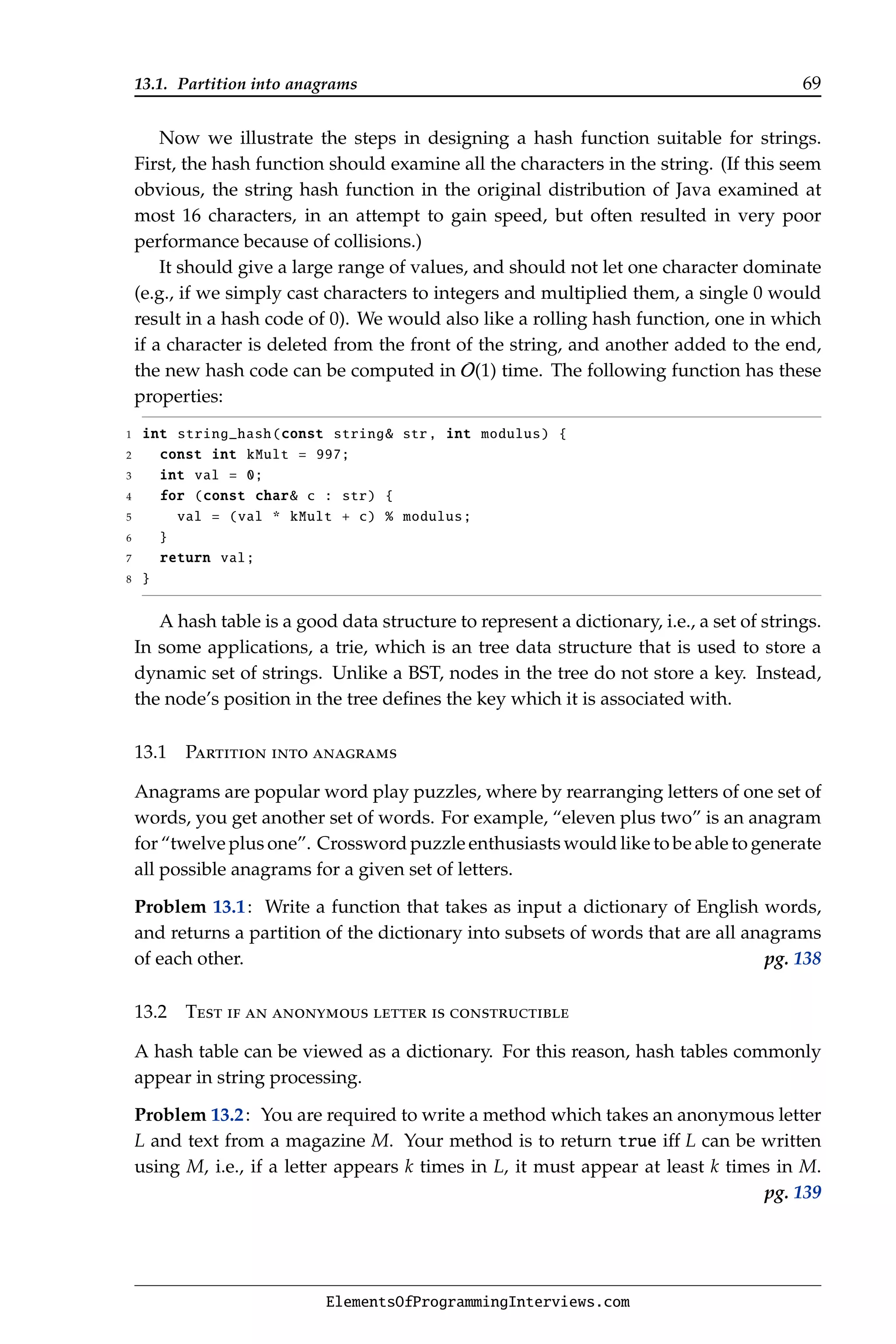

![Chapter
14
Sorting
PROBLEM 14 (Meshing). Two monotone sequences S, T, of lengths n, m, respec-
tively, are stored in two systems of n(p + 1), m(p + 1) consecutive memory locations,
respectively: s, s + 1, . . . , s + n(p + 1) − 1 and t, t + 1, . . . , t + m(p + 1) − 1. . . . It is
desired to find a monotone permutation R of the sum [S, T], and place it at the locations
r, r + 1, . . . , r + (n + m)(p + 1) − 1.
— “Planning And Coding Of Problems For An Electronic Computing Instrument,”
H. H. Goldstine and J. von Neumann, 1948
Sorting—rearranging a collection of items into increasing or decreasing order—is a
common problem in computing. Sorting is used to preprocess the collection to make
searching faster (as we saw with binary search through an array), as well as identify
items that are similar (e.g., students are sorted on test scores).
Naïve sorting algorithms run in O(n2
) time. A number of sorting algorithms
run in O(n log n) time—heapsort, merge sort, and quicksort are examples. Each has
its advantages and disadvantages: for example, heapsort is in-place but not stable;
merge sort is stable but not in-place; quicksort runs O(n2
) time in worst case. (An
in-place sort is one which uses O(1) space; a stable sort is one where entries which
are equal appear in their original order.)
A well-implemented quicksort is usually the best choice for sorting. We briefly
outline alternatives that are better in specific circumstances.
For short arrays, e.g., 10 or fewer elements, insertion sort is easier to code and
faster than asymptotically superior sorting algorithms. If every element is known to
be at most k places from its final location, a min-heap can be used to get an O(n log k)
algorithm. If there are a small number of distinct keys, e.g., integers in the range
[0..255], counting sort, which records for each element, the number of elements less
than it, works well. This count can be kept in an array (if the largest number is
comparable in value to the size of the set being sorted) or a BST, where the keys are
the numbers and the values are their frequencies. If there are many duplicate keys
we can add the keys to a BST, with linked lists for elements which have the same
key; the sorted result can be derived from an in-order traversal of the BST.
Most sorting algorithms are not stable. Merge sort, carefully implemented, can
be made stable. Another solution is to add the index as an integer rank to the keys
to break ties.
71](https://image.slidesharecdn.com/elementsofprogramminginterviews-220623105328-e235fecd/75/Elements-of-Programming-Interviews-pdf-77-2048.jpg)

![14.3. Add a closed interval 73
E1 E2 E3 E4
E5 E6 E7
E8 E9
0 1 2 3 4 5 6 7 8 9 10 11 12 13 14 15 16 17
Figure 14.1: A set of nine events. The earliest starting event begins at time 1; the latest ending event
ends at time 17. The maximum number of concurrent events is 3, e.g., {E1, E5, E8} as well as others.
14.3 Add a closed interval
Consider a set U consisting of disjoint closed intervals. This problem is con-
cerned with adding an interval I to U and computing a new set of disjoint and
sorted intervals containing exactly the numbers in U ∪ {I}. For example, if U =
h[0, 2], [3, 6], [7, 7], [9, 12]i, and I = [1, 8] is added, the result should be h[0, 8], [9, 12]i.
Problem 14.3: Write a function which takes as input an array A of disjoint closed
intervals with integer endpoints, sorted by increasing order of left endpoint, and an
interval I, and returns the union of I with the intervals in A, expressed as a union of
disjoint intervals. pg. 144
ElementsOfProgrammingInterviews.com](https://image.slidesharecdn.com/elementsofprogramminginterviews-220623105328-e235fecd/75/Elements-of-Programming-Interviews-pdf-79-2048.jpg)

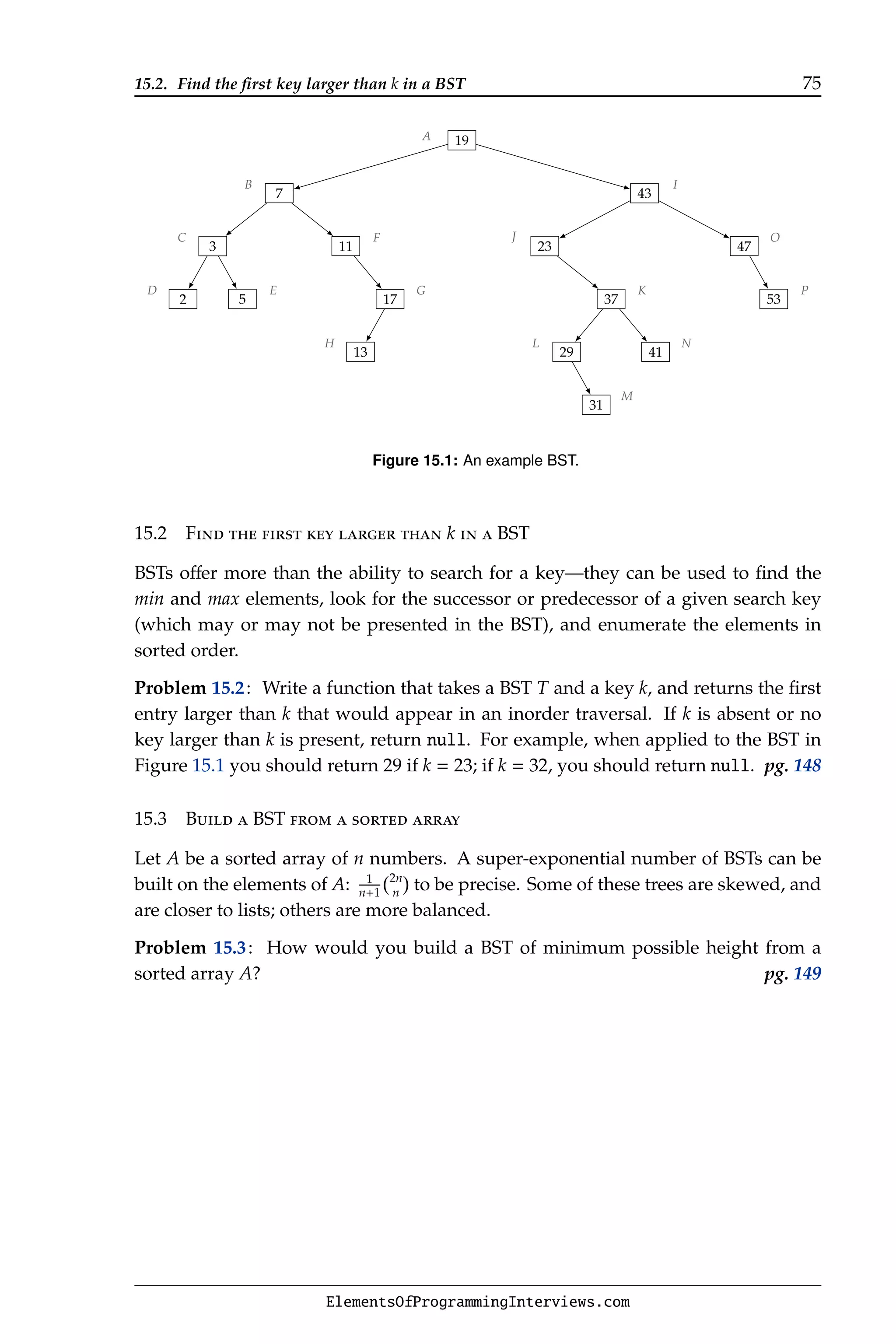
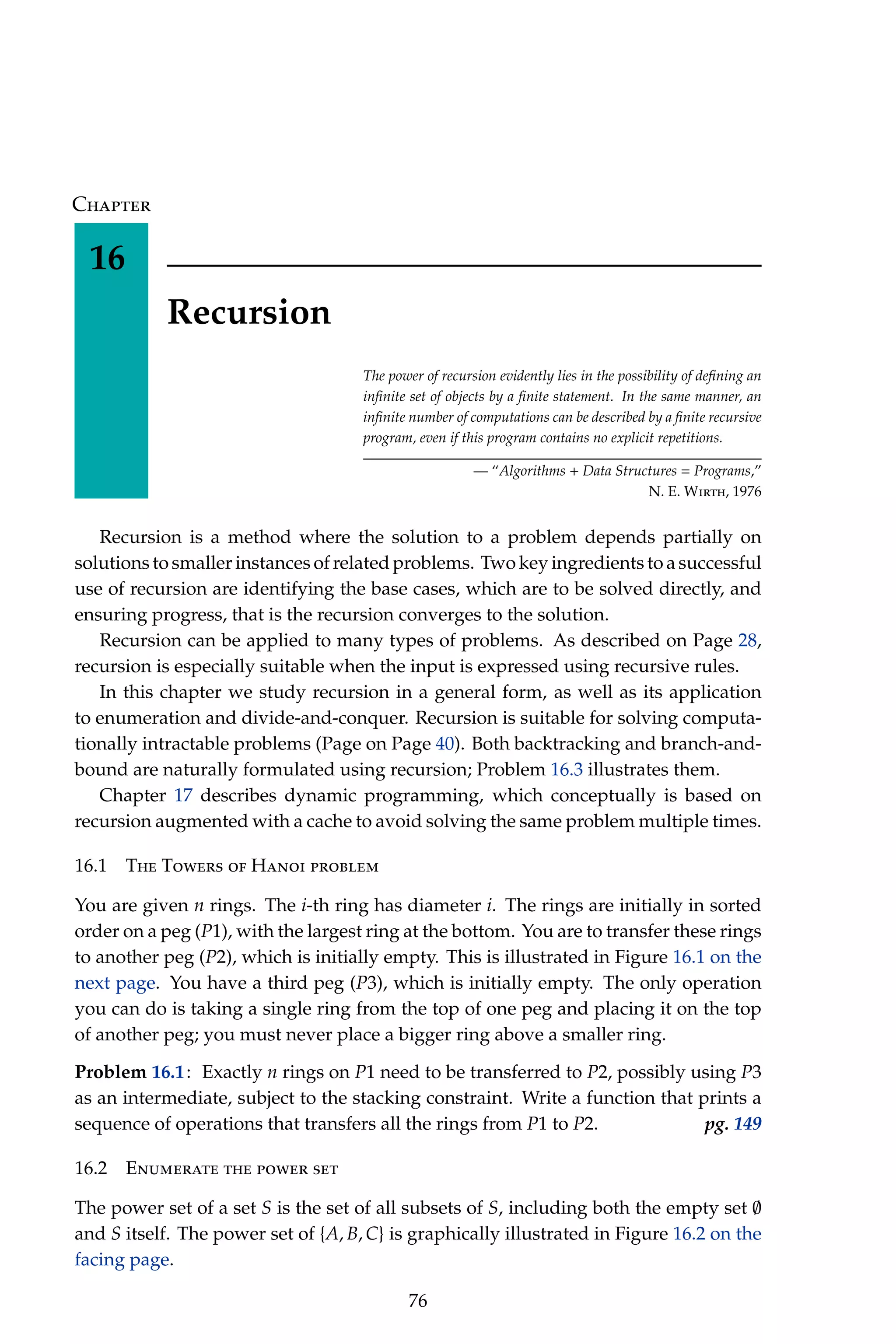
![16.3. Implement a Sudoku solver 77
P1 P2 P3
(a) Initial configuration.
P1 P2 P3
(b) Desired configuration.
Figure 16.1: Towers of Hanoi for n = 6.
∅
{A}
{B}
{C}
{A, B}
{A, C}
{B, C}
{A, B, C}
Figure 16.2: The power set of {A, B, C} is {∅, {A}, {B}, {C}, {A, B}, {B, C}, {A, C}, {A, B, C}}.
Problem 16.2: Implement a method that takes as input a set S of n distinct elements,
and prints the power set of S. Print the subsets one per line, with elements separated
by commas. pg. 151
16.3 Implement a Sudoku solver
In this problem you are to write a Sudoku solver. The decision version of the gener-
alized Sudoku problem is NP-complete; however this is restricted to the traditional
9 × 9 grid.
Problem 16.3: Implement a Sudoku solver. Your program should read an instance
of Sudoku from the command line. The command line argument is a sequence of
3-digit strings, each encoding a row, a column, and a digit at that location. pg. 153
Divide-and-conquer
A divide-and-conquer algorithm works by repeatedly decomposing a problem into
two or more smaller independent subproblems of the same kind, until it gets to in-
stances that are simple enough to be solved directly. The solutions to the subproblems
are then combined to give a solution to the original problem.
Merge sort and quicksort are classical examples of divide-and-conquer. In merge
sort, the array A[0 : n − 1] is sorted by sorting A[0 : bn/2c] and A[bn/2c + 1 : n − 1],
ElementsOfProgrammingInterviews.com](https://image.slidesharecdn.com/elementsofprogramminginterviews-220623105328-e235fecd/75/Elements-of-Programming-Interviews-pdf-83-2048.jpg)
![78 16.3. Implement a Sudoku solver
and merging them. In quicksort, A[0 : n − 1] is sorted by selecting a pivot element
A[r] and reordering the elements of A to make all elements appearing before A[r]
less than or equal to A[r] and all elements appearing after A[r] greater than or equal
to A[r]. The subarray consisting of elements before A[r] and the subarray consisting
of elements after A[r] are sorted, and the resulting array is completely sorted.
Interestingly, the divide step in merge sort is trivial; the challenge is in combining
the results. With quicksort, the opposite is true. Problems 11.1 on Page 62 and 6.1 on
Page 46 illustrate the key computations in merge sort and quicksort.
A divide-and-conquer algorithm is not always optimum. A minimum spanning
tree (MST) is a minimum weight set of edges in a weighted undirected graph which
connect all vertices in the graph. A natural divide-and-conquer algorithm for com-
puting the MST is to partition the vertex set V into two subsets V1 and V2, compute
MSTs for V1 and V2, and then join these two MSTs with an edge of minimum weight
between V1 and V2. Figure 16.3 shows how this algorithm can lead to suboptimal
results.
a
b
c d
e
f
6
8
5
7
3
4 1
1
1
(a) A weighted undirected graph.
a
b
c d
e
f
6
7
3
1
1
(b) An MST built from the MSTs on
{a, b, c} and {d, e. f}.
a
b
c d
e
f
5
3
4 1
1
(c) An optimum MST.
Figure 16.3: Divide-and-conquer applied to the MST problem is suboptimum.
The term divide-and-conquer is also sometimes applied to algorithms that reduce
a problem to only one subproblem, e.g., binary search. Such algorithms can be imple-
mented more efficiently than general divide-and-conquer algorithms. In particular,
these algorithms use tail recursion, which can be replaced by a loop. Decrease and
conquer is a more appropriate term for such algorithms.
Divide-and-conquer is not synonymous with recursion. First of all, in divide-and-
conquer, the problem is divided into two or more independent smaller problems
that are of the same type as the original problem. Recursion is more general—
there may be a single subproblem, e.g., binary search, the subproblems may not be
independent, e.g., dynamic programming, and they may not be of the same type
as the original, e.g., regular expression matching. In addition, sometimes in order
to improve runtime, and occasionally to reduce space complexity, a divide-and-
conquer algorithm is implemented using iteration instead of recursion. The iterative
implementation mimics the recursion, perhaps using a stack. Invariably, the iterative
version is more challenging to implement correctly.
ElementsOfProgrammingInterviews.com](https://image.slidesharecdn.com/elementsofprogramminginterviews-220623105328-e235fecd/75/Elements-of-Programming-Interviews-pdf-84-2048.jpg)
![Chapter
17
Dynamic Programming
The important fact to observe is that we have attempted to solve
a maximization problem involving a particular value of x and
a particular value of N by first solving the general problem
involving an arbitrary value of x and an arbitrary value of N.
— “Dynamic Programming,”
R. E. Bellman, 1957
DP is a general technique for solving complex optimization problems that can be
decomposed into overlapping subproblems. Like divide-and-conquer, we solve the
problem by combining the solutions of multiple smaller problems but what makes
DP different is that the subproblems may not be independent. A key to making
DP efficient is reusing the results of intermediate computations. (The word “pro-
gramming” in dynamic programming does not refer to computer programming—the
word was chosen by Richard Bellman to describe a program in the sense of a sched-
ule.) Problems which are naturally solved using DP are a popular choice for hard
interview questions.
To illustrate the idea underlying DP, consider the problem of computing Fibonacci
numbers defined by Fn = Fn−1 +Fn−2, F0 = 0 and F1 = 1. A function to compute Fn that
recursively invokes itself to compute Fn−1 and Fn−2 would have a time complexity
that is exponential in n. However, if we make the observation that recursion leads to
computing Fi for i ∈ [0, n−1] repeatedly, we can save the computation time by storing
these results and reusing them. This makes the time complexity linear in n, albeit at
the expense of O(n) storage. Note that the recursive implementation requires O(n)
storage too, though on the stack rather than the heap and that the function is not tail
recursive since the last operation performed is + and not a recursive call.
The key to solving any DP problem efficiently is finding the right way to break
the problem into subproblems such that
− the bigger problem can be solved relatively easily once solutions to all the
subproblems are available, and
− you need to solve as few subproblems as possible.
In some cases, this may require solving a slightly different optimization problem
than the original problem. For example, consider the following problem: given an
array of integers A of length n, find the interval indices a and b such that
Pb
i=a A[i]
is maximized. As a concrete example, the interval corresponding to the maximum
subarray sum for the array in Figure 17.1 on the following page is [0, 3].
79](https://image.slidesharecdn.com/elementsofprogramminginterviews-220623105328-e235fecd/75/Elements-of-Programming-Interviews-pdf-85-2048.jpg)
![80 Dynamic Programming
A[0] A[1] A[2] A[3] A[4] A[5] A[6] A[7] A[8]
904 40 523 12 -335 -385 -124 481 -31
Figure 17.1: An array with a maximum subarray sum of 1479.
The brute-force algorithm, which computes each subarray sum, has O(n3
) time
complexity—there are
n(n−1)
2
subarrays, and each subarray sum can be computed in
O(n) time. The brute-force algorithm can be improved to O(n2
) by first computing
sums S[i] for subarrays A[0 : i] for each i n; the sum of subarray A[i : j] is
S[j] − S[i − 1], where S[−1] is taken to be 0.
Here is a natural divide-and-conquer algorithm. We solve the problem for the
subarrays L = A[0 : bn
2
c] and R = A[bn
2
c + 1 : n − 1]. In addition to the answers for
each, we also return the maximum subarray sum l for any subarray ending at the
last entry in L, and the maximum subarray sum r for any subarray starting at 0 for
R. The maximum subarray sum for A is the maximum of l + r, the answer for L, and
the answer for R. The time complexity analysis is similar to that for quicksort, which
leads to an O(n log n).
Now we will solve this problem by using DP. A natural thought is to assume we
have the solution for the subarray A[0 : n − 2]. However, even if we knew the largest
sum subarray for subarray A[0 : n − 2], it does not help us solve the problem for
A[0 : n − 1]. A better approach is to iterate through the array. For each index j, the
maximum subarray ending at j is equal to S[j] − mini≤j S[i]. During the iteration,
we cache the minimum subarray sum we have visited and compute the maximum
subarray for each index. The time spent per index is constant, leading to an O(n)
time and O(1) space solution. The code below returns a pair of indices (i, j) such that
A[i : j−1] is a maximum subarray. It is legal for all array entries to be negative, or the
array to be empty. The algorithm handles these input cases correctly. Specifically, it
returns equal indices, which denote an empty subarray.
1 pairint, int find_maximum_subarray(const vectorint A) {
2 // A[range.first : range.second - 1] will be the maximum subarray.
3 pairint, int range(0, 0);
4 int min_idx = -1, min_sum = 0, sum = 0, max_sum = 0;
5 for (int i = 0; i A.size(); ++i) {
6 sum += A[i];
7 if (sum min_sum) {
8 min_sum = sum, min_idx = i;
9 }
10 if (sum - min_sum max_sum) {
11 max_sum = sum - min_sum , range = {min_idx + 1, i + 1};
12 }
13 }
14 return range;
15 }
Here are two variants of the subarray maximization problem that can be solved
ElementsOfProgrammingInterviews.com](https://image.slidesharecdn.com/elementsofprogramminginterviews-220623105328-e235fecd/75/Elements-of-Programming-Interviews-pdf-86-2048.jpg)
![17.1. Count the number of score combinations 81
with ideas that are similar to the above approach: find indices a and b such that
Pb
i=a A[i] is—(1.) closest to 0 and (2.) closest to t. (Both entail some sorting, which
increases the time complexity to O(n log n).) Another good variant is finding indices
a and b such that
Qb
i=a A[i] is maximum when the array contains both positive and
negative integers.
A common mistake in solving DP problems is trying to think of the recursive case
by splitting the problem into two equal halves, a la quicksort, i.e., somehow solve
the subproblems for subarrays A[0 : bn
2
c] and A[bn
2
c + 1 : n] and combine the results.
However, in most cases, these two subproblems are not sufficient to solve the original
problem.
17.1 Count the number of score combinations
In an American football game, a play can lead to 2 points (safety), 3 points (field
goal), or 7 points (touchdown). Given the final score of a game, we want to compute
how many different combinations of 2, 3, and 7 point plays could make up this score.
For example, if W = {2, 3, 7}, four combinations of plays yield a score of 12:
− 6 safeties (2 × 6 = 12),
− 3 safeties and 2 field goals (2 × 3 + 3 × 2 = 12),
− 1 safety, 1 field goal and 1 touchdown (2 × 1 + 3 × 1 + 7 × 1 = 12), and
− 4 field goals (3 × 4 = 12).
Problem 17.1: You have an aggregate score s and W which specifies the points that
can be scored in an individual play. How would you find the number of combinations
of plays that result in an aggregate score of s? How would you compute the number
of distinct sequences of individual plays that result in a score of s? pg. 155
17.2 Count the number of ways to traverse a 2D array
Suppose you start at the top-left corner of an n × m 2D array A and want to get to the
bottom-right corner. The only way you can move is by either going right or going
down. Three legal paths for a 5 × 5 2D array are given in Figure 17.2.
Figure 17.2: Paths through a 2D array.
Problem 17.2: How many ways can you go from the top-left to the bottom-right
in an n × m 2D array? How would you count the number of ways in the presence
of obstacles, specified by an n × m Boolean 2D array B, where a true represents an
obstacle. pg. 156
ElementsOfProgrammingInterviews.com](https://image.slidesharecdn.com/elementsofprogramminginterviews-220623105328-e235fecd/75/Elements-of-Programming-Interviews-pdf-87-2048.jpg)

![17.5. Find the longest nondecreasing subsequence 83
A[0] A[1] A[2] A[3] A[4] A[5] A[6] A[7] A[8] A[9]
0 8 4 12 2 10 6 14 1 9
Figure 17.4: An array whose longest nondecreasing subsequences are of length 4.
Problem 17.5: Given an array A of n numbers, find a longest subsequence hi0, . . . , ik−1i
such that ij ij+1 and A[ij] ≤ A[ij+1] for any j ∈ [0, k − 2]. pg. 159
ElementsOfProgrammingInterviews.com](https://image.slidesharecdn.com/elementsofprogramminginterviews-220623105328-e235fecd/75/Elements-of-Programming-Interviews-pdf-89-2048.jpg)
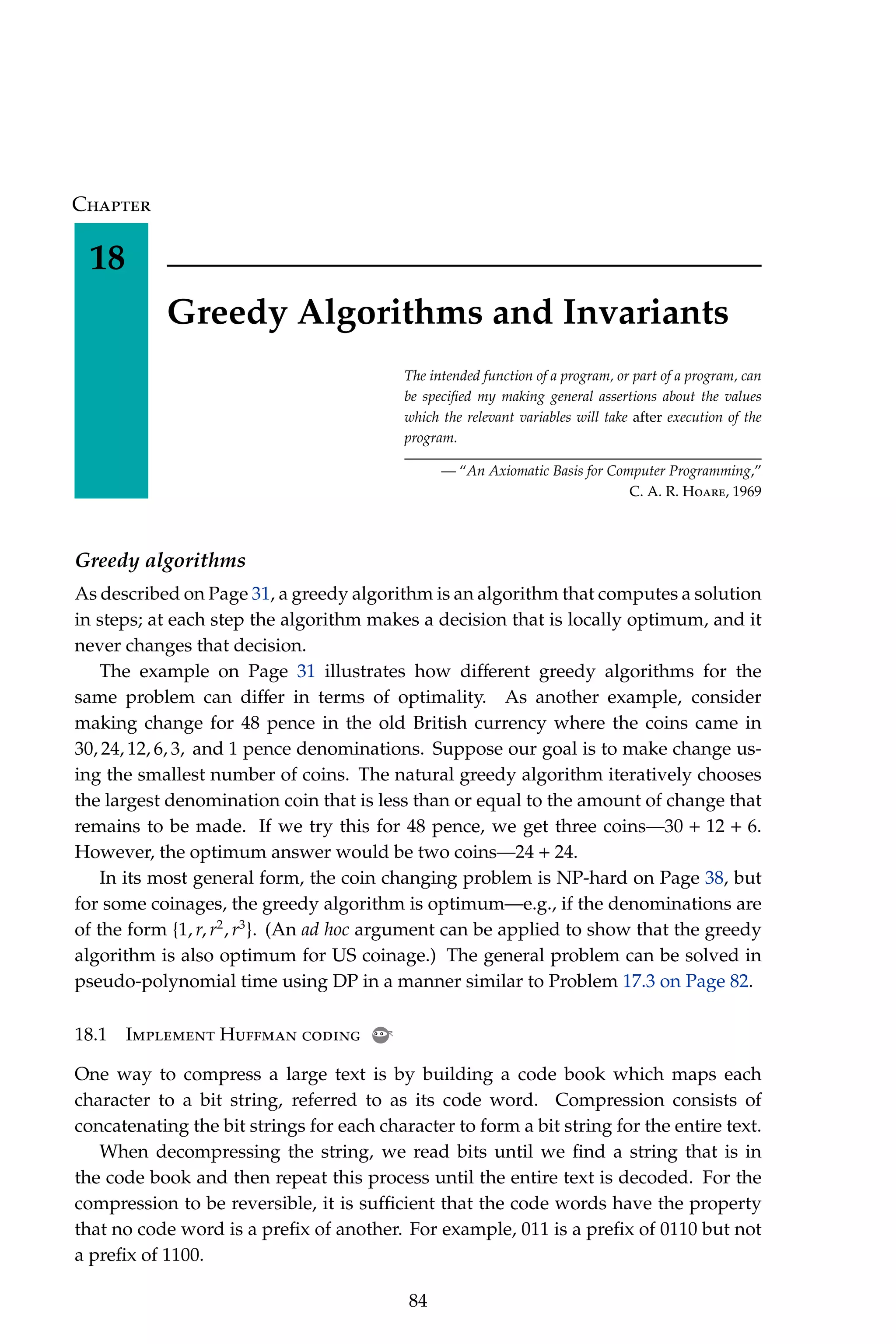
![18.1. Implement Huffman coding 85
Since our objective is to compress the text, we would like to assign the shorter
strings to more common characters and the longer strings to less common charac-
ters. We will restrict our attention to individual characters. (We may achieve better
compression if we examine common sequences of characters, but this increases the
time complexity.)
The intuitive notion of commonness is formalized by the frequency of a character
which is a number between zero and one. The sum of the frequencies of all the
characters is 1. The average code length is defined to be the sum of the product of
the length of each character’s code word with that character’s frequency. Table 18.1
shows the large variation in the frequencies of letters of the English alphabet.
Table 18.1: English characters and their frequencies, expressed as percentages, in everyday docu-
ments.
Character Frequency Character Frequency Character Frequency
a 8.17 j 0.15 s 6.33
b 1.49 k 0.77 t 9.06
c 2.78 l 4.03 u 2.76
d 4.25 m 2.41 v 0.98
e 12.70 n 6.75 w 2.36
f 2.23 o 7.51 x 0.15
g 2.02 p 1.93 y 1.97
h 6.09 q 0.10 z 0.07
i 6.97 r 5.99
Problem 18.1: Given a set of symbols with corresponding frequencies, find a code
book that has the smallest average code length. pg. 162
Invariants
An invariant is a condition that is true during execution of a program. Invariants can
be used to design algorithms as well as reason about their correctness.
The reduce and conquer algorithms seen previously, e.g., binary search, maintain
the invariant that the space of candidate solutions contains all possible solutions as
the algorithms execute.
Sorting algorithms nicely illustrates algorithm design using invariants. For ex-
ample, intuitively, selection sort is based on finding the smallest element, the next
smallest element, etc. and moving them to their right place. More precisely, we work
with successively larger subarrays beginning at index 0, and preserve the invari-
ant that these subarrays are sorted and their elements are less than or equal to the
remaining elements.
As another example, suppose we want to find two elements in a sorted array A
summing to a specified K. Let n denote the length of A. We start by considering
s0,n−1 = A[0]+A[n−1]. If s0,n−1 = K, we are done. If s0,n−1 K, then we can restrict our
attention to solving the problem on the subarray A[1 : n − 1], since A[0] can never be
one of the two elements. Similarly, if s0,n−1 K, we restrict the search to A[0 : n − 2].
The invariant is that if two elements which sum to K exist, they must lie within the
subarray currently under consideration.
ElementsOfProgrammingInterviews.com](https://image.slidesharecdn.com/elementsofprogramminginterviews-220623105328-e235fecd/75/Elements-of-Programming-Interviews-pdf-91-2048.jpg)
![86 18.2. The 3-sum problem
18.2 The 3-sum problem
Let A be an array of n numbers. Let t be a number, and k be an integer in [1, n]. Define
A to k-create t iff there exists k indices i0, i1, . . . , ik−1 (not necessarily distinct) such that
Pk−1
j=0 A[ij] = t.
Problem 18.2: Design an algorithm that takes as input an array A and a number t,
and determines if A 3-creates t. pg. 164
18.3 Compute the largest rectangle under the skyline
You are given a sequence of adjacent buildings. Each has unit width and an integer
height. These buildings form the skyline of a city. An architect wants to know the
area of a largest rectangle contained in this skyline. For example, for the skyline
in Figure 18.1, the largest rectangle is the brick-patterned one. Note that it is not
the contained rectangle with maximum height (which is denoted by the vertical-
patterning), or the maximum width (which is denoted by the slant-patterning).
Figure 18.1: Buildings, their skyline, and the largest contained rectangle.
Problem 18.3: Let A be an array of n numbers encoding the heights of adjacent
buildings of unit width. Design an algorithm to compute the area of the largest
rectangle contained in this skyline, i.e., compute maxij((j − i + 1) × min
j
k=i
A[k]).
pg. 165
ElementsOfProgrammingInterviews.com](https://image.slidesharecdn.com/elementsofprogramminginterviews-220623105328-e235fecd/75/Elements-of-Programming-Interviews-pdf-92-2048.jpg)
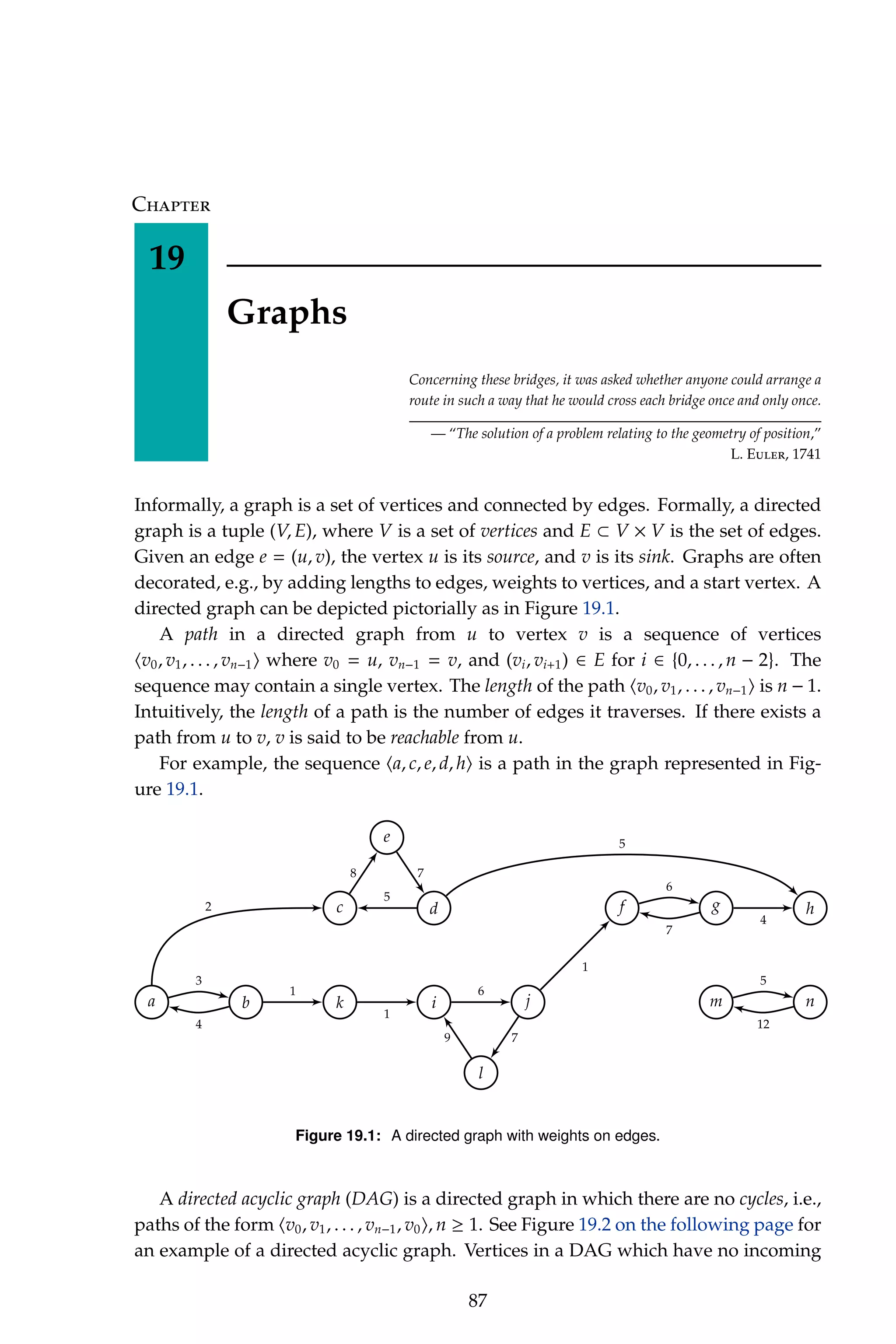
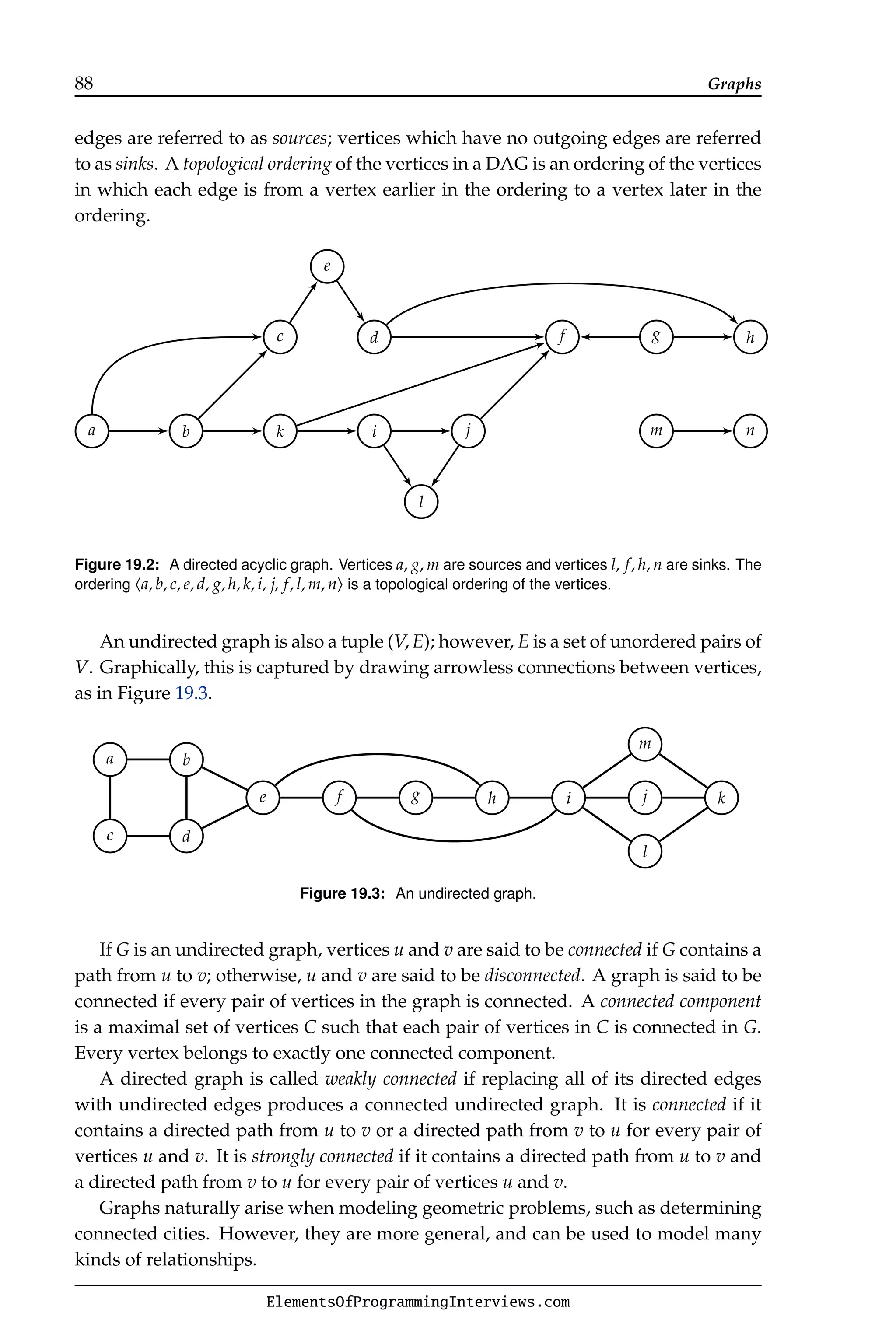

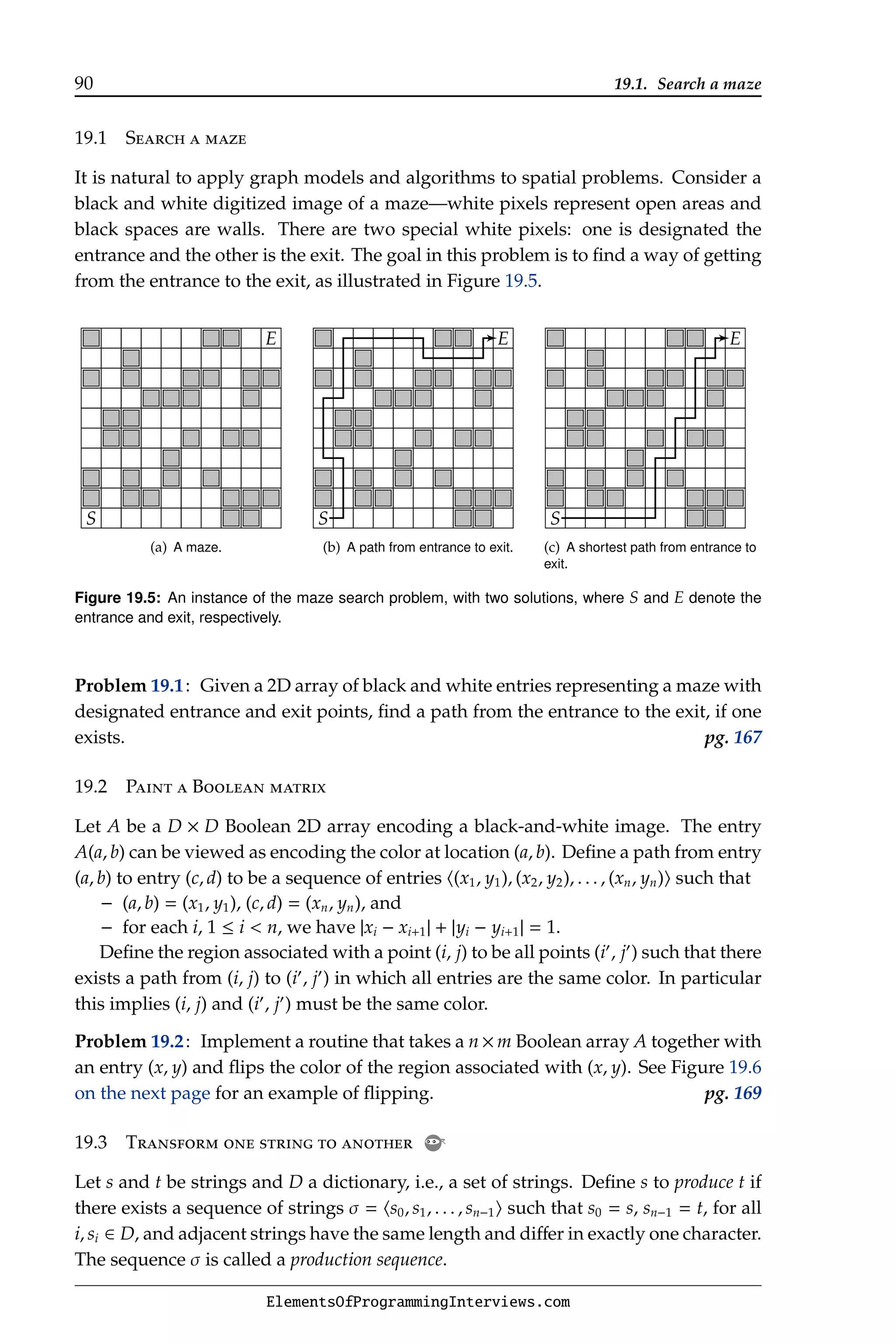
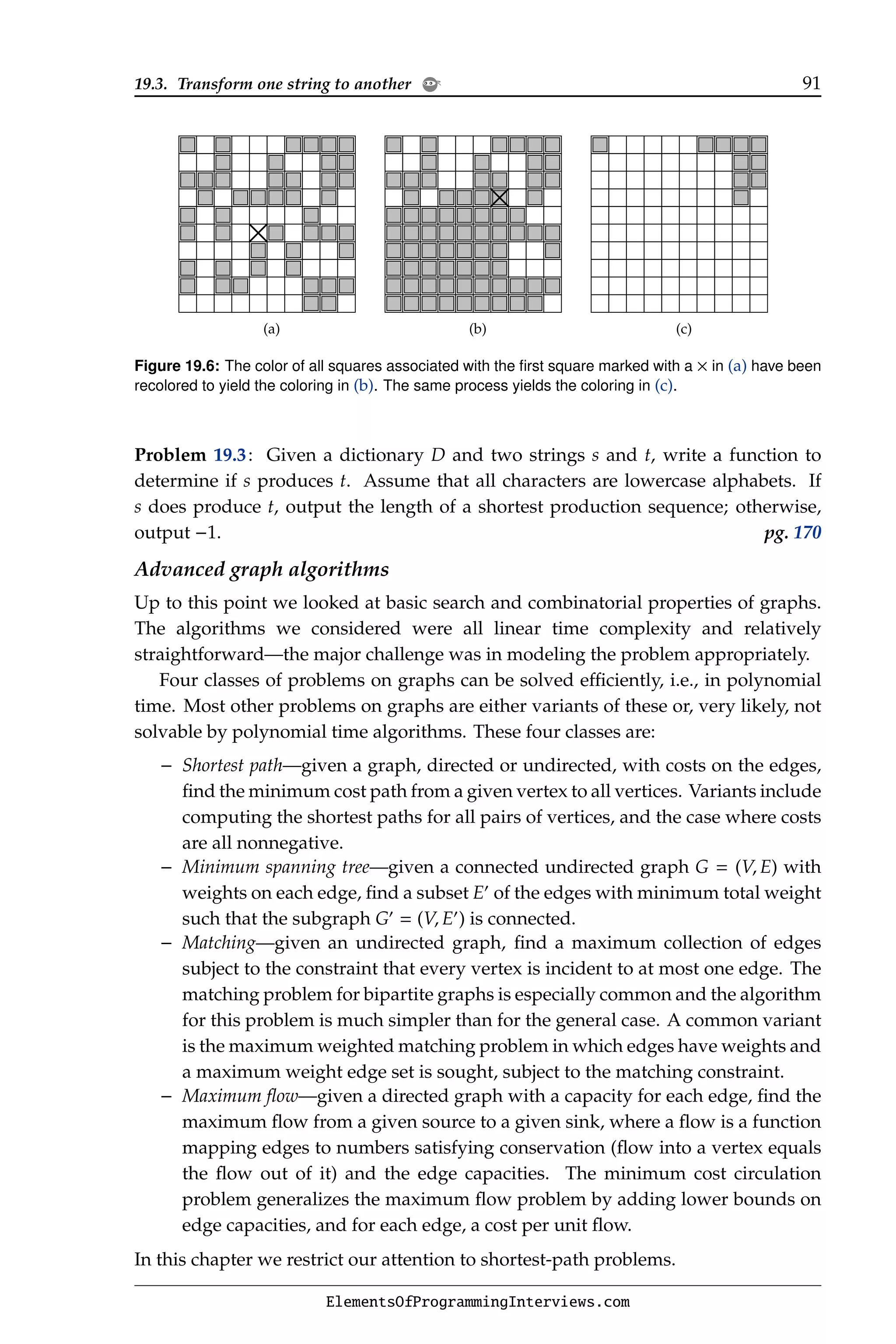
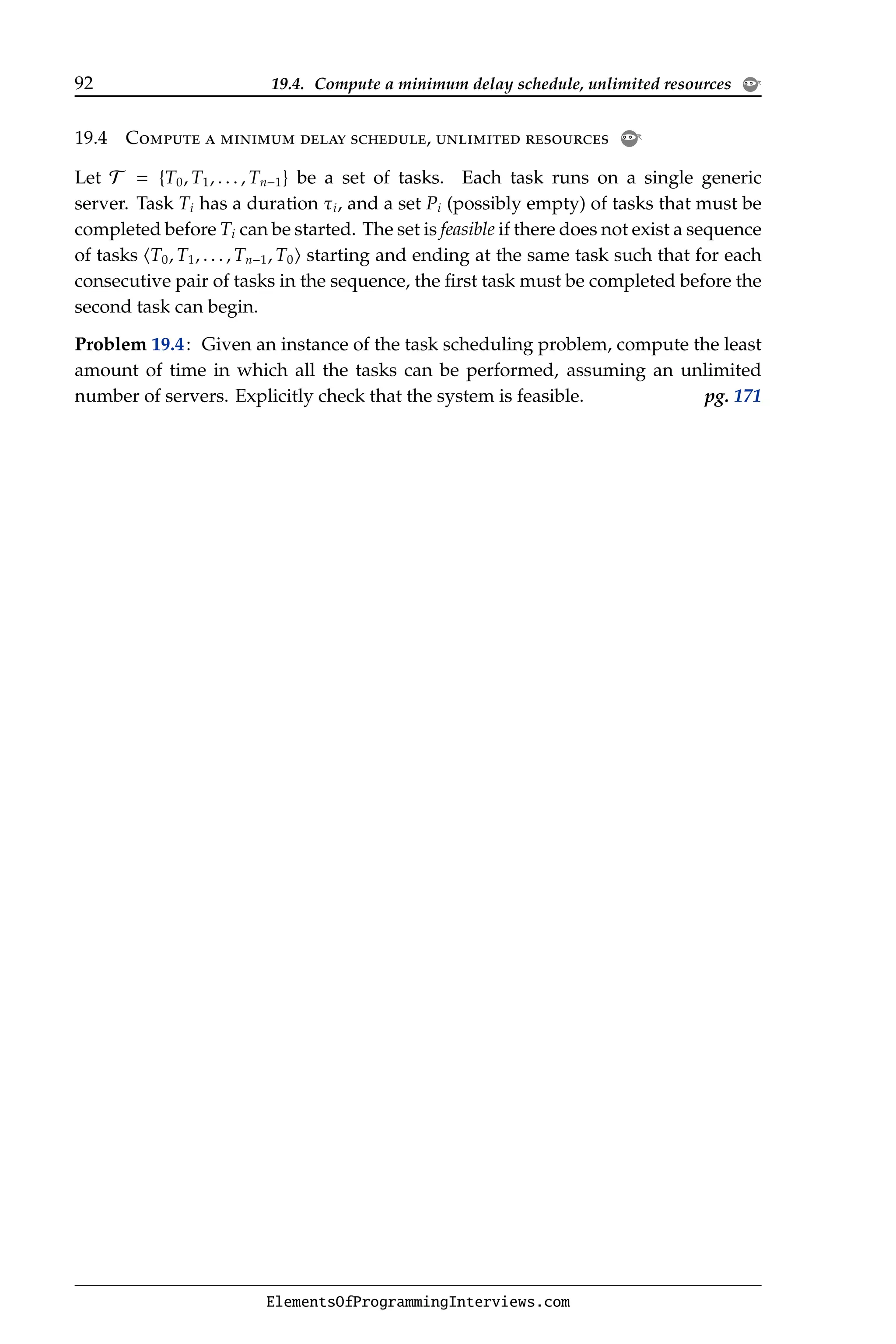
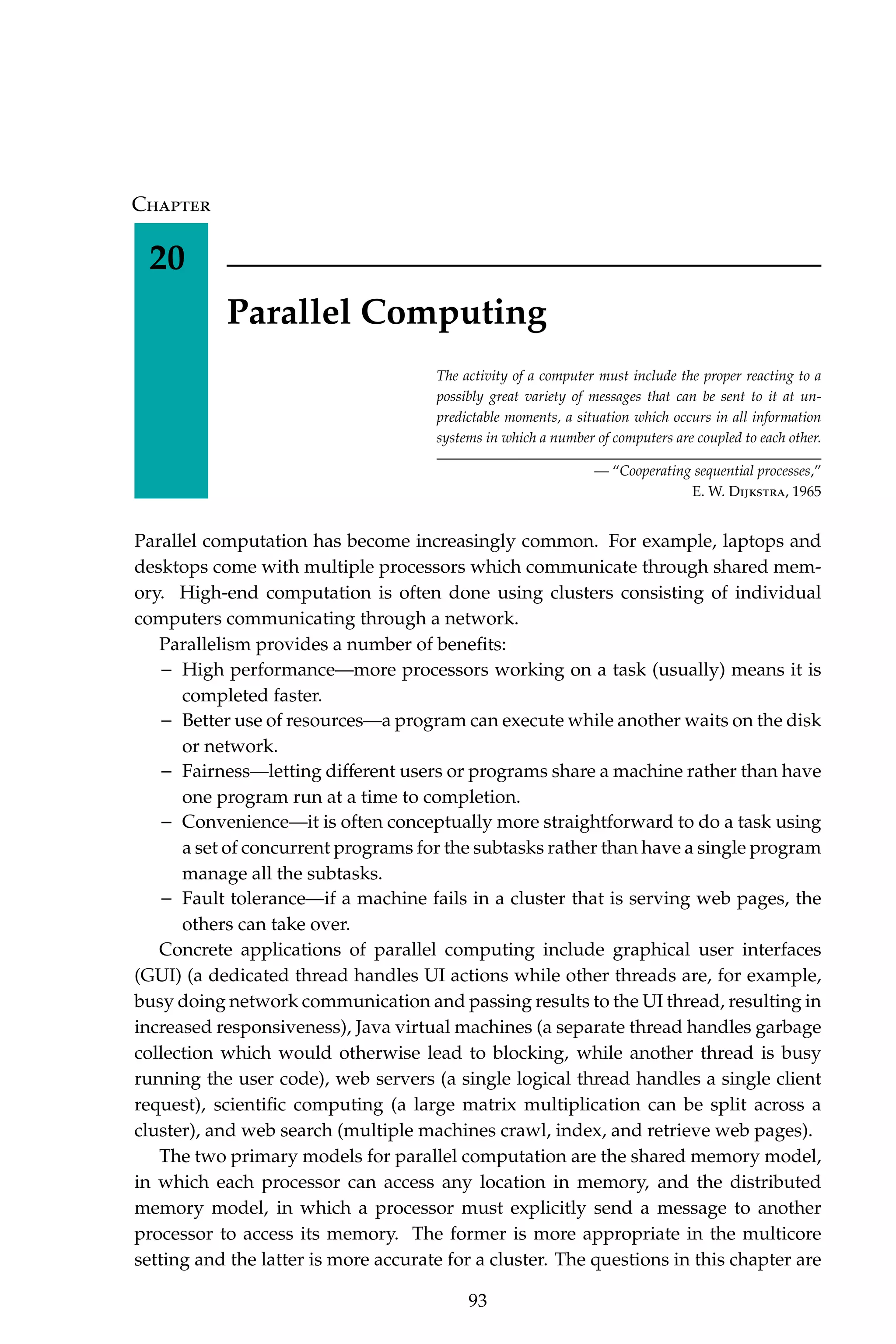
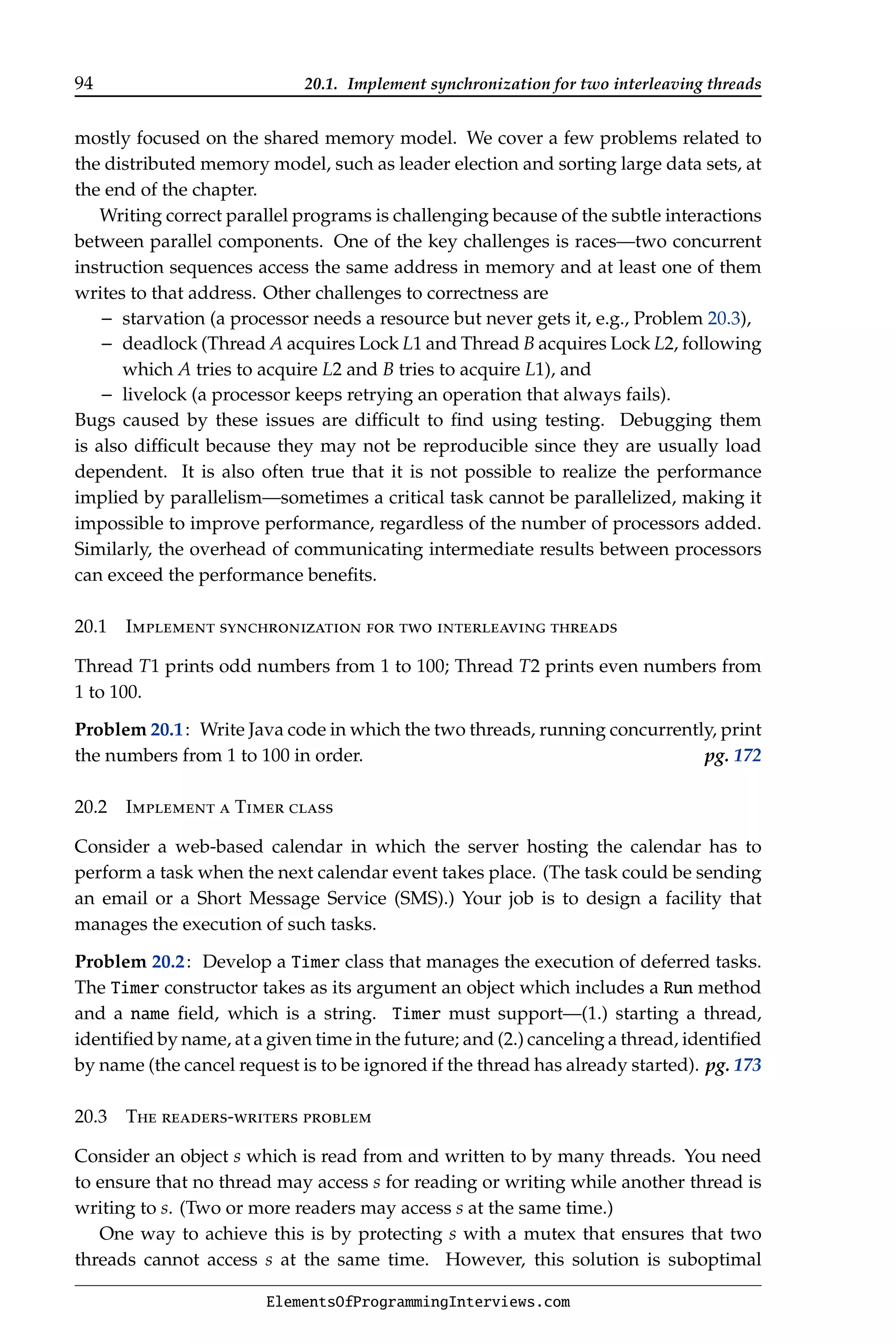

![Chapter
21
Design Problems
We have described a simple but very powerful and flexible pro-
tocol which provides for variation in individual network packet
sizes, transmission failures, sequencing, flow control, and the
creation and destruction of process- to-process associations.
— “A Protocol for Packet Network Intercommunication,”
V. G. Cerf and R. E. Kahn, 1974
This chapter is concerned with system design problems. These problems are fairly
open-ended, and many can be the starting point for a large software project. In an
interview setting when someone asks such a question, you should have a conver-
sation in which you demonstrate an ability to think creatively, understand design
trade-offs, and attack unfamiliar problems. You should sketch key data structures
and algorithms, as well as the technology stack (programming language, libraries,
OS, hardware, and services) that you would use to solve the problem. Some specific
things to keep in mind are implementation time, scalability, testability, security, and
internationalization.
The answers in this chapter are presented in this context—they are meant to be
examples of good responses in an interview and are not definitive state-of-the-art
solutions.
21.1 Implement PageRank
The PageRank algorithm assigns a rank to a web page based on the number of
“important” pages that link to it. The algorithm essentially amounts to the following:
(1.) Build a matrix A based on the hyperlink structure of the web. Specifically,
Aij = 1
di
if page i links to page j; here di is the total number of unique outgoing
links from page i.
(2.) Find X satisfying X = [1] + (1 − )AT
X. Here is a constant, e.g., 1
7
, and [1]
represents a column vector of 1s. The value X[i] is the rank of the i-th page.
The most commonly used approach to solving the above equation is to start with
a value of X, where each component is 1
n
(where n is the number of pages) and then
perform the following iteration: Xk = [1] + (1 − )AT
Xk−1.
Problem 21.1: Design a system that can compute the ranks of ten billion web pages
in a reasonable amount of time. pg. 175
96](https://image.slidesharecdn.com/elementsofprogramminginterviews-220623105328-e235fecd/75/Elements-of-Programming-Interviews-pdf-102-2048.jpg)
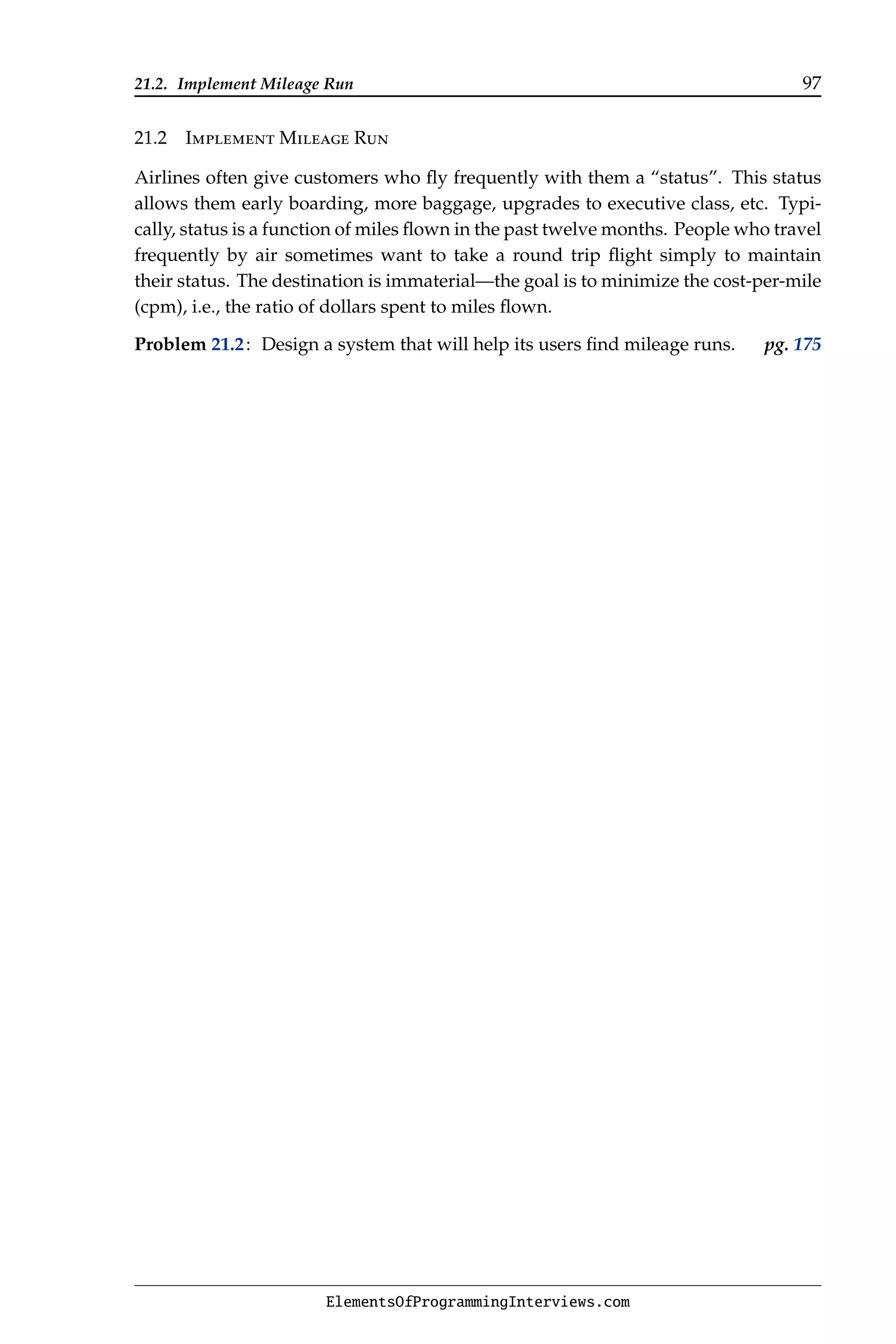

![Hints
When I interview people, and they give me an immediate
answer, they’re often not thinking. So I’m silent. I wait.
Because they think they have to keep answering. And it’s
the second train of thought that’s the better answer.
— R. Leach
Use a hint after you have made a serious attempt at the problem. Ideally, the hint
should give you the flash of insight needed to complete your solution.
Usually, you will receive hints only after you have shown an understanding of
the problem, and have made serious attempts to solve it. See Chapter 2 for strategies
on conducting yourself at the interview.
5.1: Use a lookup table, but don’t use 264 entries!
5.2: Relate x/y to (x − y)/y.
5.3: What base can you easily convert to and from?
5.4: How would you mimic a three-sided coin with a two-sided coin?
5.5: Solve the same problem with 2, 5, 10, and 20 doors.
5.6: Use case analysis: both even; both odd; one even and one odd.
6.1: Think about the partition step in quicksort.
6.2: Identifying the minimum and maximum heights is not enough since the minimum height
may appear after the maximum height. Focus on valid height differences.
6.3: What do you need to know about A[0 : i − 1] when processing A[i]?
6.4: Use a routine that yields k-sized subsets to create a routine for k + 1-sized subsets.
6.5: Suppose you have a procedure which selects k packets from the first n ≥ k packets as
specified. How would you deal with the (n + 1)-th packet?
7.1: Build the result one digit at a time.
7.2: It’s difficult to solve this with one pass.
7.3: Use recursion.
8.1: Two sorted arrays can be merged using two indices. For lists, take care when one pointer
variable reaches the end.
8.2: Use a pair of pointers.
8.3: Consider using two pointers, one fast and one slow.
8.4: Copy the jump field and then copy the next field.
9.1: Use additional storage to track the maximum value.
9.2: First think about solving this problem with a pair of queues.
9.3: Track the head and tail. How can you differentiate a full queue from an empty one?
99](https://image.slidesharecdn.com/elementsofprogramminginterviews-220623105328-e235fecd/75/Elements-of-Programming-Interviews-pdf-105-2048.jpg)
![100 Hints for Problems
10.1: Think of a classic binary tree algorithm that runs in O(h) additional space.
10.2: When is the root the LCA?
10.3: How can you tell whether a node is a left child or right child of its parent?
10.4: Study n’s right subtree. What if n does not have a right subtree?
11.1: Which portion of each file is significant as the algorithm executes?
11.2: Suppose you know the k closest stars in the first n stars. If the (n + 1)-th star is to be added
to the set of k closest stars, which element in that set should be evicted?
11.3: Can you avoid tracking all elements?
12.1: Don’t stop after you reach the first k. Think about the case where every entry equals k.
12.2: Use the decrease and conquer principle.
12.3: The first k elements of A together with the first k elements of B are initial candidates.
Iteratively eliminates a constant fraction of the candidates.
12.4: Can you be sure there is an address which is not in the file?
13.1: Map strings to strings so that strings which are anagrams map to the same string.
13.2: Count.
13.3: A line can be uniquely represented by two numbers.
14.1: Solve the problem if n and m differ by orders of magnitude. What if n ≈ m?
14.2: Focus on endpoints.
14.3: What is the union of two closed intervals?
15.1: Is it correct to check for each node that its key is greater than or equal to the key at its left
child and less than or equal to the key at its right child?
15.2: Perform binary search, keeping some additional state.
15.3: Which element should be the root?
16.1: If you know how to transfer the top n − 1 rings, how does that help move the n-th ring?
16.2: There are 2n subsets for a given set S of size n. There are 2k k-bit words.
16.3: Apply the constraints to speed up a brute-force algorithm.
17.1: Count the number of combinations in which there are 0 w0 plays, then 1 w0 plays, etc.
17.2: If i 0 and j 0, you can get to (i, j) from (i − 1, j) or (j − 1, i).
17.3: The “obvious” recurrence is not the right one.
17.4: Solve the generalized problem, i.e., determine for each prefix of s whether it is the con-
catenation of dictionary words.
17.5: Express the longest nondecreasing subsequence ending at A[i] in terms of the longest
nondecreasing subsequence in A[0 : i − 1].
18.1: Reduce the problem from n symbols to one on n − 1 symbols.
18.2: How would you check if A[i] is part of a triple that 3-creates t?
18.3: How would you efficiently find the largest rectangle which includes the i-th building, and
has height A[i]?
19.1: Model the maze as a graph.
19.2: Solve this conceptually, then think about implementation optimizations.
19.3: Treat strings as vertices in an undirected graph, with an edge between u and v iff the
corresponding strings differ in one character.
19.4: What property does a minimal set of infeasible tasks have?
20.1: The two threads need to notify each other when they are done.
20.2: There are two aspects—data structure design and concurrency.
ElementsOfProgrammingInterviews.com](https://image.slidesharecdn.com/elementsofprogramminginterviews-220623105328-e235fecd/75/Elements-of-Programming-Interviews-pdf-106-2048.jpg)


![C++11 and C++ for Java developers 103
C++11
C++11 adds a number of features that make for elegant and efficient code. The
C++11 constructs used in the solution code are summarized below.
− The auto attribute assigns the type of a variable based on the initializer expres-
sion.
− The enhanced range-based for-loop allows for easy iteration over a list of
elements.
− The emplace_front and emplace_back methods add new elements to the be-
ginning and end of the container. They are more efficient than push_front
and push_back, and are variadic, i.e., takes a variable number arguments. The
emplace method is similar and applicable to containers where there is only one
way to insert (e.g., a stack or a map).
− The array type is similar to ordinary arrays, but supports .size() and bound-
ary checking. (It does not support automatic resizing.)
− The tuple type implements an ordered set.
− Anonymous functions (“lambdas”) can be written via the [] notation.
− An initializer list uses the {} notation to avoid having to make explicit calls to
constructors when building list-like objects.
C++ for Java developers
C++ is an order of magnitude more complex than Java. Here are some facts about
C++ that can help Java programmers better understand the solution code.
− Operators in C++ can be overloaded. For example, can be applied to compar-
ing BigNumber objects. The array indexing operator ([]) is often overloaded
for unordered maps and tree maps, e.g., map[k] returns the value associated
with key k.
− Java’s HashMap and HashSet correspond to C++’s unordered_map and
unordered_set, respectively. Java’s TreeSet and TreeMap correspond to C++’s
set and map.
− For set, the comparator is the second argument to the template specification.
For map, the comparator is the third argument to the template specification. (If
is overloaded, the comparator is optional in both cases.)
− For unordered_map the first argument is the key type, the second is the value
type, and the third (optional) is the hash function. For unordered_set the
first argument is the key type, the second (optional) is the hash function, the
third (optional) is the equals function. The class may simply overload ==,
i.e., implement the method operator==. See Solution 13.3 on Page 140 for an
example.
− C++ uses streams for input-output. The overloaded operators « and » are used
to read and write primitive types and objects from and to streams.
− The :: notation is used to invoke a static member function or refer to a static
field.
− C++ has a built-in pair class used to represent arbitrary pairs.
ElementsOfProgrammingInterviews.com](https://image.slidesharecdn.com/elementsofprogramminginterviews-220623105328-e235fecd/75/Elements-of-Programming-Interviews-pdf-109-2048.jpg)
![104 Solution 5.1
− A static_cast is used to cast primitive types, e.g., int to double, as well as
an object to a derived class. The latter is not checked at run time. The compiler
checks obvious incompatibilities at compile time.
− A unique_ptr is a smart pointer that retains sole ownership of an object through
a pointer and destroys that object when the unique_ptr goes out of scope.
− A shared_ptr is a smart pointer with a reference count which the runtime
system uses to implement automatic garbage collection.
Problem 5.1, pg. 43: How would you go about computing the parity of a very large number
of 64-bit nonnegative integers?
Solution 5.1: The fastest algorithm for manipulating bits can vary based on the
underlying hardware. Let n denote the width of an integer and k the number of bits
set to 1 set in a particular integer. (For example, for a 64-bit integer, n = 64. For the
specific integer (1011)2, k = 3.)
The brute-force algorithm consists of iteratively testing the value of each bit.
1 short parity1(unsigned long x) {
2 short result = 0;
3 while (x) {
4 result ^= (x 1);
5 x = 1;
6 }
7 return result;
8 }
The time complexity of the algorithm above is O(n).
There is a neat trick that erases the lowest set bit of a number in a single operation
which can be used to improve performance in the best and average cases.
1 short parity2(unsigned long x) {
2 short result = 0;
3 while (x) {
4 result ^= 1;
5 x = (x - 1); // erases the lowest set bit of x.
6 }
7 return result;
8 }
The time complexity of the algorithm above is O(k).
However, when you have to perform a large number of parity operations, and,
more generally, any kind of bit fiddling operation, the best way to proceed is to
precompute the answer and store it in an array-based lookup table. The optimum
size for the lookup table is a function of how much RAM is available, and how
big the cache is. In the implementation below we store the parity of i, a 16-bit
integer in precomputed_parity[i]. Each precomputed_parity[i] can be statically
initialized. Alternately, we can use lazy initialization, with a separate flag bit used to
indicate whether a particular precomputed_parity[i] value is valid. The following
implementation of parity uses this approach. The time complexity is a function of
the size of the keys used to index precomputed_parity. For a sufficiently large array,
ElementsOfProgrammingInterviews.com](https://image.slidesharecdn.com/elementsofprogramminginterviews-220623105328-e235fecd/75/Elements-of-Programming-Interviews-pdf-110-2048.jpg)
![Solution 5.2 105
it can be O(1). (This does not include the time to initialize precomputed_parity.)
The time complexity for general n is O(n).
1 short parity3(unsigned long x) {
2 return precomputed_parity[x 48] ^
3 precomputed_parity[(x 32) 0b1111111111111111] ^
4 precomputed_parity[(x 16) 0b1111111111111111] ^
5 precomputed_parity[x 0b1111111111111111];
6 }
We are assuming that the short type is 16 bits, and the unsigned long is 64
bits. The operation x » 48 returns the value of x right-shifted by 48 bits. Since x
is unsigned, the C++ language standard guarantees that bits vacated by the shift
operation are zero-filled. (The result of a right-shift for signed quantities, is imple-
mentation dependent, e.g., either 0 or the sign bit may be propagated into the vacated
bit positions.)
Another implementation with a smaller lookup table is shown below. We
make use of the property that parity is commutative. For example, the parity of
hb63, b62, . . . , b3, b2, b1, b0i equals the parity of hb63 ⊕ b31, b62 ⊕ b30, . . . , b32 ⊕ b0i; the latter
32 bit value can be computed with one shift and one XOR instruction. This leads to
the algorithm below. The final step entails a lookup into a lookup table indexed by
a 4 bit quantity—we could instead have performed two more shift and XOR steps.
1 short parity4(unsigned long x) {
2 x ^= x 32;
3 x ^= x 16;
4 x ^= x 8;
5 x ^= x 4;
6 x = 0xf; // only want the last 4 bits of x.
7 // Return the LSB, which is the parity.
8 return four_bit_parity_lookup(x) 1;
9 }
10
11 // The LSB of kFourBitParityLookupTable is the parity of 0,
12 // next bit is parity of 1, followed by the parity of 2, etc.
13
14 const int kFourBitParityLookupTable = 0x6996; // = 0b0110100110010110.
15
16 short four_bit_parity_lookup(int x) {
17 return kFourBitParityLookupTable x;
18 }
Problem 5.2, pg. 44: Given two positive integers x and y, how would you compute x/y if
the only operators you can use are addition, subtraction, and shifting?
Solution 5.2: We can use the following recursion:
x
y
=
0, if x y;
1 +
(x−y)
y
, otherwise.
ElementsOfProgrammingInterviews.com](https://image.slidesharecdn.com/elementsofprogramminginterviews-220623105328-e235fecd/75/Elements-of-Programming-Interviews-pdf-111-2048.jpg)
![106 Solution 5.3
This is not efficient by itself, but we can improve it by computing the largest k such
that 2k
y ≤ x, in which case the recursive step is 2k
+
(x−2k y)
y
. Note that 2k
y can be
computed by left-shifting y by k.
Let n be the number of bits needed to represent x. Assume x ≥ y. Each iteration
reduces the dividend in the recursive call by at least half, so there are O(n) recursive
calls. If the largest k such that 2k
y ≤ x is computed by iterating through k, each call
has time complexity O(n). This leads to an O(n2
) algorithm. The time complexity can
be improved to O(n log n) by using binary search to find the largest k.
1 unsigned divide_x_y(unsigned x, unsigned y) {
2 unsigned res = 0;
3 while (x = y) {
4 int power = 1;
5 // Checks (y power) = (y (power - 1)) to prevent potential
6 // overflow of unsigned.
7 while ((y power) = (y (power - 1)) (y power) = x) {
8 ++power;
9 }
10
11 res += 1U (power - 1);
12 x -= y (power - 1);
13 }
14 return res;
15 }
Problem 5.3, pg. 44: Write a function that performs base conversion. Specifically, the input
is an integer base b1, a string s, representing an integer x in base b1, and another integer base
b2; the output is the string representing the integer x in base b2. Assume 2 ≤ b1, b2 ≤ 16.
Use “A” to represent 10, “B” for 11, . . . , and “F” for 15.
Solution 5.3: We can use a reductionist approach to solve this problem. We have
seen how to convert integers to strings in Solution 7.1 on Page 115; this approach
works for any base. Converting from strings is the reverse of this process. Therefore,
we can convert base b1 string s to a variable x of integer type, and then convert x to a
base b2 string ans.For example, if the string is “615”, b1 = 7 and b2 = 13, then x = 306,
and the final result is “1A7”.
1 string convert_base(const string s, int b1, int b2) {
2 bool neg = s.front() == ’-’;
3 int x = 0;
4 for (size_t i = (neg == true ? 1 : 0); i s.size(); ++i) {
5 x *= b1;
6 x += isdigit(s[i]) ? s[i] - ’0’ : s[i] - ’A’ + 10;
7 }
8
9 string ans;
10 while (x) {
11 int r = x % b2;
12 ans.push_back(r = 10 ? ’A’ + r - 10 : ’0’ + r);
13 x /= b2;
14 }
ElementsOfProgrammingInterviews.com](https://image.slidesharecdn.com/elementsofprogramminginterviews-220623105328-e235fecd/75/Elements-of-Programming-Interviews-pdf-112-2048.jpg)
![Solution 5.4 107
15
16 if (ans.empty()) { // special case: s is 0.
17 ans.push_back(’0’);
18 }
19 if (neg) { // s is a negative number.
20 ans.push_back(’-’);
21 }
22 reverse(ans.begin(), ans.end());
23 return ans;
24 }
The time complexity is O(n(1 + logb2
b1)), where n is the length of s. The reasoning is
as follows. First, we perform n multiply and adds to get x from s. Then we perform
logb2
x multiply and adds to get the result. The value x is upper-bounded by b1
n
, so
logb2
b1
n
= n logb2
b1.
Problem 5.4, pg. 44: How would you implement a random number generator that generates
a random integer i in [a, b], given a random number generator that produces either zero or
one with equal probability? All generated values should have equal probability. What is the
run time of your algorithm?
Solution 5.4: Basically, we want to produce a random integer in [0, b − a]. Let
t = b − a + 1. We can produce a random integer in [0, t − 1], as follows. Let i be the
least integer such that t ≤ 2i
.
If t is a power of 2, say t = 2i
, then all we need are i calls to the zero-one valued
random number generator—the i bits from the calls encode an i bit integer in [0, t−1],
and all such numbers are equally likely; so, we can use this integer.
If t is not a power of 2, the i calls may or may not encode an integer in the range 0
to t − 1. If the number is in the range, we return it; since all the numbers are equally
likely, the result is correct. If the number is outside the range [0, t − 1], we try again.
1 int uniform_random_a_b(int a, int b) {
2 int t = b - a + 1, res;
3 do {
4 res = 0;
5 for (int i = 0; (1 i) t; ++i) {
6 // zero_one_random() is the system-provided random number generator.
7 res = (res 1) | zero_one_random();
8 }
9 } while (res = t);
10 return res + a;
11 }
The time complexity of such randomized algorithms is usually described in terms
of average time. The probability of having to try again is less than 1
2
since t
2i−1
. Therefore, the probability that we take exactly k steps before succeeding is
at most 1
2
(1 − 1
2
)k−1
= 1
2
k
. This implies the expected number of trials is less than
11
2
+ 2(1
2
)2
+ 3(1
2
)3
+ · · · . Differentiating the identity 1
1−x
= 1 + x + x2
+ x3
+ · · · , yields
the identity 1
(1−x)2 = 1 + 2x + 3x2
+ 4x3
+ · · · . Multiplying both sides by x demonstrate
that x
(1−x)2 = x + 2x2
+ 3x3
+ 4x4
+ · · · . Substituting 1
2
for x in this last identity proves
ElementsOfProgrammingInterviews.com](https://image.slidesharecdn.com/elementsofprogramminginterviews-220623105328-e235fecd/75/Elements-of-Programming-Interviews-pdf-113-2048.jpg)
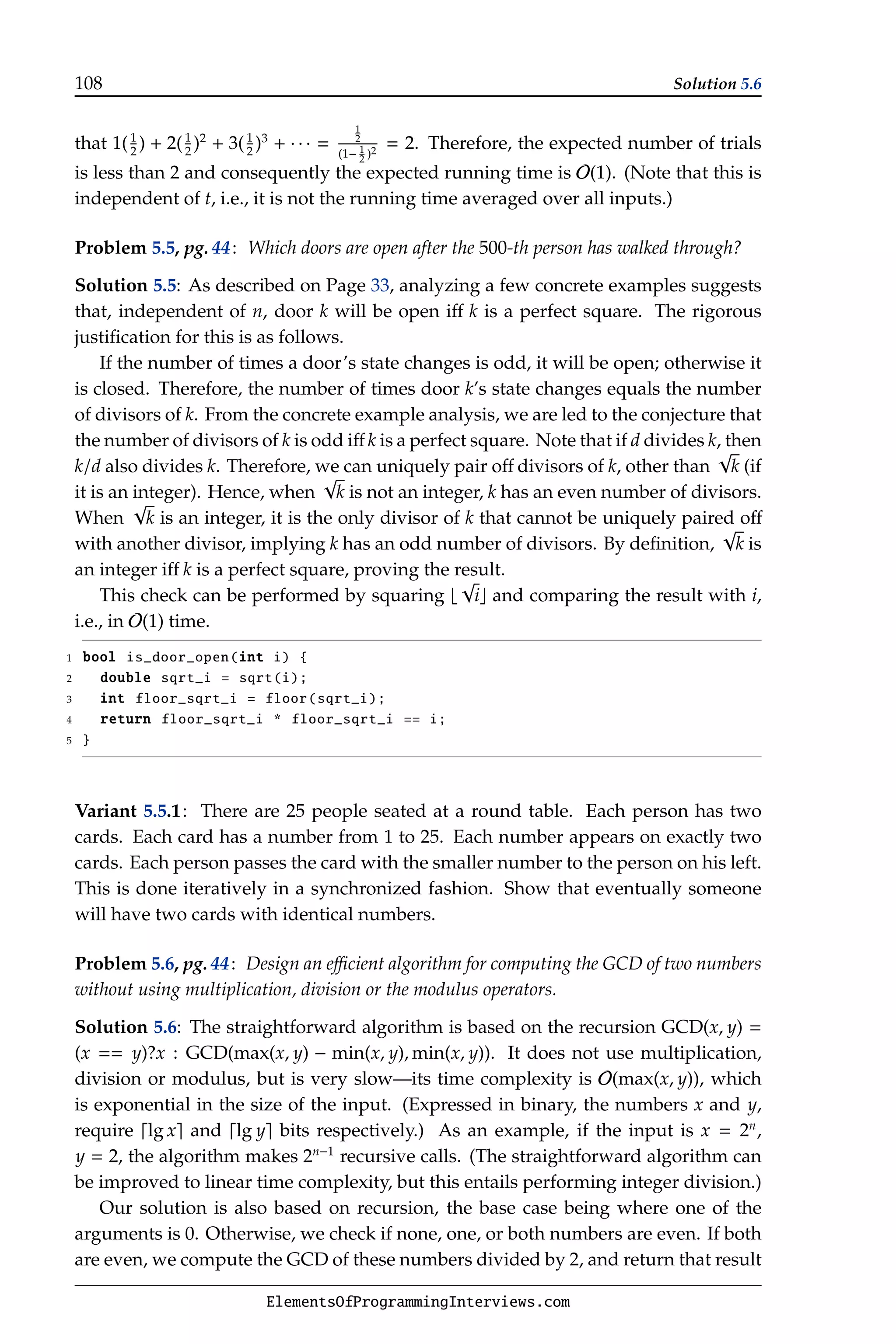
![Solution 6.1 109
times 2; if one is even, we half it, and return the GCD of the resulting pair; if both
are odd, we subtract the smaller from the larger and return the GCD of the resulting
pair. Multiplication by 2 is trivially implemented with a single left shift. Division by
2 is done with a single right shift.
Note that the last step leads to a recursive call with one even and one odd number.
Consequently, in every two calls, we reduce the combined bit length of the two
numbers by at least one, meaning that the time complexity is proportional to the sum
of the number of bits in x and y, i.e., O(log x + log y)).
1 long long GCD(long long x, long long y) {
2 if (x == 0) {
3 return y;
4 } else if (y == 0) {
5 return x;
6 } else if (!(x 1) !(y 1)) { // x and y are even.
7 return GCD(x 1, y 1) 1;
8 } else if (!(x 1) y 1) { // x is even, and y is odd.
9 return GCD(x 1, y);
10 } else if (x 1 !(y 1)) { // x is odd, and y is even.
11 return GCD(x, y 1);
12 } else if (x y) { // both x and y are odd, and x y.
13 return GCD(x - y, y);
14 }
15 return GCD(x, y - x); // both x and y are odd, and x = y.
16 }
Problem 6.1, pg. 46: Write a function that takes an array A of length n and an index i into
A, and rearranges the elements such that all elements less than A[i] appear first, followed by
elements equal to A[i], followed by elements greater than A[i]. Your algorithm should have
O(1) space complexity and O(n) time complexity.
Solution 6.1: This problem is conceptually straightforward: maintain four groups,
bottom (elements less than pivot), middle (elements equal to pivot), unclassified, and
top (elements greater than pivot). These groups are stored in contiguous order in
A. To make this partitioning run in O(1) space, we use smaller, equal, and larger
pointers to track these groups in the following way:
− bottom: stored in subarray A[0 : smaller − 1].
− middle: stored in subarray A[smaller : equal − 1].
− unclassified: stored in subarray A[equal : larger].
− top: stored in subarray A[larger + 1 : n − 1].
We explore elements of unclassified in order, and classify the element into one of
bottom, middle, and top groups according to the relative order between the incoming
unclassified element and pivot. Each iteration decreases the size of unclassified group
by 1, and the time spent within each iteration is O(1), implying the time complexity
is O(n).
The implementation is short but tricky, pay attention to the movements of pointers.
1 void dutch_flag_partition(int pivot_index , vectorint* A) {
2 int pivot = (*A)[pivot_index];
ElementsOfProgrammingInterviews.com](https://image.slidesharecdn.com/elementsofprogramminginterviews-220623105328-e235fecd/75/Elements-of-Programming-Interviews-pdf-115-2048.jpg)
![110 Solution 6.2
3 /**
4 * Keep the following invariants during partitioning:
5 * bottom group: (*A)[0 : smaller - 1].
6 * middle group: (*A)[smaller : equal - 1].
7 * unclassified group: (*A)[equal : larger].
8 * top group: (*A)[larger + 1 : A-size() - 1].
9 */
10 int smaller = 0, equal = 0, larger = A-size() - 1;
11 // When there is any unclassified element.
12 while (equal = larger) {
13 // (*A)[equal] is the incoming unclassified element.
14 if ((*A)[equal] pivot) {
15 swap((*A)[smaller++], (*A)[equal++]);
16 } else if ((*A)[equal] == pivot) {
17 ++equal;
18 } else { // (*A)[equal] pivot.
19 swap((*A)[equal], (*A)[larger --]);
20 }
21 }
22 }
-Variant 6.1.1: Assuming that keys take one of three values, reorder the array so
that all objects with the same key appear together. The order of the subarrays is not
important. For example, both Figures 6.1(b) and 6.1(c) on Page 47 are valid answers
for Figure 6.1(a) on Page 47. Use O(1) additional space and O(n) time.
-Variant 6.1.2: Given an array A of n objects with keys that takes one of four values,
reorder the array so that all objects that have the same key appear together. Use O(1)
additional space and O(n) time.
-Variant 6.1.3: Given an array A of n objects with Boolean-valued keys, reorder the
array so that objects that have the key false appear first. Use O(1) additional space
and O(n) time.
Variant 6.1.4: Given an array A of n objects with Boolean-valued keys, reorder the
array so that objects that have the key false appear first. The relative ordering of
objects with key true should not change. Use O(1) additional space and O() time.
Problem 6.2, pg. 47: Design an algorithm that takes a sequence of n three-dimensional
coordinates to be traversed, and returns the minimum battery capacity needed to complete
the journey. The robot begins with a fully charged battery.
Solution 6.2: Suppose the three-dimensions correspond to x, y, and z, with z being
the vertical dimension. Since energy usage depends on the change in height of the
robot, we can ignore the x and y coordinates. Suppose the points where the robot
goes in successive order have z coordinates z0, . . . , zn−1. Assume that the battery
capacity is such that with the fully charged battery, the robot can climb B meters.
ElementsOfProgrammingInterviews.com](https://image.slidesharecdn.com/elementsofprogramminginterviews-220623105328-e235fecd/75/Elements-of-Programming-Interviews-pdf-116-2048.jpg)
![Solution 6.3 111
The robot will run out of energy iff there exist integers i and j such that i j and
zj −zi B, i.e., to go from Point i to Point j, the robot has to climb more than B meters.
Therefore, we would like to pick B such that for any i j, we have B ≥ zj − zi.
We developed several algorithms for this problem in the introduction. Specifically,
on Page 2 we showed how to compute the minimum B in O(n) time by keeping the
running minimum as we do a sweep through the array. Here is an implementation.
1 int find_battery_capacity(const vectorint h) {
2 int min_height = numeric_limits int::max(), capacity = 0;
3 for (const int height : h) {
4 capacity = max(capacity , height - min_height);
5 min_height = min(min_height , height);
6 }
7 return capacity;
8 }
-Variant 6.2.1: Let A be an array of integers. Find the length of a longest subarray
all of whose entries are equal.
Problem 6.3, pg. 47: For each of the following, A is an integer array of length n.
(1.) Compute the maximum value of (A[j0] − A[i0]) + (A[j1] − A[i1]), subject to i0 j0
i1 j1.
(2.) Compute the maximum value of
Pk−1
t=0 (A[jt] − A[it]), subject to i0 j0 i1 j1
· · · ik−1 jk−1. Here k is a fixed input parameter.
(3.) Repeat Problem (2.) when k can be chosen to be any value from 0 to bn/2c.
Solution 6.3: The brute-force algorithm for (1.) has complexity O(n4
). The complexity
can be improved to O(n2
) by applying the O(n) algorithm to A[0 : j] and A[j+1 : n−1]
for each j ∈ [1, n−2]. However, we can actually solve (1.) in O(n) time by performing
a forward iteration and storing the best solution for A[0 : j], j ∈ [1, n − 1]. We then do
a reverse iteration, computing the best solution for A[j : n−1], j ∈ [0, n−2], which we
combine with the result from the forward iteration. The additional space complexity
is O(n), which is the space used to store the best solutions for the subarrays.
Here is a straightforward algorithm for (2.). Iterate over j from 1 to k and iterate
through A, recording for each index i the best solution for A[0 : i] with j pairs. We
store these solutions in an auxiliary array of length n. The overall time complexity
will be O(kn2
); by reusing the arrays, we can reduce the additional space complexity
to O(n).
We can improve the time complexity to O(kn), and the additional space complexity
to O(k) as follows. Define B
j
i
to be the most money you can have if you must make
j − 1 buy-sell transactions prior to i and buy at i. Define S
j
i
to be the maximum profit
achievable with j buys and sells with the j-th sell taking place at i. Then the following
mutual recurrence holds:
S
j
i
= A[i] + max
i0i
B
j
i0
B
j
i
= max
i0i
S
j−1
i0 − A[i]
ElementsOfProgrammingInterviews.com](https://image.slidesharecdn.com/elementsofprogramminginterviews-220623105328-e235fecd/75/Elements-of-Programming-Interviews-pdf-117-2048.jpg)
![112 Solution 6.3
The key to achieving an O(kn) time bound is the observation that computing B
and S requires computing maxi0i B
j−1
i0 and maxi0i S
j−1
i0 . These two quantities can be
computed in constant time for each i and j with a conditional update. In code:
1 int max_k_pairs_profits(const vectorint A, int k) {
2 vectorint k_sum(k 1, numeric_limits int::min());
3 for (int i = 0; i A.size(); ++i) {
4 vectorint pre_k_sum(k_sum);
5 for (int j = 0, sign = -1; j k_sum.size() j = i; ++j, sign *= -1) {
6 int diff = sign * A[i] + (j == 0 ? 0 : pre_k_sum[j - 1]);
7 k_sum[j] = max(diff, pre_k_sum[j]);
8 }
9 }
10 return k_sum.back(); // returns the last selling profits as the answer.
11 }
Note that the improved solution to (2.) on the preceding page specialized to k = 2
strictly subsumes the solution to (1.) on the previous page.
Surprisingly, (3.) on the preceding page can be solved almost trivially. Define a
locally maximum subarray of A to be a subarray A[i : j] such that (1.) all elements within
the subarray are equal, (2.) if i 0, A[i] A[i − 1], and (3.) if j n − 1, A[j] A[j + 1].
A locally minimum subarray is defined similarly. Call an index i a local minimum if
A[i] is less than or equal to its neighbors, and a local maximum if A[i] is greater than
or equal to its neighbors. An optimum solution for (3.) on the previous page then is
to buy at every local minimum that begins a locally minimum subarray and sell at
every local maximum that ends a locally maximum subarray. A local minimum at
the end of the array has to be special-cased as is a local maximum at the start of the
array. The code below implements this approach.
1 int max_profit_unlimited_pairs(const vectorint A) {
2 if (A.size() = 1) {
3 return 0;
4 }
5
6 int profit = 0, buy = A.front();
7 for (int i = 1; i A.size() - 1; ++i) {
8 if (A[i + 1] A[i] A[i - 1] = A[i]) { // sell at local maximum.
9 profit += A[i] - buy;
10 buy = A[i + 1];
11 } else if (A[i + 1] = A[i] A[i - 1] A[i]) { // buy at local minimum
12 buy = A[i];
13 }
14 }
15
16 if (A.back() buy) {
17 profit += A.back() - buy;
18 }
19 return profit;
20 }
The time complexity is O(n) since we spend O(1) per index.
ElementsOfProgrammingInterviews.com](https://image.slidesharecdn.com/elementsofprogramminginterviews-220623105328-e235fecd/75/Elements-of-Programming-Interviews-pdf-118-2048.jpg)
![Solution 6.4 113
Problem 6.4, pg. 48: Let A be an array of n distinct elements. Design an algorithm that
returns a subset of k elements of A. All subsets should be equally likely. Use as few calls to
the random number generator as possible and use O(1) additional storage. You can return
the result in the same array as input.
Solution 6.4: The problem is trivial when k = 1—we simply make one call to the
random number generator, take the returned r value mod n. We can swap A[n − 1]
with A[r]; A[n − 1] then holds the result.
For k 1, we start by choosing one element at random as above and we now
repeat the same process with the n − 1 element subarray A[0 : n − 2]. Eventually, the
random subset occupies the slots A[n − k : n − 1] and the remaining elements are in
the first n − k slots.
The algorithm clearly runs in O(1) space. To demonstrate that all the subsets are
equally likely, we show something stronger, namely that all permutations of size k
are equally likely.
Define a sequence of m elements of S with no repetitions to be an m-permutation
of S. It is easy to check that the number of m-permutations of a set of n elements is
n!
(n−m)!
.
The induction hypothesis now is that after iteration m, the subarray A[n−m : n−1]
contains each possible m-permutation with probability
(n−m)!
n!
.
The base case holds since for m = 1, any element is equally likely to be selected.
Suppose the inductive hypothesis holds for m = l. Now we study m = l + 1.
Consider a particular (l + 1)-permutation, say hα1, . . . , αl+1i. This consists of a single
element α1 followed by the l-permutation hα2, . . . , αl+1i. Let E1 be the event that α1
is selected in iteration l + 1 and E2 be the event that the first l iterations produced
hα2, . . . , αl+1i. The probability of hα1, . . . , αl+1i resulting after iteration l + 1 is simply
Pr(E1 ∩ E2) = Pr(E1 | E2)Pr(E2). By the inductive hypothesis, the probability of
permutation hα2, . . . , αl+1i is
(n−l)!
n!
. The probability Pr(E1|E2) = 1
n−l
since the algorithm
selects from elements in the subarray A[0 : n−l−1] with equal probability. Therefore
Pr(E1 ∩ E2) = Pr(E1|E2)Pr(E2) =
1
n − l
(n − l)!
n!
=
(n − l − 1)!
n!
and induction goes through.
The algorithm generates all random k-permutations with equal probability, from
which it follows that all subsets of size k are equally likely.
The algorithm just described makes k calls to the random number generator.
When k is bigger than n
2
, we can optimize by computing a subset of n − k elements
to remove from the set. For example, when k = n − 1, this replaces n − 1 calls to the
random number generator with a single call. (Of course, while all subsets of size m
are equally likely with this optimization, all m-permutations are not.
1 vectorint offline_sampling(vectorint A, int k) {
2 default_random_engine gen((random_device())()); // random num generator.
3 for (int i = 0; i k; ++i) {
4 // Generate a random int in [i, A.size() - 1].
5 uniform_int_distribution int dis(i, A.size() - 1);
ElementsOfProgrammingInterviews.com](https://image.slidesharecdn.com/elementsofprogramminginterviews-220623105328-e235fecd/75/Elements-of-Programming-Interviews-pdf-119-2048.jpg)
![114 Solution 6.5
6 swap(A[i], A[dis(gen)]);
7 }
8 A.resize(k);
9 return A;
10 }
Variant 6.4.1: The rand() function in the standard C library returns a uniformly ran-
dom number in [0, RAND_MAX − 1]. Does rand() mod n generate a number uniformly
distributed [0, n − 1]?
Problem 6.5, pg. 48: Design an algorithm that reads a sequence of packets and maintains
a uniform random subset of size k of the read packets when the n ≥ k-th packet is read.
Solution 6.5: We store the first k packets. Consequently, we select the n-th packet
to add to our subset with probability k
n
. If we do choose it, we select an element
uniformly at random to eject from the subset.
To show that the algorithm works correctly, we use induction on the number of
packets that have been read. Specifically, the induction hypothesis is that all k-sized
subsets are equally likely after n ≥ k packets have been read.
The number of k-size subsets is n
k
, implying the probability of any k-size subset
should be 1
(n
k)
.
For the base case, n = k, there is exactly one subset of size k which is what the
algorithm computes.
Assume the induction hypothesis holds for n k. Consider the (n + 1)-th packet.
The probability of a k-size subset that does not include the (n + 1)-th packet is the
probability that the k-size subset was selected after reading the n-th packet and the
(n + 1)-th packet was not selected. These two events are independent, which means
the probability of selecting such a subset is
1
n
k
1 −
k
n + 1
!
=
k!(n − k)!
n!
n + 1 − k
n + 1
!
=
k!(n + 1 − k)!
(n + 1)!
.
This simplifies to 1
(n+1
k )
, so induction goes for subsets excluding the n + 1 element.
The probability of a k-size subset H that includes the (n + 1)-th packet pn+1 can be
computed as follows. Let G be a k-size subset of the first n packets. The only way we
can get from G to H is if G contains H {pn+1}. Let G∗
be such a subset; let {q} = G G∗
.
The probability of going from G to H is the probability of selecting pn+1 and
dropping q, which is equal to k
n+1
1
k
. There exist −(k−1) candidate subsets for G∗
, each
with probability 1
(n
k)
(by the inductive hypothesis) which means that the probability
of H is given by
k
n + 1
1
k
(n + (k − 1))
1
n
k
=
(n + 1 − k)(n − k)!k!
(n + 1)n!
=
1
n+1
k
,
so induction goes through for subsets including the (n + 1)-th element.
ElementsOfProgrammingInterviews.com](https://image.slidesharecdn.com/elementsofprogramminginterviews-220623105328-e235fecd/75/Elements-of-Programming-Interviews-pdf-120-2048.jpg)
![Solution 7.1 115
1 vectorint reservoir_sampling(istringstream* sin, int k) {
2 int x;
3 vectorint R;
4 // Store the first k elements.
5 for (int i = 0; i k *sin x; ++i) {
6 R.emplace_back(x);
7 }
8
9 // After the first k elements.
10 int element_num = k;
11 while (*sin x) {
12 default_random_engine gen((random_device())()); // random num generator.
13 // Generate a random int in [0, element_num].
14 uniform_int_distribution int dis(0, element_num++);
15 int tar = dis(gen);
16 if (tar k) {
17 R[tar] = x;
18 }
19 }
20 return R;
21 }
The time complexity is proportional to the number of elements in the stream, since
we spend O(1) time per element. The space complexity is O(k).
Problem 7.1, pg. 49: Implement string/integer inter-conversion functions. Use the follow-
ing function signatures: String intToString(int x) and int stringToInt(String
s).
Solution 7.1: For a positive integer x, we iteratively divide x by 10, and record the
remainder till we get to 0. This yields the result from the least significant digit, and
needs to be reversed. If x is negative, we record that, and negate x, adding a ’-’
afterward. If x is 0, our code breaks out of the iteration without writing any digits,
in which case we need to explicitly set a 0.
1 string intToString(int x) {
2 bool is_negative;
3 if (x 0) {
4 x = -x, is_negative = true;
5 } else {
6 is_negative = false;
7 }
8
9 string s;
10 while (x) {
11 s.push_back(’0’ + x % 10);
12 x /= 10;
13 }
14 if (s.empty()) {
15 return {0}; // x is 0.
16 }
17
18 if (is_negative) {
ElementsOfProgrammingInterviews.com](https://image.slidesharecdn.com/elementsofprogramminginterviews-220623105328-e235fecd/75/Elements-of-Programming-Interviews-pdf-121-2048.jpg)
![116 Solution 7.2
19 s.push_back(’-’);
20 }
21 reverse(s.begin(), s.end());
22 return s;
23 }
24
25 // We define the valid strings for this function as those matching regexp
26 // -?[0-9]+.
27 int stringToInt(const string s) {
28 // - starts as a valid integer , but has no digits.
29 if (s == -) {
30 throw invalid_argument(illegal input);
31 }
32
33 bool is_negative = s[0] == ’-’;
34 int x = 0;
35 for (int i = is_negative; i s.size(); ++i) {
36 if (isdigit(s[i])) {
37 x = x * 10 + s[i] - ’0’;
38 } else {
39 throw invalid_argument(illegal input);
40 }
41 }
42 return is_negative ? -x : x;
43 }
Problem 7.2, pg. 49: Implement a function for reversing the words in a string s. Your
function should use O(1) space.
Solution 7.2: The code for computing the position for each character in a single pass
is fairly complex. However, a two stage iteration is easy. In the first step, reverse the
entire string and in the second step, reverse each word. For example, “ram is costly”
transforms to “yltsoc si mar”, which transforms to “costly is ram”.
1 void reverse_words(string* s) {
2 // Reverse the whole string first.
3 reverse(s-begin(), s-end());
4
5 size_t start = 0, end;
6 while ((end = s-find( , start)) != string::npos) {
7 // Reverse each word in the string.
8 reverse(s-begin() + start, s-begin() + end);
9 start = end + 1;
10 }
11 // Reverse the last word.
12 reverse(s-begin() + start, s-end());
13 }
Since we spend O(1) per character, the time complexity is O(n), where n is the length
of s.
ElementsOfProgrammingInterviews.com](https://image.slidesharecdn.com/elementsofprogramminginterviews-220623105328-e235fecd/75/Elements-of-Programming-Interviews-pdf-122-2048.jpg)
![Solution 8.1 117
Problem 7.3, pg. 50: Write a function which takes as input a phone number, specified
as a string of digits, return all possible character sequences that correspond to the phone
number. The cell phone keypad is specified by a mapping M that takes a digit and returns
the corresponding set of characters. The character sequences do not have to be legal words or
phrases.
Solution 7.3: Recursion is natural. Let P be an n-digit number sequence. Assume
these digits are indexed starting at 0, i.e., P[0] is the first digit. Let S be a character
sequence corresponding to the first k digits of P. We can generate all length n character
sequences corresponding to P that have S as their prefix as follows. If k = n, there is
nothing to do. Otherwise, we recurse on each length-k + 1 sequence of the form Sx,
for each x ∈ M(P[k]).
1 void phone_mnemonic(const string num) {
2 string ans(num.size(), 0);
3 phone_mnemonic_helper(num, 0, ans);
4 }
5
6 const int kNumTelDigits = 10;
7
8 const arraystring, kNumTelDigits M = {{0, 1, ABC, DEF, GHI,
9 JKL, MNO, PQRS, TUV,
10 WXYZ}};
11
12 void phone_mnemonic_helper(const string num, int d, string* ans) {
13 if (d == num.size()) { // get enough characters and output answer.
14 cout *ans endl;
15 } else {
16 for (const char c : M[num[d] - ’0’]) { // try all combinations.
17 (*ans)[d] = c;
18 phone_mnemonic_helper(num, d + 1, ans);
19 }
20 }
21 }
Since there are no more than 4 possible characters for each digit, the number of
recursive calls T(n) satisfies T(n) ≤ 4T(n − 1), which solves to T(n) = O(4n
). For the
function calls that entail recursion, the time spent within the function, not including
the recursive calls, is O(1). For the base case, printing a sequence of length n takes
time O(n). Therefore, the time complexity is O(4n
n).
Variant 7.3.1: Solve the same problem without using recursion.
Problem 8.1, pg. 52: Write a function that takes L and F, and returns the merge of L
and F. Your code should use O(1) additional storage—it should reuse the nodes from the
lists provided as input. Your function should use O(1) additional storage, as illustrated in
Figure 8.3 on Page 52. The only field you can change in a node is next.
Solution 8.1: We traverse the lists, using one pointer per list, each initialized to
the list head. We compare the contents of the pointer—the pointer with the lesser
ElementsOfProgrammingInterviews.com](https://image.slidesharecdn.com/elementsofprogramminginterviews-220623105328-e235fecd/75/Elements-of-Programming-Interviews-pdf-123-2048.jpg)
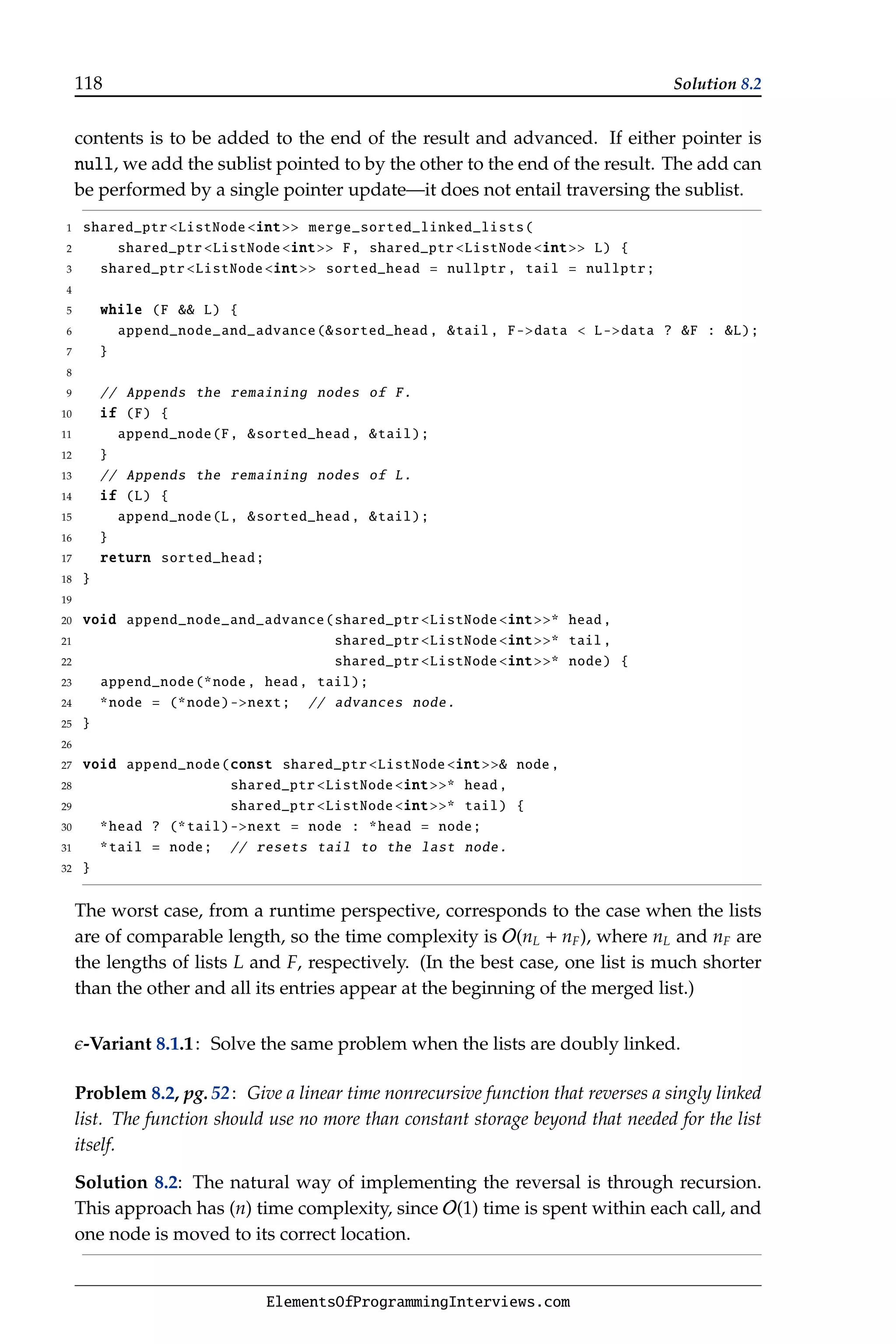
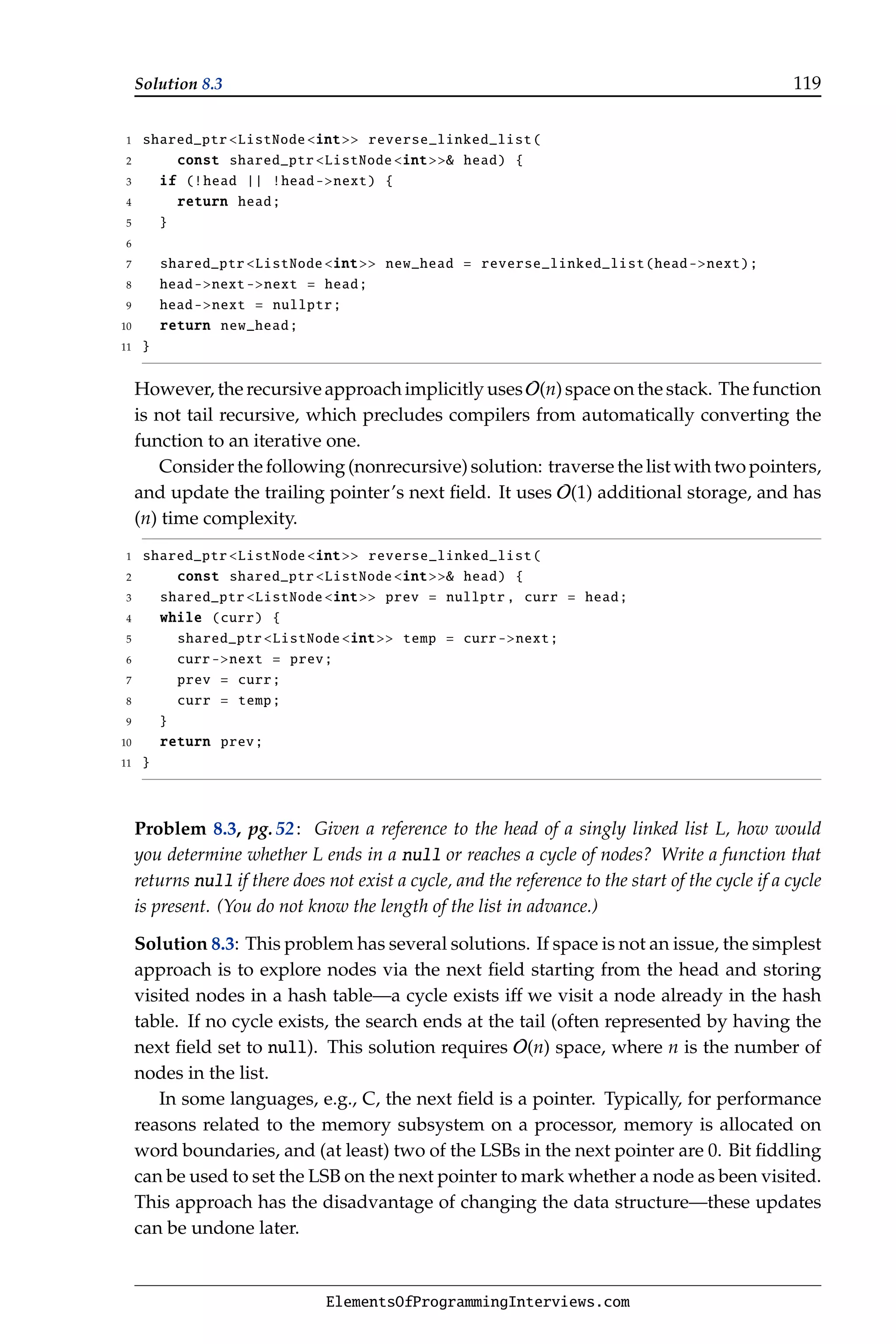


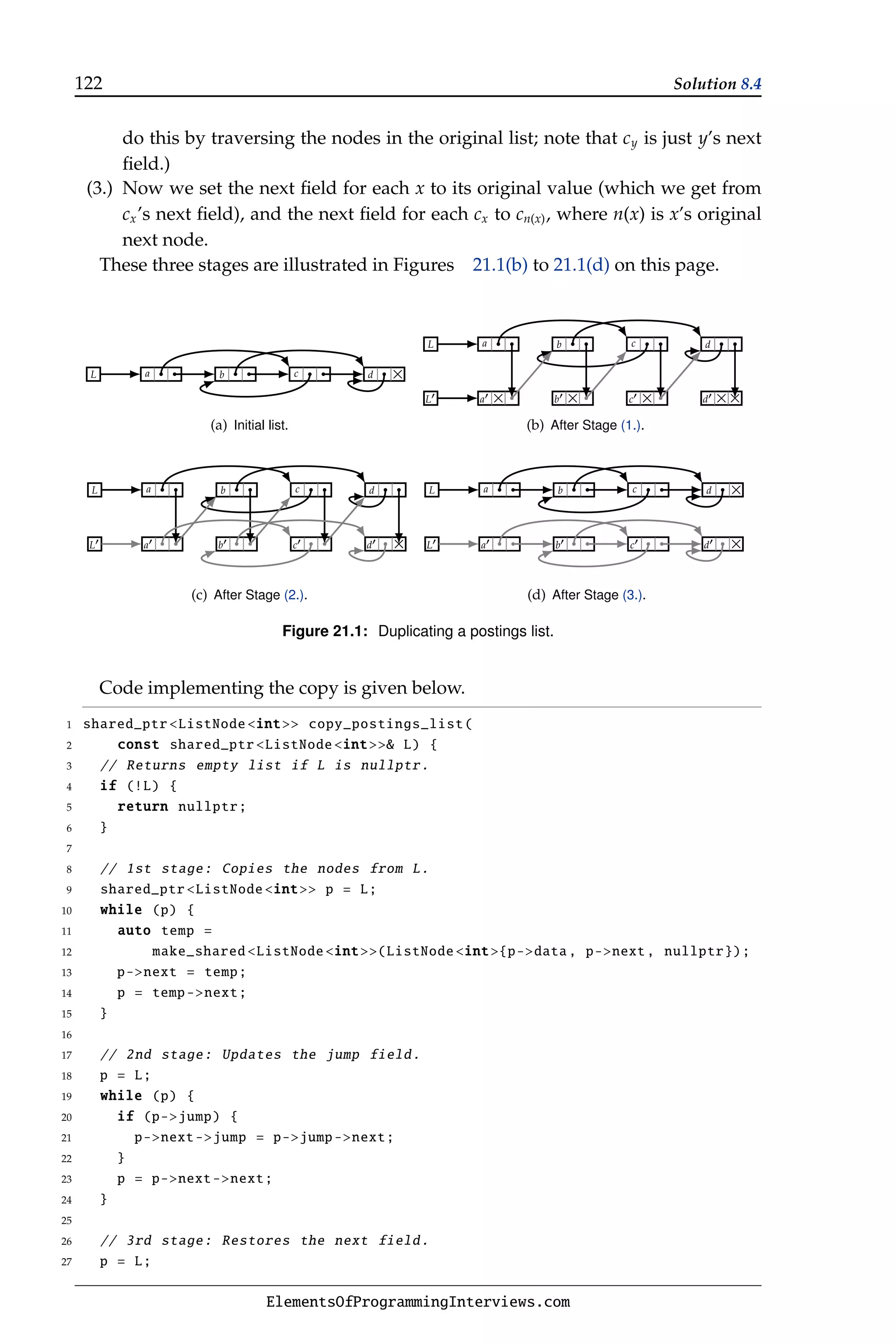
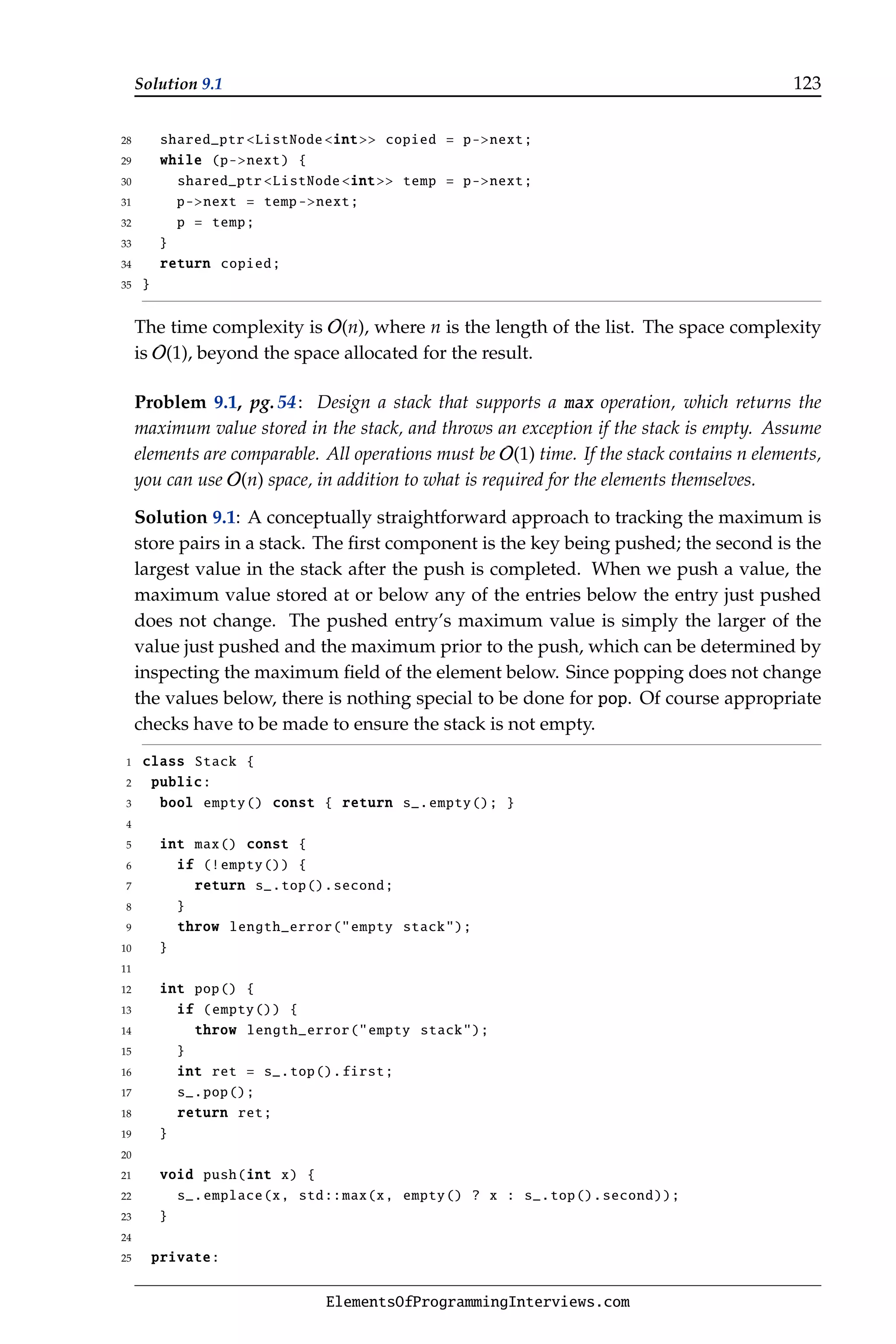
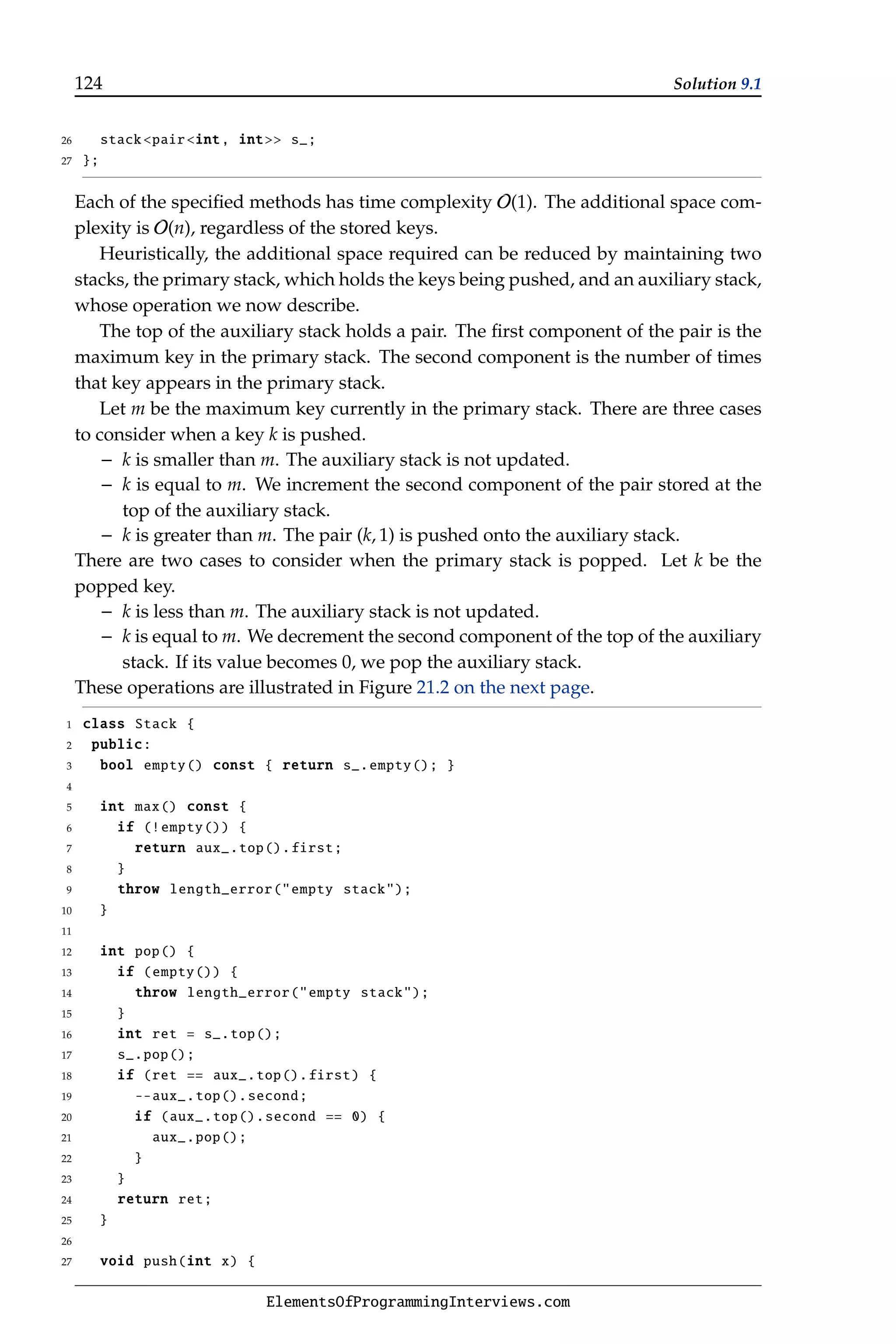
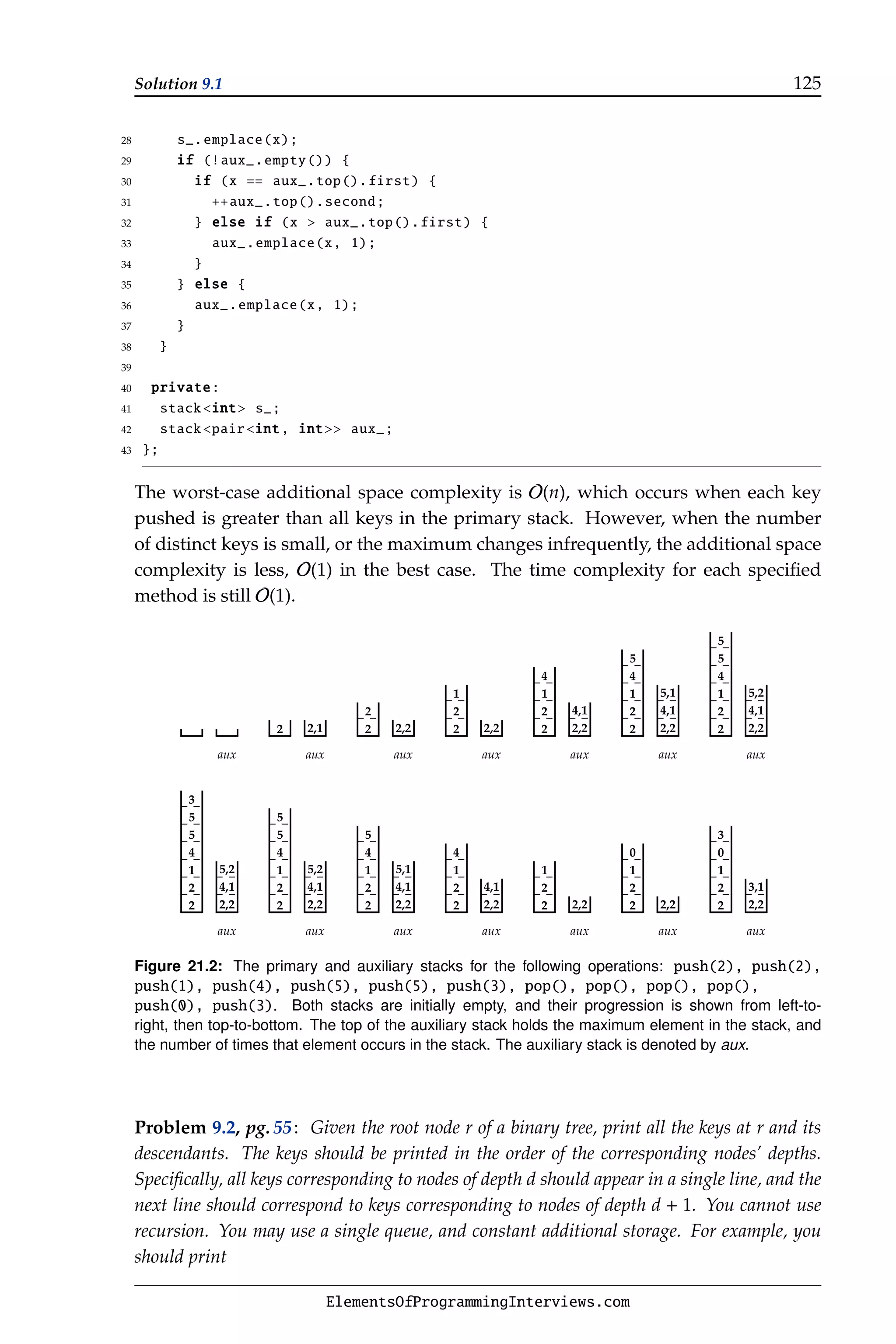
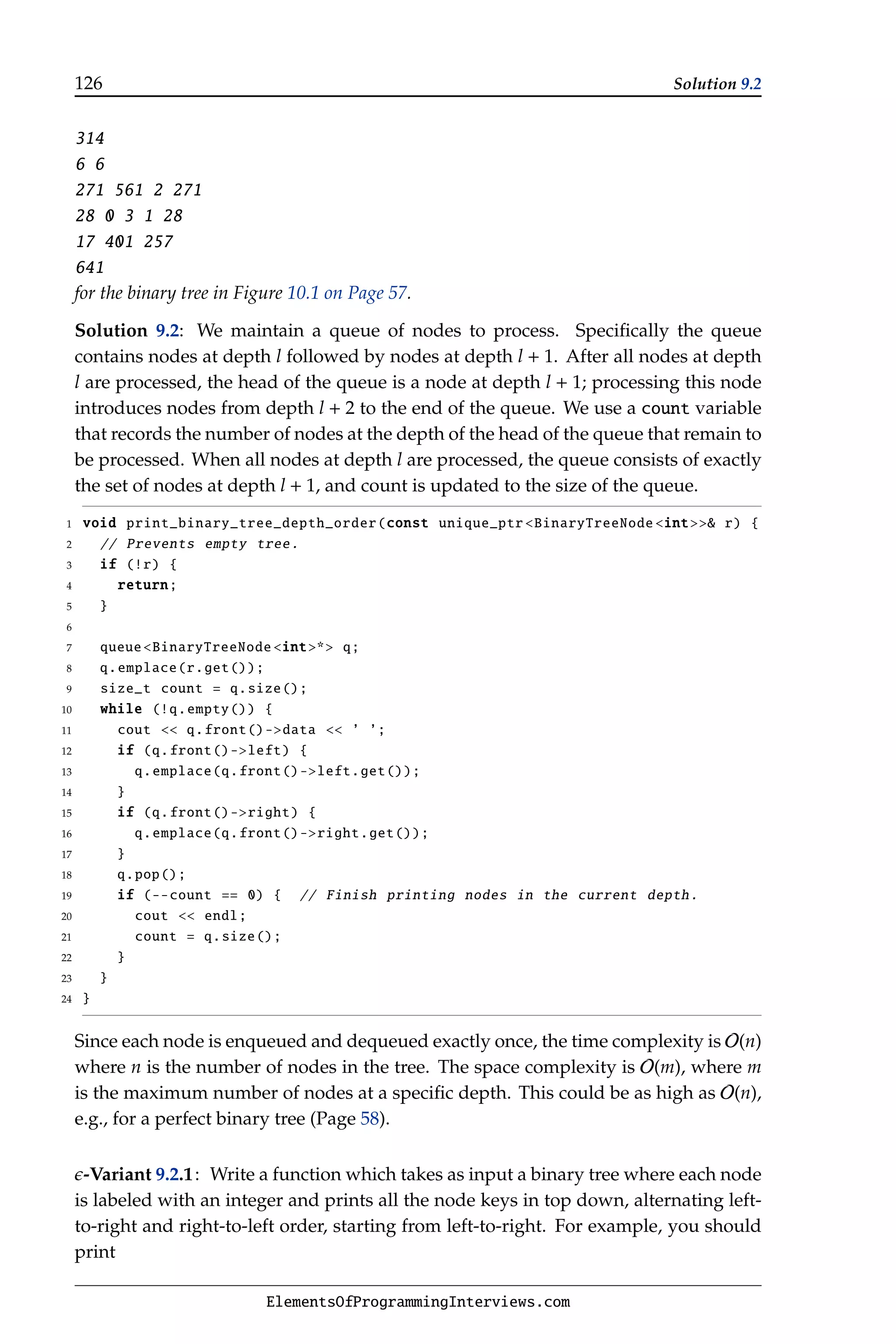
![Solution 9.3 127
314
6 6
271 561 2 271
28 1 3 0 28
17 401 257
641
for the binary tree in Figure 10.1 on Page 57.
-Variant 9.2.2: Write a function which takes as input a binary tree where each node
is labeled with an integer and prints all the node keys in a bottom up, left-to-right
order. For example, if the input is the tree in Figure 10.1 on Page 57, your function
should print 641
17 401 257
28 0 3 1 28
271 561 2 271
6 6
314
Problem 9.3, pg. 55: Implement a queue API using an array for storing elements. Your
API should include a constructor function, which takes as argument the capacity of the queue,
enqueue and dequeue functions, a size function, which returns the number of elements
stored, and implement dynamic resizing.
Solution 9.3: We use an array of length n to store up to n elements. We resize the
array by a factor of 2 each time we run out of space. The queue has a head field that
indexes the least recently inserted element, and a tail field, which is the index that
the next inserted element will be written to. We record the number of elements in
the queue with a count variable. Initially, head and tail are 0. When count = n and
a enqueue is attempted we resize. When count = 0 and a dequeue is attempted we
throw an exception.
1 class Queue {
2 public:
3 explicit Queue(size_t cap) : data_(cap) {}
4
5 void enqueue(int x) {
6 // Dynamically resizes due to data_.size() limit.
7 if (count_ == data_.size()) {
8 // Rearranges elements.
9 rotate(data_.begin(), data_.begin() + head_, data_.end());
10 head_ = 0, tail_ = count_; // resets head and tail.
11 data_.resize(data_.size() 1);
12 }
13 // Performs enqueue.
14 data_[tail_] = x;
15 tail_ = (tail_ + 1) % data_.size(), ++count_;
16 }
ElementsOfProgrammingInterviews.com](https://image.slidesharecdn.com/elementsofprogramminginterviews-220623105328-e235fecd/75/Elements-of-Programming-Interviews-pdf-133-2048.jpg)
![128 Solution 10.1
17
18 int dequeue() {
19 if (!count_) {
20 throw length_error(empty queue);
21 }
22 --count_;
23 int ret = data_[head_];
24 head_ = (head_ + 1) % data_.size();
25 return ret;
26 }
27
28 size_t size() const { return count_; }
29
30 private:
31 size_t head_ = 0, tail_ = 0, count_ = 0;
32 vectorint data_;
33 };
The time complexity of each operation is O(1).
Alternative implementations are possible, e.g., we can avoid using count, and
instead use the difference between head and tail to determine the number of ele-
ments. In such an implementation we cannot store more than n − 1 elements, since
otherwise there is no way to differentiate a full queue from an empty one.
Problem 10.1, pg. 59: Write a function that takes as input the root of a binary tree and
returns true or false depending on whether the tree is balanced. Use O(h) additional
storage, where h is the height of the tree.
Solution 10.1: Without the O(h) constraint the problem is trivial—we can compute
the height for the tree rooted at each node x recursively. The basic computation
is x.height = max(x.left.height, x.right.height) + 1, and in each step we check if the
difference in heights of the left and right children is greater than one. We can store
the heights in a hash table, or in a new field in the nodes. This entails O(n) storage
and O(n) time, where n is the number of nodes of the tree.
We can solve this problem using O(h) storage by implementing a get_height
function which takes a node x as an argument and returns an integer. This function
get_height returns −2 if the node is unbalanced; otherwise it returns the height of
the subtree rooted at that node. The implementation of get_height is as follows. If x
is null, return −1. Otherwise run get_height on the left child. If the returned value
l is −2, node x is not balanced; return −2. Call get_height on x’s right child; let the
returned value be r. If r is −2 or |l − r| 1 return −2, otherwise return max(l, r) + 1.
The function get_height implements a postorder traversal with some calls being
eliminated because of early detection of unbalance. The function call stack corre-
sponds to a sequence of calls from the root through the unique path to the current
node, and the stack height is therefore bounded by the height of the tree, leading
to an O(h) space bound. The time complexity is the same as that for a postorder
traversal, namely O(n).
1 bool is_balanced_binary_tree(const unique_ptr BinaryTreeNode int T) {
ElementsOfProgrammingInterviews.com](https://image.slidesharecdn.com/elementsofprogramminginterviews-220623105328-e235fecd/75/Elements-of-Programming-Interviews-pdf-134-2048.jpg)
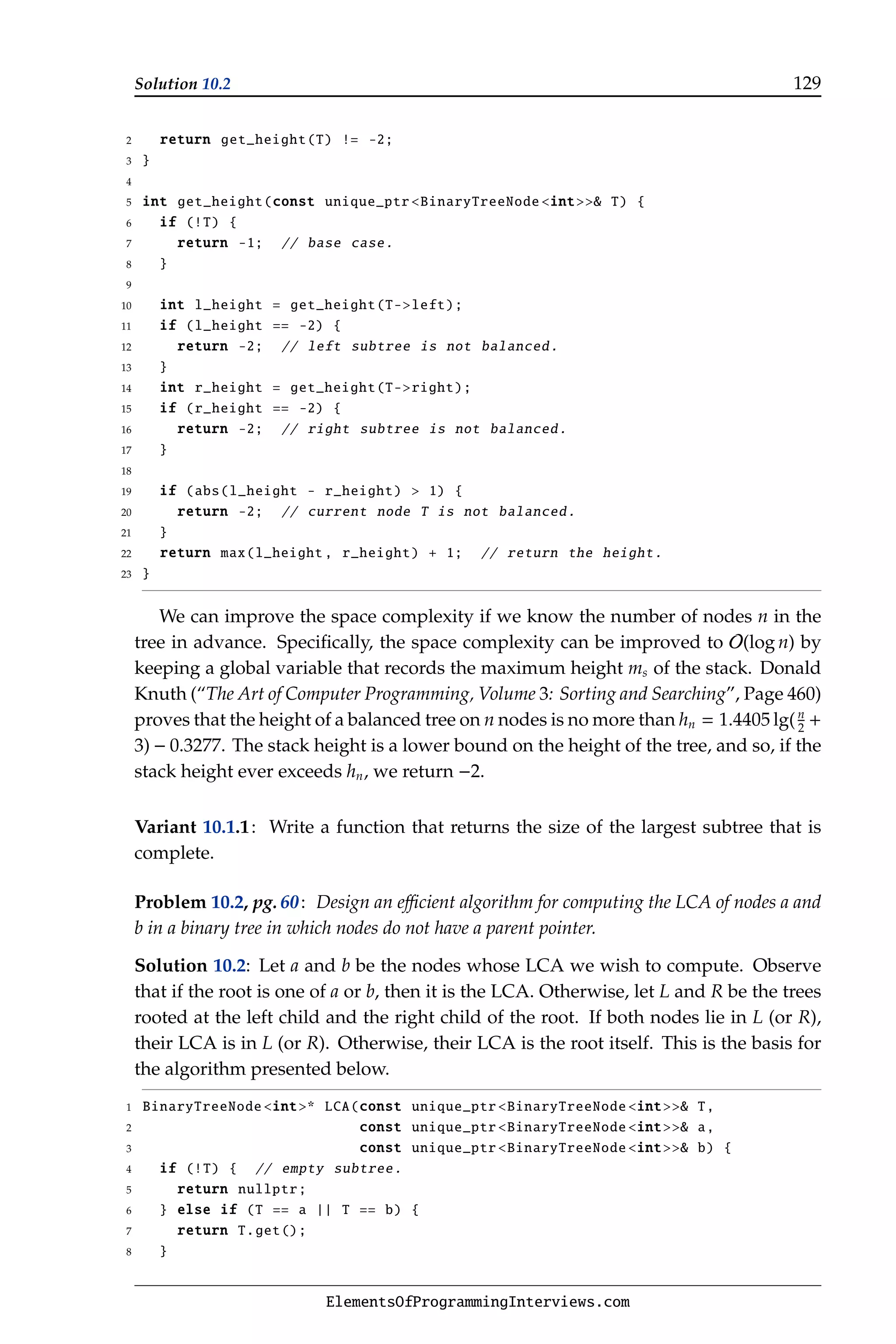
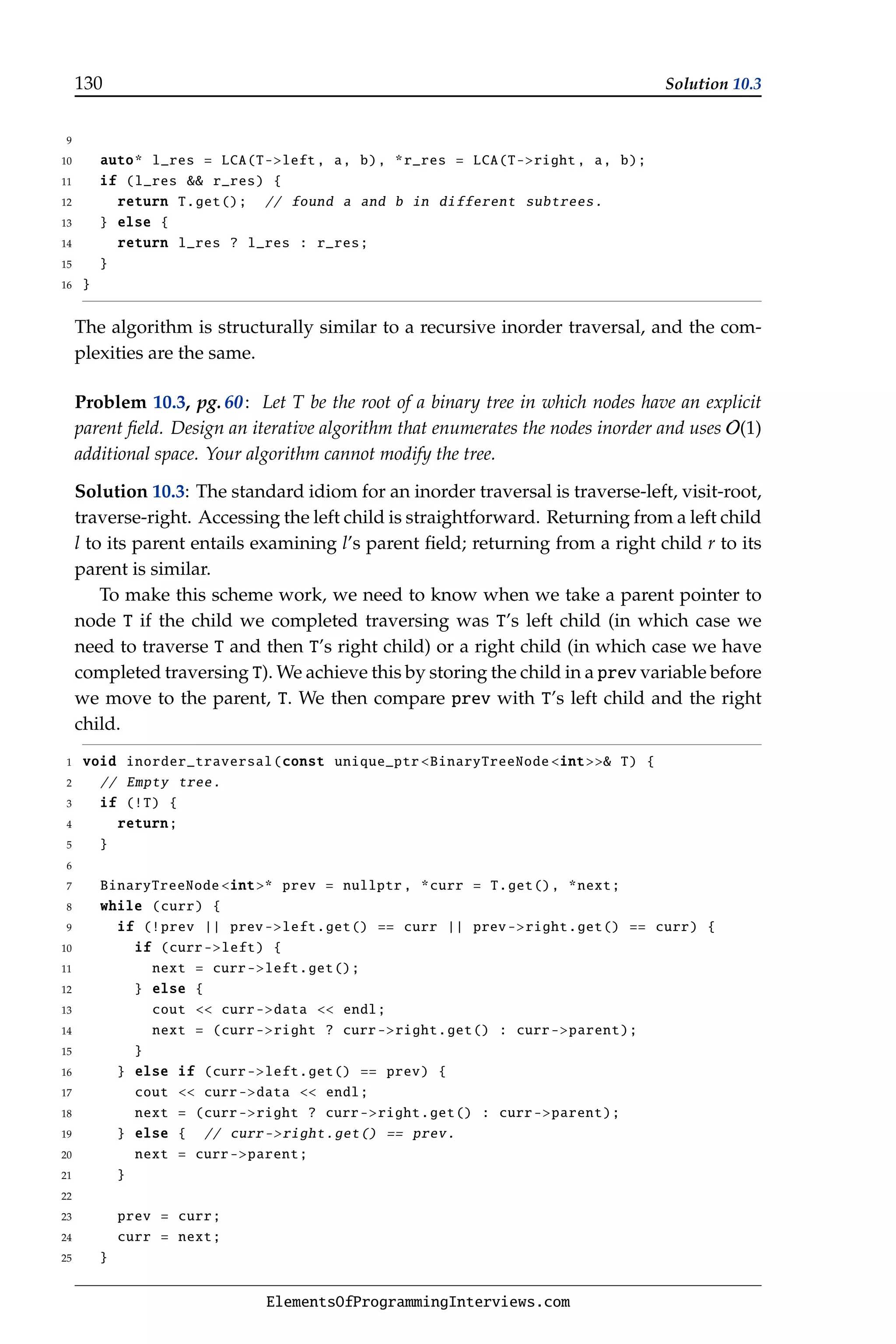
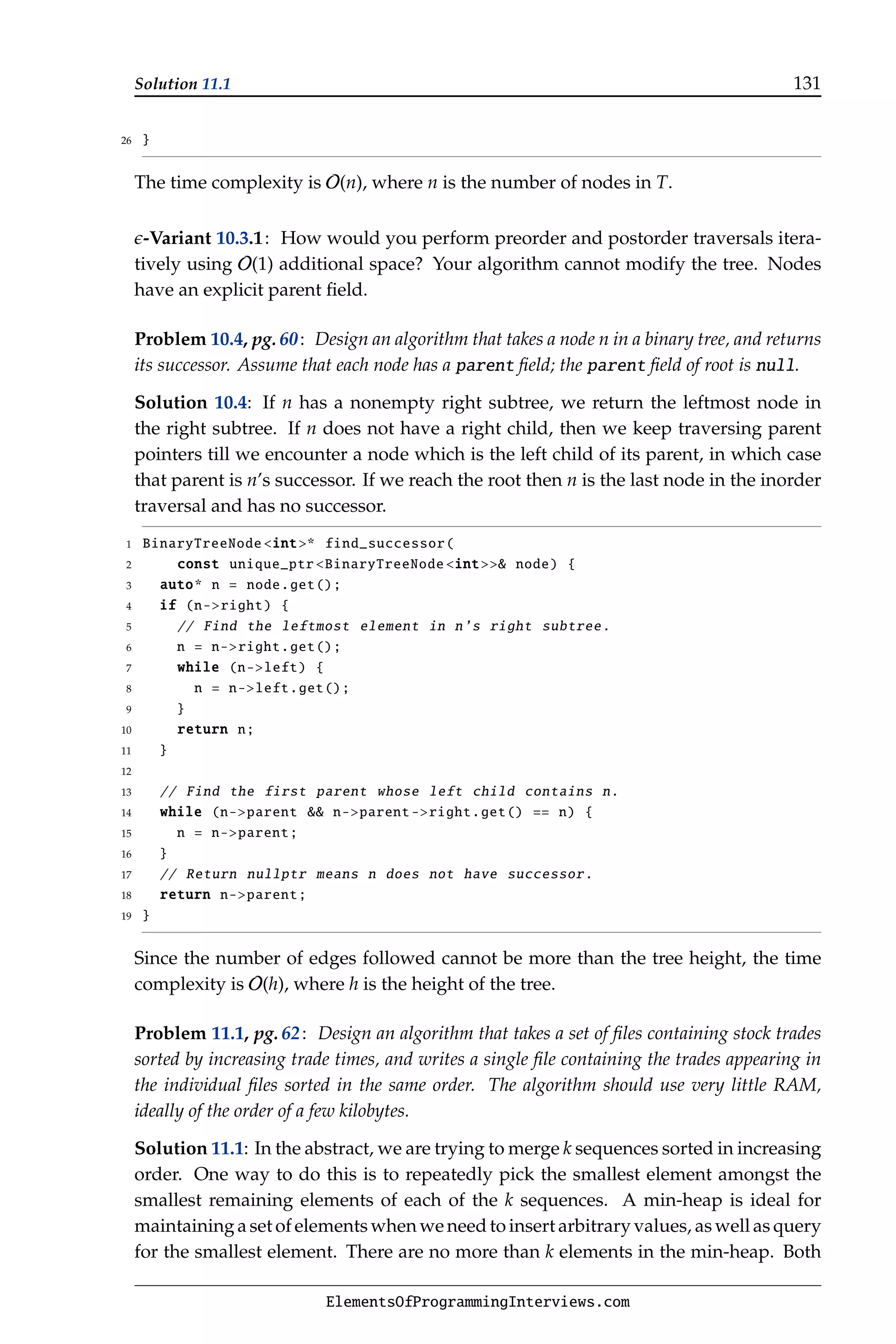
![132 Solution 11.2
extract-min and insert take O(log k) time. Hence, we can do the merge in O(n log k)
time, where n is the total number of elements in the input. The space complexity
is O(k) beyond the space needed to write the final result. The implementation is
given below. Note that for each element we need to store the sequence it came from.
For ease of exposition, we show how to merge sorted arrays, rather than files. The
only difference is that for the file case we do not need to explicitly maintain an index
for next unprocessed element in each sequence—the file I/O library tracks the first
unread entry in the file.
1 struct Compare {
2 bool operator()(const pairint, int lhs, const pairint, int rhs) {
3 return lhs.first rhs.first;
4 }
5 };
6
7 vectorint merge_arrays(const vectorvectorint S) {
8 priority_queue pairint, int, vectorpairint, int, Compare min_heap;
9 vectorint S_idx(S.size(), 0);
10
11 // Every array in S puts its smallest element in heap.
12 for (int i = 0; i S.size(); ++i) {
13 if (S[i].size() 0) {
14 min_heap.emplace(S[i][0], i);
15 S_idx[i] = 1;
16 }
17 }
18
19 vectorint ret;
20 while (!min_heap.empty()) {
21 pairint, int p = min_heap.top();
22 ret.emplace_back(p.first);
23 // Add the smallest element into heap if possible.
24 if (S_idx[p.second] S[p.second].size()) {
25 min_heap.emplace(S[p.second][S_idx[p.second]++], p.second);
26 }
27 min_heap.pop();
28 }
29 return ret;
30 }
Problem 11.2, pg. 63: How would you compute the k stars which are closest to the Earth?
You have only a few megabytes of RAM.
Solution 11.2: If RAM was not a limitation, we could read the data into an array, and
compute the k smallest elements using a selection algorithm.
It is not difficult to come up with an algorithm based on processing through
the file, selecting all stars within a distance d, and sorting the result. Selecting d
appropriately is difficult, and will require multiple passes with different choices of d.
A better approach is to use a max-heap H of k elements. We start by adding the
first k stars to H. As we process the stars, each time we encounter a star s that is
ElementsOfProgrammingInterviews.com](https://image.slidesharecdn.com/elementsofprogramminginterviews-220623105328-e235fecd/75/Elements-of-Programming-Interviews-pdf-138-2048.jpg)
![Solution 11.2 133
closer to the Earth than the star m in H that is furthest from the Earth (which is the
star at the root of H), we delete m from H, and add s to H.
The heap-based algorithm has O(n log k) time complexity to find the k closest stars
out of n candidates, independent of the order in which stars are processed and their
locations. Its space complexity is O(k).
1 class Star {
2 public:
3 // The distance between this star to the Earth.
4 double distance() const { return sqrt(x_ * x_ + y_ * y_ + z_ * z_); }
5
6 bool operator (const Star s) const { return distance() s.distance(); }
7
8 int ID_;
9 double x_, y_, z_;
10 };
11
12 vectorStar find_closest_k_stars(int k, istringstream *sin) {
13 // Use max_heap to find the closest k stars.
14 priority_queue Star, vectorStar max_heap;
15 string line;
16
17 // Record the first k stars.
18 while (getline(*sin, line)) {
19 stringstream line_stream(line);
20 string buf;
21 getline(line_stream , buf, ’,’);
22 int ID = stoi(buf);
23 arraydouble , 3 data; // stores x, y, and z.
24 for (int i = 0; i 3; ++i) {
25 getline(line_stream , buf, ’,’);
26 data[i] = stod(buf);
27 }
28 Star s{ID, data[0], data[1], data[2]};
29
30 if (max_heap.size() == k) {
31 // Compare the top of heap with the incoming star.
32 Star far_star = max_heap.top();
33 if (s far_star) {
34 max_heap.pop();
35 max_heap.emplace(s);
36 }
37 } else {
38 max_heap.emplace(s);
39 }
40 }
41
42 // Store the closest k stars.
43 vectorStar closest_stars;
44 while (!max_heap.empty()) {
45 closest_stars.emplace_back(max_heap.top());
46 max_heap.pop();
47 }
48 return closest_stars;
ElementsOfProgrammingInterviews.com](https://image.slidesharecdn.com/elementsofprogramminginterviews-220623105328-e235fecd/75/Elements-of-Programming-Interviews-pdf-139-2048.jpg)
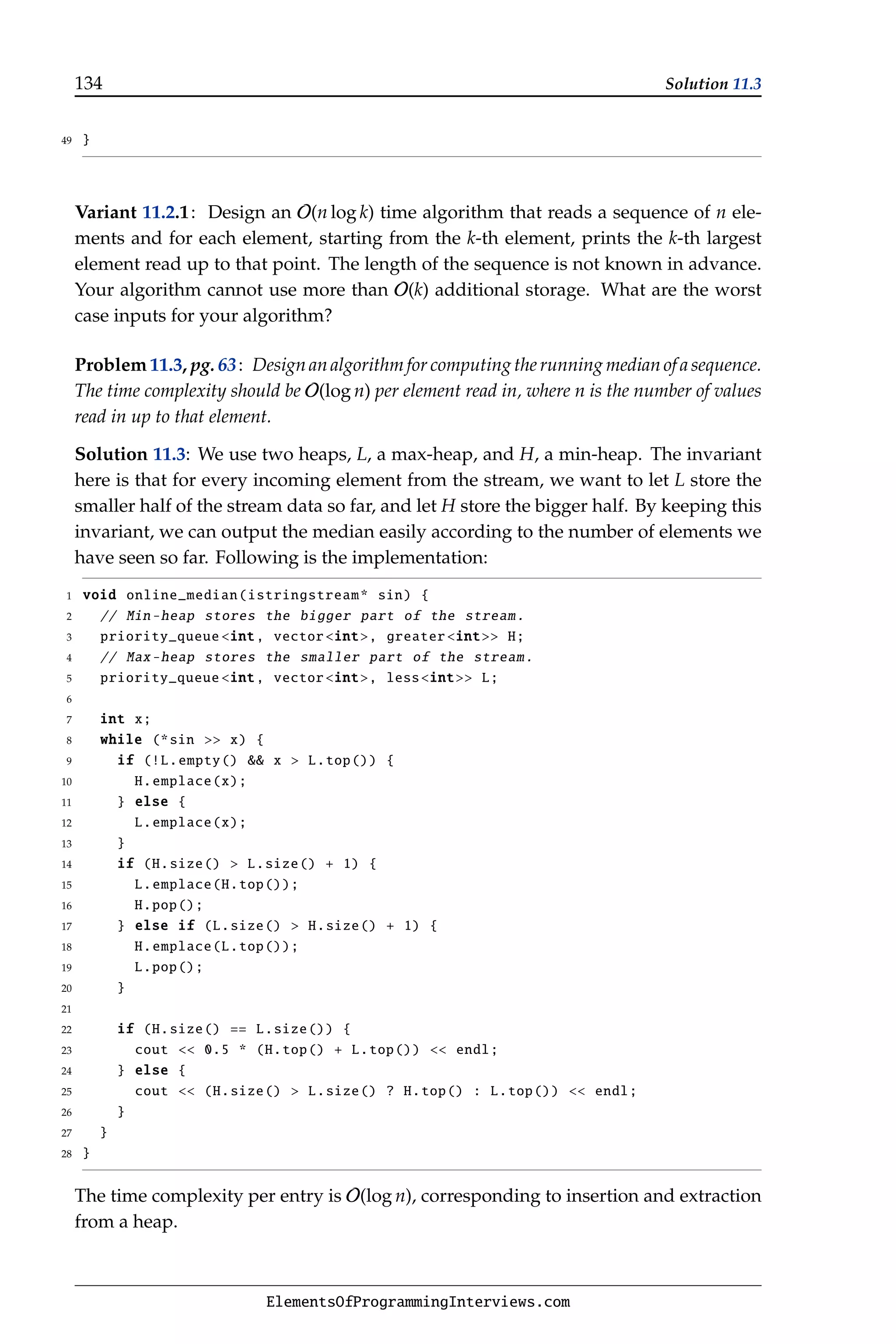
![Solution 12.2 135
Problem 12.1, pg. 66: Write a method that takes a sorted array A and a key k and returns the
index of the first occurrence of k in A. Return −1 if k does not appear in A. For example, when
applied to the array in Figure 12.1 on Page 66 your algorithm should return 3 if k = 108; if
k = 285, your algorithm should return 6.
Solution 12.1: The key idea is to search for k. However, even if we find k, after
recording this we continue the search on the left subarray.
1 int search_first(const vectorint A, int k) {
2 int l = 0, r = A.size() - 1, res = -1;
3 while (l = r) {
4 int m = l + ((r - l) 1);
5 if (A[m] k) {
6 r = m - 1;
7 } else if (A[m] == k) {
8 // Record the solution and keep searching the left part.
9 res = m, r = m - 1;
10 } else { // A[m] k
11 l = m + 1;
12 }
13 }
14 return res;
15 }
The complexity bound is still O(log n)—this is because each iteration reduces the size
of the subarray being searched by half.
-Variant 12.1.1: Let A be an unsorted array of n integers, with A[0] ≥ A[1] and
A[n − 2] ≤ A[n − 1]. Call an index i a local minimum if A[i] is less than or equal to its
neighbors. How would you efficiently find a local minimum, if one exists?
-Variant 12.1.2: A sequence is said to be ascending if each element is greater than
or equal to its predecessor; a descending sequence is one in which each element is
less than or equal to its predecessor. A sequence is strictly ascending if each element
is greater than its predecessor. Suppose it is known that an array A consists of an
ascending sequence followed by a descending sequence. Design an algorithm for
finding the maximum element in A. Solve the same problem when A consists of a
strictly ascending sequence, followed by a descending sequence.
Problem 12.2, pg. 66: Design an O(log n) algorithm for finding the position of the smallest
element in a cyclically sorted array. Assume all elements are distinct. For example, for the
array in Figure 12.2 on Page 67, your algorithm should return 4.
Solution 12.2: We make use of the decrease and conquer principle. Specifically, we
maintain an interval of candidate indices, and iteratively eliminate a constant fraction
of the indices in this interval. Let I = [lI, rI] be the set of indices being considered, and
mI be the midpoint of I, i.e., lI + b
rI−lI
2
c. If A[mI] A[rI] then [lI, mI] cannot contain the
index of the minimum element. Therefore, we can restrict the search to [mI + 1, rI]. If
ElementsOfProgrammingInterviews.com](https://image.slidesharecdn.com/elementsofprogramminginterviews-220623105328-e235fecd/75/Elements-of-Programming-Interviews-pdf-141-2048.jpg)
![136 Solution 12.3
A[mI] A[rI] we restrict our attention to [lI, mI]. We start with I = [0, n − 1], and end
when the interval has one element.
1 int search_smallest(const vectorint A) {
2 int l = 0, r = A.size() - 1;
3 while (l r) {
4 int m = l + ((r - l) 1);
5 if (A[m] A[r]) {
6 l = m + 1;
7 } else { // A[m] = A[r].
8 r = m;
9 }
10 }
11 return l;
12 }
The time complexity is the same as that of binary search, namely O(log n).
Note that this problem cannot be solved in less than linear time when elements
may be repeated. For example, if A consists of n−1 1s and a single 0, that 0 cannot be
detected in the worst case without inspecting every element. Following is the code
for the scenario when elements may be repeated:
1 int search_smallest(const vectorint A) {
2 return search_smallest_helper(A, 0, A.size() - 1);
3 }
4
5 int search_smallest_helper(const vectorint A, int l, int r) {
6 if (l == r) {
7 return l;
8 }
9
10 int m = l + ((r - l) 1);
11 if (A[m] A[r]) {
12 return search_smallest_helper(A, m + 1, r);
13 } else if (A[m] A[r]) {
14 return search_smallest_helper(A, l, m);
15 } else { // A[m] == A[r].
16 // Smallest element must exist in either left or right side.
17 int l_res = search_smallest_helper(A, l, m);
18 int r_res = search_smallest_helper(A, m + 1, r);
19 return A[r_res] A[l_res] ? r_res : l_res;
20 }
21 }
Variant 12.2.1: Design an O(log n) algorithm for finding the position of an element
k in a cyclically sorted array.
Problem 12.3, pg. 67: You are given two sorted arrays A and B of lengths m and n,
respectively, and a positive integer k ∈ [1, m + n]. Design an algorithm that runs in O(log k)
time for computing the k-th smallest element in array formed by merging A and B. Array
elements may be duplicated within and between A and B.
ElementsOfProgrammingInterviews.com](https://image.slidesharecdn.com/elementsofprogramminginterviews-220623105328-e235fecd/75/Elements-of-Programming-Interviews-pdf-142-2048.jpg)
![Solution 12.3 137
Solution 12.3: Suppose the first k elements of the union of A and B consist of the first
x elements of A and the first k − x elements of B. We’ll use binary search to determine
x.
Specifically, we will maintain an interval [b, t] that contains x, and use binary
search to iteratively half the size of the interval. Perform the iteration while b t.
At each iteration set x = b + bt−b
2
c. If A[x] B[(k − x) − 1], then A[x] must be in
the first k elements of the union, so we update b to x + 1 and continue. Similarly, if
A[x−1] B[k−x], then A[x−1] cannot be in the first k elements, so we can update t to
x − 1. Otherwise, we must have B[(k − x) − 1] ≤ A[x] and A[x − 1] ≤ B[k − x], in which
case the result is the larger of A[x − 1] and B[(k − x) − 1], since the first x elements of
A and the first k − x elements of B when sorted end in A[x − 1] or B[(k − x) − 1].
If the iteration ends without returning, it must be that b = t. Clearly, x = b = t. We
simply return the larger of A[x − 1] and B[(k − x) − 1]. (If A[x − 1] = B[(k − x) − 1], we
arbitrarily return either.)
The initial values for b and t need to be chosen carefully. Naïvely setting b = 0, t = k
does not work, since this choice may lead to array indices in the search lying outside
the range of valid indices. The indexing constraints for A and B can be resolved by
initializing b to max(0, k − n) and t to min(m, k).
1 int find_kth_in_two_sorted_arrays(const vectorint A, const vectorint B,
2 int k) {
3 // Lower bound of elements we will choose in A.
4 int b = max(0, static_cast int(k - B.size()));
5 // Upper bound of elements we will choose in A.
6 int t = min(static_cast int(A.size()), k);
7
8 while (b t) {
9 int x = b + ((t - b) 1);
10 int A_x_1 = (x = 0 ? numeric_limits int::min() : A[x - 1]);
11 int A_x = (x = A.size() ? numeric_limits int::max() : A[x]);
12 int B_k_x_1 = (k - x = 0 ? numeric_limits int::min() : B[k - x - 1]);
13 int B_k_x = (k - x = B.size() ? numeric_limits int::max() : B[k - x]);
14
15 if (A_x B_k_x_1) {
16 b = x + 1;
17 } else if (A_x_1 B_k_x) {
18 t = x - 1;
19 } else {
20 // B[k - x - 1] = A[x] A[x - 1] B[k - x].
21 return max(A_x_1, B_k_x_1);
22 }
23 }
24
25 int A_b_1 = b = 0 ? numeric_limits int::min() : A[b - 1];
26 int B_k_b_1 = k - b - 1 0 ? numeric_limits int::min() : B[k - b - 1];
27 return max(A_b_1, B_k_b_1);
28 }
Since in each iteration we halve the length of [b, t] the time complexity is O(log n).
ElementsOfProgrammingInterviews.com](https://image.slidesharecdn.com/elementsofprogramminginterviews-220623105328-e235fecd/75/Elements-of-Programming-Interviews-pdf-143-2048.jpg)
![138 Solution 13.1
Problem 12.4, pg. 67: Suppose you were given a file containing roughly one billion In-
ternet Protocol (IP) addresses, each of which is a 32-bit unsigned integer. How would you
programmatically find an IP address that is not in the file? Assume you have unlimited drive
space but only two megabytes of RAM at your disposal.
Solution 12.4: In the first step, we build an array of 216
32-bit unsigned integers that
is initialized to 0 and for every IP address in the file, we take its 16 MSBs to index
into this array and increment the count of that number. Since the file contains fewer
than 232
numbers, there must be one entry in the array that is less than 216
. This tells
us that there is at least one IP address which has those upper bits and is not in the
file. In the second pass, we can focus only on the addresses that match this criterion
and use a bit array of size 216
to identify one of the missing numbers.
1 int find_missing_element(ifstream* ifs) {
2 vectorsize_t counter(1 16, 0);
3 unsigned int x;
4 while (*ifs x) {
5 ++counter[x 16];
6 }
7
8 for (int i = 0; i counter.size(); ++i) {
9 // Find one bucket contains less than (1 16) elements.
10 if (counter[i] (1 16)) {
11 bitset (1 16) bit_vec;
12 ifs-clear();
13 ifs-seekg(0, ios::beg);
14 while (*ifs x) {
15 if (i == (x 16)) {
16 bit_vec.set(((1 16) - 1) x); // gets the lower 16 bits of x.
17 }
18 }
19 ifs-close();
20
21 for (int j = 0; j (1 16); ++j) {
22 if (bit_vec.test(j) == 0) {
23 return (i 16) | j;
24 }
25 }
26 }
27 }
28 }
Problem 13.1, pg. 69: Write a function that takes as input a dictionary of English words,
and returns a partition of the dictionary into subsets of words that are all anagrams of each
other.
Solution 13.1: Given a string s, let sort(s) be the string consisting of the characters in
s rearranged so that they appear in sorted order. Observe that x and y are anagrams
iff sort(x) = sort(y). For example, sort(“logarithmic”) and sort(“algorithmic”) are
both “acghiilmort”. Therefore, anagrams can be identified by adding sort(s) for each
ElementsOfProgrammingInterviews.com](https://image.slidesharecdn.com/elementsofprogramminginterviews-220623105328-e235fecd/75/Elements-of-Programming-Interviews-pdf-144-2048.jpg)
![Solution 13.2 139
string s in the dictionary to a hash table. Specifically, we store the sorted strings as
keys. For each key, the value is an array of the corresponding strings.
1 void find_anagrams(const vectorstring dictionary) {
2 // Get the sorted string and then insert into hash table.
3 unordered_map string, vectorstring hash;
4 for (const string s : dictionary) {
5 string sorted_str(s);
6 // Use sorted string as the hash code.
7 sort(sorted_str.begin(), sorted_str.end());
8 hash[sorted_str].emplace_back(s);
9 }
10
11 for (const pairstring, vectorstring p : hash) {
12 // Multiple strings with the same hash code = anagrams.
13 if (p.second.size() = 2) {
14 // Output all strings.
15 for (const auto s : p.second) {
16 cout s ;
17 }
18 cout endl;
19 }
20 }
21 }
Let the maximum string length be m, and the total number of strings be n. The
computation consists of n calls to sort and n insertions into the hash table, followed
by an iteration over the keys and printing corresponding values. Sorting the keys has
time complexity O(nm log m); the insertion and printing has time complexity O(nm),
yielding an O(nm log m) time complexity overall. In principle, we can use counting
sort to reduce the time to sort to O(nm). For small strings (m ≤ 100) the initialization
overhead of counting sort is too high to see a benefit.
Problem 13.2, pg. 69: You are required to write a method which takes an anonymous letter
L and text from a magazine M. Your method is to return true iff L can be written using M,
i.e., if a letter appears k times in L, it must appear at least k times in M.
Solution 13.2: Assume the string encoding the magazine is as long as the string
encoding the letter. (If not, the answer is false.) We build a hash table HL for L,
where each key is a character in the letter and its value is the number of times it
appears in the letter. Consequently, we scan the magazine character-by-character.
When processing c, if c appears in HL, we reduce its frequency count by 1; we remove
it from HL when its count goes to zero. If HL becomes empty, we return true. If it is
nonempty when we get to the end of M, we return false.
1 bool anonymous_letter(const string L, const string M) {
2 unordered_map char, int hash;
3 // Insert all chars in L into a hash table.
4 for_each(L.begin(), L.end(), [hash](const char c) { ++hash[c]; });
5
6 // Check chars in M that could cover chars in a hash table.
7 for (const char c : M) {
ElementsOfProgrammingInterviews.com](https://image.slidesharecdn.com/elementsofprogramminginterviews-220623105328-e235fecd/75/Elements-of-Programming-Interviews-pdf-145-2048.jpg)
![140 Solution 13.3
8 auto it = hash.find(c);
9 if (it != hash.cend()) {
10 if (--it-second == 0) {
11 hash.erase(it);
12 if (hash.empty() == true) {
13 return true;
14 }
15 }
16 }
17 }
18 // No entry in hash means L can be covered by M.
19 return hash.empty();
20 }
In the worst case, the letter is not constructible or the last character of M is essentially
required. Therefore, the time complexity is O(nM) where nM is the length of M The
space complexity is O(cL), where cL is the number of distinct characters appearing L.
If the characters are coded in ASCII, we could do away with HL and use a 256 entry
integer array A, with A[i] being set to the number of times the character i appears in
the letter.
Problem 13.3, pg. 70: Let P be a set of n points in the plane. Each point has integer
coordinates. Design an efficient algorithm for computing a line that contains the maximum
number of points in P.
Solution 13.3: Every pair of distinct points defines a line. We can use a hash table
H to map lines to the set of points in P that lie on them. (Each corresponding set of
points itself could be stored using a hash table.)
There are n(n − 1)/2 pairs of points, and for each pair we have to do a lookup in
H, an insert into H if the defined line is not already in H, and two inserts into the
corresponding set of points. The hash table operations are O(1) time, leading to an
O(n2
) time bound for this part of the computation.
We finish by finding the line with the maximum number of points with a simple
iteration through the hash table searching for the line with the most points in its
corresponding set. There are at most n(n − 1)/2 lines, so the iteration takes O(n2
)
time, yielding an overall time bound of O(n2
).
The design of a hash function appropriate for lines is more challenging than it
may seem at first. The equation of line through (x1, y1) and (x2, y2) is
y =
y2 − y1
x2 − x1
x +
x2 y1 − x1 y2
x2 − x1
.
One idea would be to compute a hash code from the slope and the y-intercept of
this line as an ordered pair of doubles. Because of finite precision arithmetic, we may
have three points that are collinear map to distinct buckets. If the generated uniform
[0, 1] random number lies into [0.3, 0.6) we return the number 6.
A more robust hash function treats the slope and the y-intercept as rationals. A
rational is an ordered pair of integers: the numerator and the denominator. We need
ElementsOfProgrammingInterviews.com](https://image.slidesharecdn.com/elementsofprogramminginterviews-220623105328-e235fecd/75/Elements-of-Programming-Interviews-pdf-146-2048.jpg)

![142 Solution 14.1
50 hashint()(l.intercept.first) ^ hashint()(l.intercept.second);
51 }
52 };
53
54 Line find_line_with_most_points(const vectorPoint P) {
55 // Add all possible lines into hash table.
56 unordered_map Line, unordered_set Point, HashPoint , HashLine table;
57 for (int i = 0; i P.size(); ++i) {
58 for (int j = i + 1; j P.size(); ++j) {
59 Line l(P[i], P[j]);
60 table[l].emplace(P[i]), table[l].emplace(P[j]);
61 }
62 }
63
64 // Return the line with most points have passed.
65 return max_element(table.cbegin(),
66 table.cend(),
67 [](const pairLine, unordered_set Point, HashPoint a,
68 const pairLine, unordered_set Point, HashPoint b)
69 { return a.second.size() b.second.size(); })-first;
70 }
Problem 14.1, pg. 72: Given sorted arrays A and B of lengths n and m respectively, return
an array C containing elements common to A and B. The array C should be free of duplicates.
How would you perform this intersection if—(1.) n ≈ m and (2.) n m?
Solution 14.1: The brute-force algorithm is a “loop join”, i.e., traversing through all
the elements of one array and comparing them to the elements of the other array. This
has O(mn) time complexity, regardless of whether the arrays are sorted or unsorted:
1 vectorint intersect_arrs1(const vectorint A, const vectorint B) {
2 vectorint intersect;
3 for (int i = 0; i A.size(); ++i) {
4 if (i == 0 || A[i] != A[i - 1]) {
5 for (int j = 0; j B.size(); ++j) {
6 if (A[i] == B[j]) {
7 intersect.emplace_back(A[i]);
8 break;
9 }
10 }
11 }
12 }
13 return intersect;
14 }
However, since both the arrays are sorted, we can make some optimizations. First,
we can scan array A and use binary search in array B, find whether the element is
present in B.
1 vectorint intersect_arrs2(const vectorint A, const vectorint B) {
2 vectorint intersect;
3 for (int i = 0; i A.size(); ++i) {
4 if ((i == 0 || A[i] != A[i - 1])
ElementsOfProgrammingInterviews.com](https://image.slidesharecdn.com/elementsofprogramminginterviews-220623105328-e235fecd/75/Elements-of-Programming-Interviews-pdf-148-2048.jpg)
![Solution 14.2 143
5 binary_search(B.cbegin(), B.cend(), A[i])) {
6 intersect.emplace_back(A[i]);
7 }
8 }
9 return intersect;
10 }
The time complexity is O(n log m).
We can further improve our run time by choosing the shorter array for the outer
loop since if n m then m log(n) n log(m).
This is the best solution if one set is much smaller than the other. However, it is
not the best when the array lengths are similar because we are not exploiting the fact
that both arrays are sorted. In this case, iterating in tandem through the elements of
each array in increasing order will work best as shown in this code.
1 vectorint intersect_arrs3(const vectorint A, const vectorint B) {
2 vectorint intersect;
3 int i = 0, j = 0;
4 while (i A.size() j B.size()) {
5 if (A[i] == B[j] (i == 0 || A[i] != A[i - 1])) {
6 intersect.emplace_back(A[i]);
7 ++i, ++j;
8 } else if (A[i] B[j]) {
9 ++i;
10 } else { // A[i] B[j].
11 ++j;
12 }
13 }
14 return intersect;
15 }
The run time for this algorithm is O(m + n).
Problem 14.2, pg. 72: Given a set of n events, how would you determine the maximum
number of events that take place concurrently?
Solution 14.2: Each event corresponds to an interval [b, e]; let b and e be the earliest
starting time and last ending time. Define the function c(t) for t ∈ [b, e] to be the
number of intervals containing t. Observe that c(τ) does not change if τ is not the
starting or ending time of an event.
This leads to an O(n2
) brute-force algorithm: for each interval, for each of its two
endpoints, determining how many intervals contain that point. The total number of
endpoints is 2n and each check takes O(n) time, since checking whether an interval
[bi, ei] contains a point t takes O(1) time (simply check if bi ≤ t ≤ ei).
We can improve the run time to O(n log n) by sorting the set of all the endpoints
in ascending order. If two endpoints have equal times, and one is a start time and
the other is an end time, the one corresponding to a start time comes first. (If both
are start or finish times, we break ties arbitrarily.)
We initialize a counter to 0, and iterate through the sorted sequence S from smallest
to largest. For each endpoint that is the start of an interval, we increment the counter
ElementsOfProgrammingInterviews.com](https://image.slidesharecdn.com/elementsofprogramminginterviews-220623105328-e235fecd/75/Elements-of-Programming-Interviews-pdf-149-2048.jpg)
![144 Solution 14.3
by 1, and for each endpoint that is the end of an interval, we decrement the counter by
1. The maximum value attained by the counter is maximum number of overlapping
intervals.
1 struct Interval {
2 int start, finish;
3 };
4
5 struct Endpoint {
6 bool operator (const Endpoint e) const {
7 return time != e.time ? time e.time : (isStart !e.isStart);
8 }
9
10 int time;
11 bool isStart;
12 };
13
14 int find_max_concurrent_events(const vectorInterval A) {
15 // Build the endpoint array.
16 vectorEndpoint E;
17 for (const Interval i : A) {
18 E.emplace_back(Endpoint{i.start, true});
19 E.emplace_back(Endpoint{i.finish, false});
20 }
21 // Sort the endpoint array according to the time.
22 sort(E.begin(), E.end());
23
24 // Find the maximum number of events overlapped.
25 int max_count = 0, count = 0;
26 for (const Endpoint e : E) {
27 if (e.isStart) {
28 max_count = max(++count, max_count);
29 } else {
30 --count;
31 }
32 }
33 return max_count;
34 }
Sorting the endpoint array takes O(n log n) time; iterating through the sorted array
takes O(n) time, yielding an O(n log n) time complexity. The space complexity is O(1).
-Variant 14.2.1: Users 1, 2, . . . , n share an Internet connection. User i uses bi band-
width from time si to fi, inclusive. What is the peak bandwidth usage?
Problem 14.3, pg. 73: Write a function which takes as input an array A of disjoint closed
intervals with integer endpoints, sorted by increasing order of left endpoint, and an interval
I, and returns the union of I with the intervals in A, expressed as a union of disjoint intervals.
Solution 14.3: Let I = [x, y]. There are two possibilities—A has an interval that has
a nonempty intersection with I, or it does not. If it does not contain an interval
intersecting I, we simply add I in the appropriate place.
ElementsOfProgrammingInterviews.com](https://image.slidesharecdn.com/elementsofprogramminginterviews-220623105328-e235fecd/75/Elements-of-Programming-Interviews-pdf-150-2048.jpg)
![Solution 15.1 145
If A does contain an interval with a nonempty intersection with I, we iterate
through A until we encounter the first such interval, call it I0
. As a general fact, given
any two intervals [a, b] and [a0
, b0
] that intersect, their union is [min(a, a0
), max(b, b0
)].
If I0
∪ I = I0
, there there is nothing to do, we can return A. Otherwise, we compute
w = I0
∪ I. Now we keep testing subsequent intervals for intersection with w. If
an interval J overlaps with w we update w to the union of J with w. As soon as an
interval is disjoint from w, we add w and the remaining intervals to the result and
return.
1 struct Interval {
2 int left, right;
3 };
4
5 vectorInterval insert_interval(const vectorInterval intervals ,
6 Interval new_interval) {
7 size_t i = 0;
8 vectorInterval res;
9 // Insert intervals appeared before new_interval.
10 while (i intervals.size() new_interval.left intervals[i].right) {
11 res.emplace_back(intervals[i++]);
12 }
13
14 // Merges intervals that overlap with new_interval.
15 while (i intervals.size() new_interval.right = intervals[i].left) {
16 new_interval = {min(new_interval.left, intervals[i].left),
17 max(new_interval.right, intervals[i].right)};
18 ++i;
19 }
20 res.emplace_back(new_interval);
21
22 // Insert intervals appearing after new_interval.
23 res.insert(res.end(), intervals.begin() + i, intervals.end());
24 return res;
25 }
Since the program spends O(1) time per entry, its time complexity is O(n).
Problem 15.1, pg. 74: Write a function that takes as input the root of a binary tree whose
nodes have a key field, and returns true iff the tree satisfies the BST property.
Solution 15.1: Several solutions exist, which differ in terms of their space and time
complexity, and the effort needed to code them.
The simplest is to start with the root r, and compute the maximum key r.left.max
stored in the root’s left subtree, and the minimum key r.right.min in the root’s right
subtree. Then we check that the key at the root is greater than or equal to r.right.min
and less than or equal to r.left.max. If these checks pass, we continue checking the
root’s left and right subtree recursively.
Computing the minimum key in a binary tree is straightforward: we compare the
key stored at the root with the minimum key stored in its left subtree and with the
minimum key stored in its right subtree. The maximum key is computed similarly.
ElementsOfProgrammingInterviews.com](https://image.slidesharecdn.com/elementsofprogramminginterviews-220623105328-e235fecd/75/Elements-of-Programming-Interviews-pdf-151-2048.jpg)
![146 Solution 15.1
(Note that the minimum may be in either subtree, since the tree may not satisfy the
BST property.)
The problem with this approach is that it will repeatedly traverse subtrees. In a
worst case, when the tree is BST and each node’s left child is empty, its complexity
is O(n2
), where n is the number of nodes. The complexity can be improved to O(n)
by caching the largest and smallest keys at each node; this requires O(n) additional
storage.
We now present two approaches which have O(n) time complexity and O(h)
additional space complexity.
The first, more straightforward approach, is to check constraints on the values for
each subtree. The initial constraint comes from the root. Each node in its left (right)
child must have a value less than or equal (greater than or equal) to the value at the
root. This idea generalizes: if all nodes in a tree rooted at t must have values in the
range [l, u], and the value at t is w ∈ [l, u], then all values in the left subtree of t must
be in the range [l, w], and all values stored in the right subtree of t must be in the
range [w, u]. The code below uses this approach.
1 bool is_BST(const unique_ptr BinaryTreeNode int r) {
2 return is_BST_helper(r,
3 numeric_limits int::min(),
4 numeric_limits int::max());
5 }
6
7 bool is_BST_helper(const unique_ptr BinaryTreeNode int r,
8 int lower, int upper) {
9 if (!r) {
10 return true;
11 } else if (r-data lower || r-data upper) {
12 return false;
13 }
14
15 return is_BST_helper(r-left, lower, r-data)
16 is_BST_helper(r-right, r-data, upper);
17 }
The second approach is to perform an inorder traversal, and record the value
stored at the last visited node. Each time a new node is visited, its value is compared
with the value of the previous visited node; if at any step, the value at the previously
visited node is greater than the node currently being visited, we have a violation of
the BST property. In principle, this approach can use the existence of an O(1) space
complexity inorder traversal to further reduce the space complexity.
1 bool is_BST(const unique_ptr BinaryTreeNode int root) {
2 auto* n = root.get();
3 // Store the value of previous visited node.
4 int last = numeric_limits int::min();
5 bool res = true;
6
7 while (n) {
8 if (n-left.get()) {
9 // Find the predecessor of n.
ElementsOfProgrammingInterviews.com](https://image.slidesharecdn.com/elementsofprogramminginterviews-220623105328-e235fecd/75/Elements-of-Programming-Interviews-pdf-152-2048.jpg)
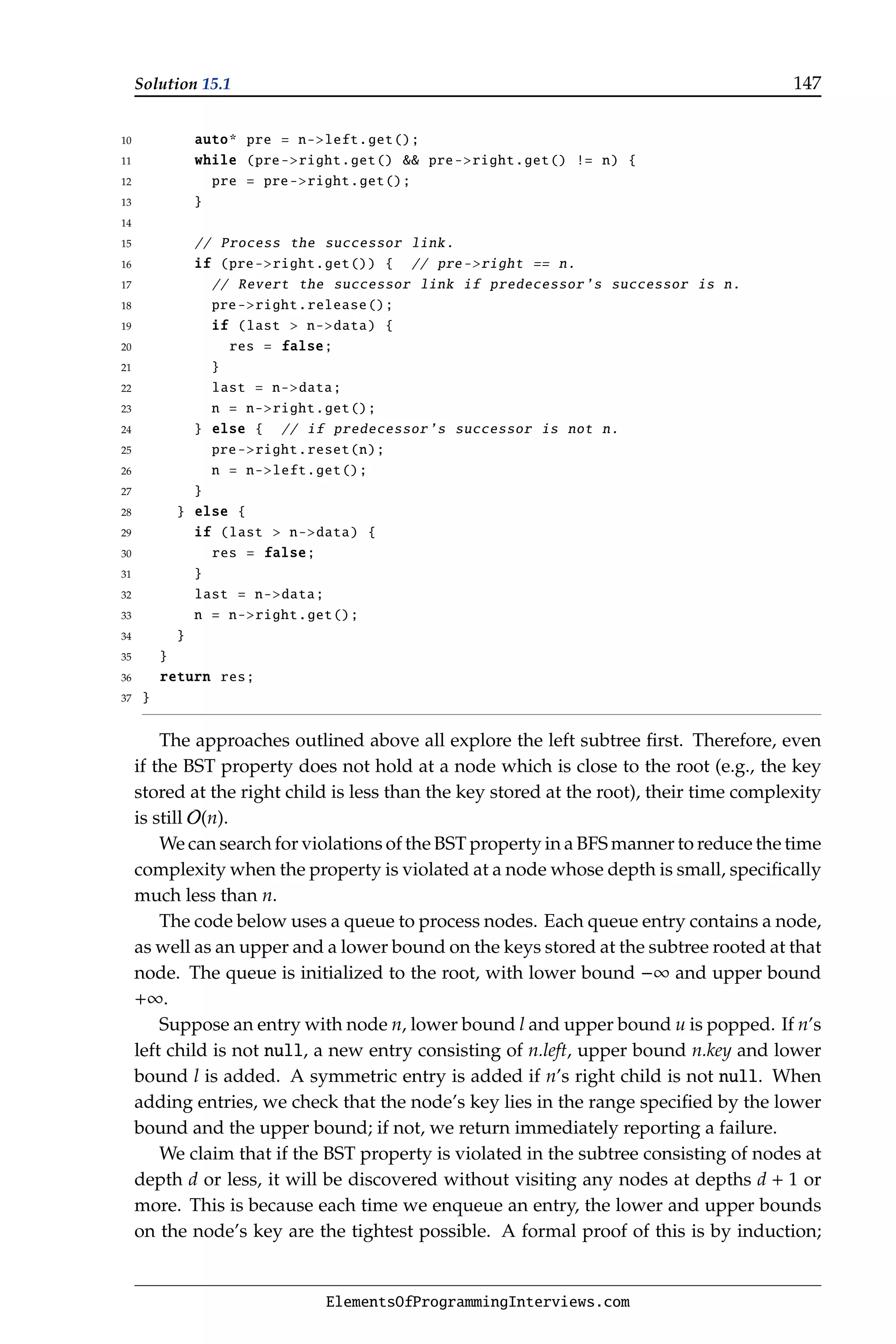
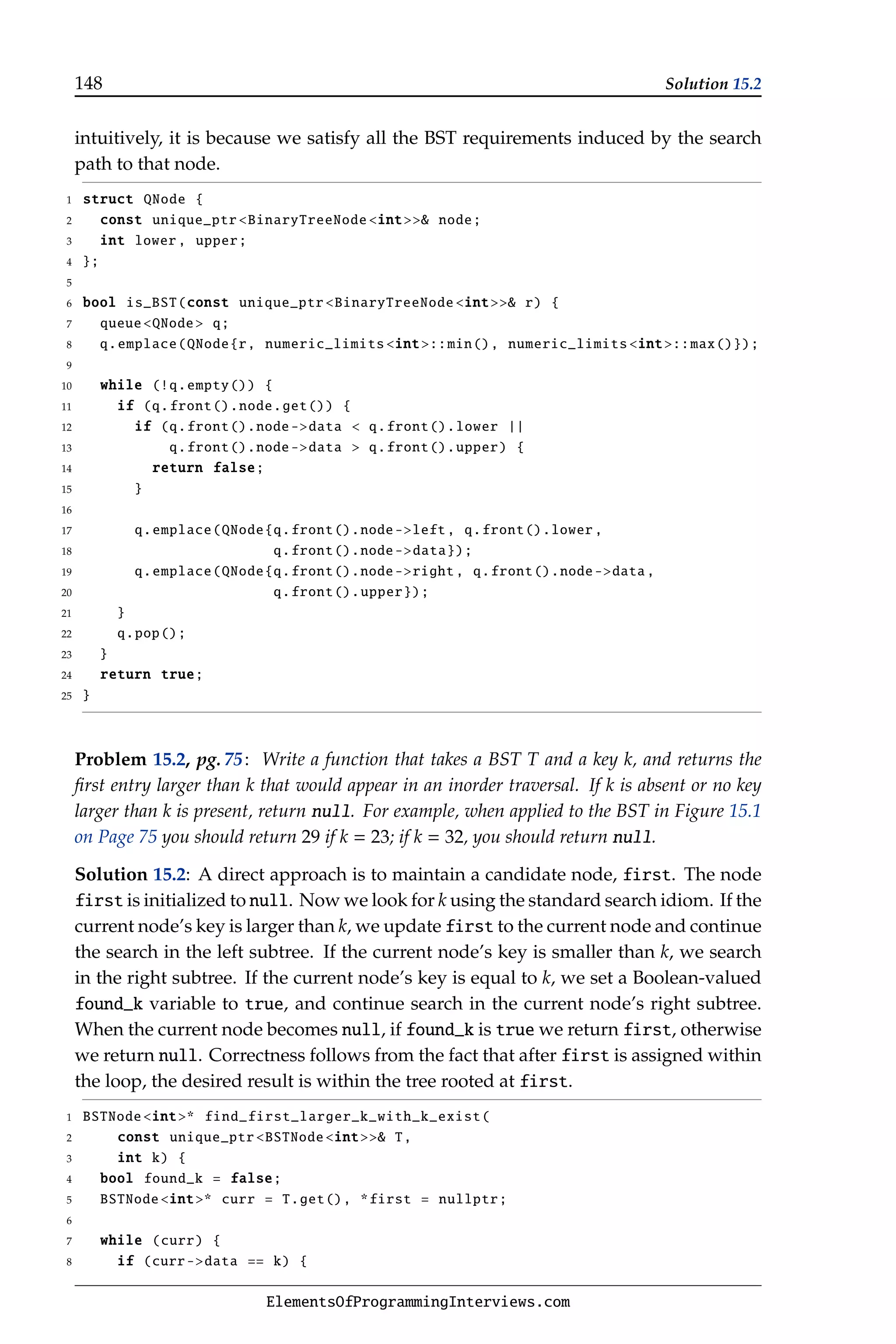
![Solution 16.1 149
9 found_k = true;
10 curr = curr-right.get();
11 } else if (curr-data k) {
12 first = curr;
13 curr = curr-left.get();
14 } else { // curr-data k.
15 curr = curr-right.get();
16 }
17 }
18 return found_k ? first : nullptr;
19 }
The time complexity is O(h), where h is the height of the tree. The space complexity
is O(1).
Problem 15.3, pg. 75: How would you build a BST of minimum possible height from a
sorted array A?
Solution 15.3: Intuitively, we want the subtrees to be as balanced as possible. One
way of achieving this is to make the element at entry bn
2
c the root, and recursively
compute minimum height BSTs for the subarrays A[0 : bn
2
c − 1] and A[bn
2
c + 1 : n − 1].
1 BSTNode int* build_BST_from_sorted_array(const vectorint A) {
2 return build_BST_from_sorted_array_helper(A, 0, A.size());
3 }
4
5 // Build BST based on subarray A[start : end - 1].
6 BSTNode int* build_BST_from_sorted_array_helper(const vectorint A,
7 size_t start, size_t end) {
8 if (start end) {
9 size_t mid = start + ((end - start) 1);
10 return new BSTNode int{
11 A[mid], unique_ptr BSTNode int(
12 build_BST_from_sorted_array_helper(A, start, mid)),
13 unique_ptr BSTNode int(
14 build_BST_from_sorted_array_helper(A, mid + 1, end))};
15 }
16 return nullptr;
17 }
The time complexity T(n) satisfies the recurrence T(n) = 2T(n/2) + O(1), which solves
to T(n) = O(n). Another way of seeing this is that we spend make exactly n calls to
the recursive function and spend O(1) in each.
Problem 16.1, pg. 76: Exactly n rings on P1 need to be transferred to P2, possibly using P3
as an intermediate, subject to the stacking constraint. Write a function that prints a sequence
of operations that transfers all the rings from P1 to P2.
Solution 16.1: Number the n rings from 1 to n. Transfer these n rings from P1 to P2
as follows.
(1.) Recursively transfer n − 1 rings from P1 to P3 using P2.
(2.) Move the ring numbered n from P1 to P2.
ElementsOfProgrammingInterviews.com](https://image.slidesharecdn.com/elementsofprogramminginterviews-220623105328-e235fecd/75/Elements-of-Programming-Interviews-pdf-155-2048.jpg)
![150 Solution 16.1
(3.) Recursively transfer the n − 1 rings on P3 to P2, using P1.
This is illustrated in Figure 21.3. Code implementing this idea is given below.
P1 P2 P3
(a) Move all but the lowest disc from P1 to P3.
P1 P2 P3
(b) Move the lowest disc from P1 to P2.
P1 P2 P3
(c) Move P3 to P2 using P1.
P1 P2 P3
(d) Solved!
Figure 21.3: A recursive solution to the Towers of Hanoi for n = 6.
1 void move_tower_hanoi(int n) {
2 arraystackint, 3 pegs;
3 // Initialize pegs.
4 for (int i = n; i = 1; --i) {
5 pegs[0].push(i);
6 }
7
8 transfer(n, pegs, 0, 1, 2);
9 }
10
11 void transfer(int n, arraystackint, 3 pegs, int from, int to, int use) {
12 if (n 0) {
13 transfer(n - 1, pegs, from, use, to);
14 pegs[to].push(pegs[from].top());
15 pegs[from].pop();
16 cout Move from peg from to peg to endl;
17 transfer(n - 1, pegs, use, to, from);
18 }
19 }
The number of moves, T(n), satisfies the following recurrence: T(n) = T(n − 1) +
1 + T(n − 1), which solves to T(n) = 2n
− 1. One way to see this is to “unwrap” the
recurrence k time : T(n) = 2l
T(n − k) + 2k−1
+ 2k−2
+ · · · + 2 + 1. Printing a single move
takes O(1) time, implying an O(2n
) time complexity. (Note that if we were asked
instead to print the smallest number of moves, rather than the moves themselves,
we could simply return 2n
− 1.)
-Variant 16.1.1: Find the minimum number of operations subject to the constraint
that each operation must involve P3.
ElementsOfProgrammingInterviews.com](https://image.slidesharecdn.com/elementsofprogramminginterviews-220623105328-e235fecd/75/Elements-of-Programming-Interviews-pdf-156-2048.jpg)
![Solution 16.2 151
-Variant 16.1.2: Find the minimum number of operations subject to the constraint
that each transfer must be from P1 to P2, P2 to P3, or P3 to P1.
-Variant 16.1.3: Find the minimum number of operations subject to the constraint
that a ring can never be transferred directly from P1 to P2 (transfers from P2 to P1
are allowed).
-Variant 16.1.4: Find the minimum number of operations when the stacking con-
straint is relaxed to the following—the largest ring on a peg must be the lowest ring
on the peg. (The remaining rings on the peg can be in any order, e.g., it is fine to have
the second-largest ring above the third-largest ring.)
Variant 16.1.5: You have 2n disks of n different sizes, two of each size. You cannot
place a larger disk on a smaller disk, but can place a disk of equal size one on top of
the other. Compute the minimum number of moves to transfer the 2n disks from P1
to P2.
Variant 16.1.6: You have 2n disks which are colored black or white. You cannot
place a white disk directly on top of a black disk. Compute the minimum number of
moves to complete the transfer to transfer the 2n disks from P1 to P2.
Variant 16.1.7: Find the minimum number of operations if you have a fourth peg,
P4.
Problem 16.2, pg. 76: Implement a method that takes as input a set S of n distinct elements,
and prints the power set of S. Print the subsets one per line, with elements separated by
commas.
Solution 16.2: One way to solve this problem is realizing that for a given ordering of
the elements of S, there exists a one-to-one correspondence between the 2n
bit arrays
of length n and the set of all subsets of S—the 1s in the n-length bit array v indicate
the elements of S in the subset corresponding to v.
For example, if S = {g, l, e} and the elements are ordered g l e, the bit array
h0, 1, 1i denotes the subset {l, e}.
If n is less than or equal to the width of an integer on the architecture (or language)
we are working on, we can enumerate bit arrays by enumerating integers in [0, 2n
−1]
and examining the indices of bits set in these integers. These indices are determined
by first isolating the lowest set bit by computing y = x~(x − 1), which is described
on Page on Page 24 and then getting the index by computing lg y.
1 void generate_power_set(const vectorint S) {
2 for (int i = 0; i (1 S.size()); ++i) {
3 int x = i;
4 while (x) {
5 int tar = log2(x ~(x - 1));
6 cout S[tar];
ElementsOfProgrammingInterviews.com](https://image.slidesharecdn.com/elementsofprogramminginterviews-220623105328-e235fecd/75/Elements-of-Programming-Interviews-pdf-157-2048.jpg)
![152 Solution 16.2
7 if (x = x - 1) {
8 cout ’,’;
9 }
10 }
11 cout endl;
12 }
13 }
Since each set takes O(n) time to print, the time complexity is O(n2n
). In practice, it
would likely be faster to iterate through all the bits in x, one at a time.
Alternately, we can use recursion. The most natural recursive algorithm entails
recursively computing all subsets U of S − {x}, i.e., S without the element x (which
could be any element), and then adding x to each subset in U to create the set of
subsets V. (The base case is when S is empty, in which case we return {{}}.) The
subsets in U are distinct from those in V, and the final result is just U ∪ V, which we
can then print. The number of recursive calls for a set of n elements, T(n) satisfies
T(n) = 2T(n − 1), with T(0) = 1, which solves to T(n) = 2n
. Since each call takes time
O(n), the total time complexity is O(n2n
).
The problem with the approach just described is that it uses O(n2n
) space. The fact
that we only need to print the subsets, and not return them, suggests that a more space
optimal approach would be to compute the subsets incrementally. Conceptually, the
algorithm shown below passes two additional parameters, m and subset; the latter
indicates which of the first m elements of S must be part of the subsets begin created
from the remaining n − m elements. It iteratively prints subset, and then prints all
subsets of the remaining elements, with and without the (m + 1)-th element.
1 void generate_power_set(const vectorint S) {
2 vectorint subset;
3 generate_power_set_helper(S, 0, subset);
4 }
5
6 void generate_power_set_helper(const vectorint S, int m,
7 vectorint* subset) {
8 if (!subset-empty()) {
9 // Print the subset.
10 copy(subset-cbegin(), subset-cend() - 1,
11 ostream_iterator int(cout, ,));
12 cout subset-back();
13 }
14 cout endl;
15
16 for (int i = m; i S.size(); ++i) {
17 subset-emplace_back(S[i]);
18 generate_power_set_helper(S, i + 1, subset);
19 subset-pop_back();
20 }
21 }
The number of recursive calls, T(n) satisfies the recurrence T(n) = T(n − 1) + T(n −
2) + · · · + T(1) + T(0), which solves to T(n) = O(2n
). Since we spend O(n) time within a
ElementsOfProgrammingInterviews.com](https://image.slidesharecdn.com/elementsofprogramminginterviews-220623105328-e235fecd/75/Elements-of-Programming-Interviews-pdf-158-2048.jpg)
![Solution 16.3 153
call, the time complexity is O(n2n
). The space complexity is O(n) which comes from
the maximum stack depth as well as the maximum size of a subset.
Variant 16.2.1: Print all subsets of size k of {1, 2, 3, . . . , n}.
Problem 16.3, pg. 77: Implement a Sudoku solver. Your program should read an instance
of Sudoku from the command line. The command line argument is a sequence of 3-digit
strings, each encoding a row, a column, and a digit at that location.
Solution 16.3: We use a straight-forward application of the backtracking principle.
We traverse the 2D array entries one at a time. If the entry is empty, we try each
value for the entry, and see if the updated 2D array is still valid; if it is we recurse. If
all the entries have been filled, the search is successful.
In practice it is more efficient to see if a conflict results on adding a new entry
before adding it rather than adding it and seeing if a conflict is present. See the code
for details.
1 bool solve_Sudoku(vectorvectorint* A) {
2 if (!is_valid_Sudoku(*A)) {
3 cout Initial configuration violates constraints. endl;
4 return false;
5 }
6
7 if (solve_Sudoku_helper(0, 0, A)) {
8 for (int i = 0; i A-size(); ++i) {
9 copy((*A)[i].begin(), (*A)[i].end(), ostream_iterator int(cout, ));
10 cout endl;
11 }
12 return true;
13 } else {
14 cout No solution exists. endl;
15 return false;
16 }
17 }
18
19 bool solve_Sudoku_helper(int i, int j, vectorvectorint* A) {
20 if (i == A-size()) {
21 i = 0; // starts a new row.
22 if (++j == (*A)[i].size()) {
23 return true; // Entire matrix has been filled without conflict.
24 }
25 }
26
27 // Skips nonempty entries.
28 if ((*A)[i][j] != 0) {
29 return solve_Sudoku_helper(i + 1, j, A);
30 }
31
32 for (int val = 1; val = A-size(); ++val) {
33 // Note: practically , it’s substantially quicker to check if entry val
34 // conflicts with any of the constraints if we add it at (i,j) before
35 // adding it, rather than adding it and then calling is_valid_Sudoku.
ElementsOfProgrammingInterviews.com](https://image.slidesharecdn.com/elementsofprogramminginterviews-220623105328-e235fecd/75/Elements-of-Programming-Interviews-pdf-159-2048.jpg)
![154 Solution 16.3
36 // The reason is that we know we are starting with a valid configuration ,
37 // and the only entry which can cause a problem is entryval at (i,j).
38 if (valid_to_add(*A, i, j, val)) {
39 (*A)[i][j] = val;
40 if (solve_Sudoku_helper(i + 1, j, A)) {
41 return true;
42 }
43 }
44 }
45
46 (*A)[i][j] = 0; // undo assignment.
47 return false;
48 }
49
50 bool valid_to_add(const vectorvectorint A, int i, int j, int val) {
51 // Check row constraints.
52 for (int k = 0; k A.size(); ++k) {
53 if (val == A[k][j]) {
54 return false;
55 }
56 }
57
58 // Check column constraints.
59 for (int k = 0; k A.size(); ++k) {
60 if (val == A[i][k]) {
61 return false;
62 }
63 }
64
65 // Check region constraints.
66 int region_size = sqrt(A.size());
67 int I = i / region_size , J = j / region_size;
68 for (int a = 0; a region_size; ++a) {
69 for (int b = 0; b region_size; ++b) {
70 if (val == A[region_size * I + a][region_size * J + b]) {
71 return false;
72 }
73 }
74 }
75 return true;
76 }
Because the program is specialized to 9×9 grids, it does not make sense to speak of its
time complexity, since there is no notion of scaling with a size parameter. However,
since the problem of solving Sudoku generalized to n × n grids is NP-complete, it
should not be difficult to prove that the generalization of this algorithm to n×n grids
has exponential time complexity.
Variant 16.3.1: Compute a placement of eight queens on an 8 × 8 chessboard in
which no two queens attack each other.
ElementsOfProgrammingInterviews.com](https://image.slidesharecdn.com/elementsofprogramminginterviews-220623105328-e235fecd/75/Elements-of-Programming-Interviews-pdf-160-2048.jpg)
![Solution 17.1 155
Variant 16.3.2: Compute a placement of 32 knights, or 14 bishops, 16 kings or eight
rooks on an 8 × 8 chessboard in which no two pieces attack each other.
Variant 16.3.3: Compute the smallest number of queens that can be placed to attack
each uncovered square.
Problem 17.1, pg. 81: You have an aggregate score s and W which specifies the points that
can be scored in an individual play. How would you find the number of combinations of
plays that result in an aggregate score of s? How would you compute the number of distinct
sequences of individual plays that result in a score of s?
Solution 17.1: Let W = {w0, w1, . . . , wn−1} be the possible scores for individual plays.
Let X be the set {hx0, x1, . . . , xn−1i |
Pn−1
i=0 wixi = s}. We want to compute |X|. Observe
that x0 can take any value in [0,
j
s
w0
k
]. Therefore, we can partition X into subsets of
vectors of the form {hx0, x1, . . . , xn−1i}, where 0 ≤ x0 ≤ b s
w0
c. We can determine the
size of each of these subsets by solving the same problem in one fewer dimension—
specifically for each x0 we count the number of combinations in which s − x0w0 can
be achieved using plays {w1, w2, . . . , wn−1}. The base case corresponds to computing
the number of ways in which a score t ≤ s can be formed with the wn−1-score plays,
which is 1 or 0, depending on whether wn−1 evenly divides t.
The algorithm outlined above has exponential complexity. We can use DP to
reduce its complexity—for each t ≤ s and d ∈ [1, n − 1] we cache the number of
combinations of ways in which wd, . . . , wn−1 can be used to achieve t. By iterating
first over W and then over t, we can reuse space. This is the approach given below.
1 int count_combinations(int k, const vectorint score_ways) {
2 vectorint combinations(k + 1, 0);
3 combinations[0] = 1; // one way to reach 0.
4 for (const int score : score_ways) {
5 for (int j = score; j = k; ++j) {
6 combinations[j] += combinations[j - score];
7 }
8 }
9 return combinations[k];
10 }
It should be clear that the time complexity is O(sn) (two loops, one to s, the other to
n) and space complexity is O(s) (the combinations array).
We can compute the number of permutations of scores which lead to an aggregate
score of s using recursion. Suppose we know for all u v the number of permutations
of ways in which u can be achieved. We can achieve v points by first scoring v − wi
points followed by wi. Observe each of these is a distinct permutation. The recursion
can be converted to DP by caching the number of permutations yielding t for each
t s.
1 int count_permutations(int k, const vectorint score_ways) {
2 vectorint permutations(k + 1, 0);
3 permutations[0] = 1; // one way to reach 0.
4 for (int i = 0; i = k; ++i) {
ElementsOfProgrammingInterviews.com](https://image.slidesharecdn.com/elementsofprogramminginterviews-220623105328-e235fecd/75/Elements-of-Programming-Interviews-pdf-161-2048.jpg)
![156 Solution 17.2
5 for (const int score : score_ways) {
6 if (i = score) {
7 permutations[i] += permutations[i - score];
8 }
9 }
10 }
11 return permutations[k];
12 }
The time and space complexities are the same as those for computing the number of
combinations, i.e., O(sn) and O(s), respectively.
Variant 17.1.1: Suppose the final score is given in the form (s, s0
), i.e., Team 1 scored s
points and Team 2 scored s0
points. How would you compute the number of distinct
scoring sequences which result in this score? For example, if the final score is (6, 3)
then Team 1 scores 3, Team 2 scores 3, Team 1 scores 3 is a scoring sequence which
results in this score.
Variant 17.1.2: Suppose the final score is (s, s0
). How would you compute the
maximum number of times the team that lead could have changed? For example, if
s = 10 and s0
= 6, the lead could have changed 4 times: Team 1 scores 2, then Team 2
scores 3 (lead change), then Team 1 scores 2 (lead change), then Team 2 scores 3 (lead
change), then Team 1 scores 3 (lead change) followed by 3.
Problem 17.2, pg. 81: How many ways can you go from the top-left to the bottom-right in
an n × m 2D array? How would you count the number of ways in the presence of obstacles,
specified by an n × m Boolean 2D array B, where a true represents an obstacle.
Solution 17.2: This problem can be solved using a straightforward application of
DP: the number of ways to get to (i, j) is the number of ways to get to (i − 1, j) plus
the number of ways to get to (i, j − 1). (If i = 0 or j = 0, there is only one way to get to
(i, j).) The matrix storing the number of ways to get to (i, j) for the configuration in
Figure 17.2 on Page 81 is shown in Figure 21.4 on the next page. To fill in the i-th row
we do not need values from rows before i−1. Consequently, we do not need an n×m
2D array. Instead, we use two rows of storage, alternating between By symmetry,
the number of ways to get to (i, j) is the same as to get to (j, i), so we use the smaller
of m and n to be the number of columns (which is the number of entries in a row).
This leads to the following algorithm.
1 int number_of_ways(int n, int m) {
2 if (n m) {
3 swap(n, m);
4 }
5 vectorvectorint A(2, vectorint(m, 1));
6 for (int i = 1; i n; ++i) {
7 for (int j = 0; j m; ++j) {
8 A[i 1][j] = (i 1 ? 0 : A[(i - 1) 1][j]) +
9 (j 1 ? 0 : A[i 1][j - 1]);
10 }
ElementsOfProgrammingInterviews.com](https://image.slidesharecdn.com/elementsofprogramminginterviews-220623105328-e235fecd/75/Elements-of-Programming-Interviews-pdf-162-2048.jpg)
![Solution 17.2 157
11 }
12 return A[(n - 1) 1][m - 1];
13 }
The time complexity is O(mn), and the space complexity is O(min(m, n)).
1 1 1 1 1
1
1
1
1 2 3 4 5
5
4
3 6 10 15
15
10 20 35
35 70
Figure 21.4: The number of ways to get from (0, 0) to (i, j) for 0 ≤ i, j ≤ 4.
Another way of deriving the same answer is to use the fact that each path from
(0, 0) to (n − 1, m − 1) is a sequence of m − 1 horizontal steps and n − 1 vertical steps.
There are n+m−2
n−1
= n+m−2
m−1
=
(n+m−2)!
(n−1)!(m−1)!
such paths.
Our first solution generalizes trivially to obstacles: if there is an obstacle at (i, j)
there are zero ways of getting from (0, 0) to (i, j).
1 // Given the dimensions of A, n and m, and B, return the number of ways
2 // from A[0][0] to A[n - 1][m - 1] considering obstacles.
3 int number_of_ways_with_obstacles(int n, int m,
4 const vectordequebool B) {
5 vectorvectorint A(n, vectorint(m, 0));
6 if (B[0][0]) { // no way to start from (0, 0) if B[0][0] == true.
7 return 0;
8 } else {
9 A[0][0] = 1;
10 }
11 for (int i = 0; i n; ++i) {
12 for (int j = 0; j m; ++j) {
13 if (B[i][j] == 0) {
14 A[i][j] += (i 1 ? 0 : A[i - 1][j]) + (j 1 ? 0 : A[i][j - 1]);
15 }
16 }
17 }
18 return A.back().back();
19 }
The time complexity is O(nm).
Variant 17.2.1: A decimal number is a sequence of digits, i.e., a sequence over
{0, 1, 2, . . . , 9}. The sequence has to be of length 1 or more, and the first element in the
sequence cannot be 0. Call a decimal number D monotone if D[i] ≤ D[i+1], 0 ≤ i |D|.
Write a function which takes as input a positive integer k and computes the number
of decimal numbers of length k that are monotone.
ElementsOfProgrammingInterviews.com](https://image.slidesharecdn.com/elementsofprogramminginterviews-220623105328-e235fecd/75/Elements-of-Programming-Interviews-pdf-163-2048.jpg)
![158 Solution 17.4
Variant 17.2.2: Call a decimal number D, as defined above, strictly monotone if
D[i] D[i + 1], 0 ≤ i |D|. Write a function which takes as input a positive integer k
and computes the number of decimal numbers of length k that are strictly monotone.
Problem 17.3, pg. 82: Design an algorithm for the knapsack problem that selects a subset of
items that has maximum value and weighs at most w ounces. All items have integer weights
and values.
Solution 17.3: Let V[i, w] be the maximum value that can be packed with weight
less than or equal to w using the first i clocks. Then V[i, w] satisfies the following
recurrence:
V[i, w] =
(
max (V[i − 1, w], V[i − 1, w − wi] + vi) , if wi ≤ w;
V[i − 1, w], otherwise.
For i = 0 or w = 0, we set V[i, w] = 0. This DP procedure computes V[n, w] in
O(nw) time, and uses O(nw) space. The space complexity can be improved to O(w)
by using a one-dimensional array to store the current optimal result and rewriting
the next step result back to this array.
1 struct Item {
2 int weight, value;
3 };
4
5 int knapsack(int w, const vectorItem items) {
6 vectorint V(w + 1, 0);
7 for (int i = 0; i items.size(); ++i) {
8 for (int j = w; j = items[i].weight; --j) {
9 V[j] = max(V[j], V[j - items[i].weight] + items[i].value);
10 }
11 }
12 return V[w];
13 }
Variant 17.3.1: Solve the knapsack problem when the thief can take a fractional
amount of an item.
Problem 17.4, pg. 82: Given a dictionary, i.e., a set of strings, and a string s, design an
efficient algorithm that checks whether s is the concatenation of a sequence of dictionary
words. If such a concatenation exists, your algorithm should output it.
Solution 17.4: This is a straightforward DP problem. If the input string s has length
n, we build a table T of length n such that T[k] is a Boolean indicating whether the
substring s(0, k) can be decomposed into a sequence of valid words.
We can build a hash table of all the valid words to determine if a string is a valid
word. Then T[k] holds iff one of the following two conditions is true:
− Substring s(0, k) is a valid word.
− There exists a j ∈ [0, k − 1] such that T[j] is true and s(j + 1, k) is a valid word.
ElementsOfProgrammingInterviews.com](https://image.slidesharecdn.com/elementsofprogramminginterviews-220623105328-e235fecd/75/Elements-of-Programming-Interviews-pdf-164-2048.jpg)
![Solution 17.5 159
This tells us if we can break a given string into valid words, but does not yield
the words themselves. We can obtain the words with a little more book-keeping. In
table T, along with the Boolean value, we also store the length of the last word in the
string.
1 vectorstring word_breaking(const string s,
2 const unordered_set string dict) {
3 // T[i] is the length of the last string in the decomposition of s(0, i).
4 vectorint T(s.size(), 0);
5 for (int i = 0; i s.size(); ++i) {
6 // Set T[i] if s(0, i) is a valid word.
7 if (dict.find(s.substr(0, i + 1)) != dict.cend()) {
8 T[i] = i + 1;
9 }
10
11 // Set T[i] if T[j] != 0 and s(j + 1, i) is a valid word.
12 for (int j = 0; j i T[i] == 0; ++j) {
13 if (T[j] != 0 dict.find(s.substr(j + 1, i - j)) != dict.cend()) {
14 T[i] = i - j;
15 }
16 }
17 }
18
19 vectorstring ret;
20 // s can be assembled by valid words.
21 if (T.back()) {
22 int idx = s.size() - 1;
23 while (idx = 0) {
24 ret.emplace_back(s.substr(idx - T[idx] + 1, T[idx]));
25 idx -= T[idx];
26 }
27 reverse(ret.begin(), ret.end());
28 }
29 return ret;
30 }
For each k we check for each j k whether s(j + 1, k) is a valid word, and each such
check requires O(k − j) time. This implies the time complexity is O(n3
). Let W be the
length of the longest valid word. By changing j to range from k − W to k − 1, we can
improve the time complexity to O(n2
W). Note that we are assuming the dictionary
is specified as a hash table.
If we want all possible decompositions, we can store all possible values of j that
gives us a correct break with each position. However, the number of possible decom-
positions can be exponential here. This is exemplified by the string “itsitsitsits. . . ”.
Variant 17.4.1: Devise an O(nW) algorithm for word breaking.
Problem 17.5, pg. 82: Given an array A of n numbers, find a longest subsequence
hi0, . . . , ik−1i such that ij ij+1 and A[ij] ≤ A[ij+1] for any j ∈ [0, k − 2].
Solution 17.5: We present two solutions, an O(n2
), and an O(n log n) one.
ElementsOfProgrammingInterviews.com](https://image.slidesharecdn.com/elementsofprogramminginterviews-220623105328-e235fecd/75/Elements-of-Programming-Interviews-pdf-165-2048.jpg)
![160 Solution 17.5
We first describe the O(n2
) solution, which is a straightforward application of
dynamicprogramming. Letsi bethelengthofthelongestnondecreasingsubsequence
of A that ends at A[i] (specifically, A[i] is included in this subsequence). Then we can
write the following recurrence:
si = max
j∈[0,i−1]
sj + 1, if A[j] ≤ A[i];
1, otherwise.
!
We use this recurrence to fill up a table for si. The time complexity of this algorithm
is O(n2
). If we want the sequence as well, for each i, in addition to storing the length
of the sequence, we store the index of the last element of sequence that we extended
to get the current sequence. Here is an implementation of this algorithm:
1 vectorint longest_nondecreasing_subsequence(const vectorint A) {
2 // Empty array.
3 if (A.empty() == true) {
4 return A;
5 }
6
7 vectorint longest_length(A.size(), 1), previous_index(A.size(), -1);
8 int max_length_idx = 0;
9 for (int i = 1; i A.size(); ++i) {
10 for (int j = 0; j i; ++j) {
11 if (A[i] = A[j] longest_length[j] + 1 longest_length[i]) {
12 longest_length[i] = longest_length[j] + 1;
13 previous_index[i] = j;
14 }
15 }
16 // Record the index where longest subsequence ends.
17 if (longest_length[i] longest_length[max_length_idx]) {
18 max_length_idx = i;
19 }
20 }
21
22 // Build the longest nondecreasing subsequence.
23 int max_length = longest_length[max_length_idx];
24 vectorint ret(max_length);
25 while (max_length 0) {
26 ret[--max_length] = A[max_length_idx];
27 max_length_idx = previous_index[max_length_idx];
28 }
29 return ret;
30 }
We now describe a subtler algorithm that has O(n log n) complexity. It is not
based on dynamic programming—it is a greedy algorithm and uses binary search.
Let Mi,j be the smallest possible tail value for any nondecreasing subsequence of
length j using array elements A[0], A[1], . . . , A[i]. Note that for any i, we must have
Mi,1 ≤ Mi,2 ≤ · · · ≤ Mi,j.
We process A’s elements iteratively. When processing A[i + 1], we look for the
largest j such that Mi,j ≤ A[i+1]. First, assume such a j exists. Then we can construct
ElementsOfProgrammingInterviews.com](https://image.slidesharecdn.com/elementsofprogramminginterviews-220623105328-e235fecd/75/Elements-of-Programming-Interviews-pdf-166-2048.jpg)
![Solution 18.1 161
a j + 1 length subsequence that ends at A[i + 1]. If no length j + 1 nondecreasing
subsequence exists in A[0], A[1], . . . , A[i], then Mi+1,j+1 must be A[i + 1], otherwise it
remains equal to Mi,j+1. Furthermore, Mi+1,j0 remains unchanged for all j0
≤ j.
Now suppose there does not exist j such that Mi,j ≤ A[i + 1]. This can only be true
if A[i + 1] is the unique smallest element in A[0 : i + 1]. Therefore, we set Mi+1,1 to
A[i + 1].
Therefore, processing A[i + 1] entails a binary search for j and then an update to
Mi+1,j+1 if possible, leading to an O(n log n) time complexity.
Code implementing this procedure is given below; the appropriate entries from
M are maintained in the tail_values vector.
1 int longest_nondecreasing_subsequence(const vectorint A) {
2 vectorint tail_values;
3 for (const int a : A) {
4 auto it = upper_bound(tail_values.begin(), tail_values.end(), a);
5 if (it == tail_values.end()) {
6 tail_values.emplace_back(a);
7 } else {
8 *it = a;
9 }
10 }
11 return tail_values.size();
12 }
-Variant 17.5.1: Define a sequence of numbers ha0, a1, . . . , an−1i to be alternating if ai
ai+1 for even i and ai ai+1 for odd i. Given an array of numbers A of length n, find a
longest subsequence hi0, . . . , ik−1i such that hA[i0], A[i1], . . . , A[ik−1]i is alternating.
-Variant 17.5.2: Define a sequence of numbers ha0, a1, . . . , an−1i to be weakly alternat-
ing if no three consecutive terms in the sequence are increasing or decreasing. Given
an array of numbers A of length n, find a longest subsequence hi0, . . . , ik−1i such that
hA[i0], A[i1], . . . , A[ik−1]i is weakly alternating.
-Variant 17.5.3: Define a sequence of numbers ha0, a1, . . . , an−1i to be convex if ai
ai−1+ai+1
2
, for 1 ≤ i ≤ n − 2. Given an array of numbers A of length n, find a longest
subsequence hi0, . . . , ik−1i such that hA[i0], A[i1], . . . , A[ik−1]i is convex.
-Variant 17.5.4: Define a sequence of numbers ha0, a1, . . . , an−1i to be bitonic if there
exists k such that ai ai+1, for 0 ≤ i k and ai ai+1, for k ≤ i n − 1. Given an
array of numbers A of length n, find a longest subsequence hi0, . . . , ik−1i such that
hA[i0], A[i1], . . . , A[ik−1]i is bitonic.
-Variant 17.5.5: Define a sequence of points in the plane to be ascending if each point
is above and to the right of the previous point. How would you find a maximum
ascending subset of a set of points in the plane?
ElementsOfProgrammingInterviews.com](https://image.slidesharecdn.com/elementsofprogramminginterviews-220623105328-e235fecd/75/Elements-of-Programming-Interviews-pdf-167-2048.jpg)
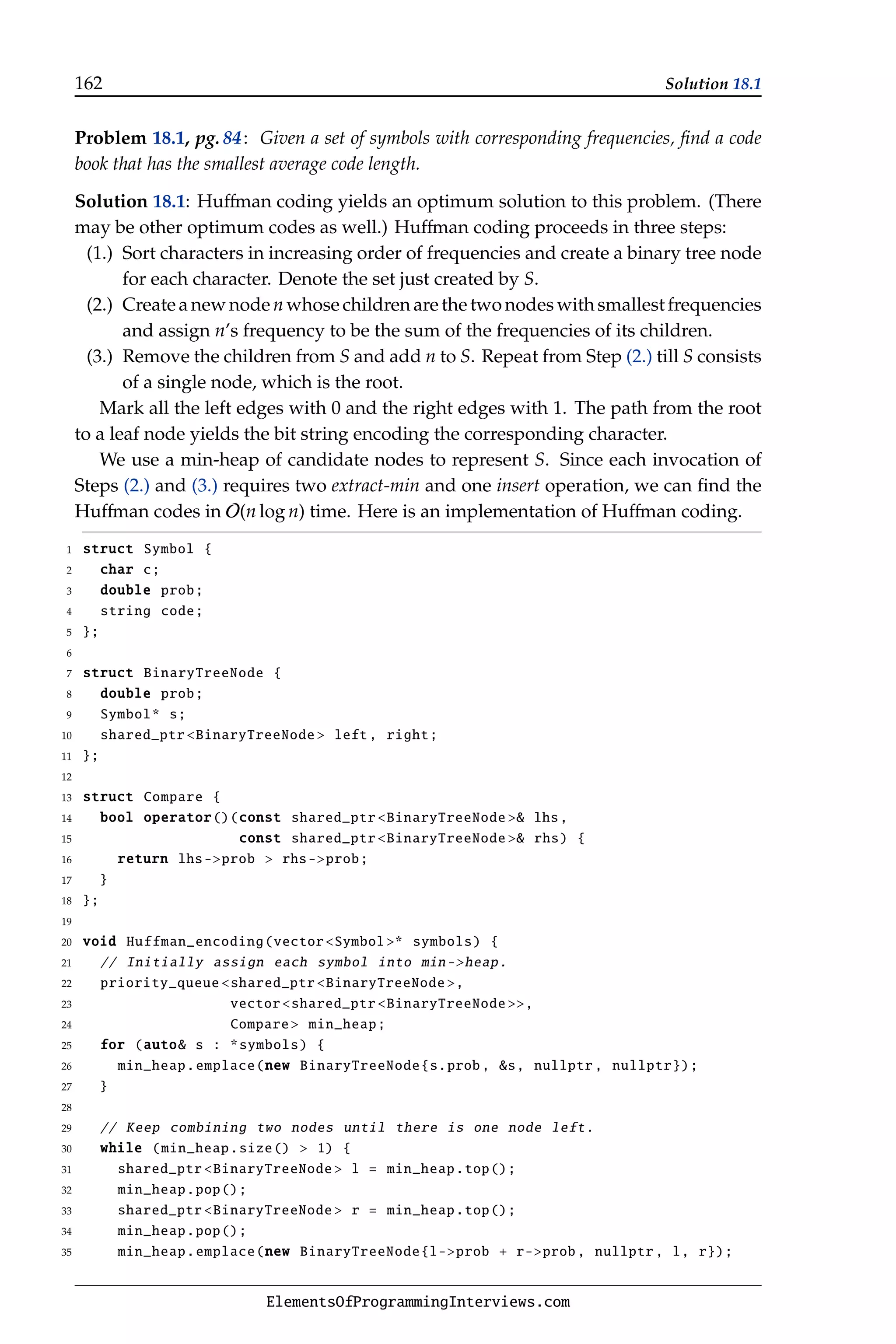

![164 Solution 18.2
Table 21.1: Huffman codes for English characters, assuming the frequencies given in Table 18.1 on
Page 85.
Character Huffman code Character Huffman code Character Huffman code
a 1110 j 001001011 s 0111
b 110000 k 0010011 t 000
c 01001 l 11110 u 01000
d 11111 m 00111 v 001000
e 100 n 1010 w 00110
f 00101 o 1101 x 001001010
g 110011 p 110001 y 110010
h 0110 q 001001001 z 001001000
i 1011 r 0101
algorithm yielding the minimum average code length is based on a induction on the
number of symbols. The induction step itself makes use of proof by contradiction,
with the two leaves in the Huffman tree corresponding to the rarest symbols playing
a central role.
Problem 18.2, pg. 86: Design an algorithm that takes as input an array A and a number t,
and determines if A 3-creates t.
Solution 18.2: First, we consider the problem of computing a pair of entries which
sum to K. Assume A is sorted.We start with the pair consisting of the first element and
the last element: (A[0], A[n−1]). Let s = A[0]+A[n−1]. If s = K, we are done. If s K,
we increase the sum by moving to pair (A[1], A[n − 1]). We need never consider A[0];
since the array is sorted, for all i, A[0]+A[i] ≤ A[0]+A[n−1] = K s. If s K, we can
decrease the sum by considering the pair (A[0], A[n−2]); by analogous reasoning, we
need never consider A[n − 1] again. We iteratively continue this process till we have
found a pair that sums up to K or the indices meet, in which case the search ends.
This solution works in O(n) time and O(1) space in addition to the space needed to
store A.
Now we describe a solution to the problem of finding three entries which sum to
t. We sort A and for each A[i], search for indices j and k such that A[j]+A[k] = t−A[i].
The additional space needed is O(1), and the time complexity is the sum of the time
taken to sort, O(n log n), and then to run the O(n) algorithm described in the previous
paragraph n times (one for each entry), which is O(n2
) overall. The code for this
approach is shown below.
1 bool has_3_sum(vectorint A, int t) {
2 sort(A.begin(), A.end());
3
4 for (int a : A) {
5 // Find if the sum of two numbers in A equals to t - a.
6 if (has_2_sum(A, t - a)) {
7 return true;
8 }
9 }
10 return false;
11 }
ElementsOfProgrammingInterviews.com](https://image.slidesharecdn.com/elementsofprogramminginterviews-220623105328-e235fecd/75/Elements-of-Programming-Interviews-pdf-170-2048.jpg)
![Solution 18.3 165
12
13 bool has_2_sum(const vectorint A, int t) {
14 int j = 0, k = A.size() - 1;
15
16 while (j = k) {
17 if (A[j] + A[k] == t) {
18 return true;
19 } else if (A[j] + A[k] t) {
20 ++j;
21 } else { // A[j] + A[k] t.
22 --k;
23 }
24 }
25 return false;
26 }
Surprisingly, it is possible, in theory, to improve the time complexity when the
entries in A are nonnegative integers in a small range, specifically, the maximum
entry is O(n). The idea is to determine all possible 3-sums by encoding the array
as a polynomial PA(x) =
Pn−1
i=0 xA[i]
. The powers of x that appear in the polynomial
PA(x)×PA(x) corresponds to sums of pairs of elements in A; similarly, the powers of x
in PA(x) × PA(x) × PA(x) correspond to sums of triples of elements in A. Two n-degree
polynomials can be multiplied in O(n log n) time using the fast Fourier Transform
(FFT). The details are long and tedious, and the approach is unlikely to do well in
practice.
-Variant 18.2.1: Solve the same problem when the three elements must be distinct.
For example, if A = h5, 2, 3, 4, 3i and t = 9, then A[2] + A[2] + A[2] is not acceptable,
A[2] + A[2] + A[4] is not acceptable, but A[1] + A[2] + A[3] and A[1] + A[3] + A[4] are
acceptable.
Variant 18.2.2: Solve the same problem when k is an additional input.
Variant 18.2.3: Write a function that takes as input an array of integers A and
an integer T, and returns a 3-tuple (A[p], A[q], A[r]) where p, q, r are all distinct,
minimizing |T − (A[p] + A[q] + A[r])|, and A[p] ≤ A[r] ≤ A[s].
Problem 18.3, pg. 86: Let A be an array of n numbers encoding the heights of adjacent
buildings of unit width. Design an algorithm to compute the area of the largest rectangle
contained in this skyline, i.e., compute maxij((j − i + 1) × min
j
k=i
A[k]).
Solution 18.3: A brute-force approach is to take each (i, j) pair, find the minimum of
subarray A[i : j], and multiply that by j−i+1. This has time complexity O(n3
), which
can improved to O(n2
) by iterating over i and then j ≥ i and tracking the minimum
height of buildings from i to j, inclusive.
We now describe a relatively simple O(n) time algorithm to compute the largest
rectangle. We iterate forward through A, keeping a subset of indices seen so far in a
ElementsOfProgrammingInterviews.com](https://image.slidesharecdn.com/elementsofprogramminginterviews-220623105328-e235fecd/75/Elements-of-Programming-Interviews-pdf-171-2048.jpg)
![166 Solution 18.3
stack S. Specifically, suppose we have completed iterating up to and including index
i − 1.
If A[i] is greater than or equal to the element corresponding to the index at the top
of the stack, we push i on to S and continue. Otherwise, we pop S till A[i] is greater
than or equal to the element corresponding to the top of S. Note that this rule ensures
that throughout the computation the array elements corresponding to indices in the
stack are in nondecreasing order from the bottom to top of the stack. After all indices
j in the stack for which A[j] A[i] have been popped, we push i onto the stack and
continue.
Now we describe the computations performed for each pop.
For each i, for every index j that is popped, because A[i] A[j], no rectangle
of height A[j] that includes j can extend past i − 1. Furthermore, there can be no
k, j k i such that A[k] A[j], or we would have popped j earlier. Therefore, the
farthest to the right a rectangle of height A[j] that includes j can reach is exactly i − 1.
Now we consider how far to the left a rectangle of height A[j] that includes j can
reach. There are three possibilities.
− There is no entry below j in the stack. The farthest to the left a rectangle of
height A[j] that begins at j can extend to is 0.
− There is an entry j0
below j in the stack, and A[j0
] A[j]. Then the farthest to
the left a rectangle of height A[j] that begins at j can extend to is j0
+ 1. (There
cannot be k, j0
k j such that A[k] A[j0
], because we would have popped j0
when processing k.) The rectangle from j0
+1 to i−1 is the widest any rectangle
including j whose height is A[j]—it is blocked on each side from going further.
− There is an entry j0
below j in the stack, and A[j0
] = A[j]. As before, the rectangle
from j0
+ 1 to i − 1 is entirely under the skyline. It is not the widest rectangle
including j whose height is A[j], since it is not blocked by j0
. However, after j
is processed j0
is guaranteed to be processed (since A[j0
] = A[j] A[i]), and we
will eventually identify the widest rectangle including j whose height is A[j]
when processing i.
The computation described above is almost complete. There is one possibility
that it does not consider, namely that the stack is not empty when we reach the end.
The computation is analogous to the iteration over i. Let j be the index at the top of
the stack. Suppose there is an entry j0
below j in the stack. Then the widest rectangle
including j with height A[j] extends up to and including n − 1 on the right. On the
left, it extends to at least j0
+ 1, and further, if A[j0
] = A[j]. If there is no entry below
j, then the widest rectangle j with height A[j] extends up to and including 0 on the
left.
Through the entire computation, we compare the area of the rectangles computed
to the maximum recorded so far and conditionally update that maximum. Since a
largest rectangle under the skyline corresponds to some index, and for each index
we identify the area of the largest rectangle including that index, with correspond-
ing height, the algorithm described above correctly computes the area of a largest
rectangle under the skyline.
ElementsOfProgrammingInterviews.com](https://image.slidesharecdn.com/elementsofprogramminginterviews-220623105328-e235fecd/75/Elements-of-Programming-Interviews-pdf-172-2048.jpg)
![Solution 19.1 167
The processing performed during the iteration over i = 0 to n − 1 is very similar
to the processing performed when i = n. It can be unified into a single loop using
appropriate loop conditions, as show below.
1 int calculate_largest_rectangle(const vectorint A) {
2 stackint s;
3 int max_area = 0;
4 for (int i = 0; i = A.size(); ++i) {
5 while (!s.empty() (i == A.size() || A[i] A[s.top()])) {
6 int height = A[s.top()];
7 s.pop();
8 max_area = max(max_area , height * (s.empty() ? i : i - s.top() - 1));
9 }
10 s.emplace(i);
11 }
12 return max_area;
13 }
The time complexity is O(n). In the forward pass, the time spent for each i is
proportional to the number of pushes and pops performed in that iteration. Although
for some i we may perform multiple pops, in total we perform exactly n pushes and
at most n pops. This is because in the forward iteration, each i is added once to the
stack and cannot be popped more than once. The time complexity of the second
stage is also O(n) since there are at most n elements in the stack, and the time to
process each one is O(1), which yields the overall time complexity of O(n). The space
complexity is O(n), which is the largest the stack can grow to, e.g., if A is sorted in
ascending order.
-Variant 18.3.1: Find the largest square under the skyline.
Problem 19.1, pg. 90: Given a 2D array of black and white entries representing a maze with
designated entrance and exit points, find a path from the entrance to the exit, if one exists.
Solution 19.1: Model the maze as an undirected graph. Each vertex corresponds to a
white pixel. We will index the vertices based on the coordinates of the corresponding
pixel; so, vertex vi,j corresponds to the 2D array entry (i, j). Use edges to model
adjacent pixels: vi,j is connected to vertices vi+1,j, vi,j+1, vi−1,j, and vi,j−1, assuming these
vertices exist—vertex va,b does not exist if the corresponding pixel is black or the
coordinates (a, b) lie outside the image.
Now, run a DFS starting from the vertex corresponding to the entrance. If at
some point, we discover the exit vertex in the DFS, then there exists a path from the
entrance to the exit. If we implement recursive DFS then the path would consist of
all the vertices in the call stack corresponding to previous recursive calls to the DFS
routine.
This problem can also be solved using BFS from the entrance vertex on the same
graph model. The BFS tree has the property that the computed path will be a shortest
path from the entrance. However BFS is more difficult to implement than DFS since
in DFS, the compiler implicitly handles the DFS stack, whereas in BFS, the queue has
ElementsOfProgrammingInterviews.com](https://image.slidesharecdn.com/elementsofprogramminginterviews-220623105328-e235fecd/75/Elements-of-Programming-Interviews-pdf-173-2048.jpg)
![168 Solution 19.1
to be explicitly coded. Since the problem did not call for a shortest path, it is better
to use DFS.
1 struct Coordinate {
2 bool operator==(const Coordinate that) const {
3 return x == that.x y == that.y;
4 }
5
6 int x, y;
7 };
8
9 vectorCoordinate search_maze(vectorvectorint maze,
10 const Coordinate s,
11 const Coordinate e) {
12 vectorCoordinate path;
13 maze[s.x][s.y] = 1;
14 path.emplace_back(s);
15 if (!search_maze_helper(s, e, maze, path)) {
16 path.pop_back();
17 }
18 return path; // empty path means no path between s and e.
19 }
20
21 // Perform DFS to find a feasible path.
22 bool search_maze_helper(const Coordinate cur,
23 const Coordinate e,
24 vectorvectorint* maze,
25 vectorCoordinate * path) {
26 if (cur == e) {
27 return true;
28 }
29
30 const arrayarrayint, 2, 4 shift = {
31 {{{0, 1}}, {{0, -1}}, {{1, 0}}, {{-1, 0}}}};
32
33 for (const auto s : shift) {
34 Coordinate next{cur.x + s[0], cur.y + s[1]};
35 if (is_feasible(next, *maze)) {
36 (*maze)[next.x][next.y] = 1;
37 path-emplace_back(next);
38 if (search_maze_helper(next, e, maze, path)) {
39 return true;
40 }
41 path-pop_back();
42 }
43 }
44 return false;
45 }
46
47 // Check cur is within maze and is a white pixel.
48 bool is_feasible(const Coordinate cur, const vectorvectorint maze) {
49 return cur.x = 0 cur.x maze.size() cur.y = 0
50 cur.y maze[cur.x].size() maze[cur.x][cur.y] == 0;
51 }
ElementsOfProgrammingInterviews.com](https://image.slidesharecdn.com/elementsofprogramminginterviews-220623105328-e235fecd/75/Elements-of-Programming-Interviews-pdf-174-2048.jpg)
![Solution 19.2 169
The time complexity is the same as that for DFS, namely O(|V| + |E|).
Problem 19.2, pg. 90: Implement a routine that takes a n × m Boolean array A together
with an entry (x, y) and flips the color of the region associated with (x, y). See Figure 19.6 on
Page 91 for an example of flipping.
Solution 19.2: Conceptually, this problem is very similar to that of exploring an
undirected graph. Entries can be viewed as vertices, and neighboring vertices are
connected by edges.
For the current problem, we are searching for all vertices whose color is the same
as that of (x, y) that are reachable from (x, y). Breadth-first search is natural when
starting with a set of vertices. Specifically, we can use a queue to store such vertices.
The queue is initialized to (x, y). The queue is popped iteratively. Call the popped
point p. First, we record p’s initial color, and then flip its color. Next we examine
p neighbors. Any neighbor which is the same color as p’s initial color is added to
q. The computation ends when q is empty. Correctness follows from the fact that
any point that is added to the queue is reachable from (x, y) via a path consisting of
points of the same color, and all points reachable from (x, y) via points of the same
color will eventually be added to the queue.
1 void flip_color(int x, int y, vectordequebool *A) {
2 const arrayarrayint, 2, 4 dir = {{{{0, 1}}, {{0, -1}},
3 {{1, 0}}, {{-1, 0}}}};
4 const bool color = (*A)[x][y];
5
6 queuepairint, int q;
7 (*A)[x][y] = !(*A)[x][y]; // flips.
8 q.emplace(x, y);
9 while (!q.empty()) {
10 auto curr(q.front());
11 for (const auto d : dir) {
12 const pairint, int next(curr.first + d[0], curr.second + d[1]);
13 if (next.first = 0 next.first A-size()
14 next.second = 0 next.second (*A)[next.first].size()
15 (*A)[next.first][next.second] == color) {
16 // Flips the color.
17 (*A)[next.first][next.second] = !(*A)[next.first][next.second];
18 q.emplace(next);
19 }
20 }
21 q.pop();
22 }
23 }
The time complexity is the same as that of BFS, i.e., O(mn). The space complexity is a
little better than the worst case for BFS, since there are at most O(m + n) vertices that
are at the same distance from a given entry.
We also provide a recursive solution which is in the spirit of DFS. It does not need
a queue but implicitly uses a stack, namely the function call stack.
1 void flip_color(int x, int y, vectordequebool *A) {
ElementsOfProgrammingInterviews.com](https://image.slidesharecdn.com/elementsofprogramminginterviews-220623105328-e235fecd/75/Elements-of-Programming-Interviews-pdf-175-2048.jpg)
![170 Solution 19.3
2 const arrayarrayint, 2, 4 dir = {{{{0, 1}}, {{0, -1}},
3 {{1, 0}}, {{-1, 0}}}};
4 const bool color = (*A)[x][y];
5
6 (*A)[x][y] = !(*A)[x][y]; // flips.
7 for (const auto d : dir) {
8 const int nx = x + d[0], ny = y + d[1];
9 if (nx = 0 nx A-size() ny = 0 ny (*A)[nx].size()
10 (*A)[nx][ny] == color) {
11 flip_color(nx, ny, A);
12 }
13 }
14 }
The time complexity is the same as that of DFS.
Both the algorithms given above differ slightly from traditional BFS and DFS
algorithms. The reason is that we have a color field already available, and hence
do not need the auxiliary color field traditionally associated with vertices BFS and
DFS. Furthermore, since we are simply determining reachability, we only need two
colors, whereas BFS and DFS traditionally use three colors to track state. (The use of
an additional color makes it possible, for example, to answer questions about cycles
in directed graphs, but that is not relevant here.)
-Variant 19.2.1: Design an algorithm for computing the black region that contains
the most points.
-Variant 19.2.2: Design an algorithm that takes a point (a, b), sets A(a, b) to black,
and returns the size of the black region that contains the most points. Assume this
algorithm will be called multiple times, and you want to keep the aggregate run time
as low as possible.
Problem 19.3, pg. 90: Given a dictionary D and two strings s and t, write a function
to determine if s produces t. Assume that all characters are lowercase alphabets. If s does
produce t, output the length of a shortest production sequence; otherwise, output −1.
Solution 19.3: Define the undirected graph G = (D, E) by (u, v) ∈ E iff nu = nv, where
nu and ns are the lengths of u and v, respectively, and u and v differ in one character.
(Note that the relation “differs in one character” is symmetric, which is why the
graph is undirected.)
A production sequence is simply a path in G, so what we need is a shortest path
from s to t in G. Shortest paths in an undirected graph are naturally computed using
BFS. We use a queue and a hash table of vertices (which indicates if a vertex has
already been visited). We enumerate neighbors of a vertex v by an outer loop that
iterates over each position in v and an inner loop that iterates over each choice of
character for that position.
1 // Use BFS to find the least steps of transformation.
2 int transform_string(unordered_set string D,
ElementsOfProgrammingInterviews.com](https://image.slidesharecdn.com/elementsofprogramminginterviews-220623105328-e235fecd/75/Elements-of-Programming-Interviews-pdf-176-2048.jpg)
![Solution 19.4 171
3 const string s,
4 const string t) {
5 queuepairstring, int q;
6 D.erase(s); // mark s as visited by erasing it in D.
7 q.emplace(s, 0);
8
9 while (!q.empty()) {
10 pairstring, int f(q.front());
11 // Return if we find a match.
12 if (f.first == t) {
13 return f.second; // number of steps reaches t.
14 }
15
16 // Try all possible transformations of f.first.
17 string str = f.first;
18 for (int i = 0; i str.size(); ++i) {
19 for (int j = 0; j 26; ++j) { // iterates through ’a’ ~ ’z’.
20 str[i] = ’a’ + j; // change the (i + 1)-th char of str.
21 auto it(D.find(str));
22 if (it != D.end()) {
23 D.erase(it); // mark str as visited by erasing it.
24 q.emplace(str, f.second + 1);
25 }
26 }
27 str[i] = f.first[i]; // revert the change of str.
28 }
29 q.pop();
30 }
31
32 return -1; // cannot find a possible transformations.
33 }
The number of vertices is the number d of words in the dictionary. The number
of edges is, in the worst case, O(d2
). The time complexity is that of BFS, namely
O(d + d2
) = O(d2
). (If the string length n is less than d then the number of edges drops
to O(n), implying an O(nd) bound.)
Problem 19.4, pg. 92: Given an instance of the task scheduling problem, compute the least
amount of time in which all the tasks can be performed, assuming an unlimited number of
servers. Explicitly check that the system is feasible.
Solution 19.4: This problem is naturally modeled using a directed graph. Vertices
correspond to tasks, and an edge from u to v indicates that u must be completed
before v can begin. The system is infeasible iff a cycle is present in the derived graph.
We can check the presence of a cycle by performing a DFS. If no cycle is present,
the DFS numbering yields a topological ordering of the graph, i.e., an ordering of the
vertices such that v follows u whenever an edge is present from u to v. Specifically,
the DFS finishing time gives a topological ordering in reverse order. Therefore, both
testing for a cycle and computing a topological ordering can be performed in O(n+m)
time, where n and m are the number of vertices and edges in the graph, respectively.
ElementsOfProgrammingInterviews.com](https://image.slidesharecdn.com/elementsofprogramminginterviews-220623105328-e235fecd/75/Elements-of-Programming-Interviews-pdf-177-2048.jpg)
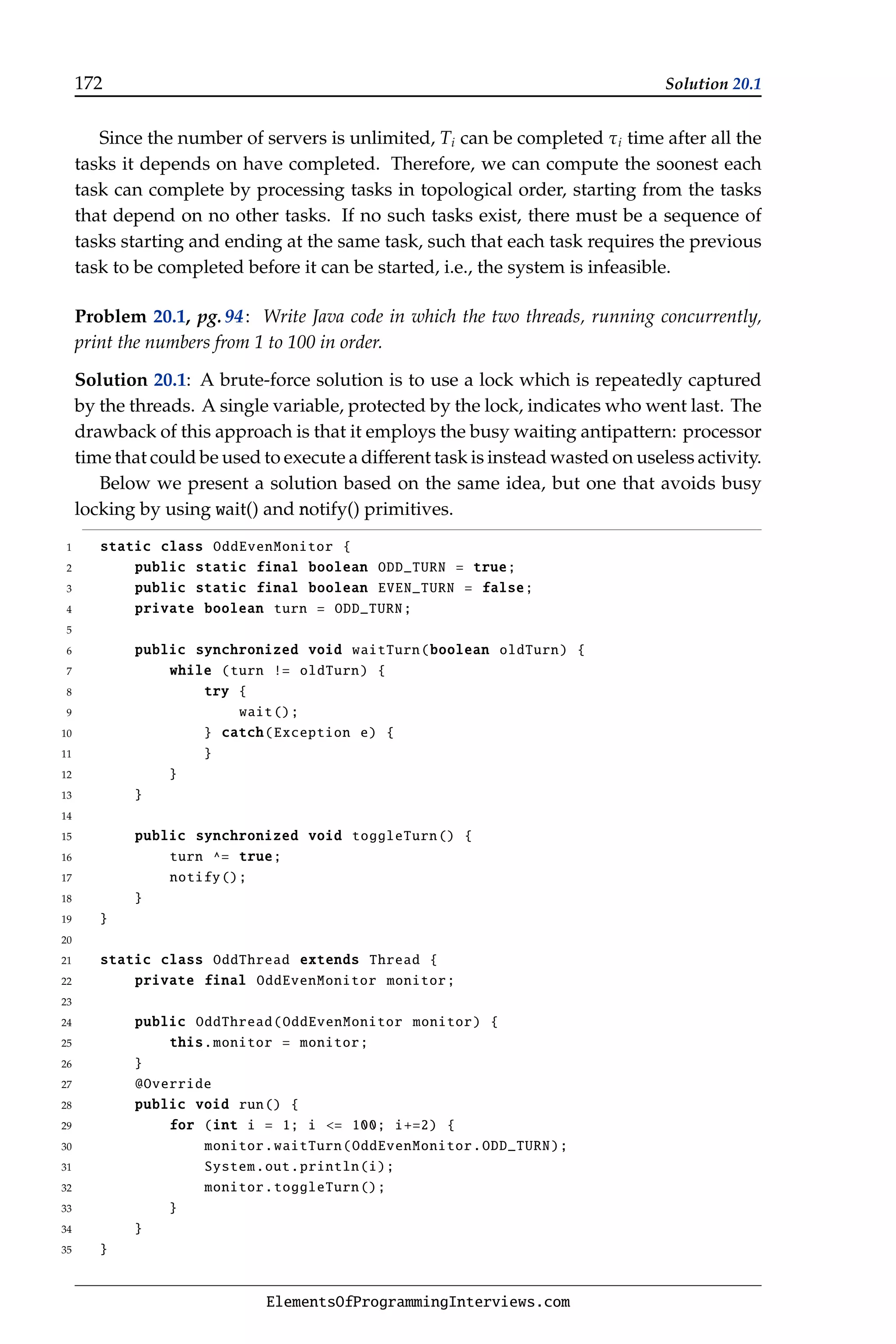
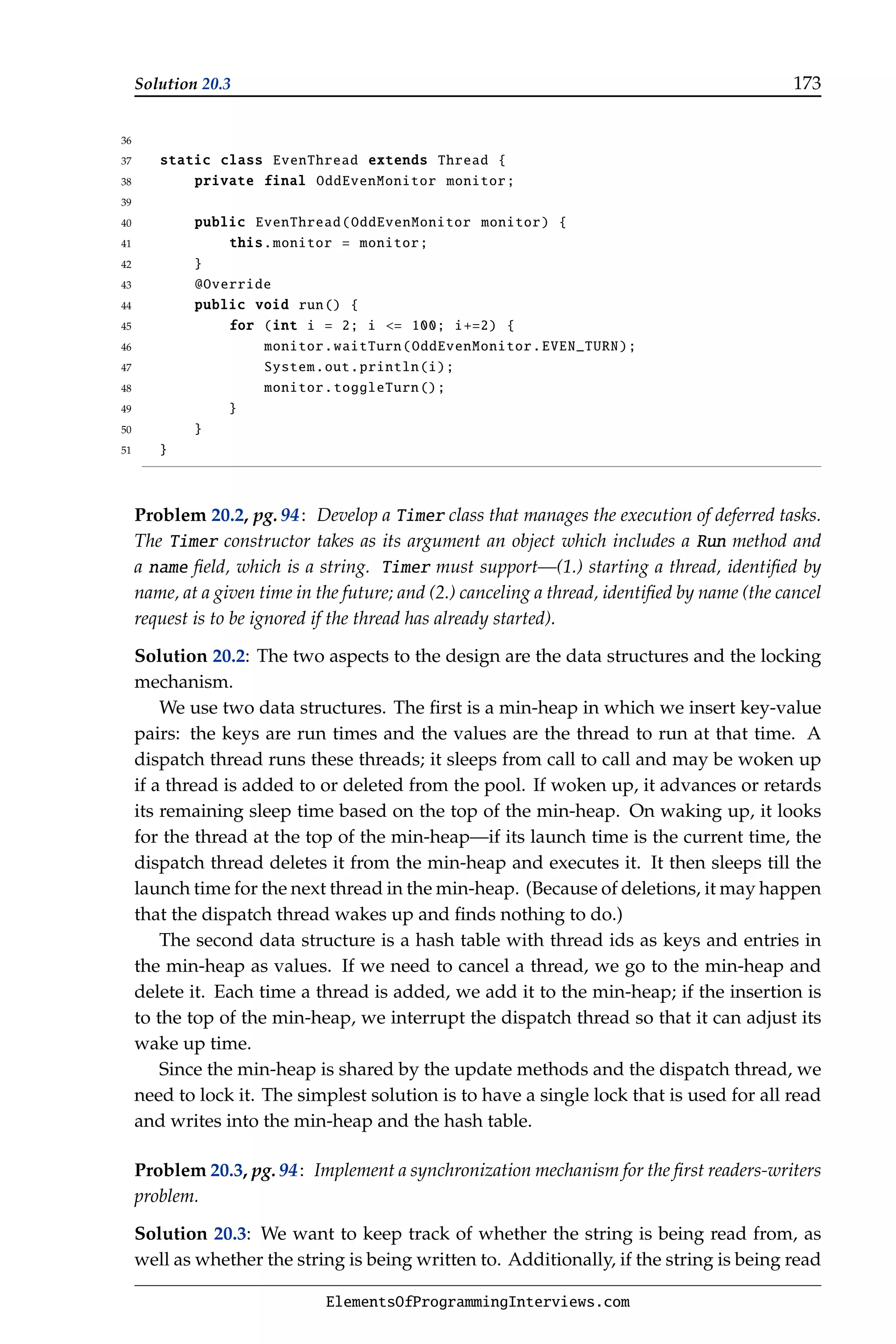
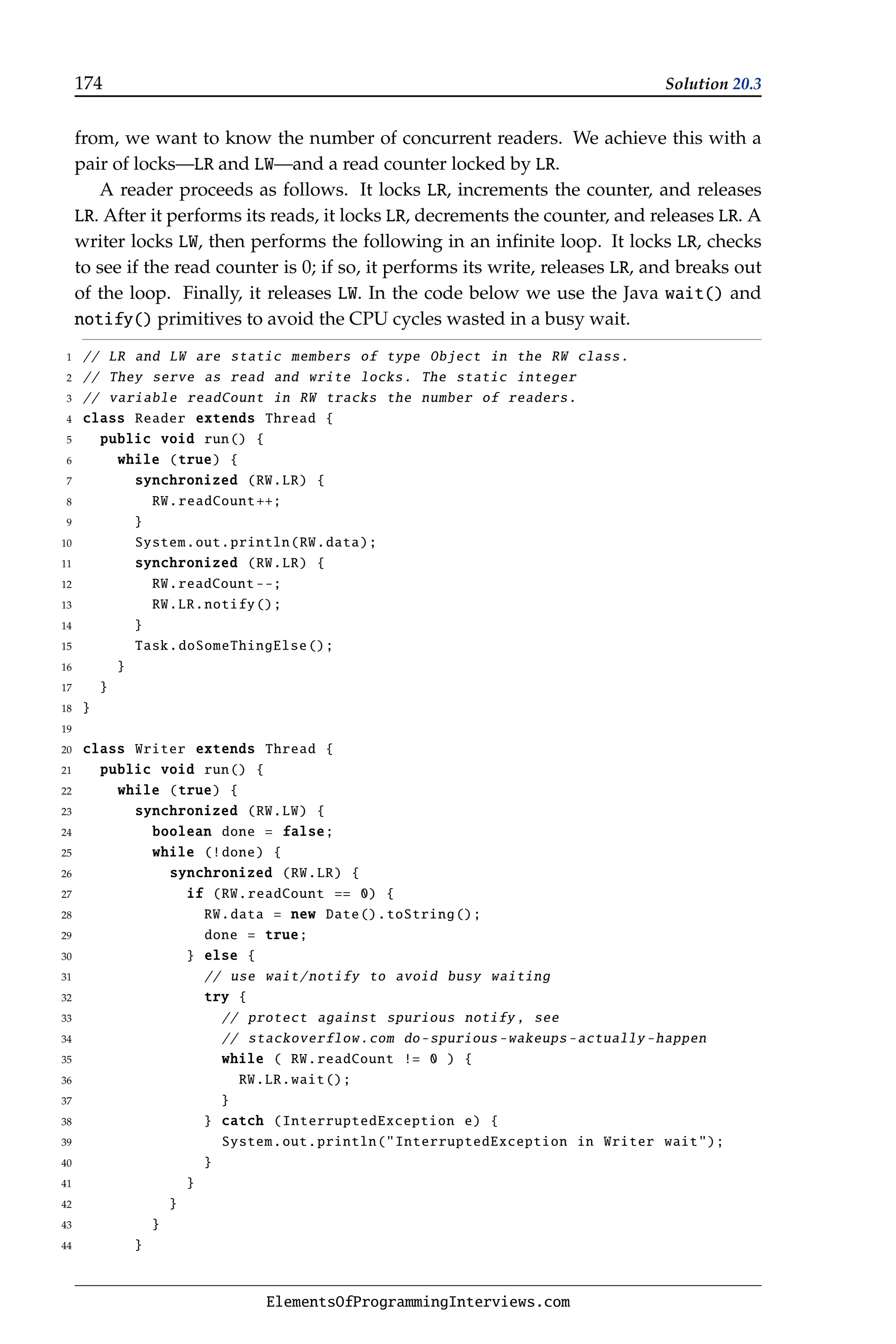
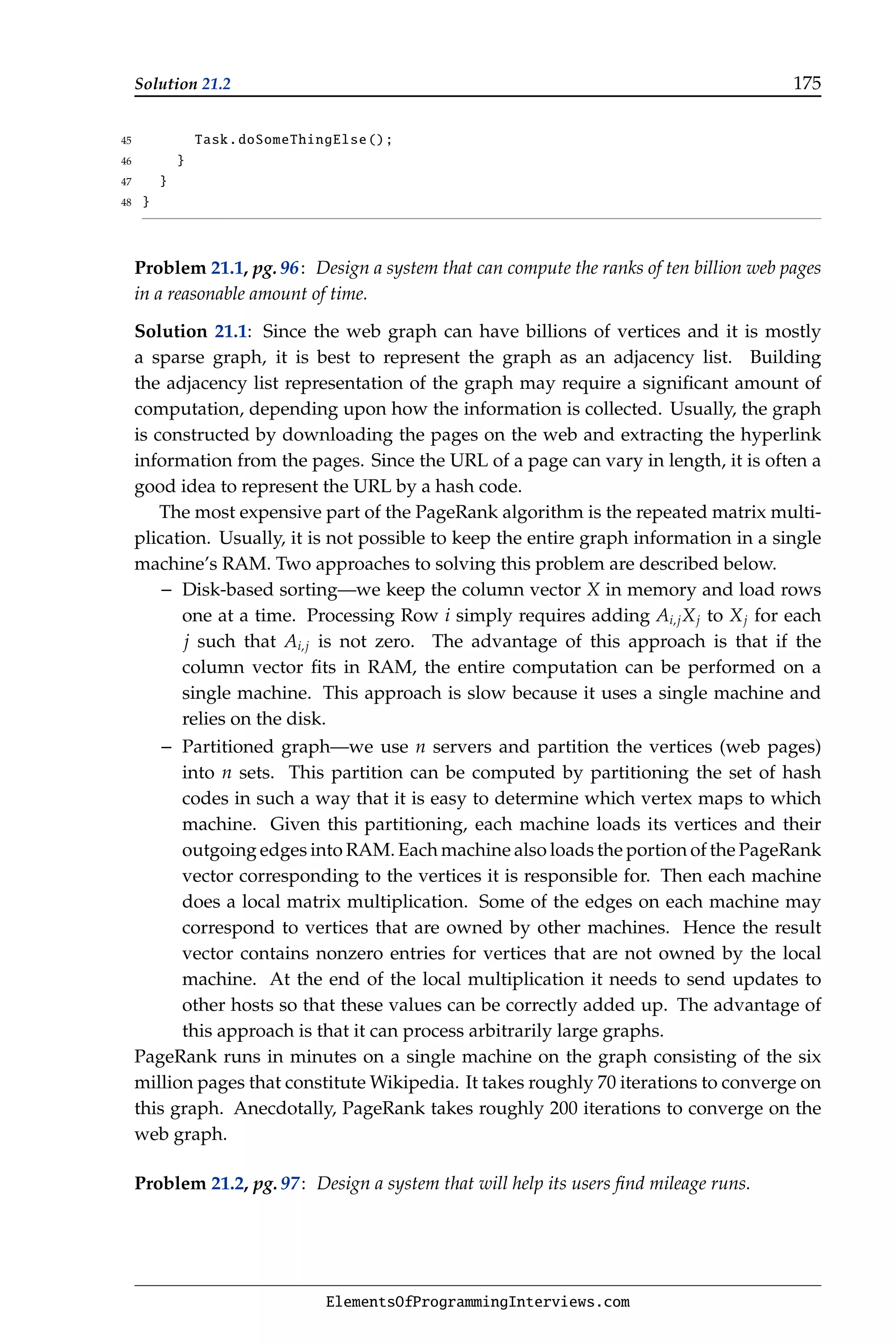



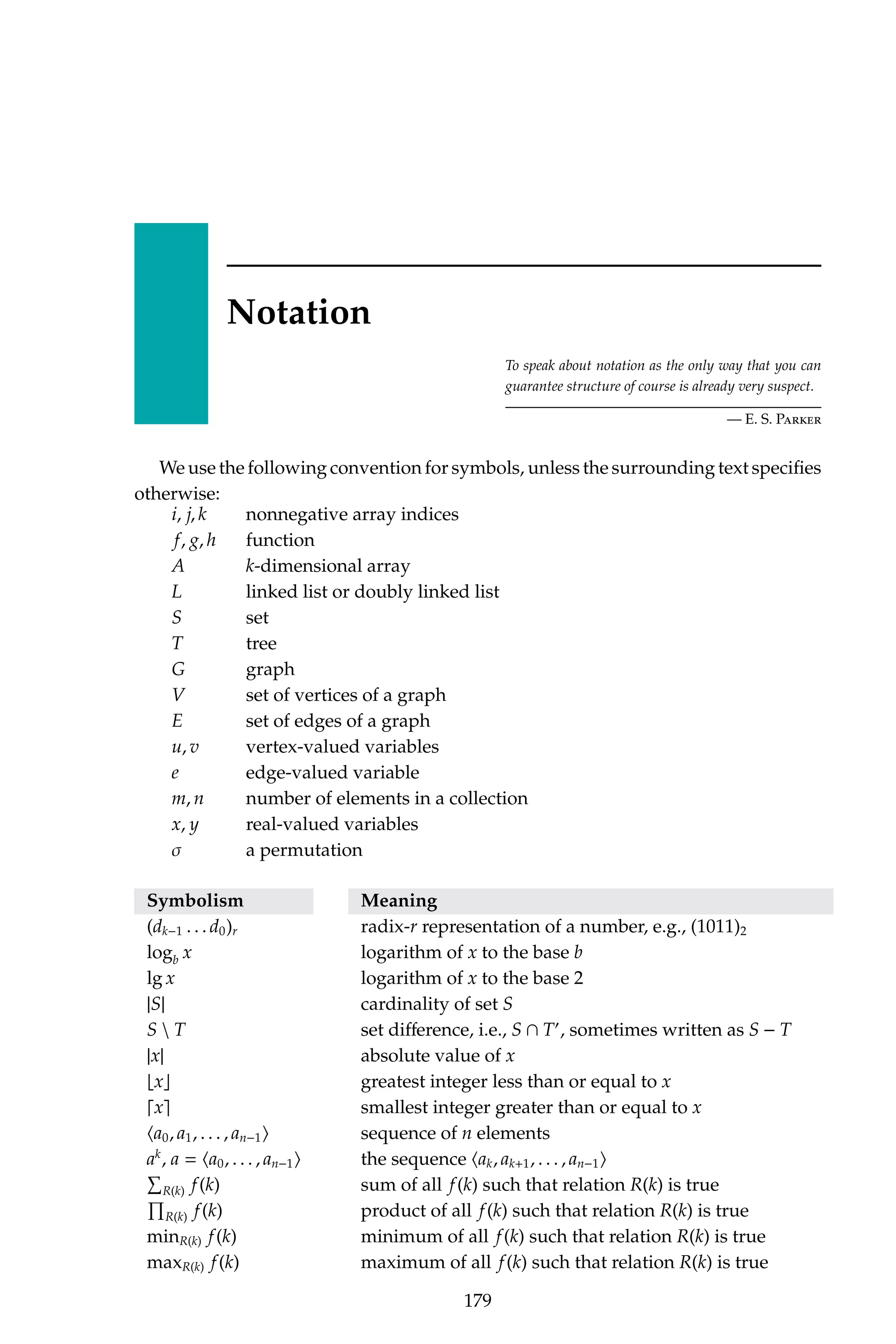
![180 Notation and Index
Pb
k=a f(k) shorthand for
P
a≤k≤b f(k)
Qb
k=a f(k) shorthand for
Q
a≤k≤b f(k)
{a | R(a)} set of all a such that the relation R(a) = true
[l, r] closed interval: {x | l ≤ x ≤ r}
(l, r) open interval: {x | l x r}
[l, r) {x | l ≤ x r}
(l, r] {x | l x ≤ r}
{a, b, . . . } well-defined collection of elements, i.e., a set
Ai or A[i] the i-th element of one-dimensional array A
A[i : j] subarray of one-dimensional array A consisting of ele-
ments at indices i to j inclusive
A[i][j] or A[i, j] the element in i-th row and j-th column of 2D array A
A[i1 : i2][j1 : j2] 2D subarray of 2D array A consisting of elements from
i1-th to i2-th rows and from j1-th to j2-th column, inclusive
n
k
binomial coefficient: number of ways of choosing k ele-
ments from a set of n items
n! n-factorial, the product of the integers from 1 to n, inclu-
sive
O
f(n)
big-oh complexity of f(n), asymptotic upper bound
x mod y mod function
x ⊕ y bitwise-XOR function
x ≈ y x is approximately equal to y
null pointer value reserved for indicating that the pointer
does not refer to a valid address
∅ empty set
∞ infinity: Informally, a number larger than any number.
Rigorously, a set is infinite iff it can be mapped one-to-one
to a proper subset of itself.
Z the set of integers {. . . , −2, −1, 0, 1, 2, 3, . . . }
Z+
the set of nonnegative integers {0, 1, 2, 3, . . . }
Zn the set {0, 1, 2, 3, . . . , n − 1}
R the set of real numbers
R+
the set of nonnegative real numbers
x y much less than
x y much greater than
A 7→ B function mapping from domain A to range B
⇒ logical implication
iff if and only if
ElementsOfProgrammingInterviews.com](https://image.slidesharecdn.com/elementsofprogramminginterviews-220623105328-e235fecd/75/Elements-of-Programming-Interviews-pdf-186-2048.jpg)
